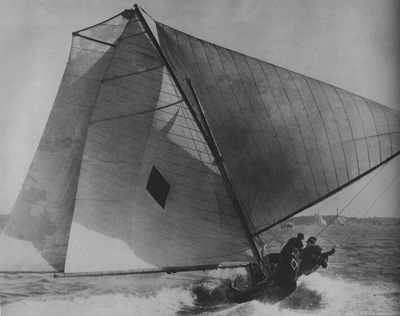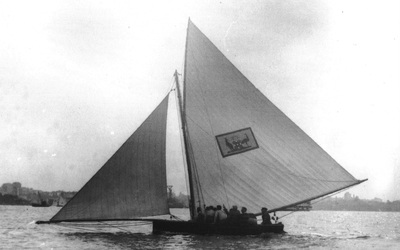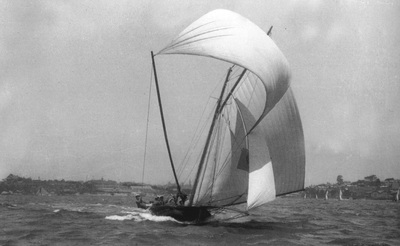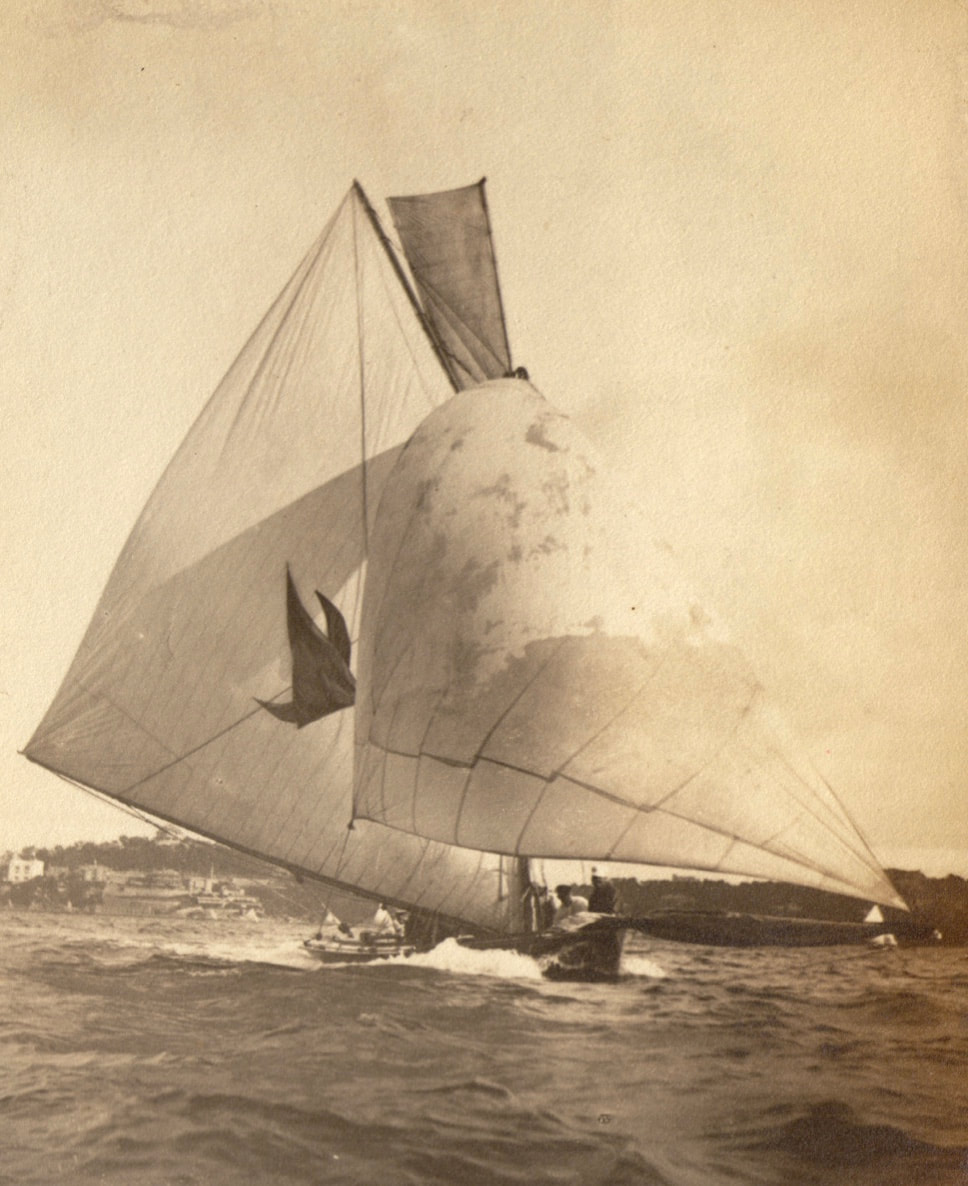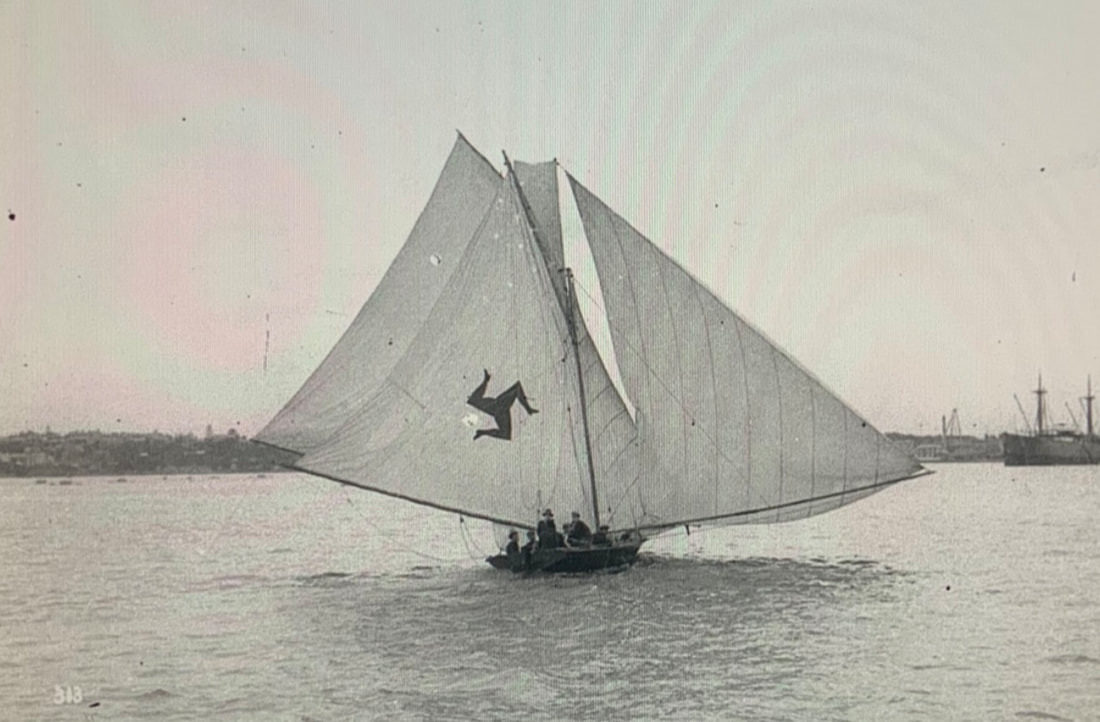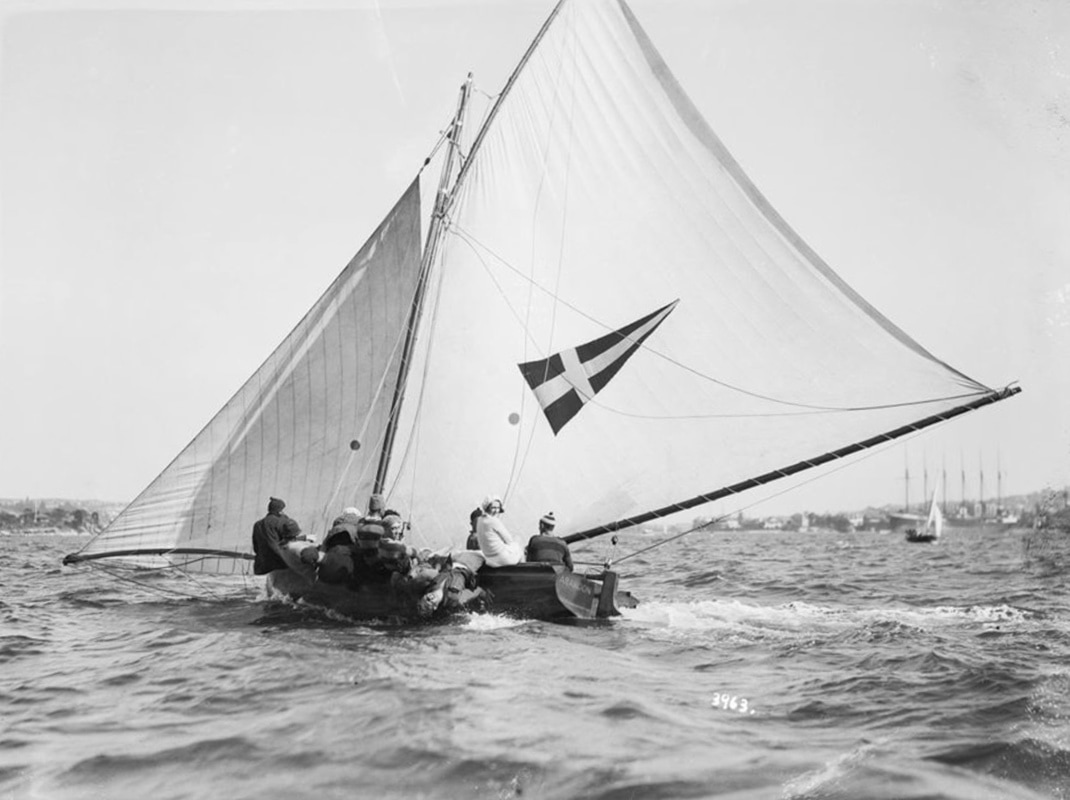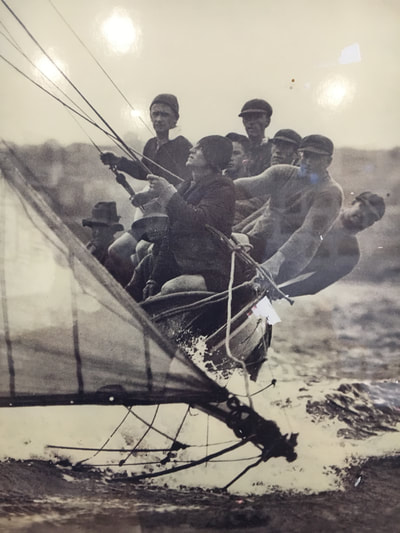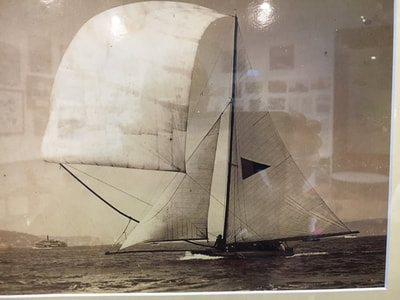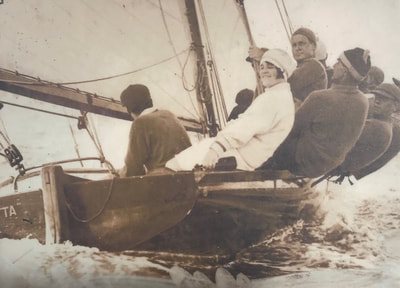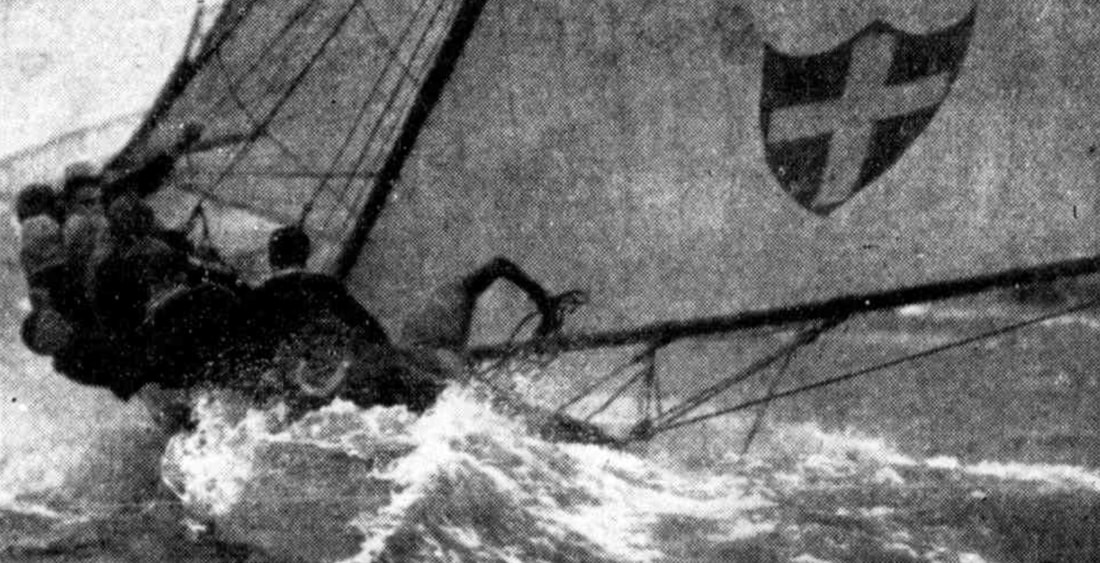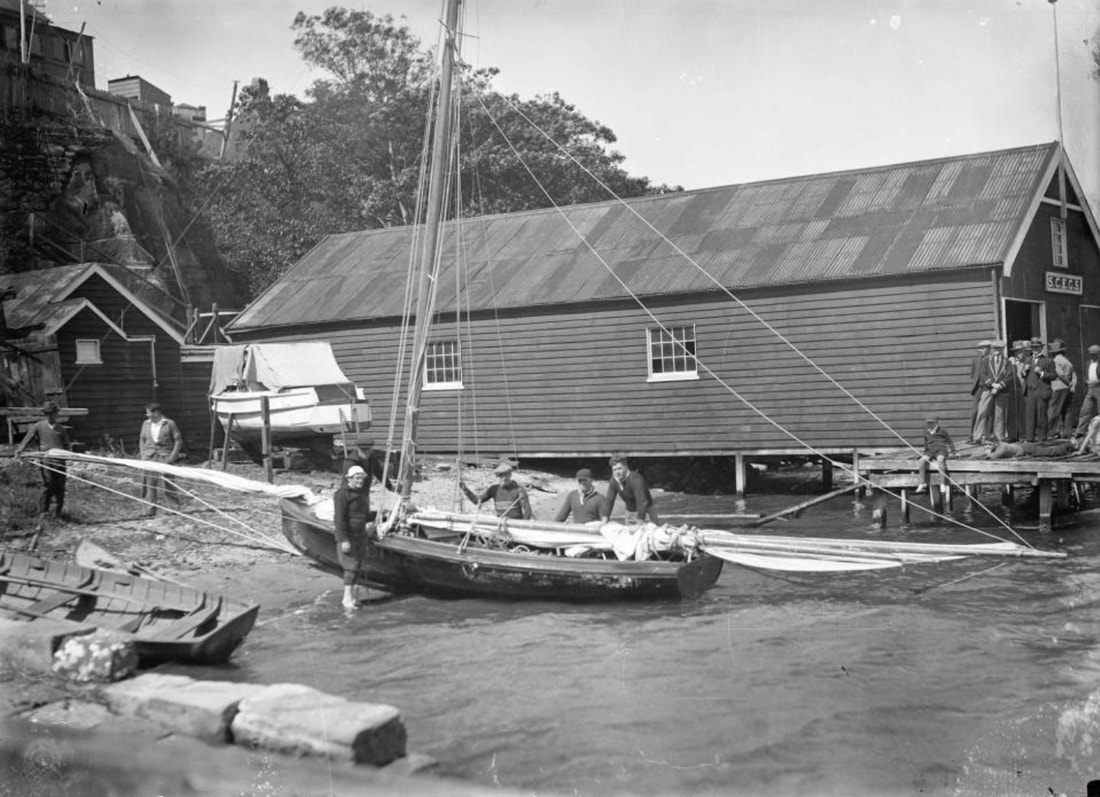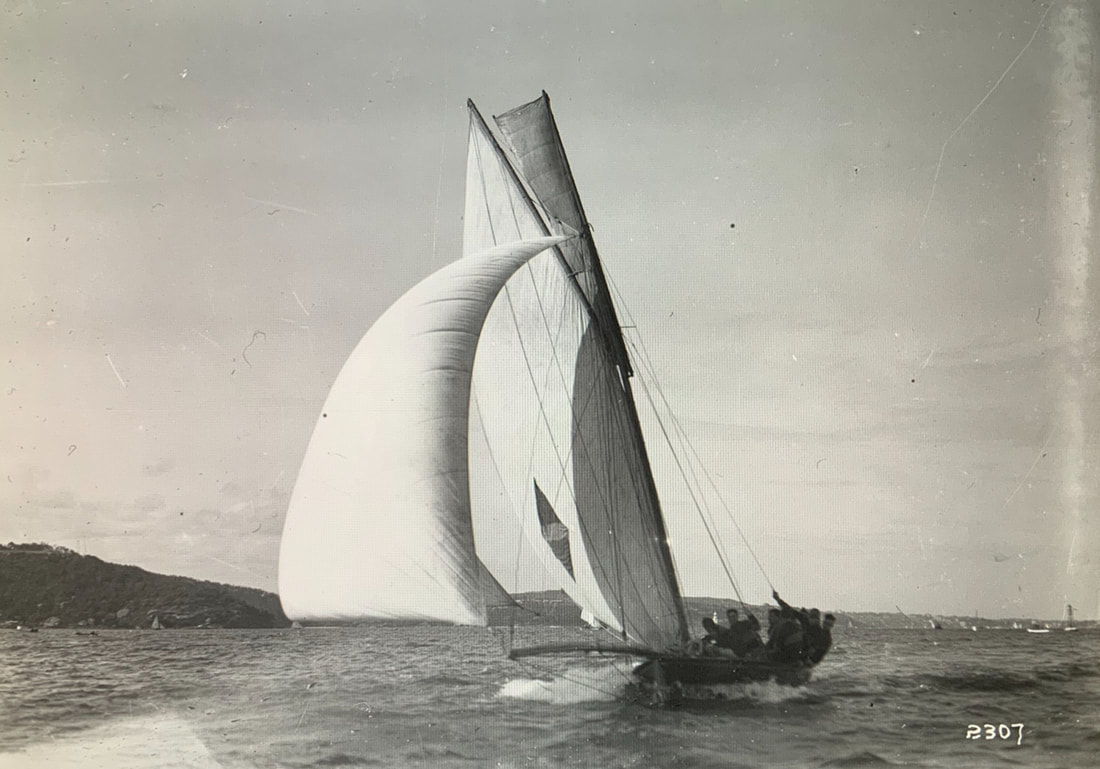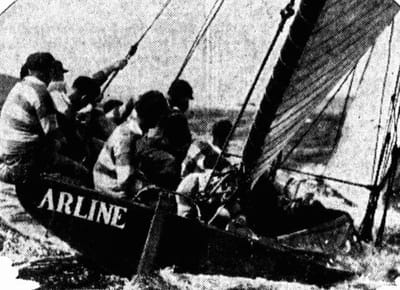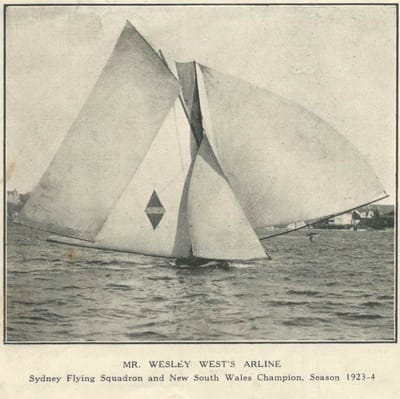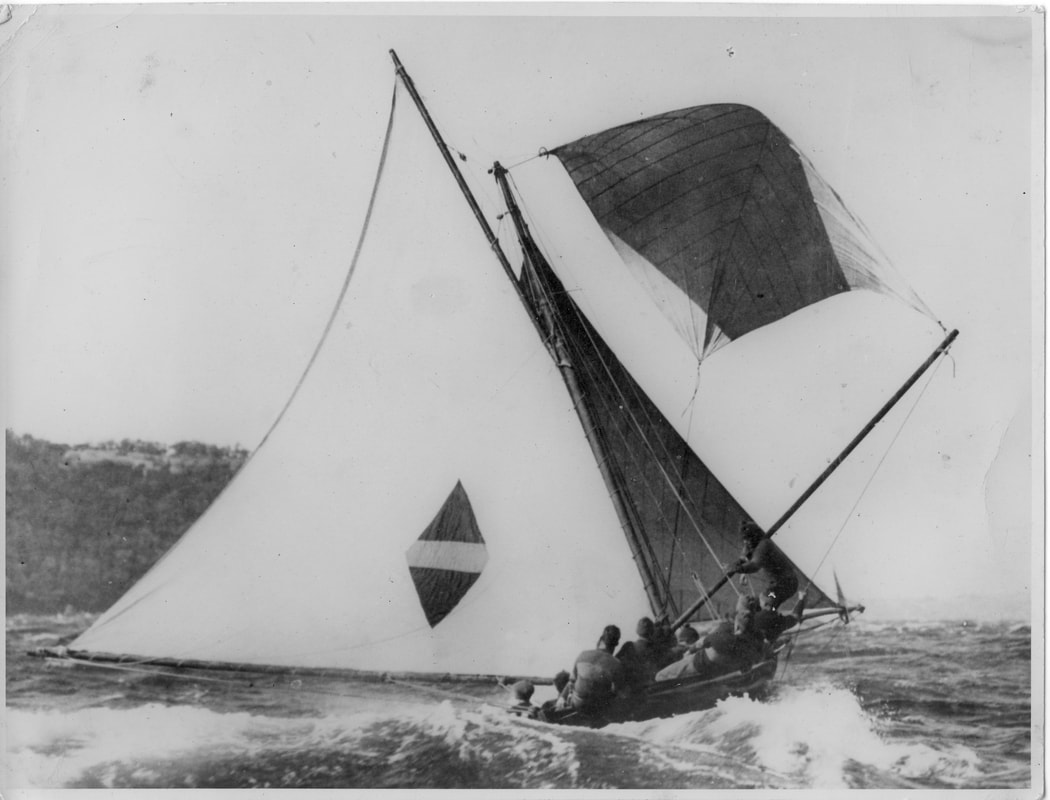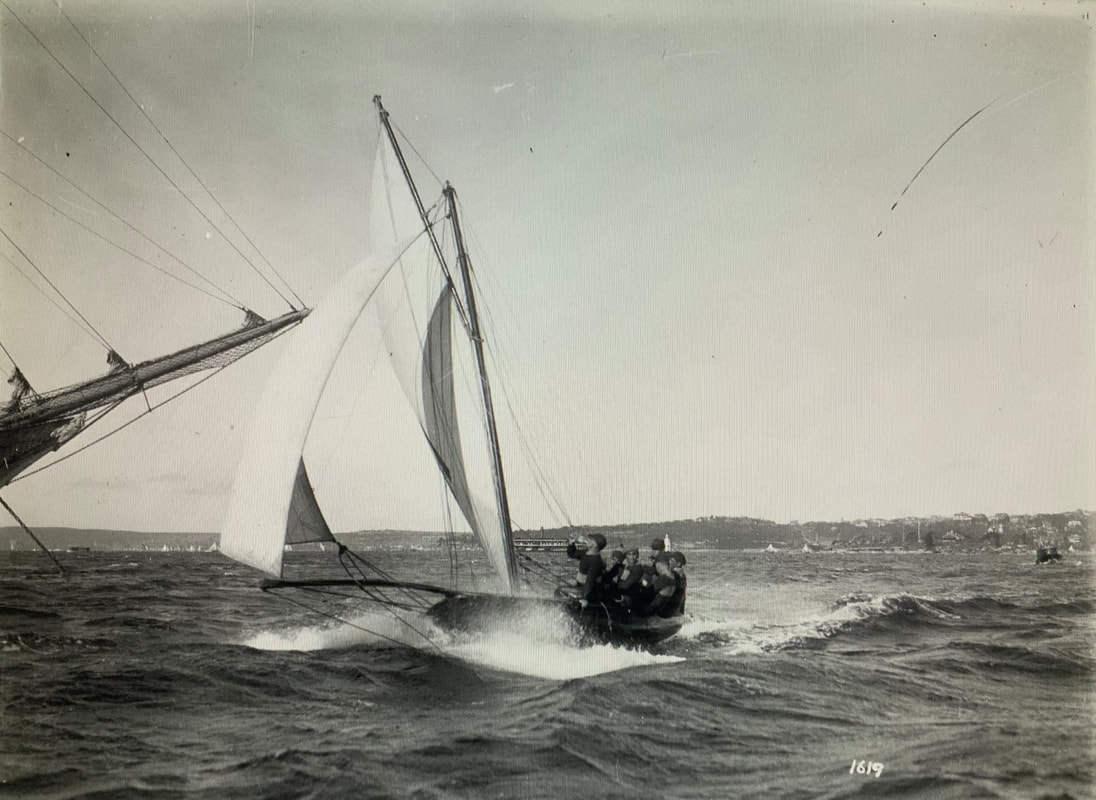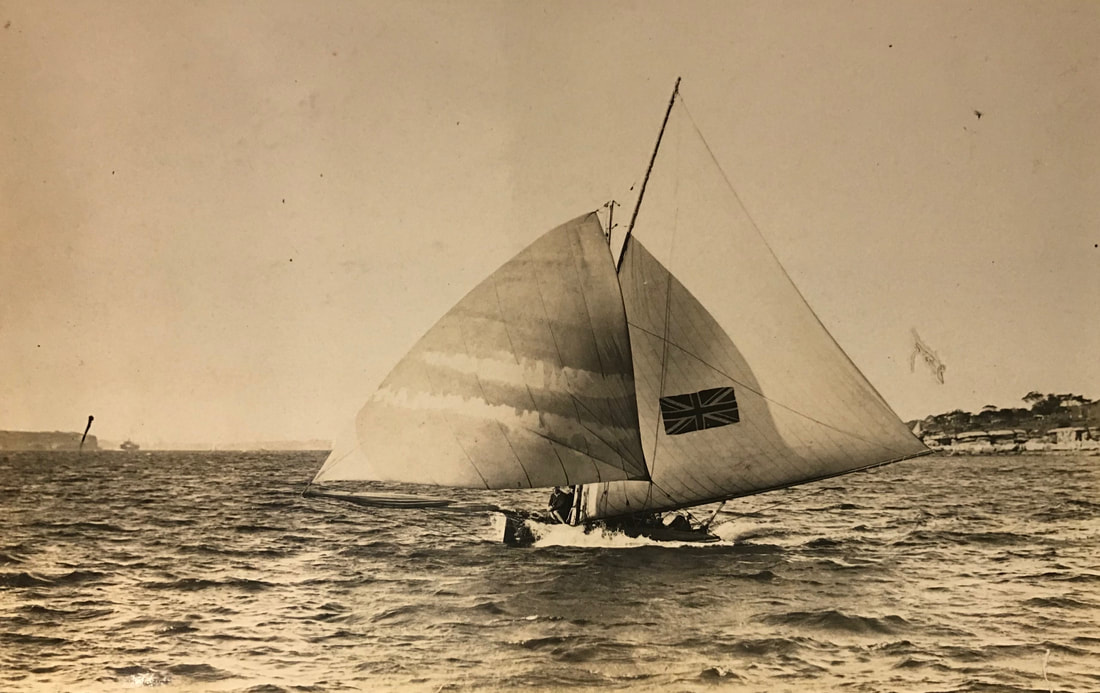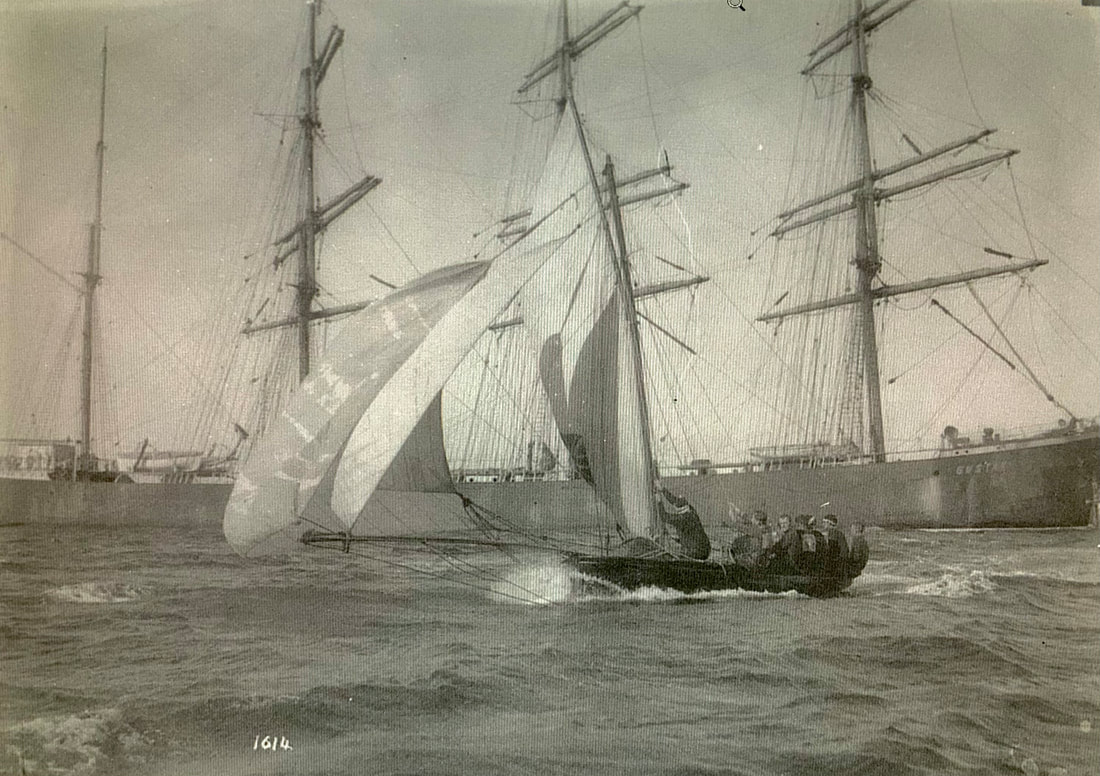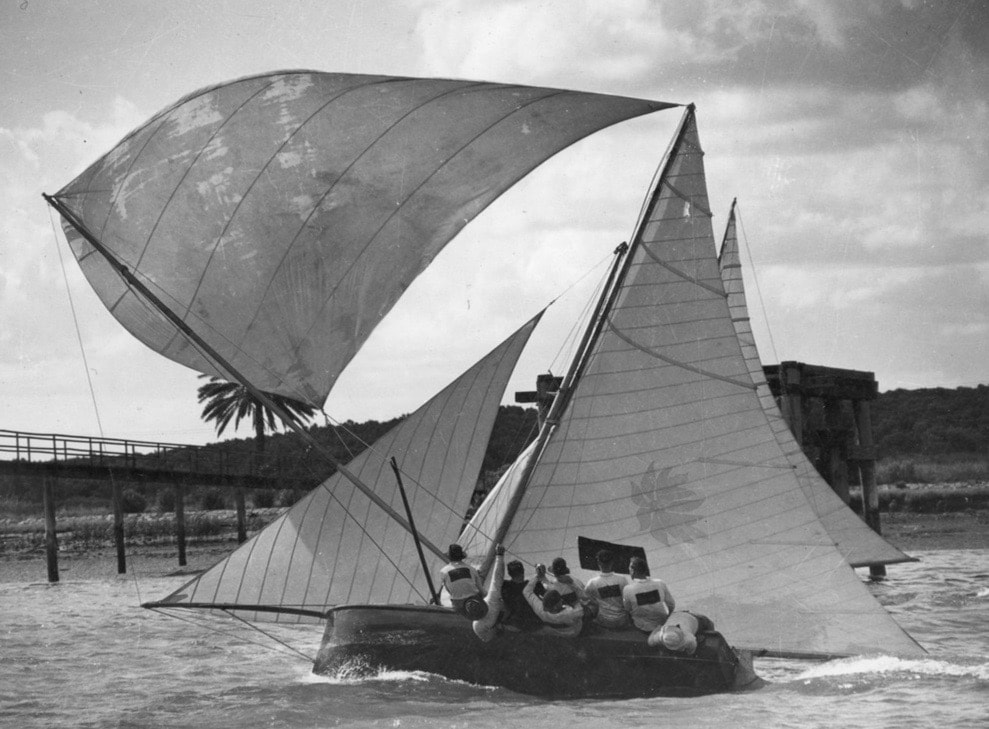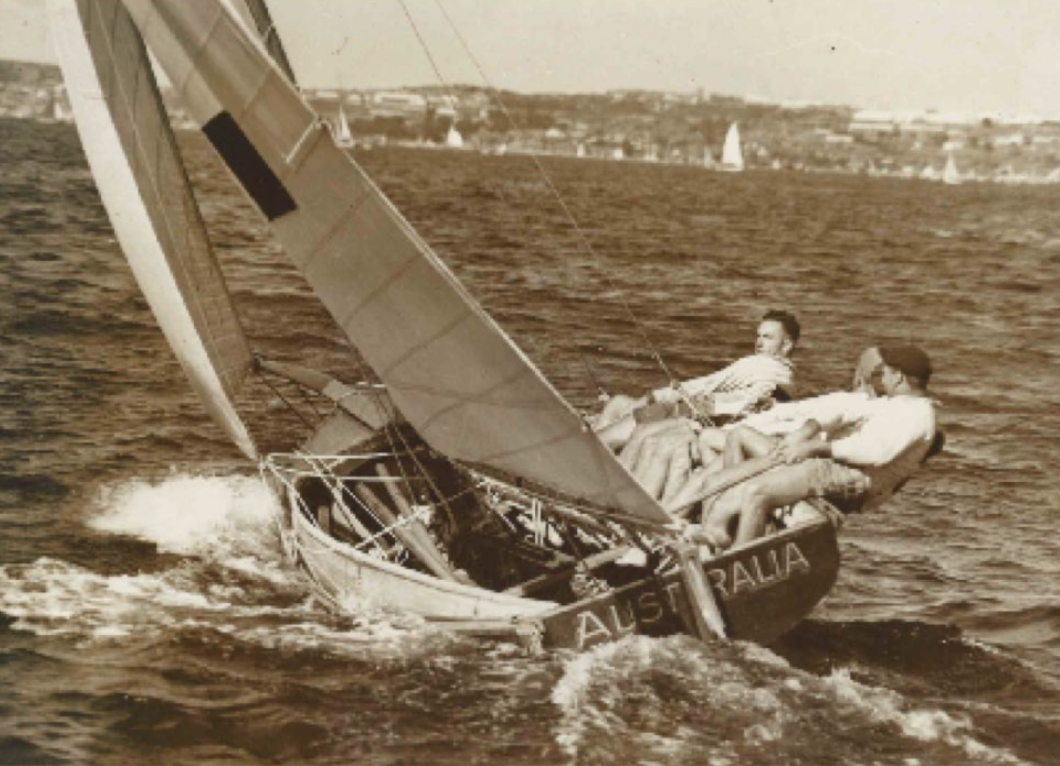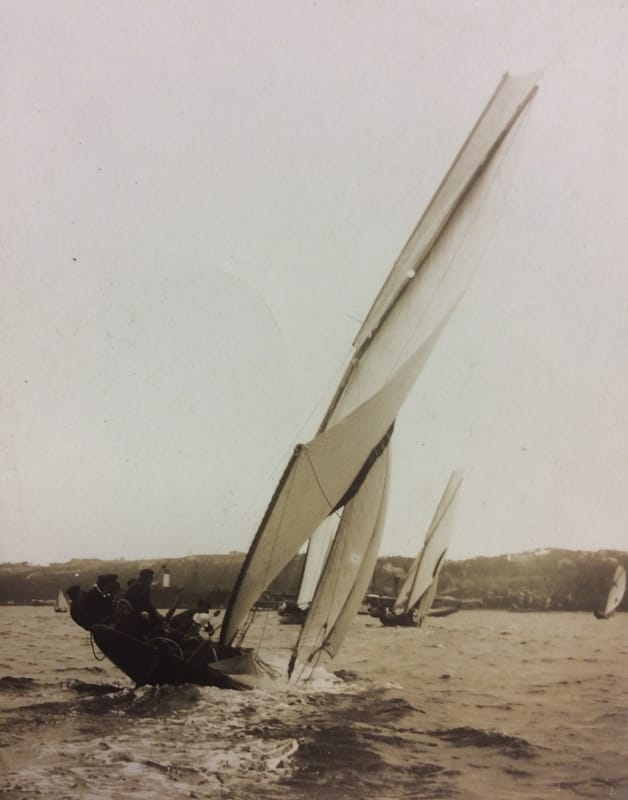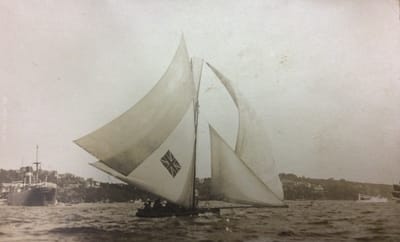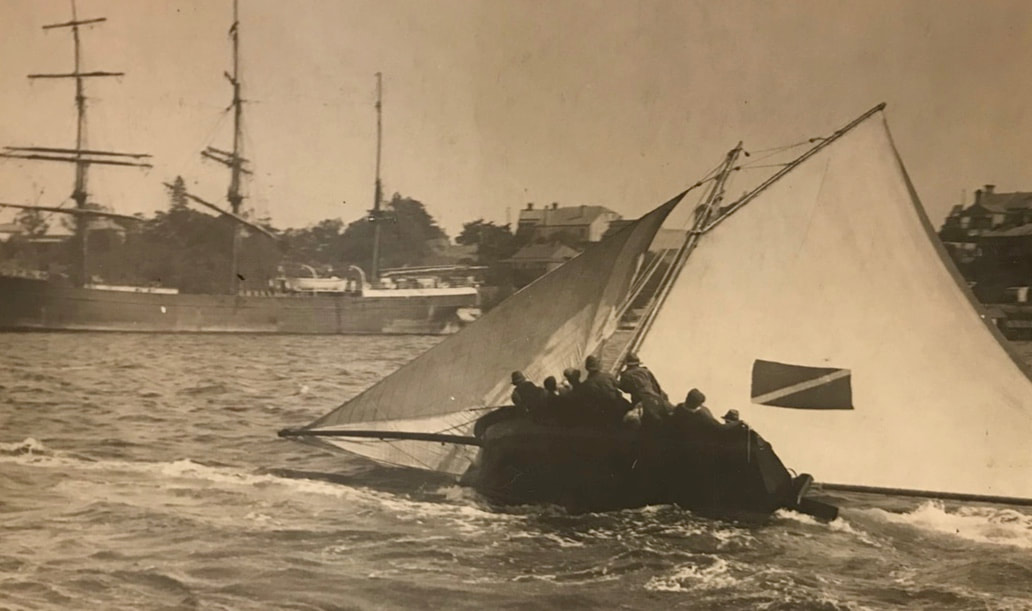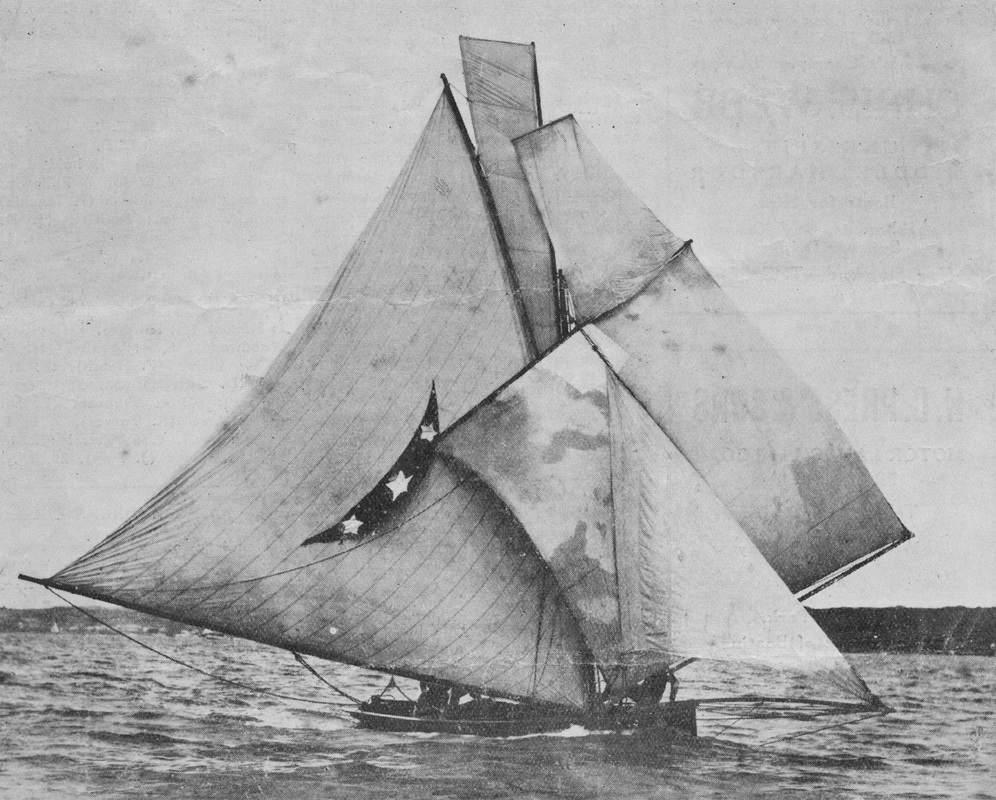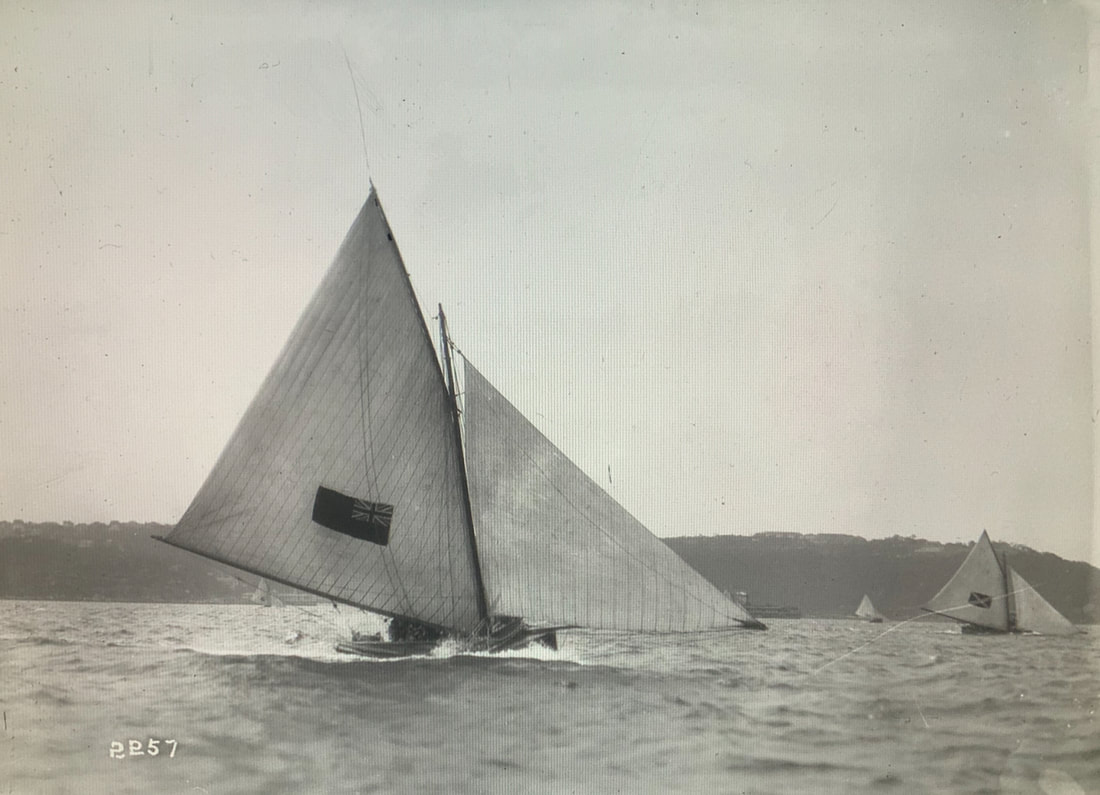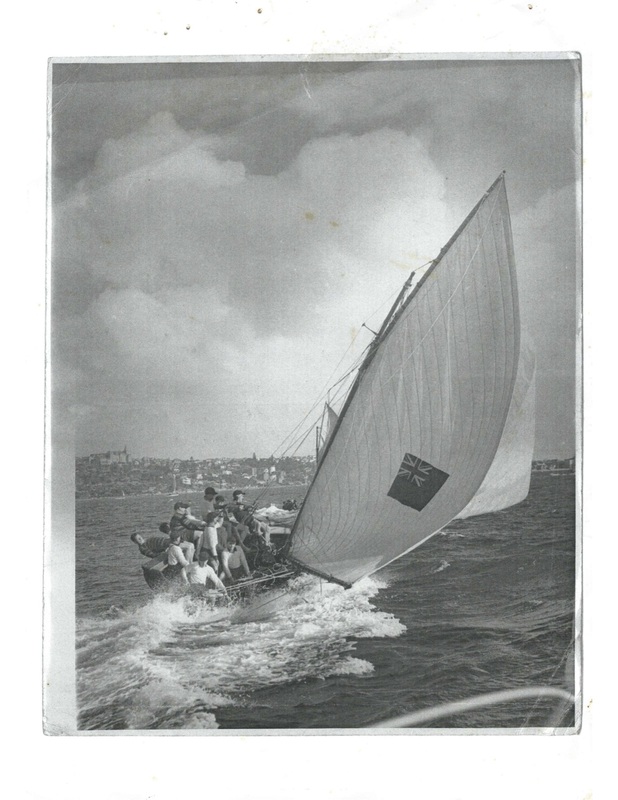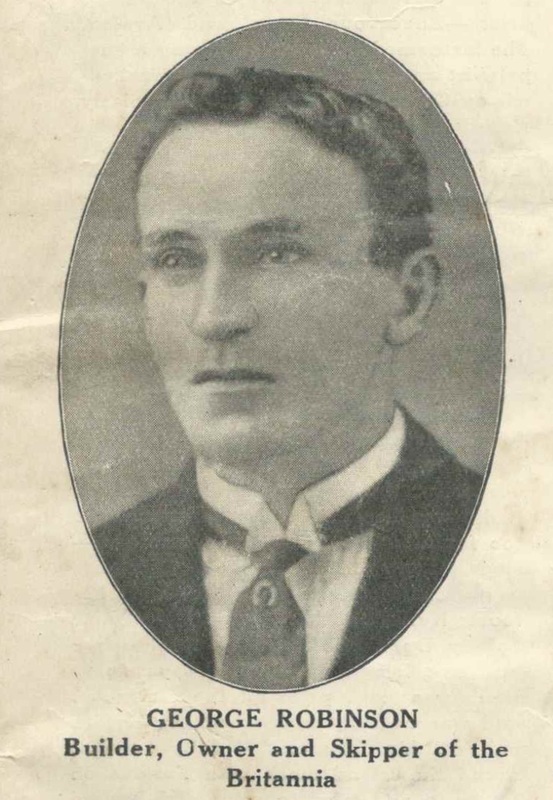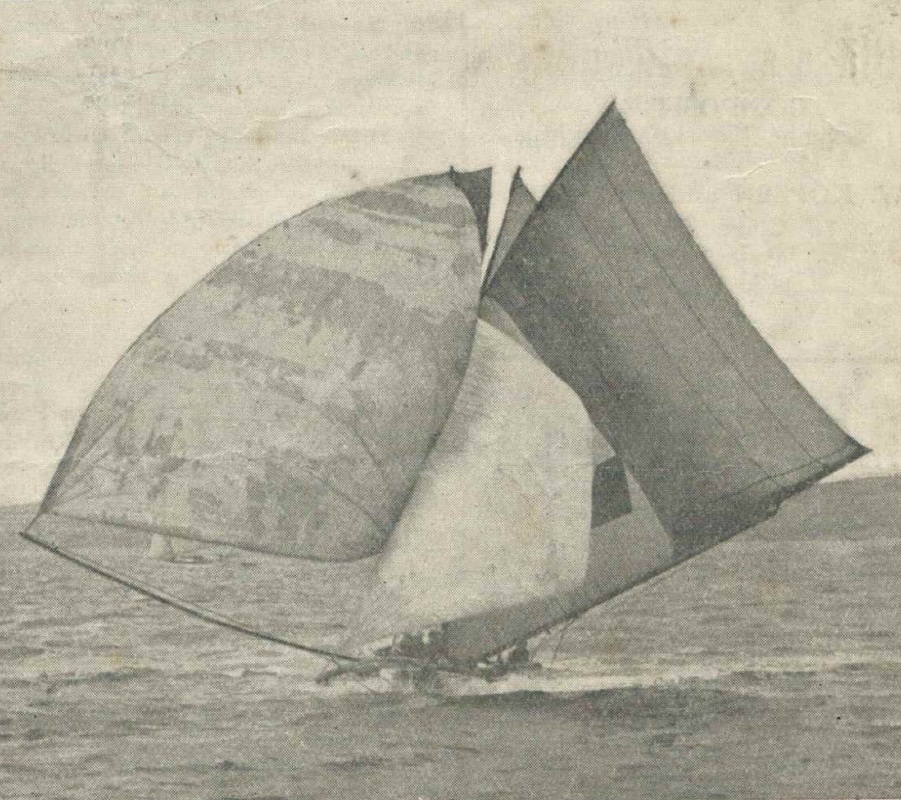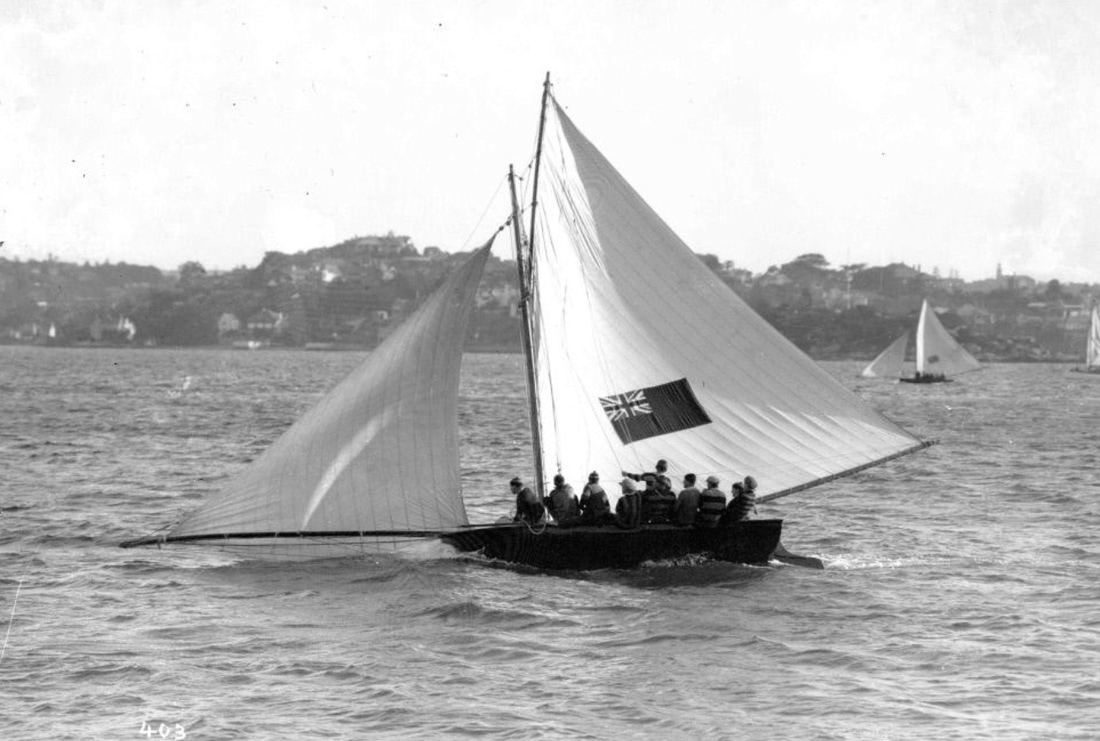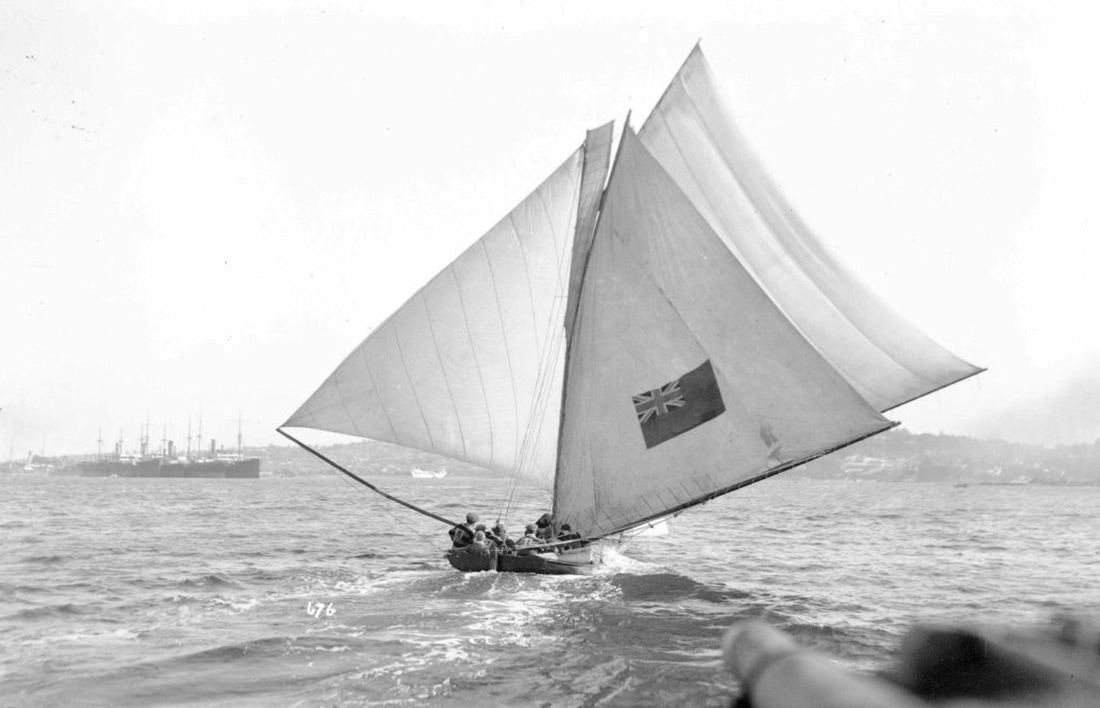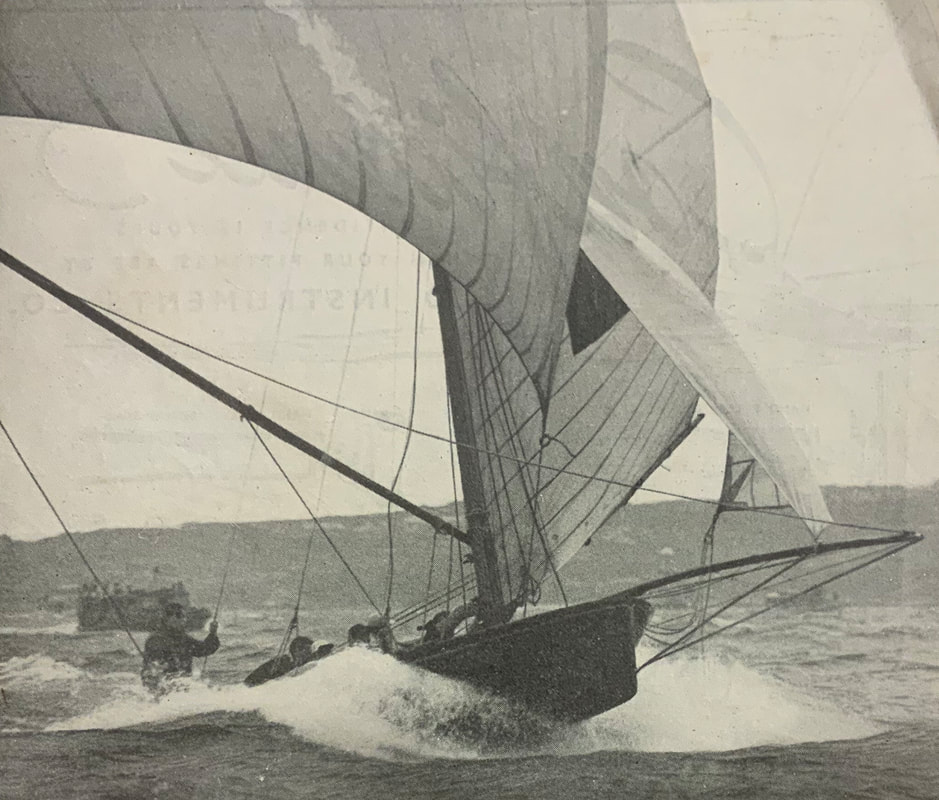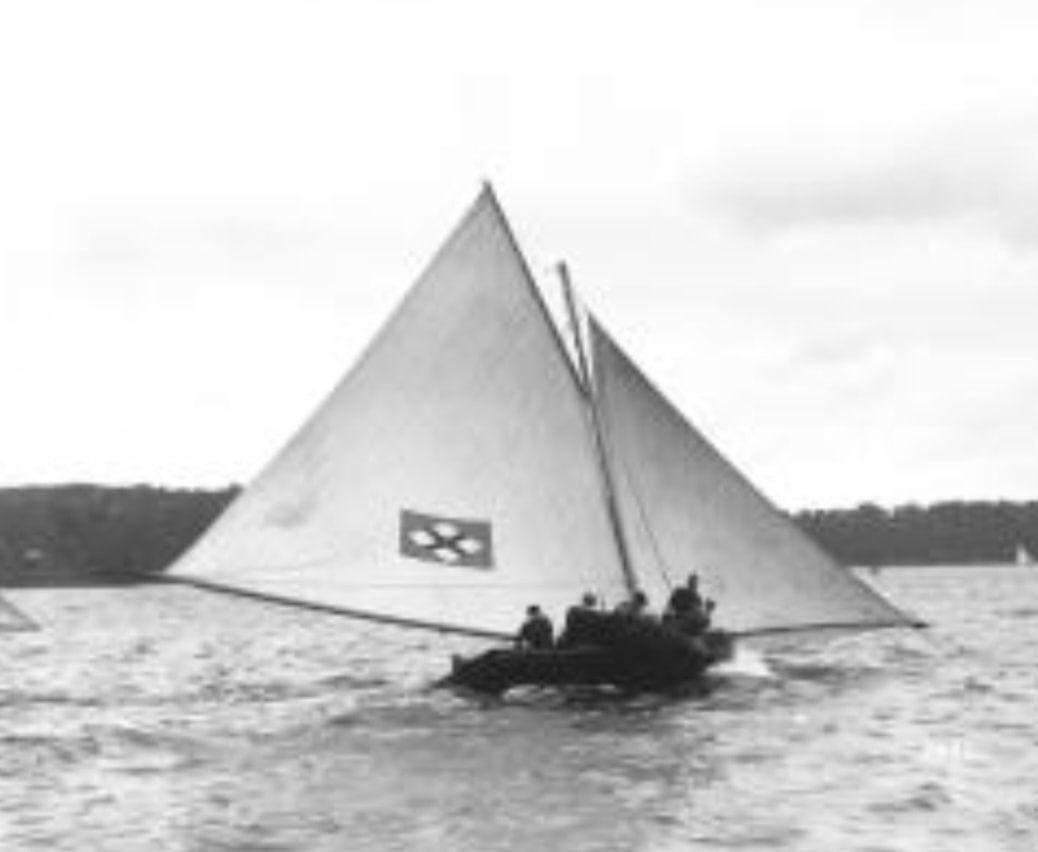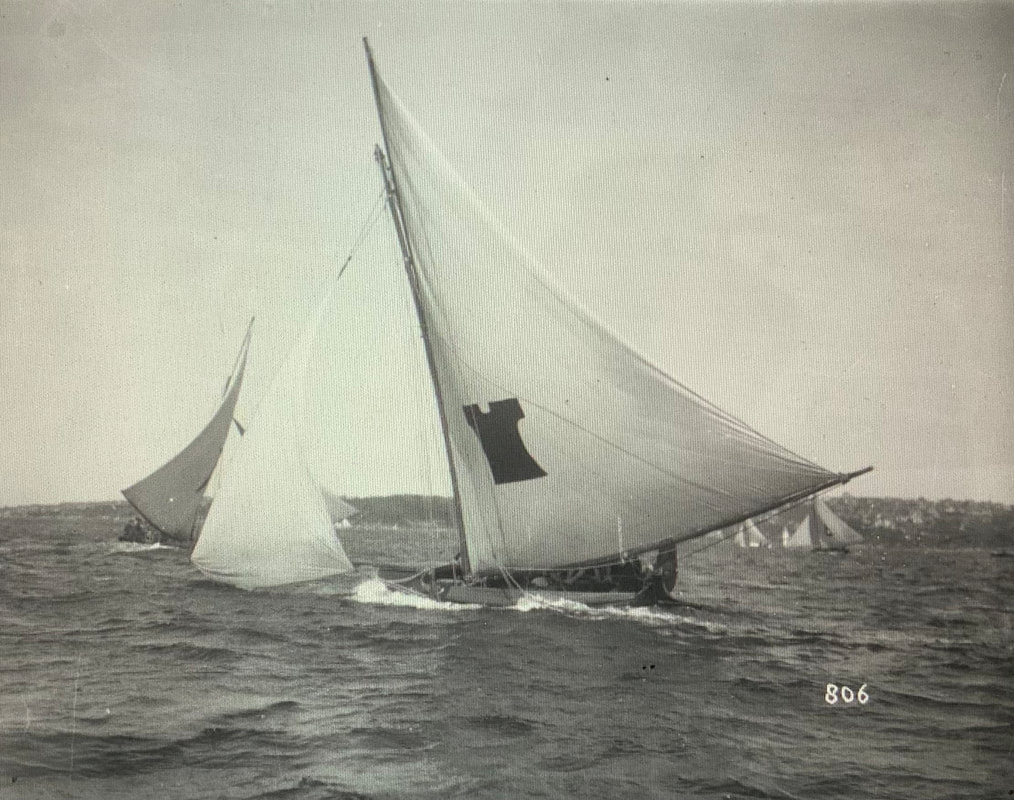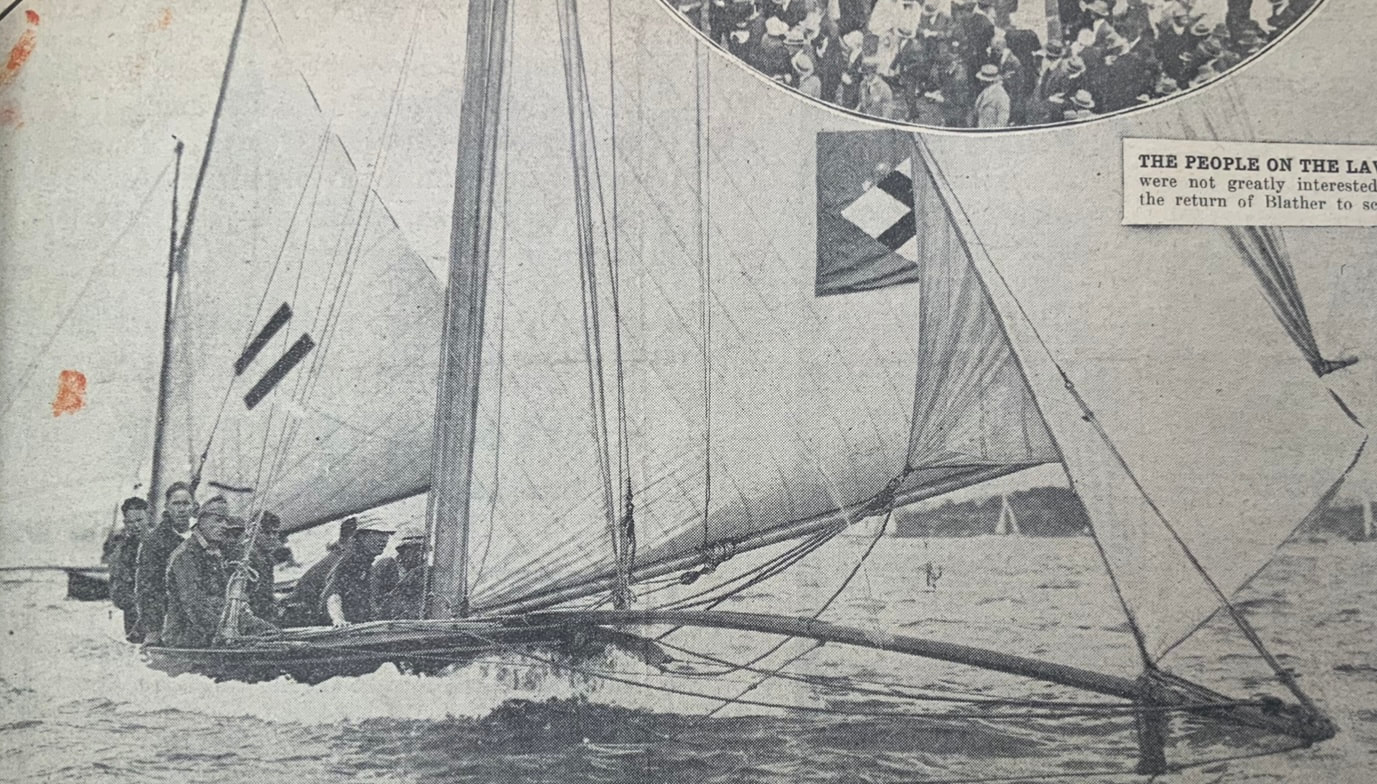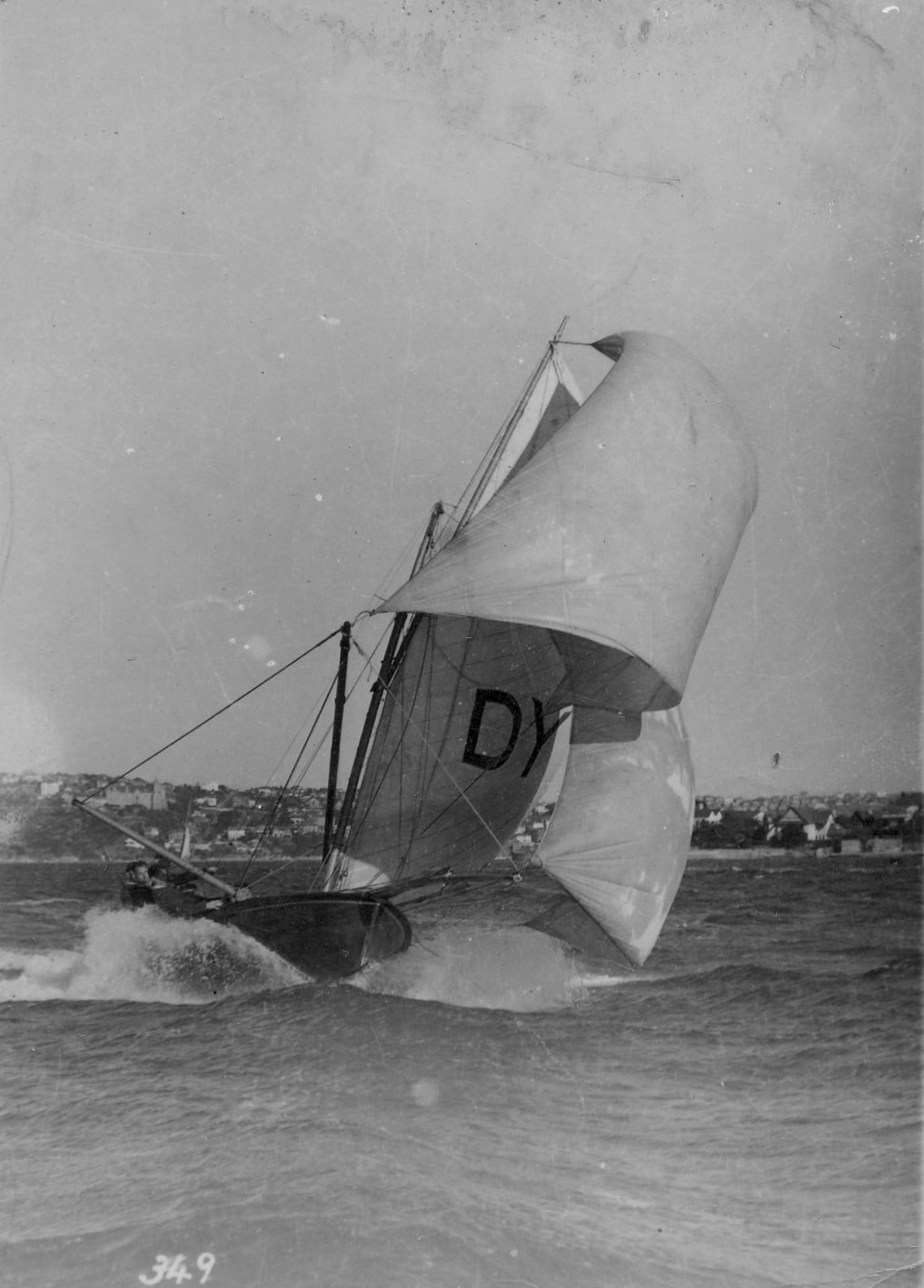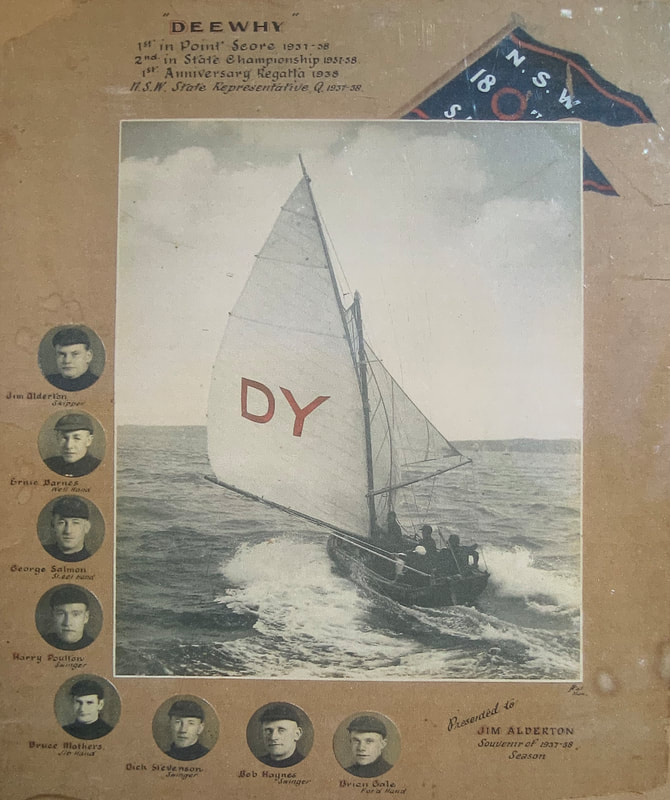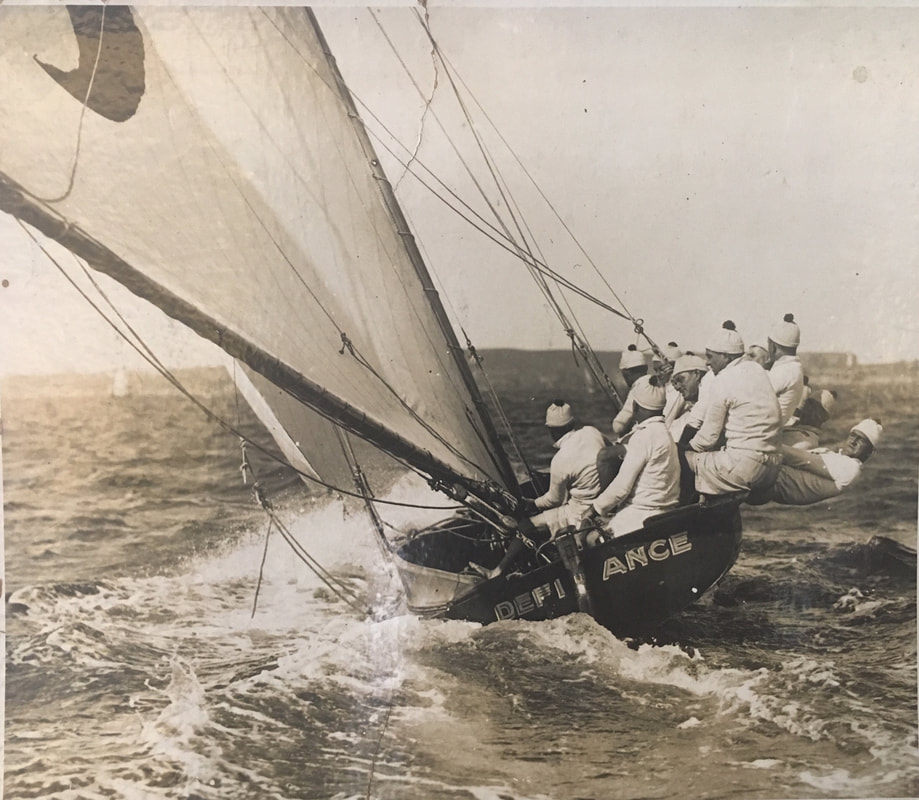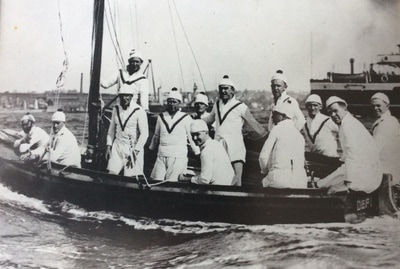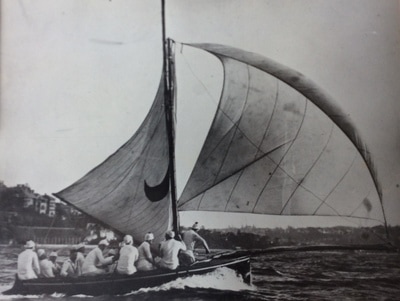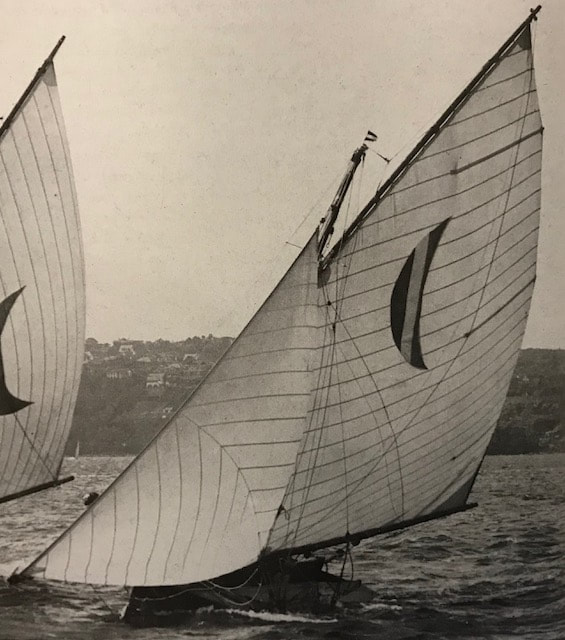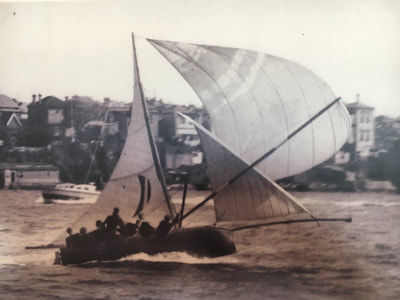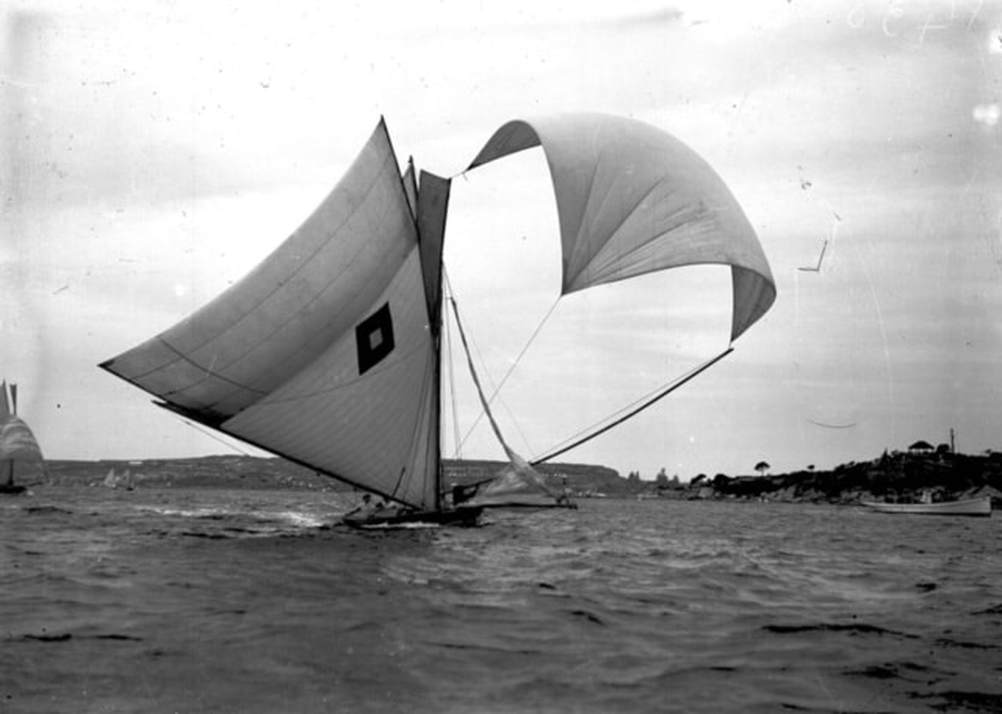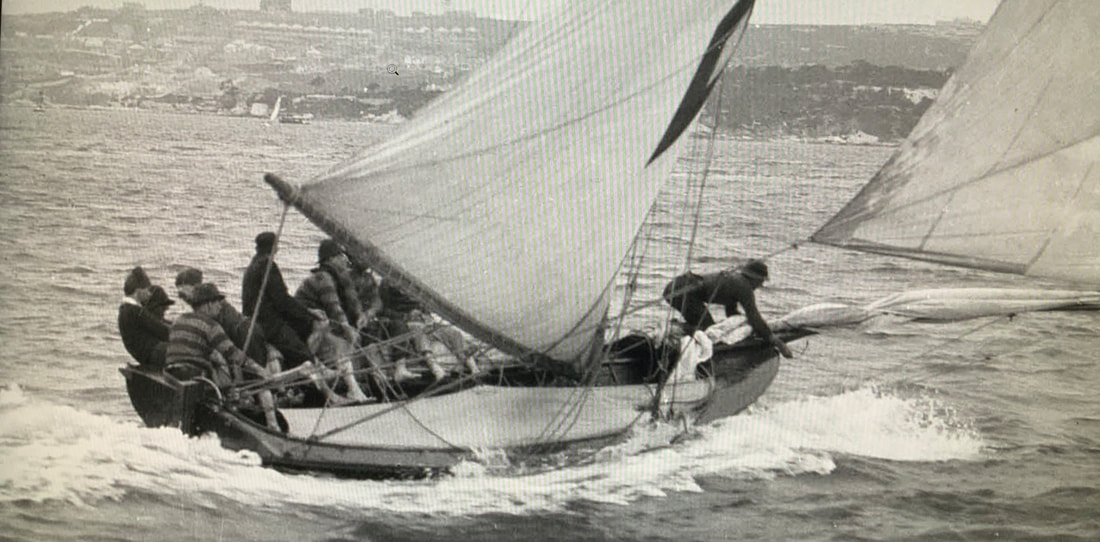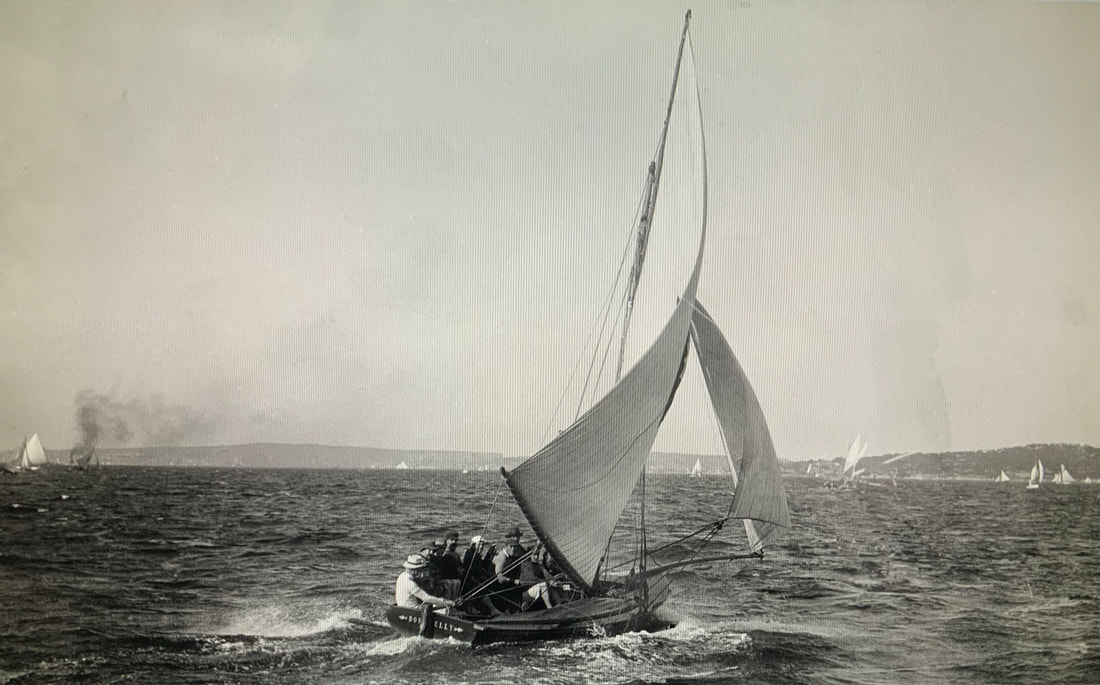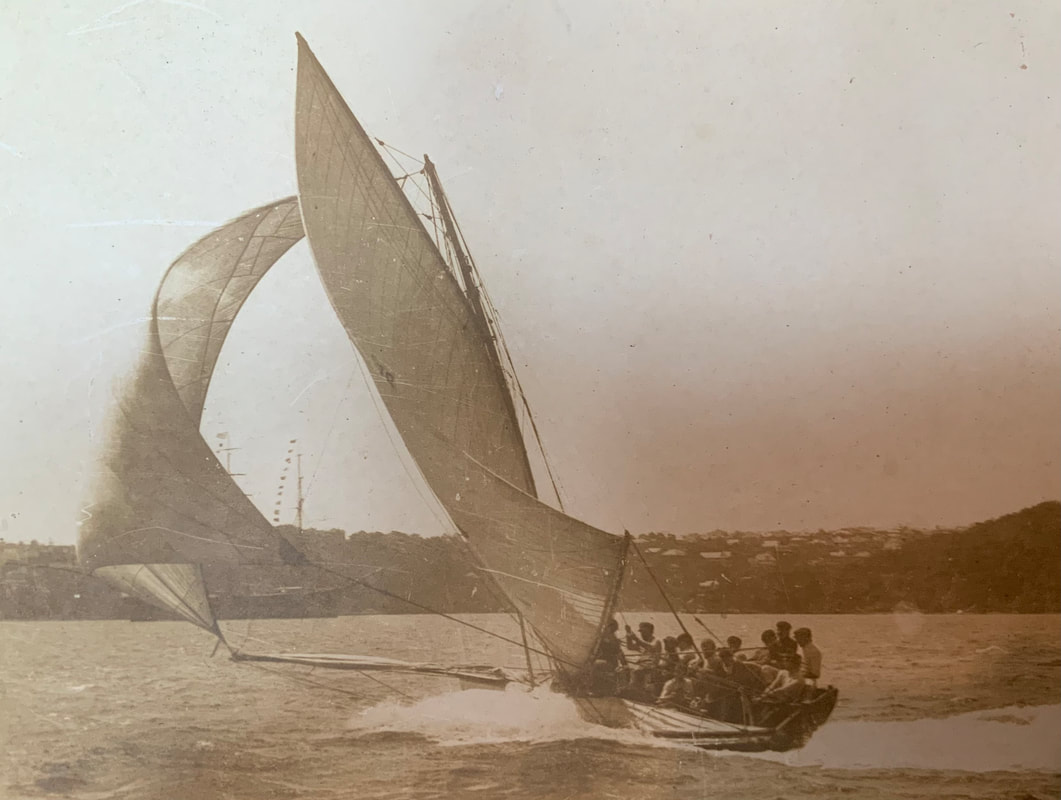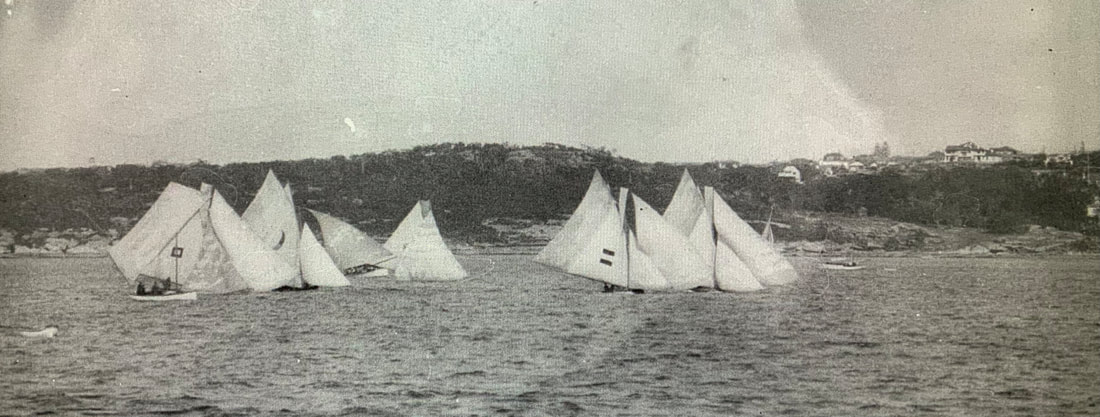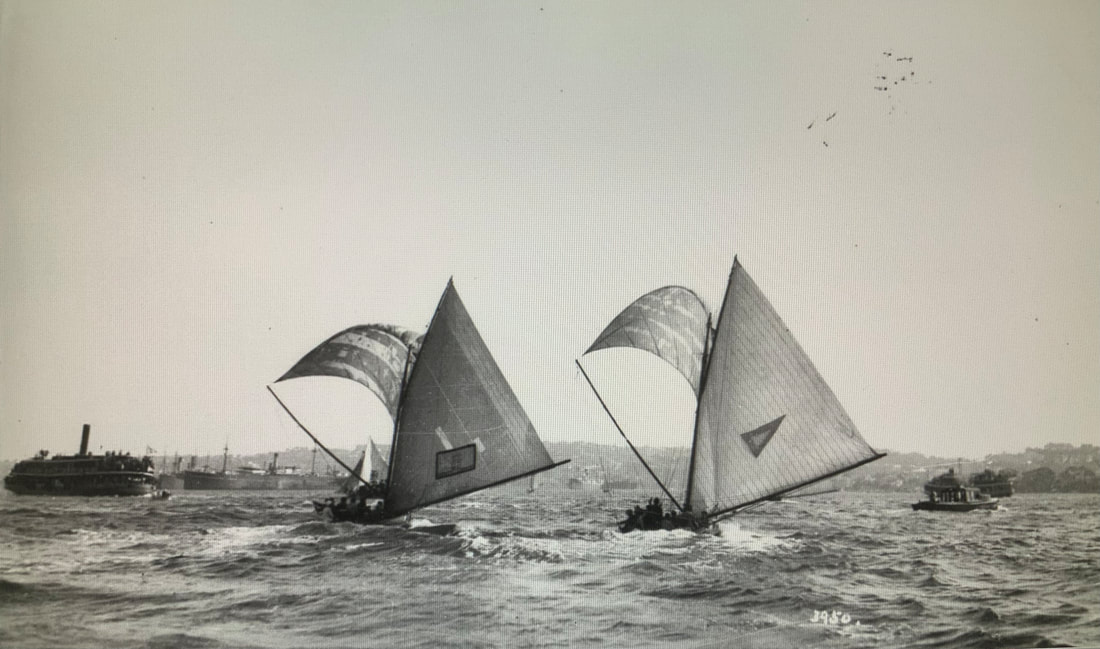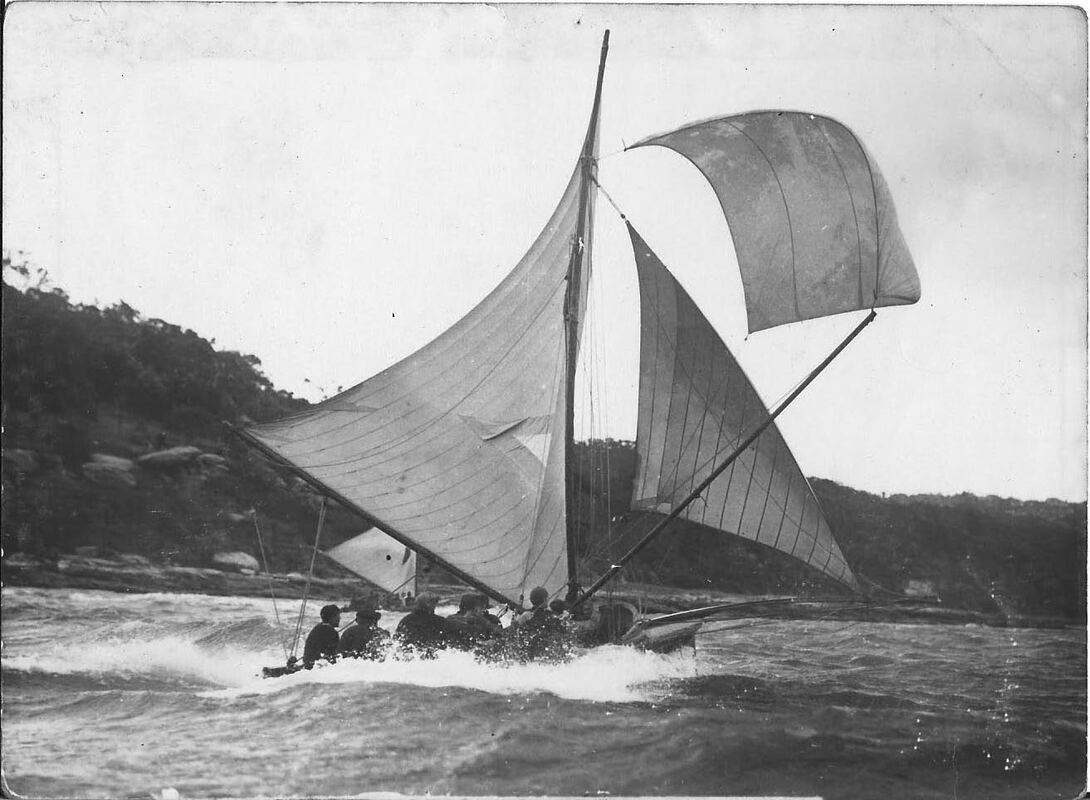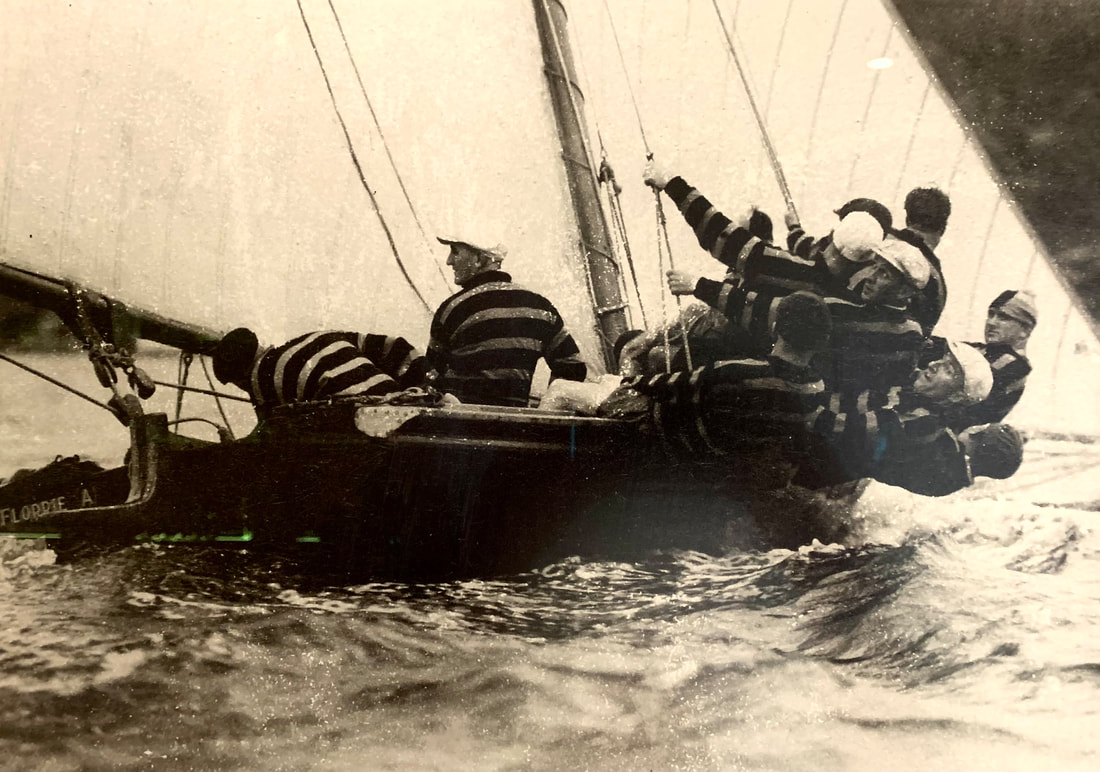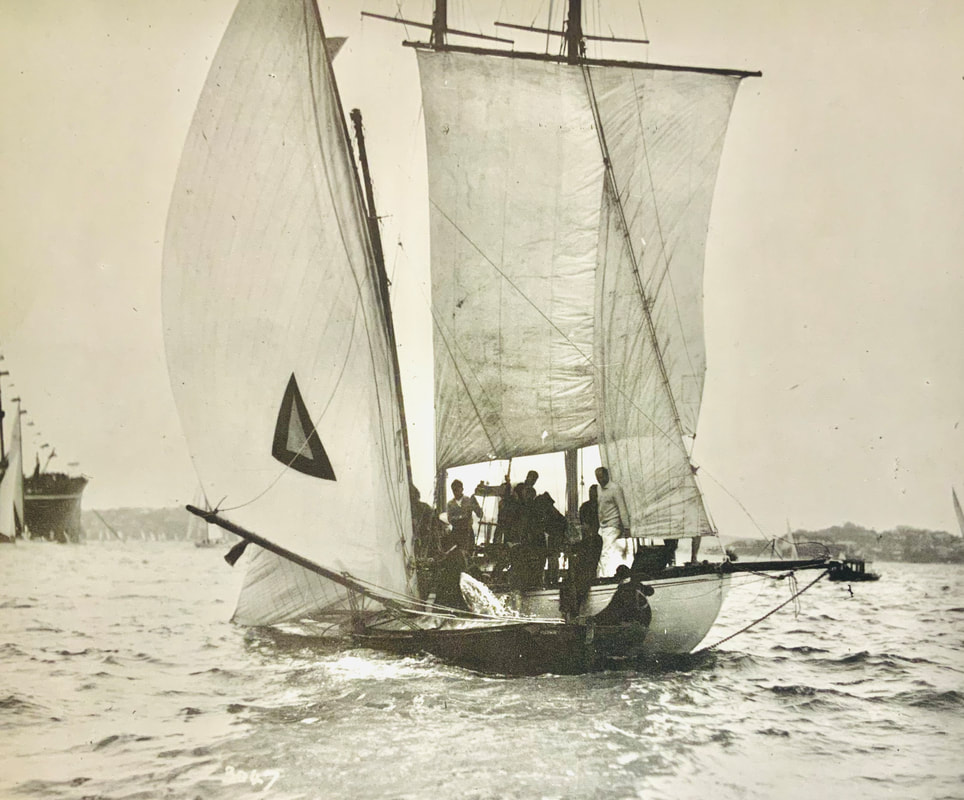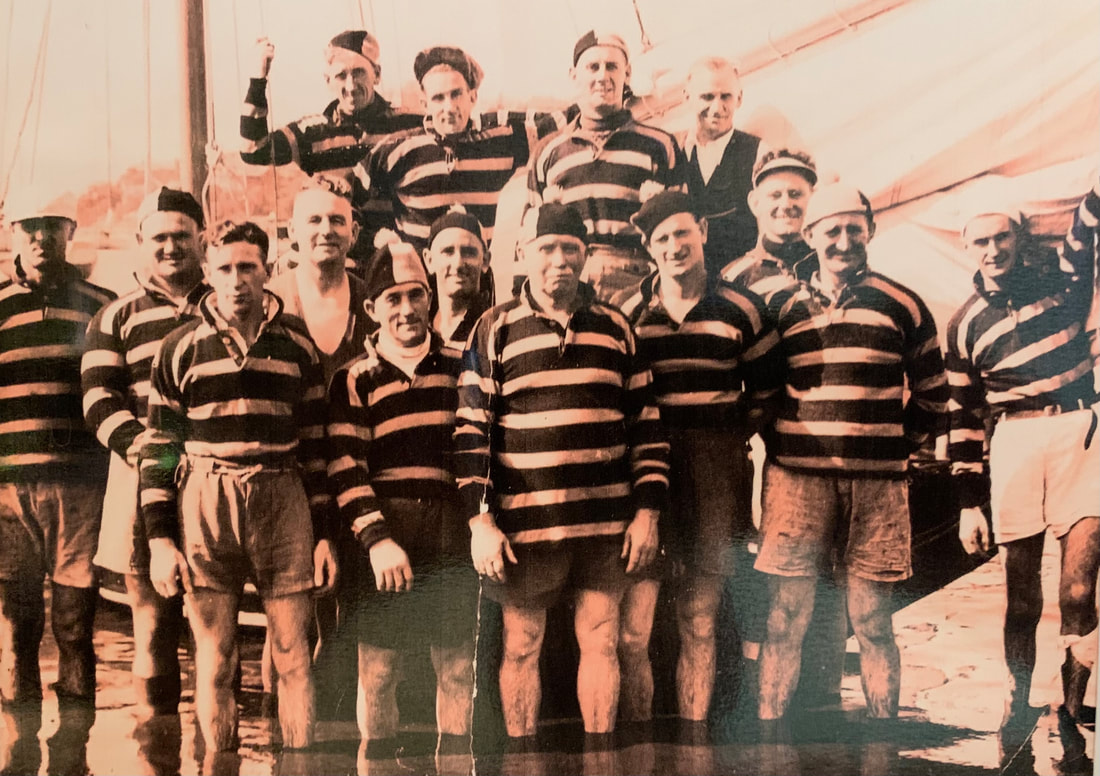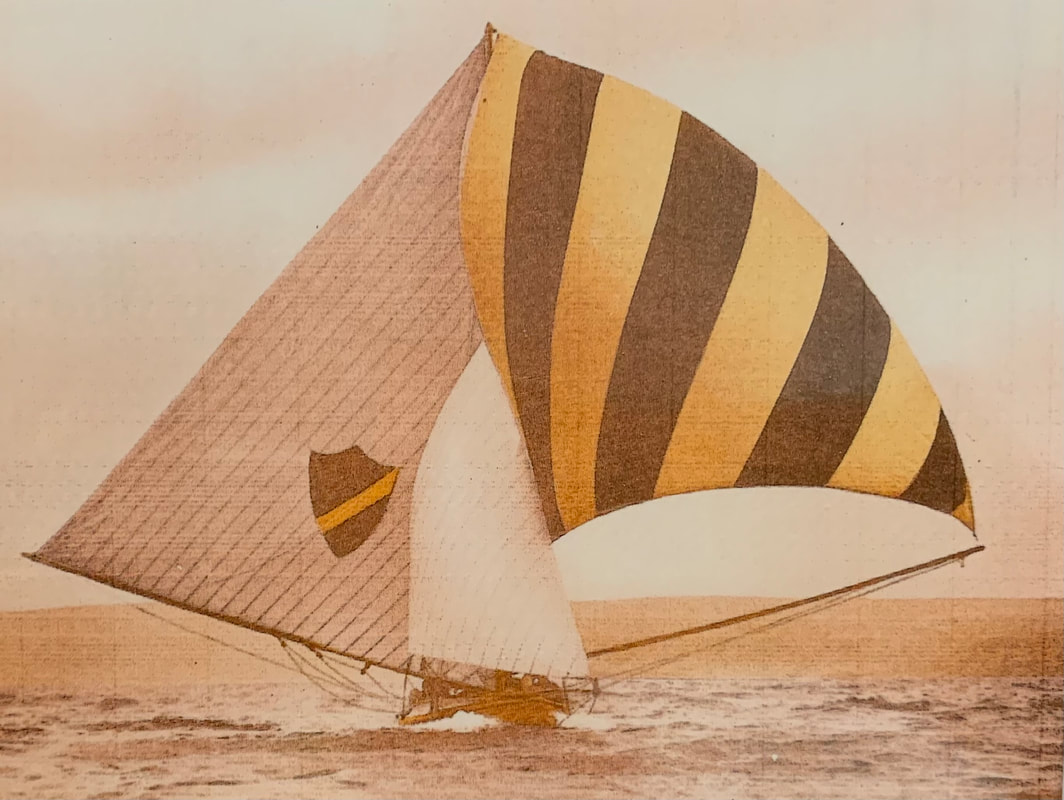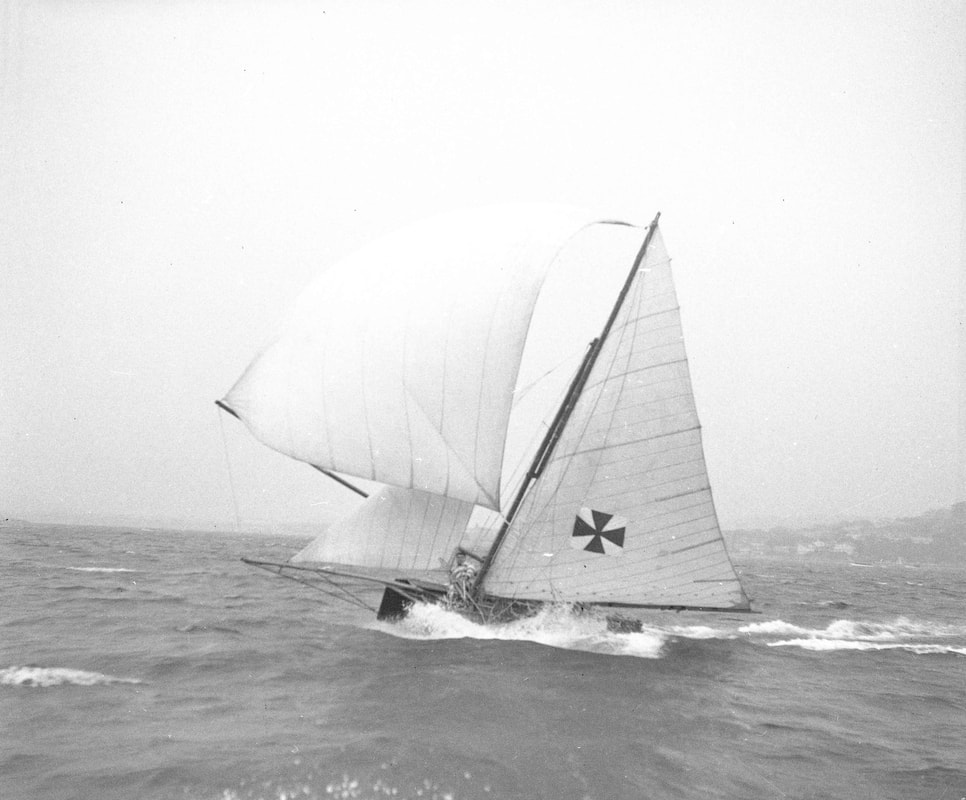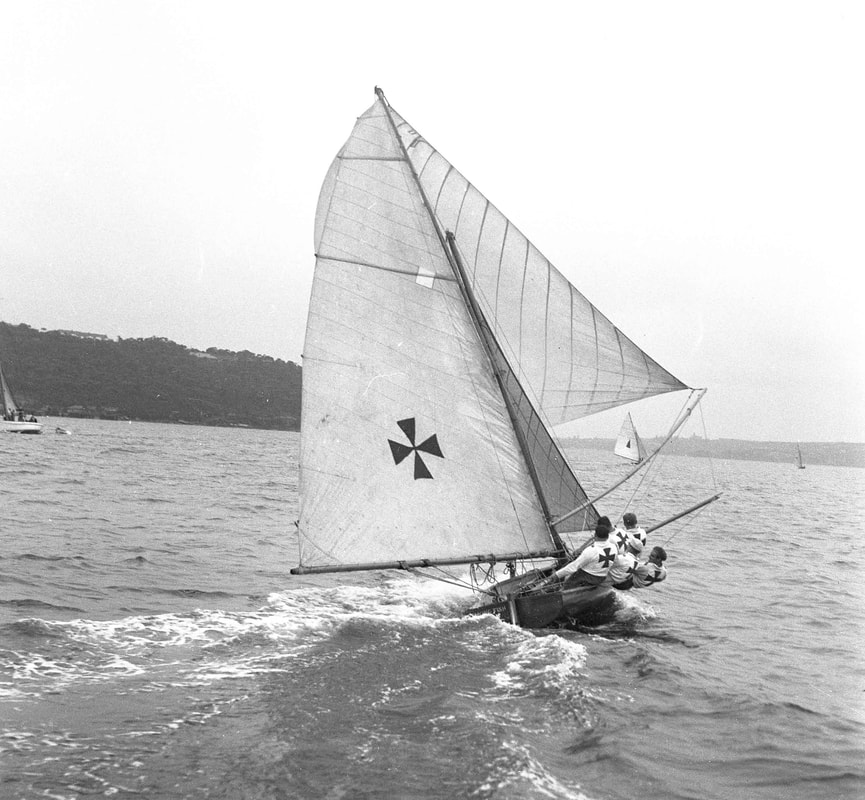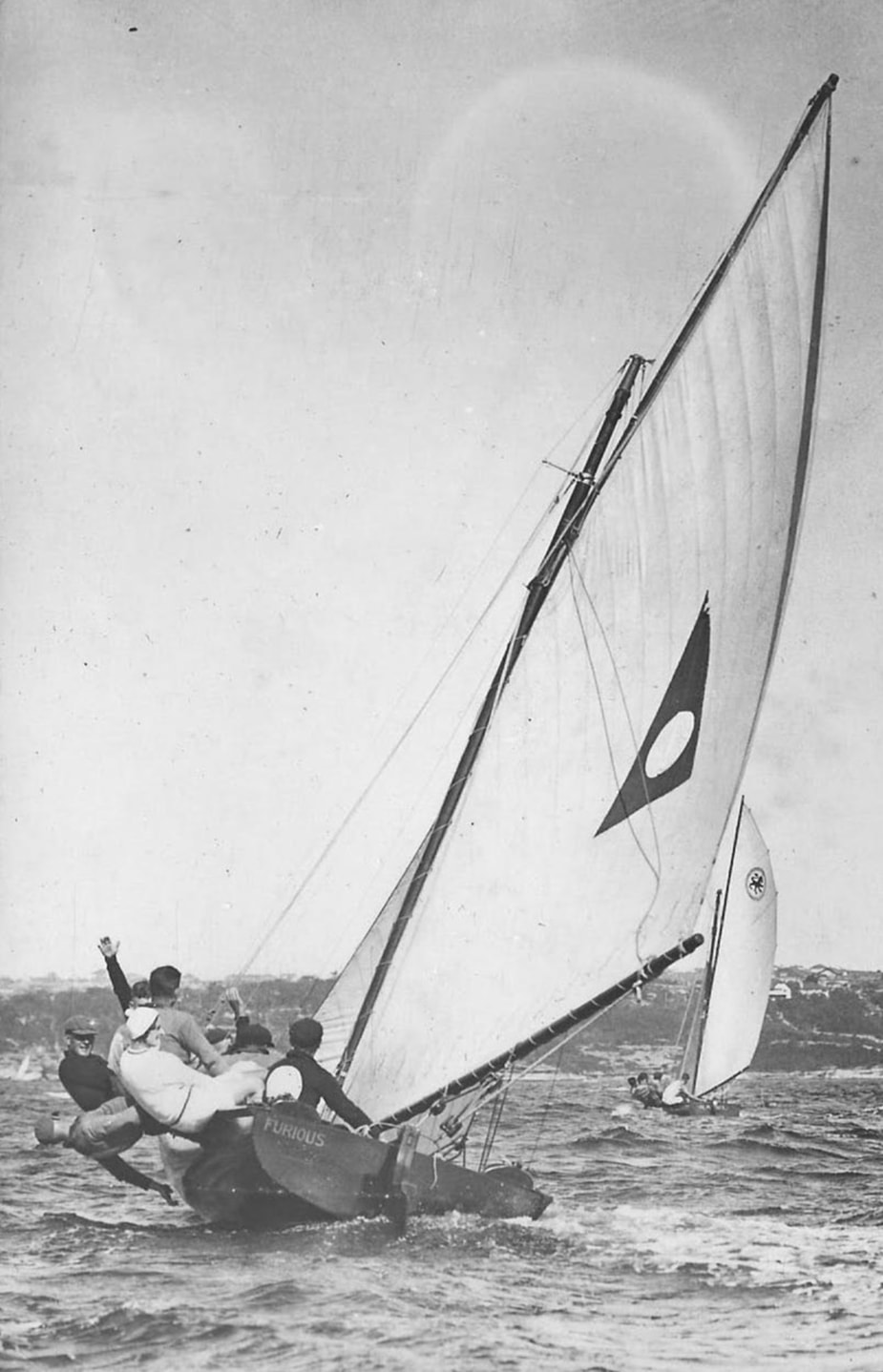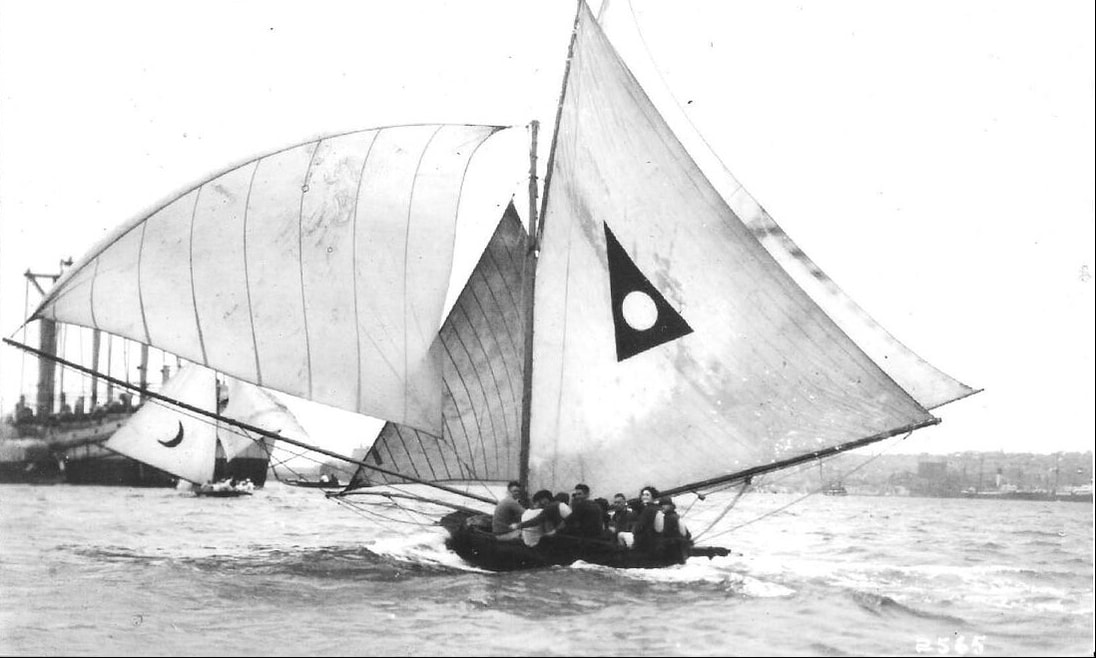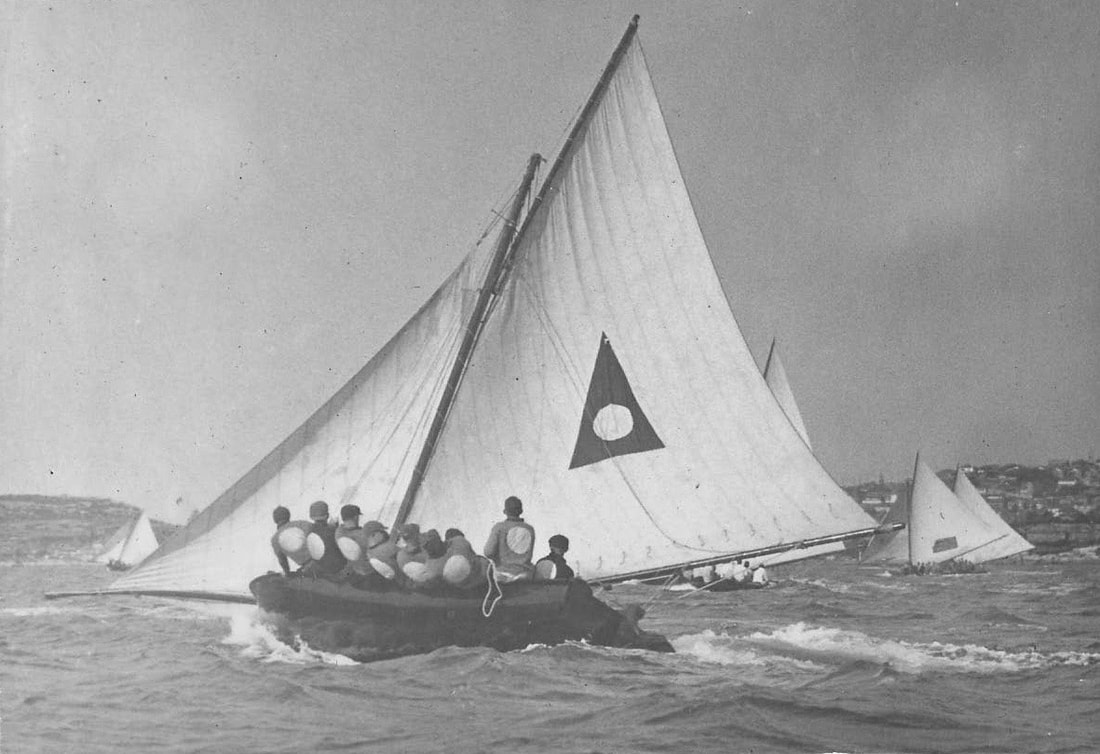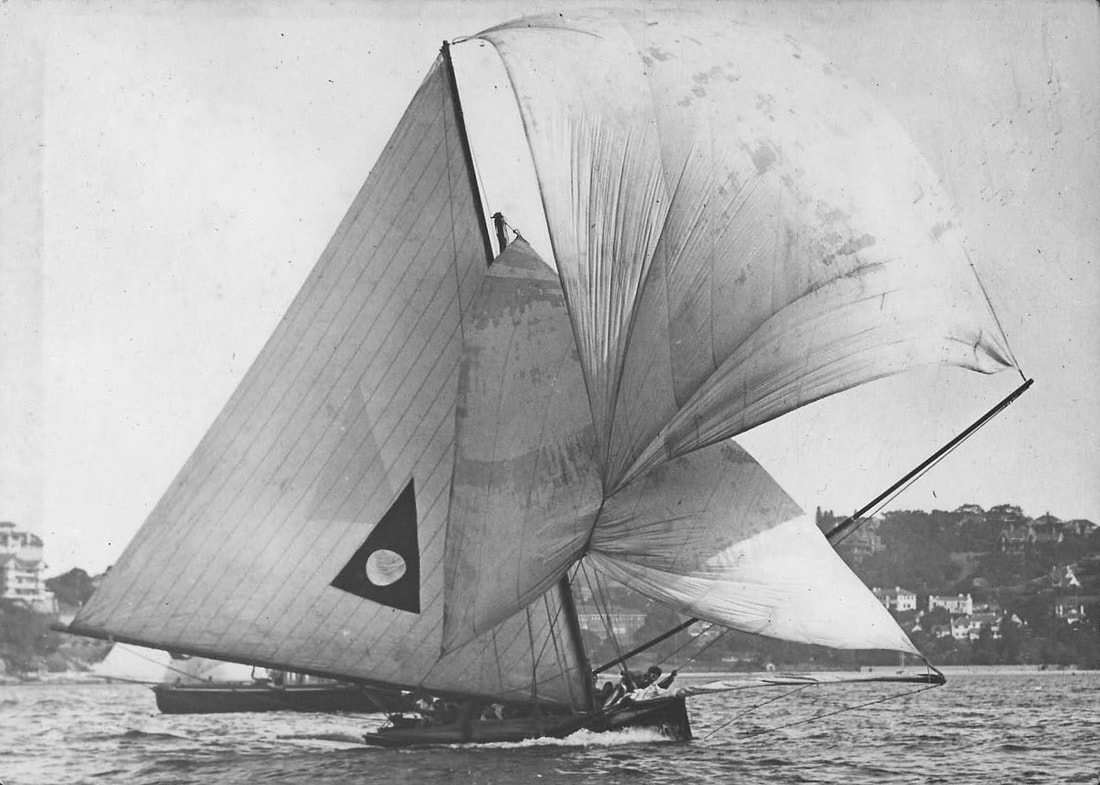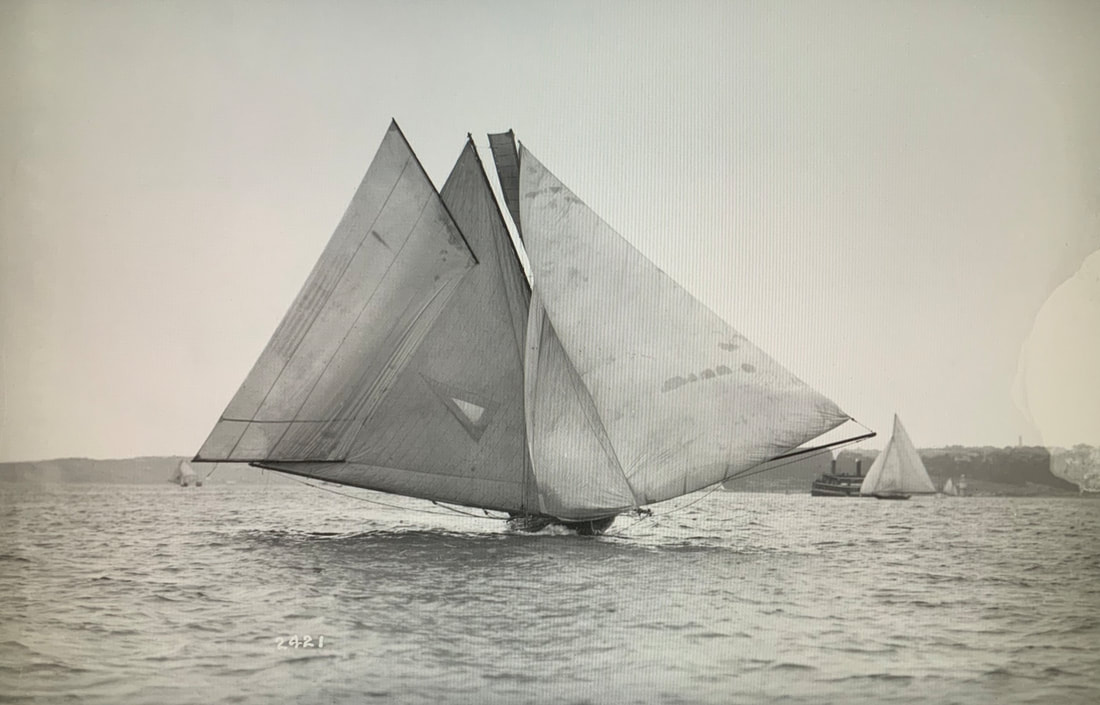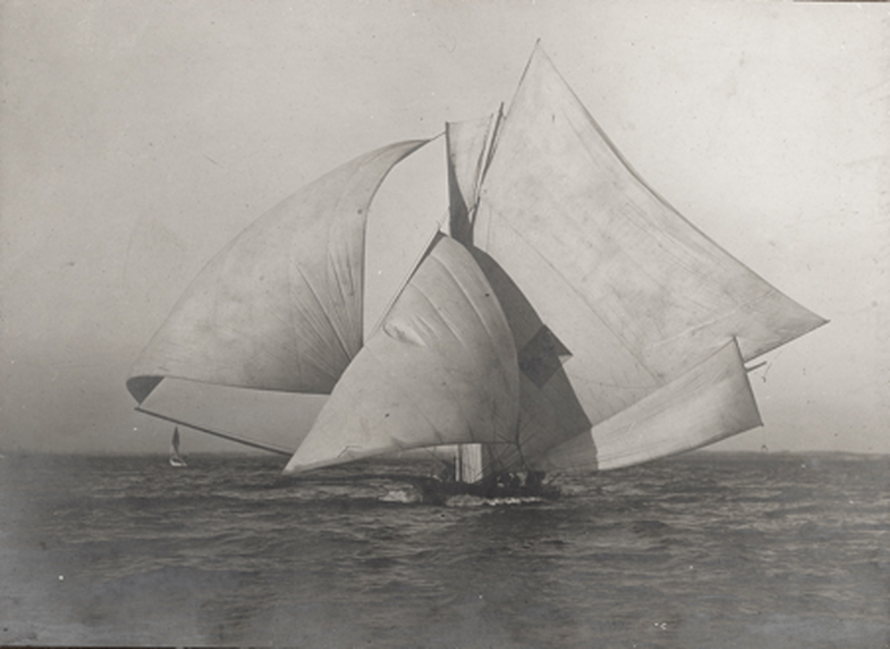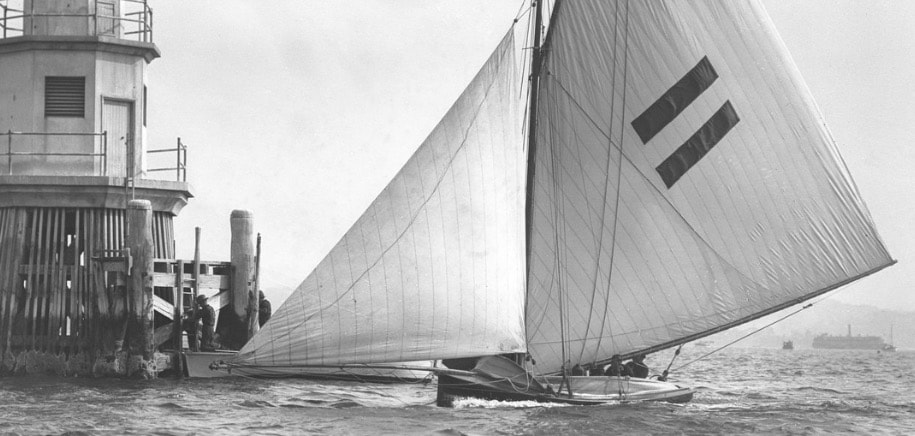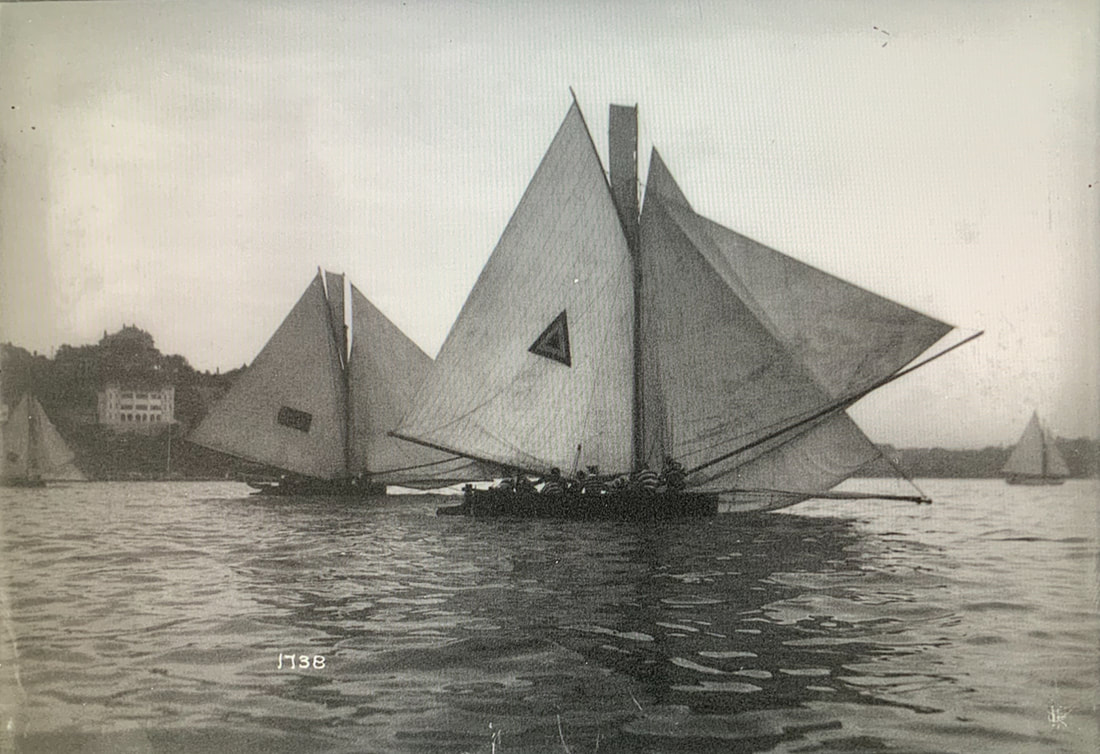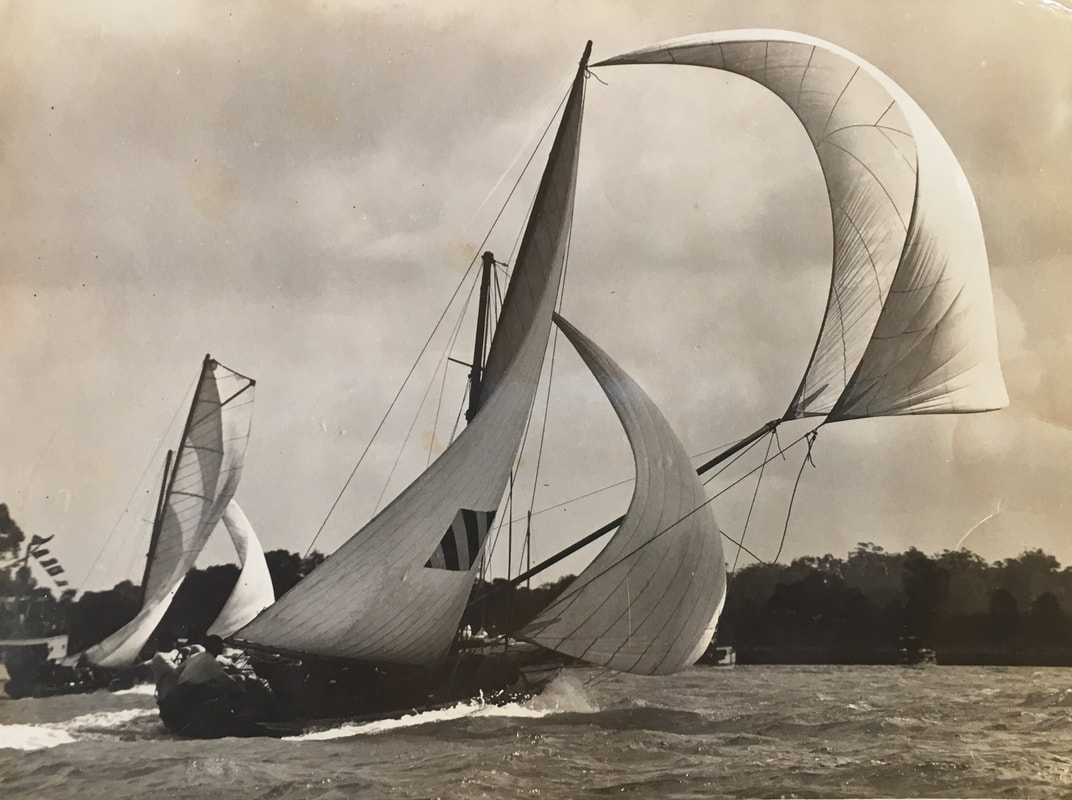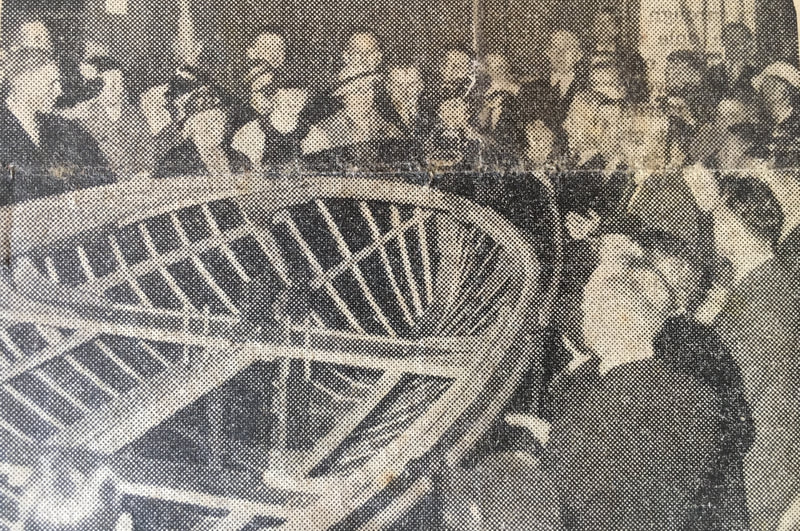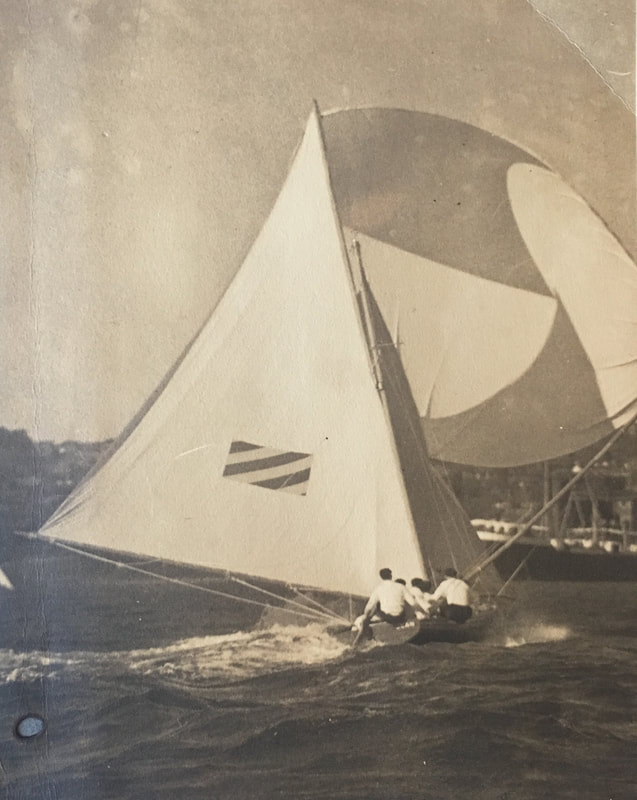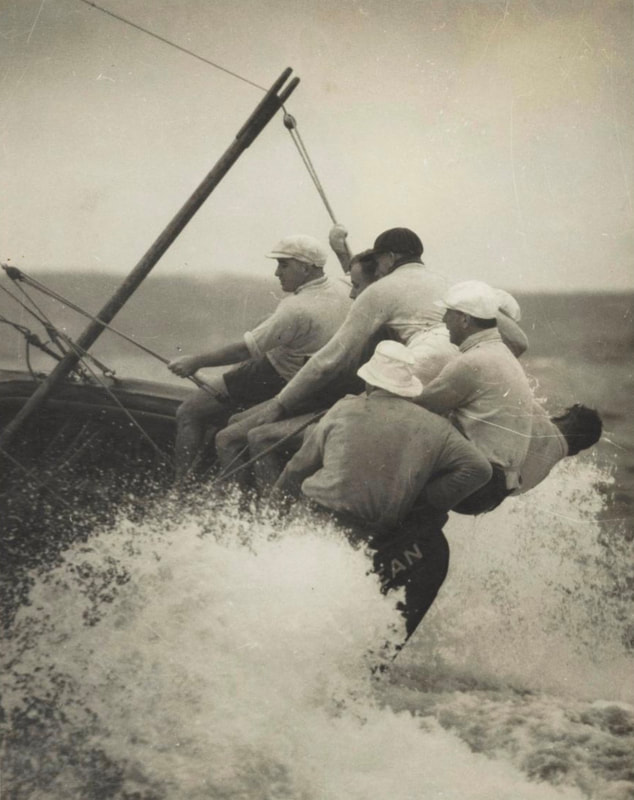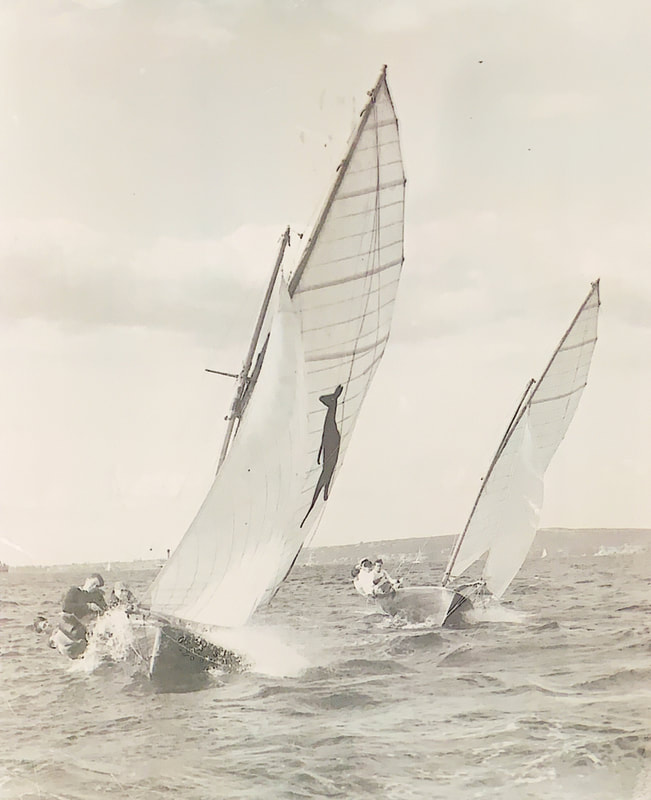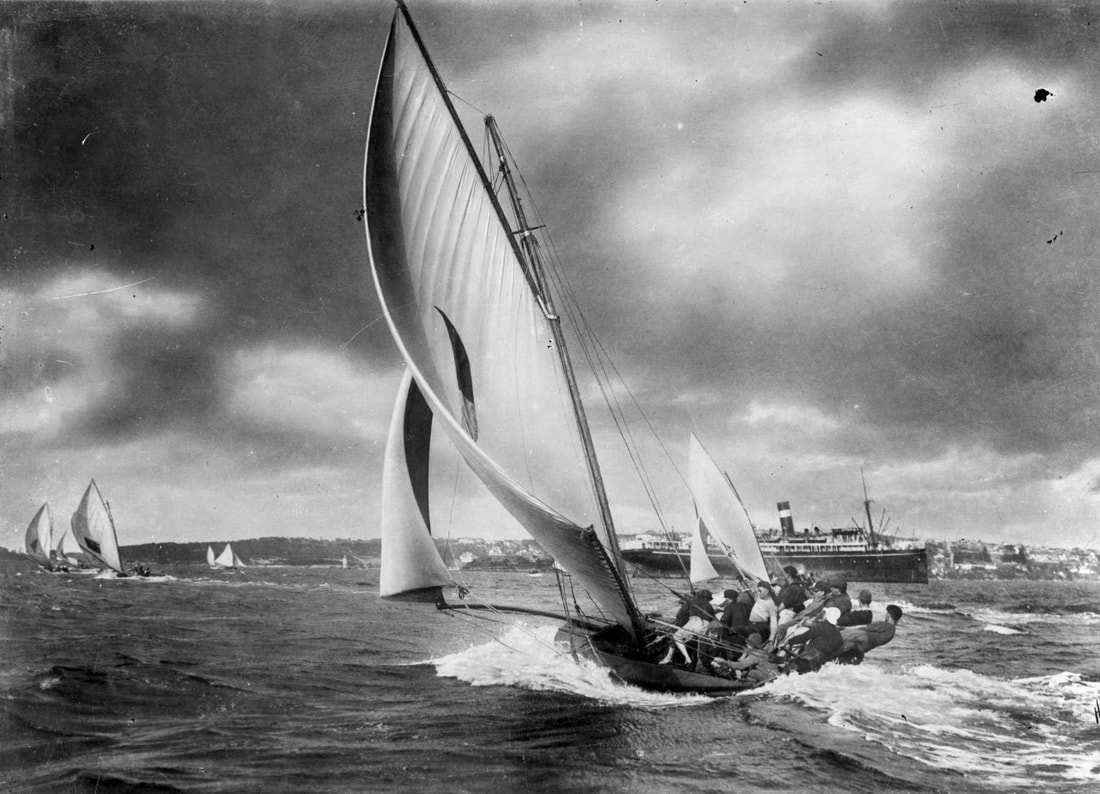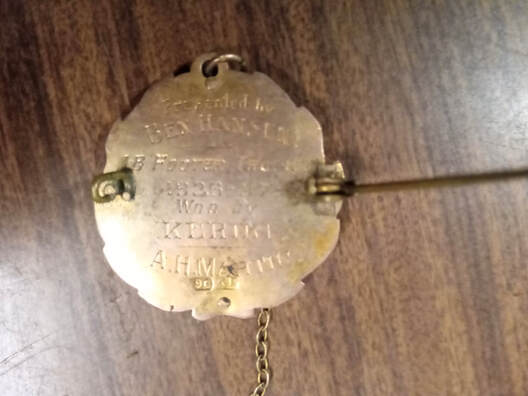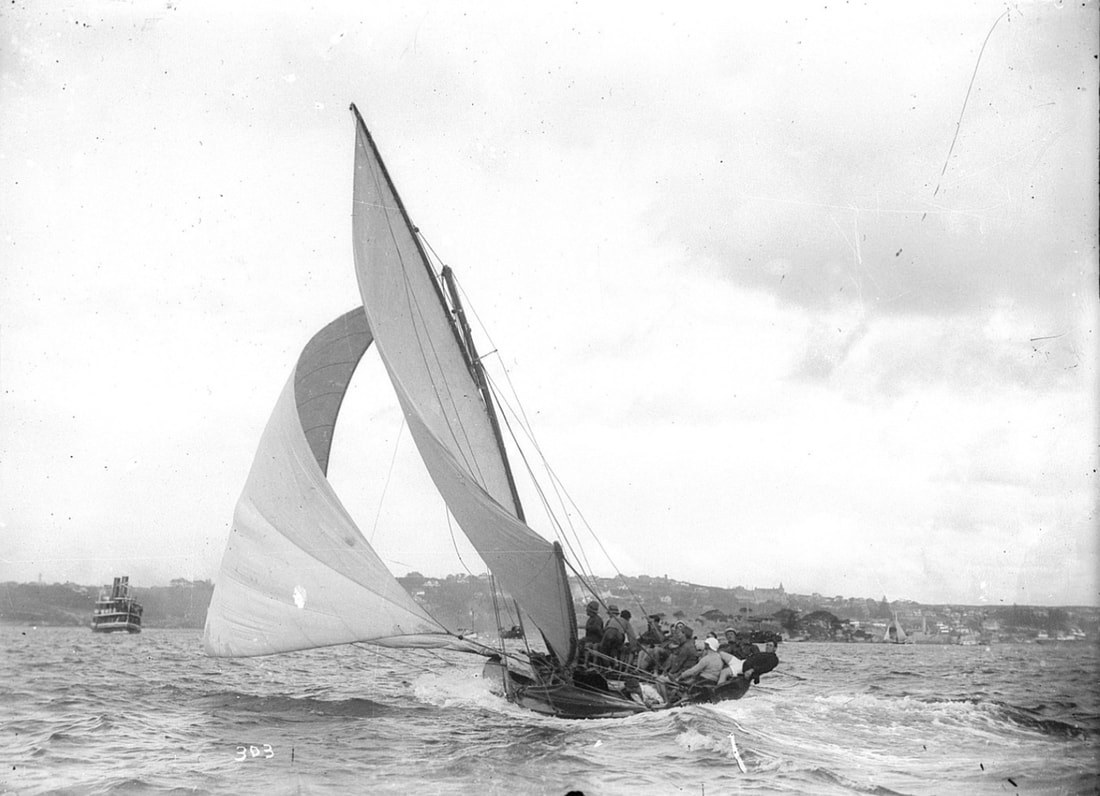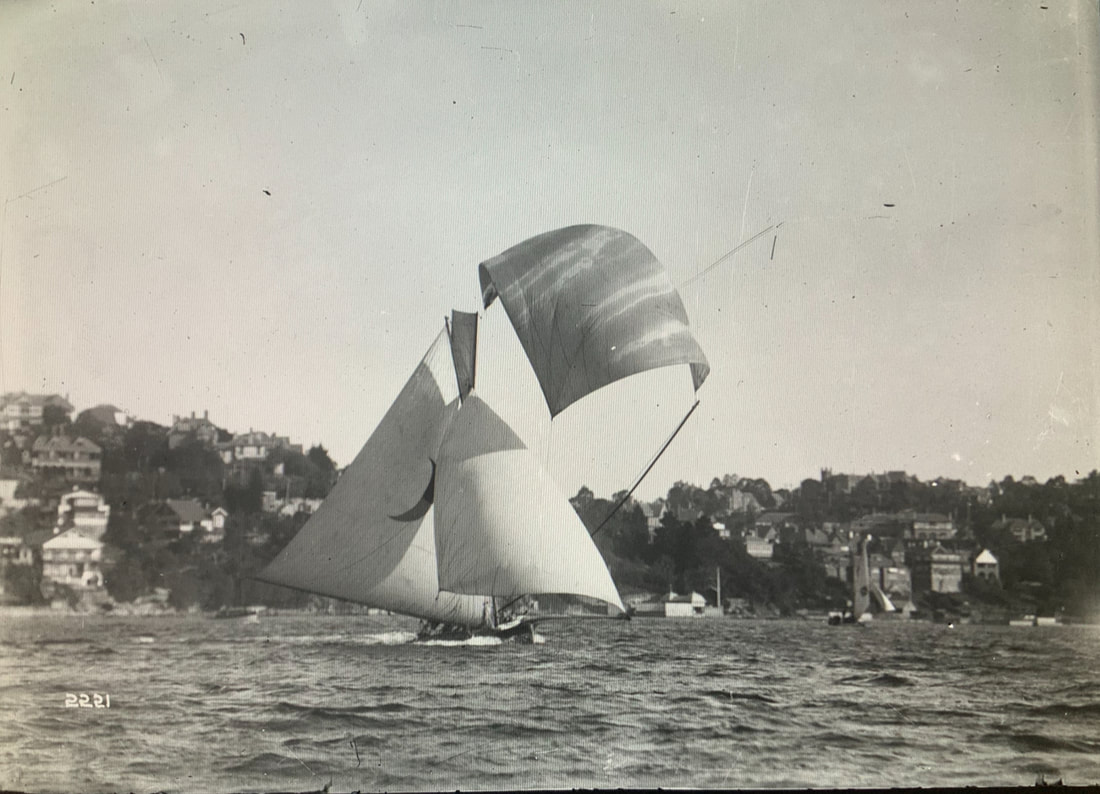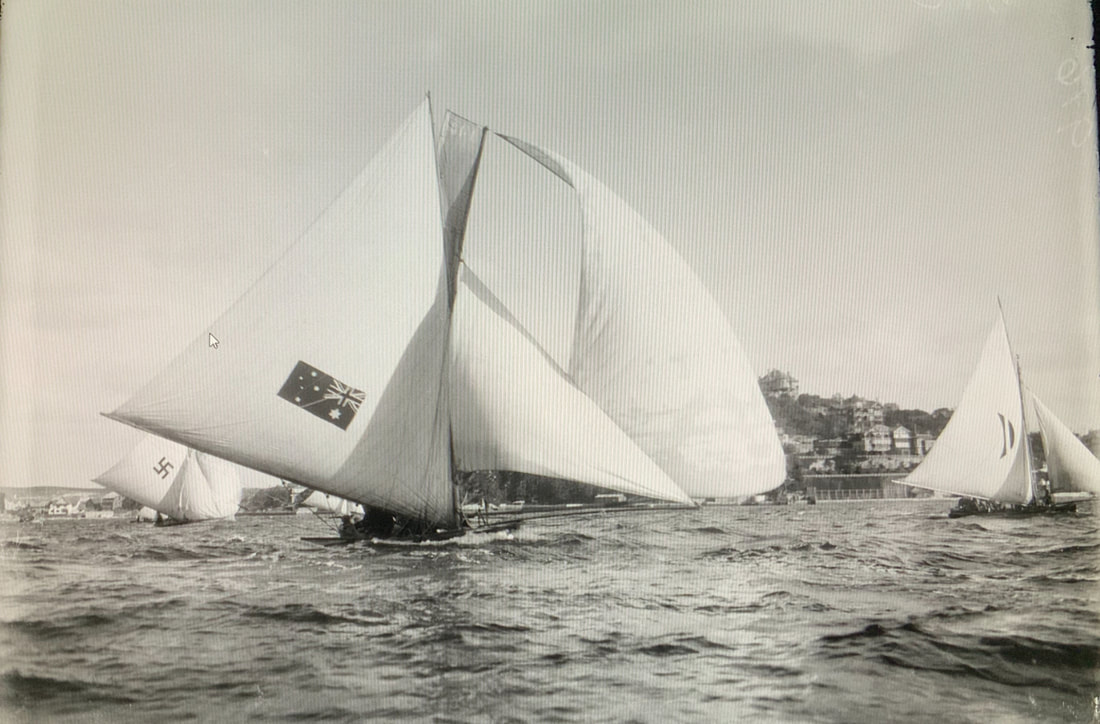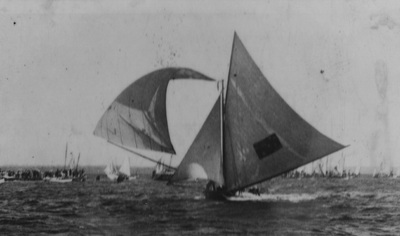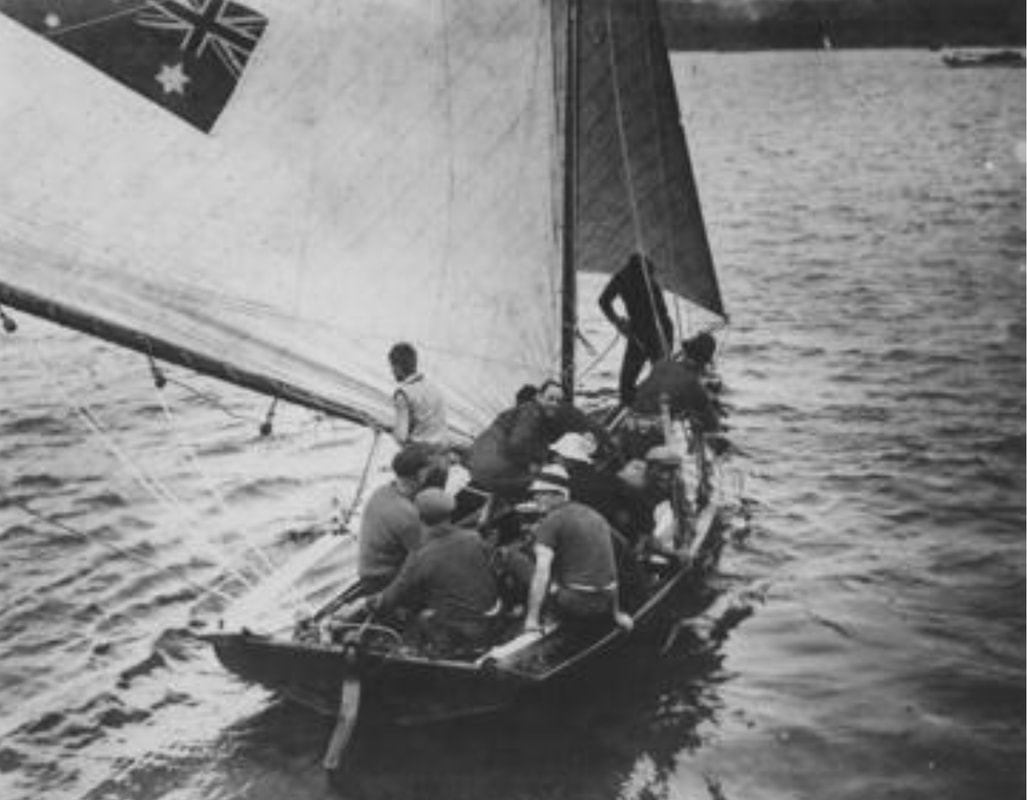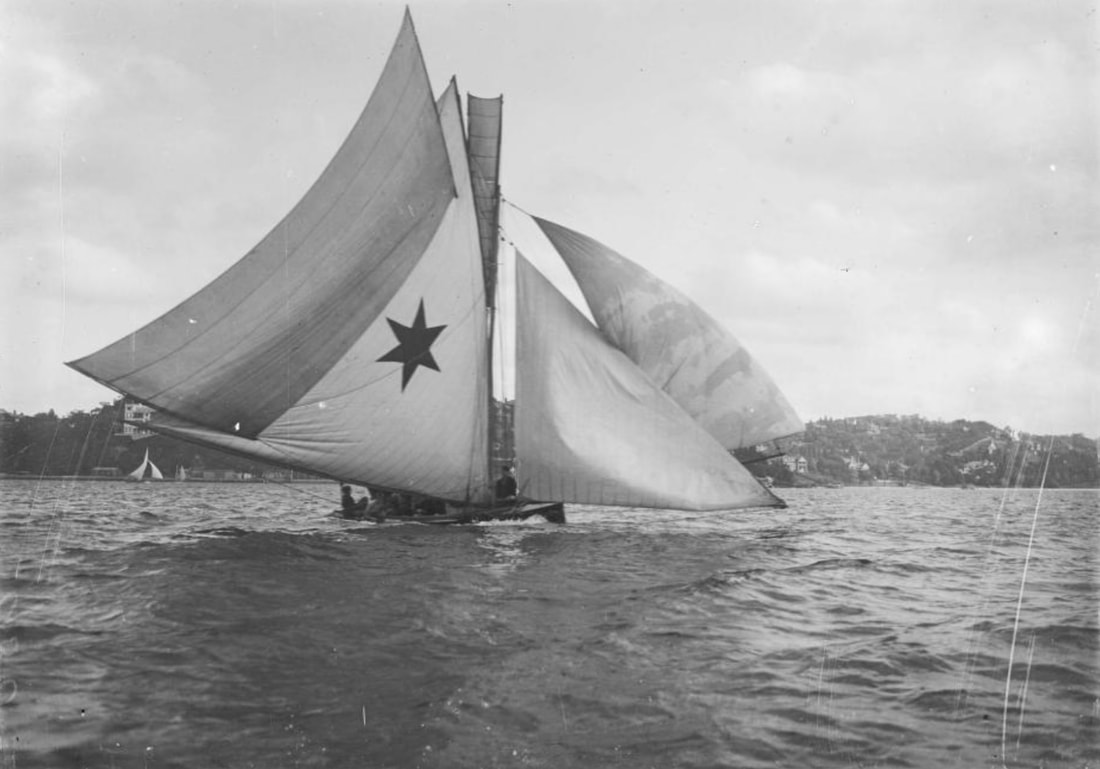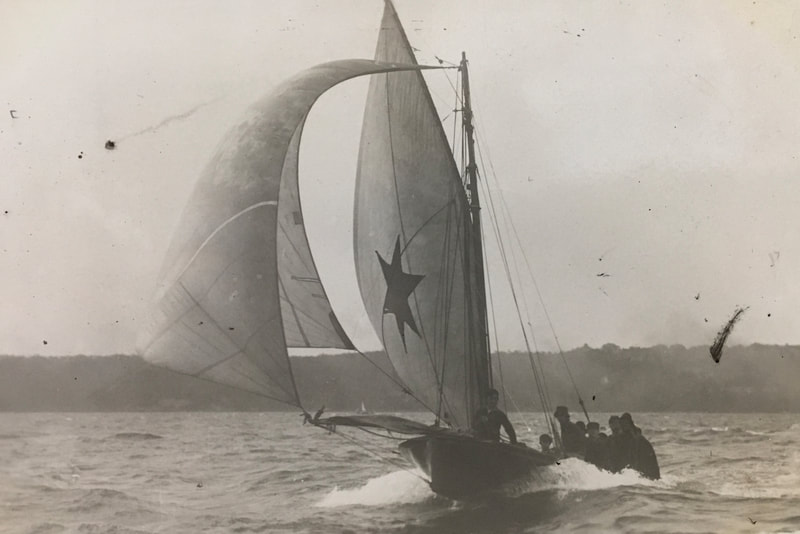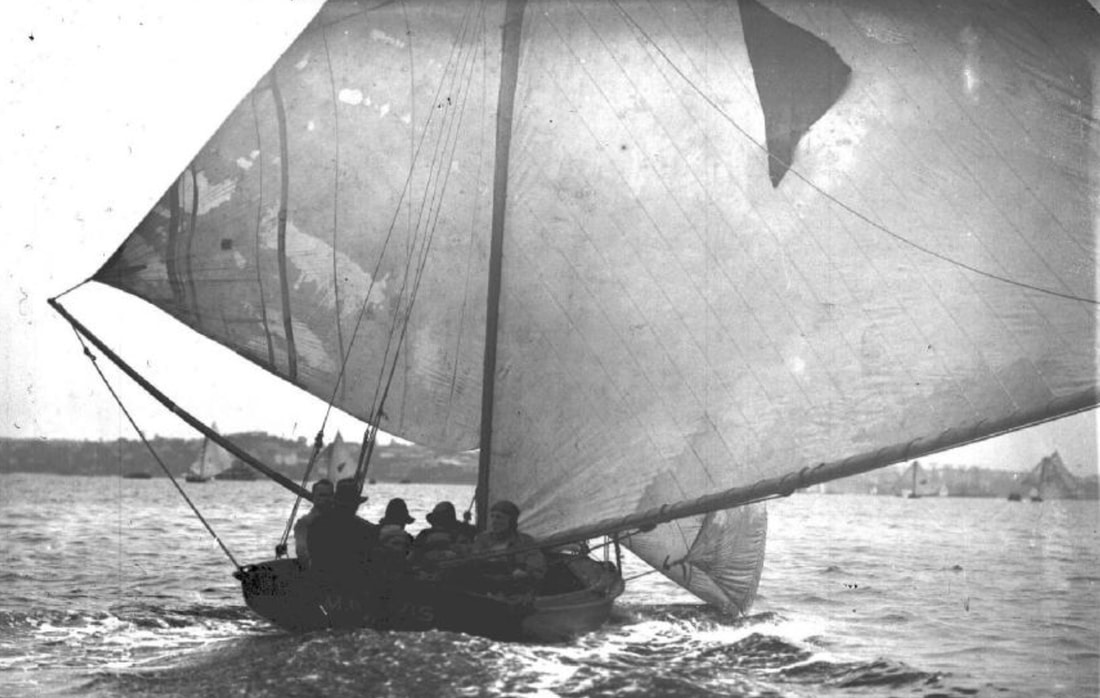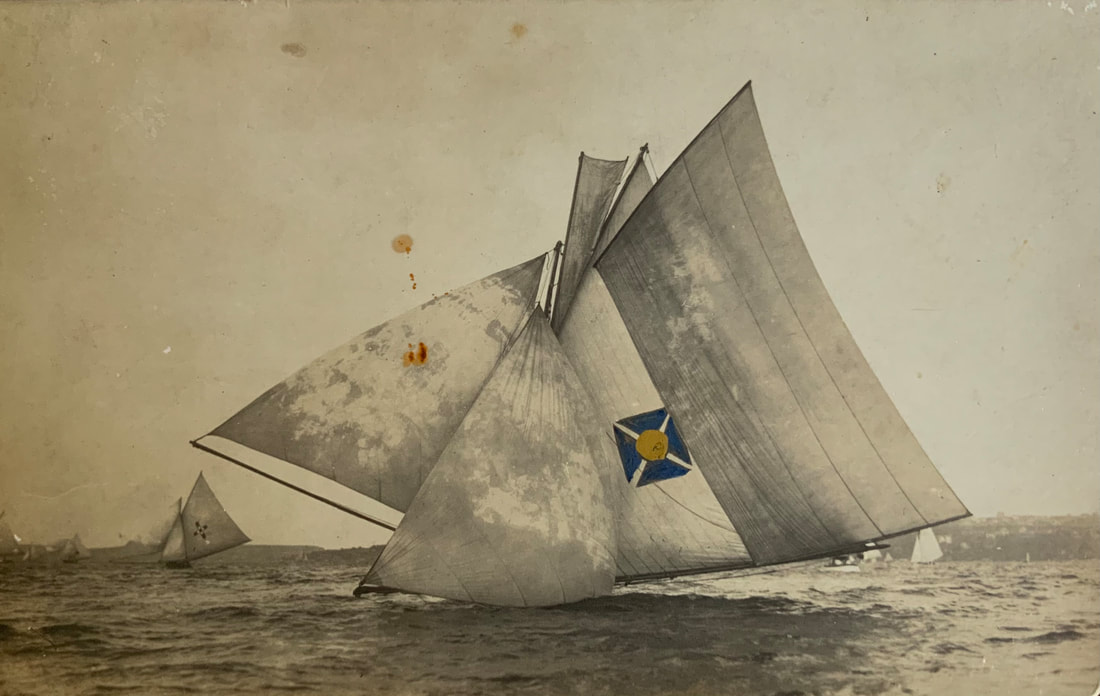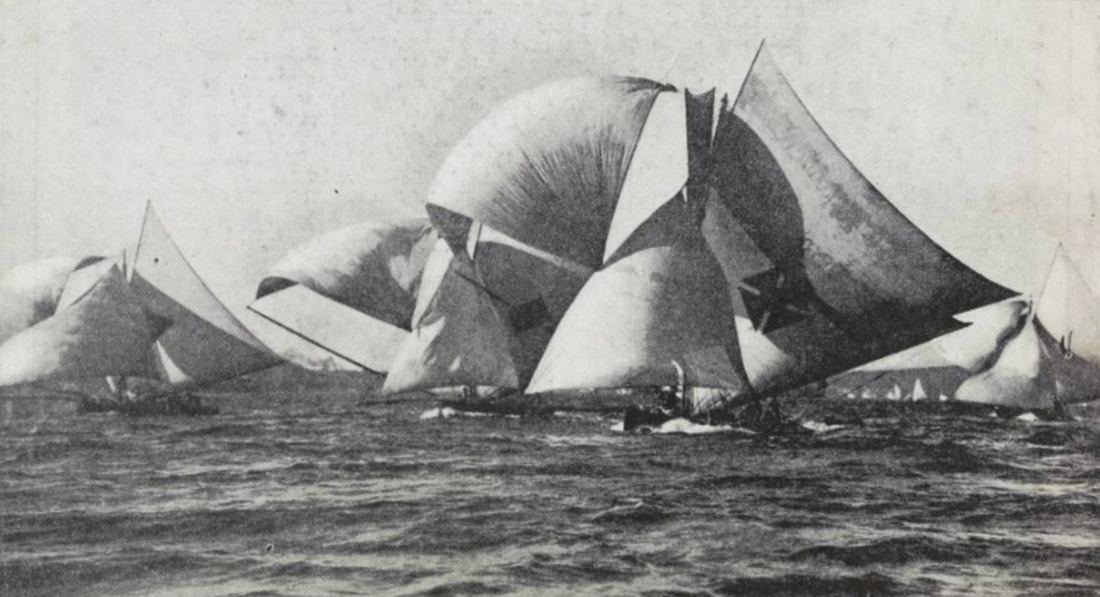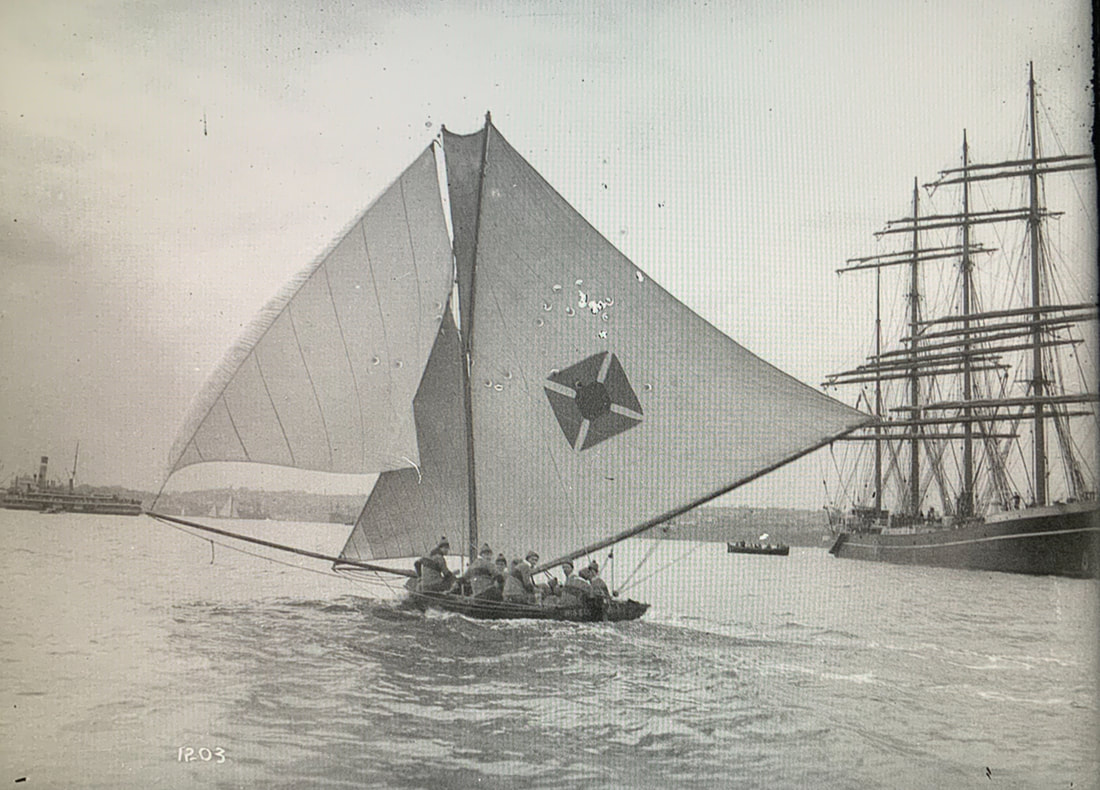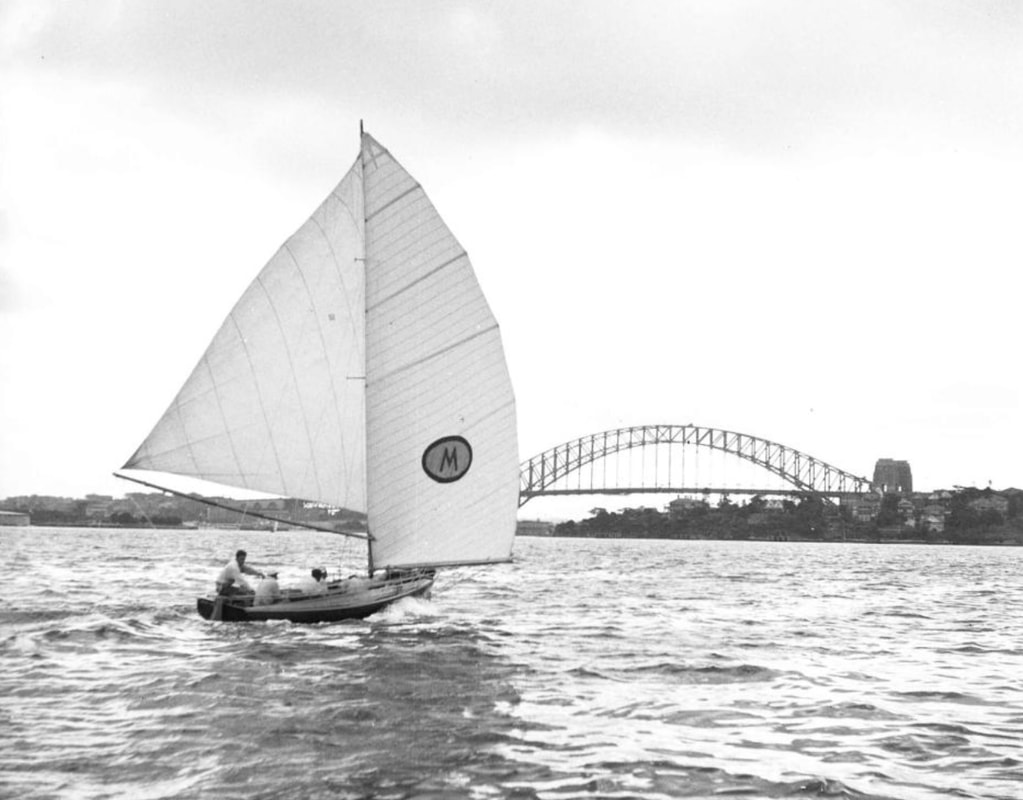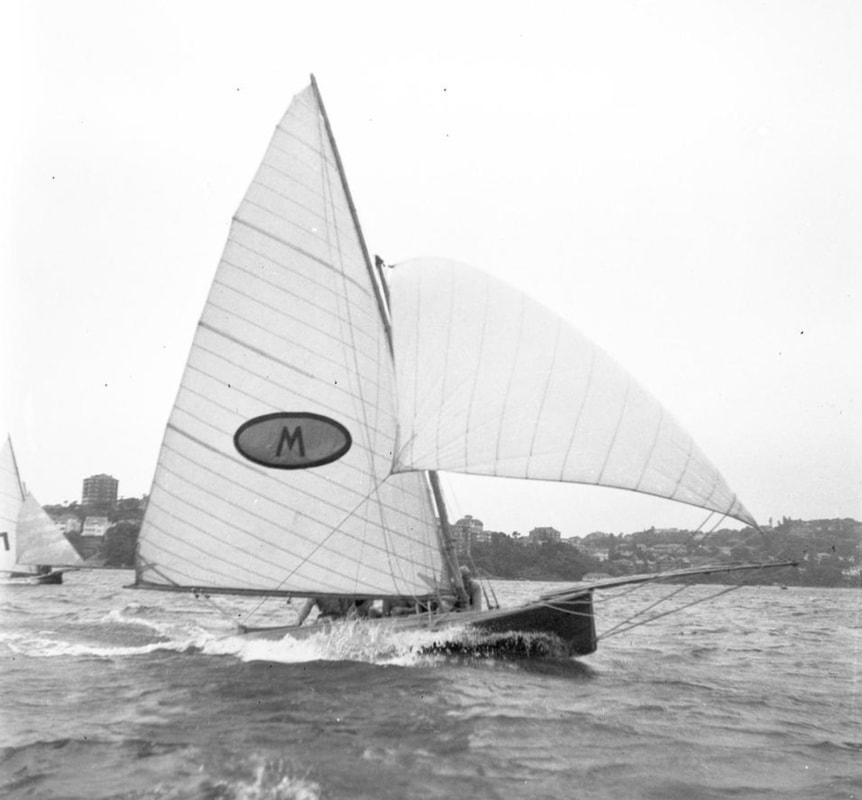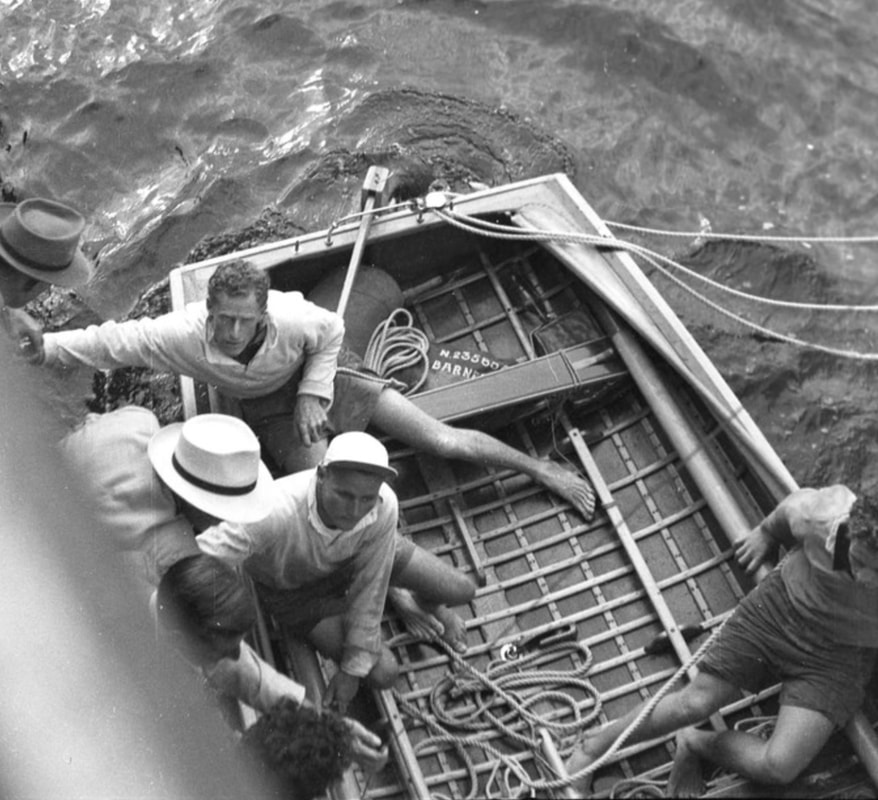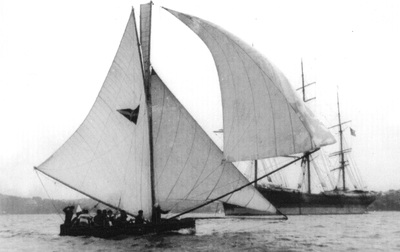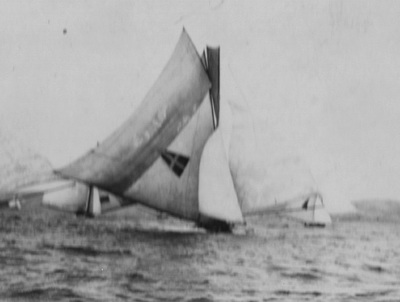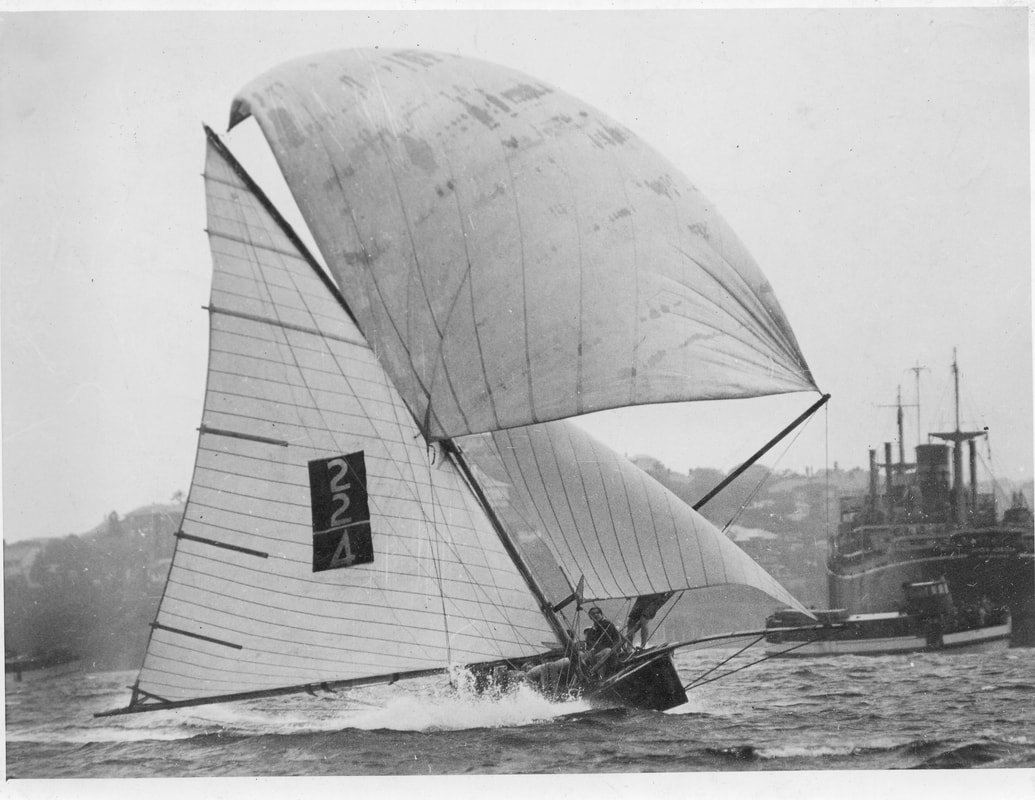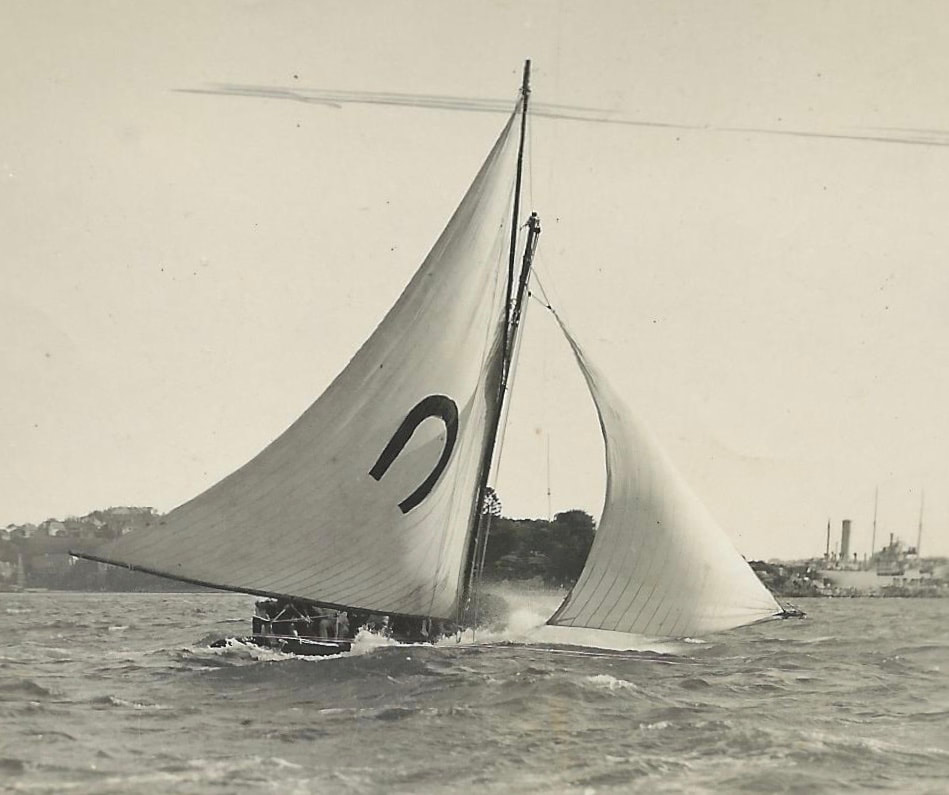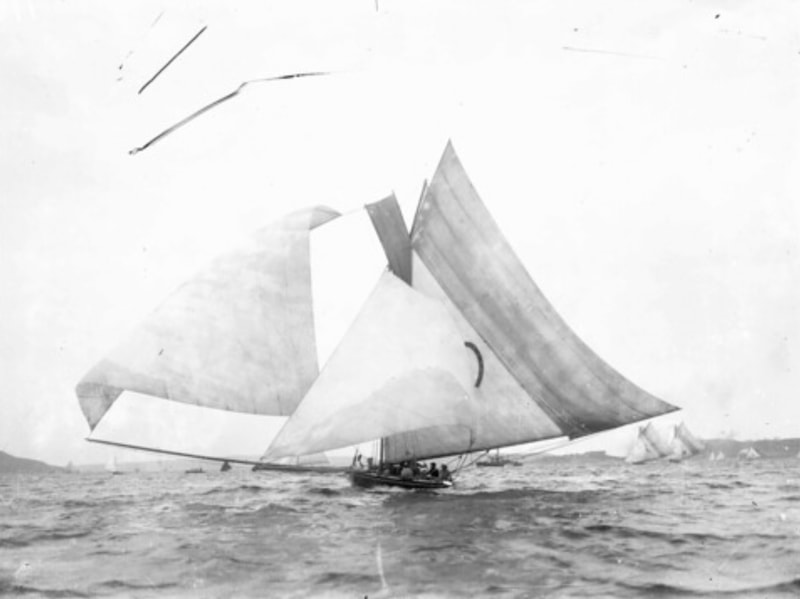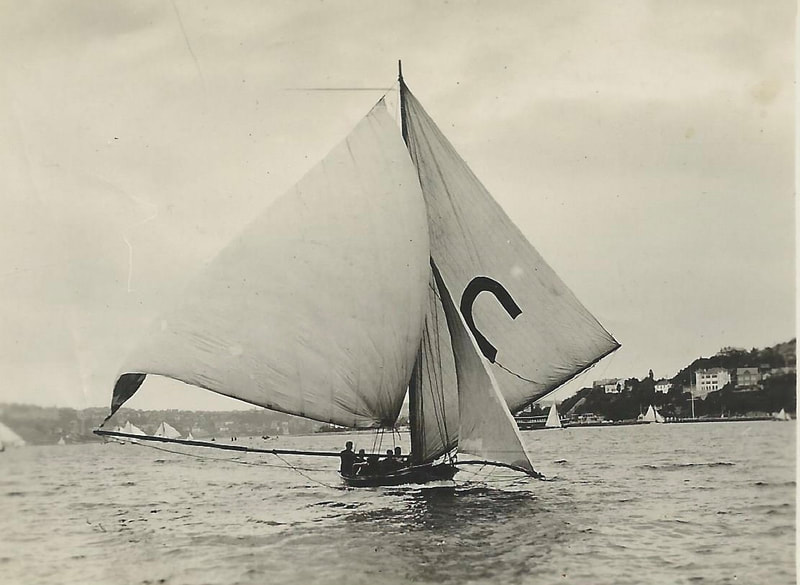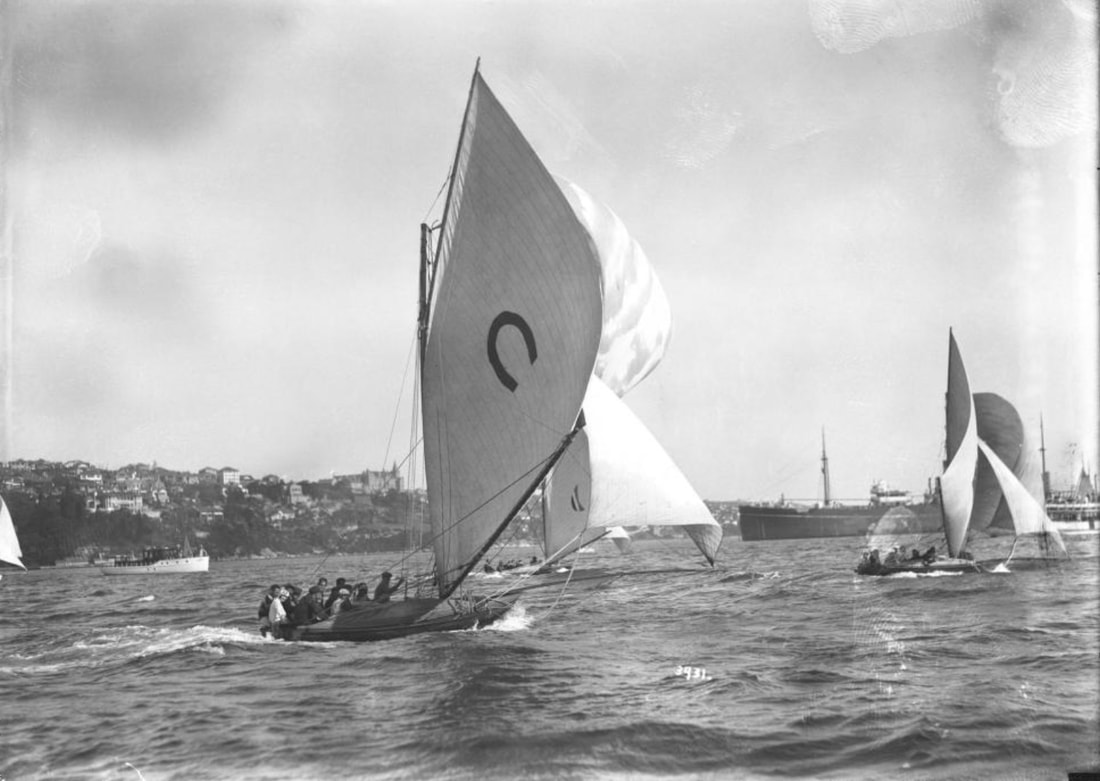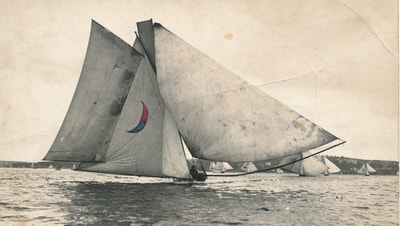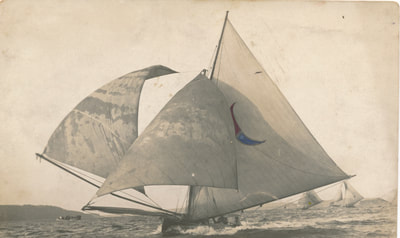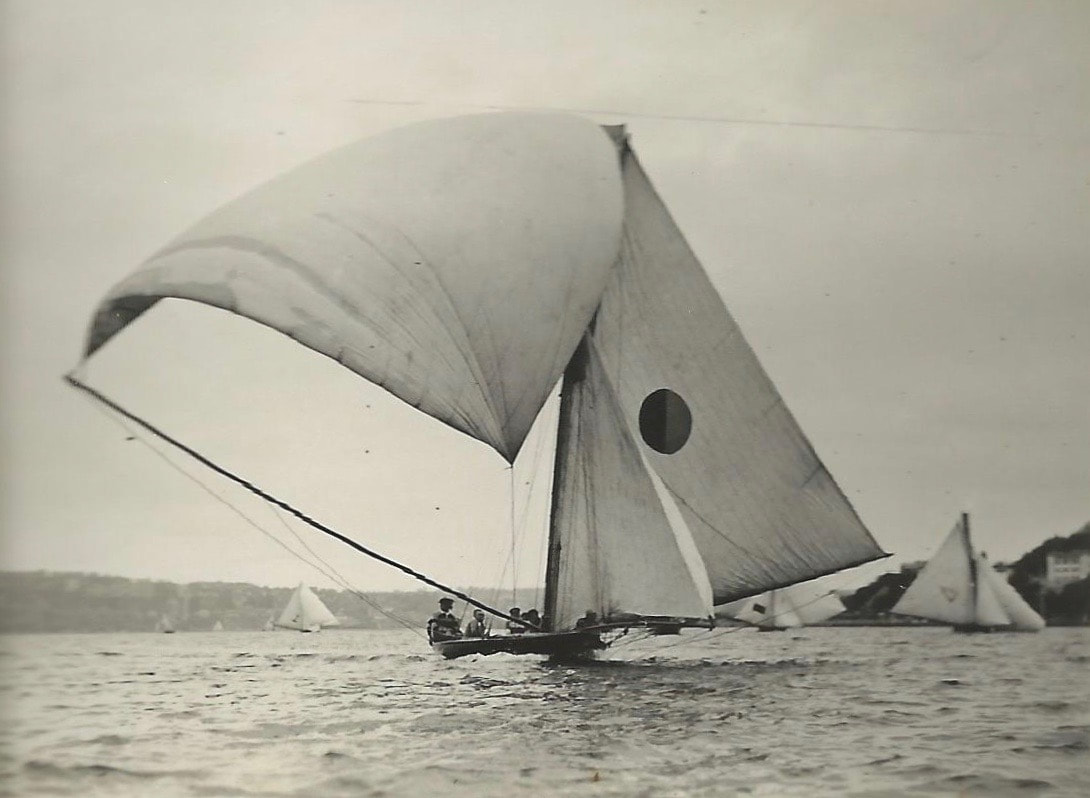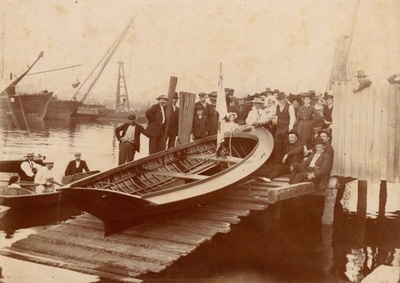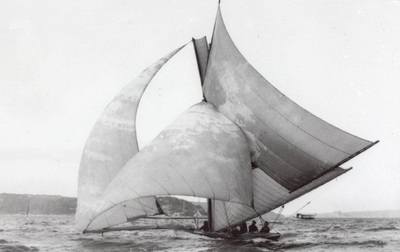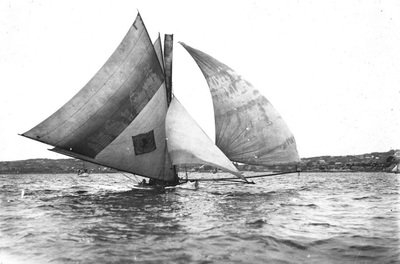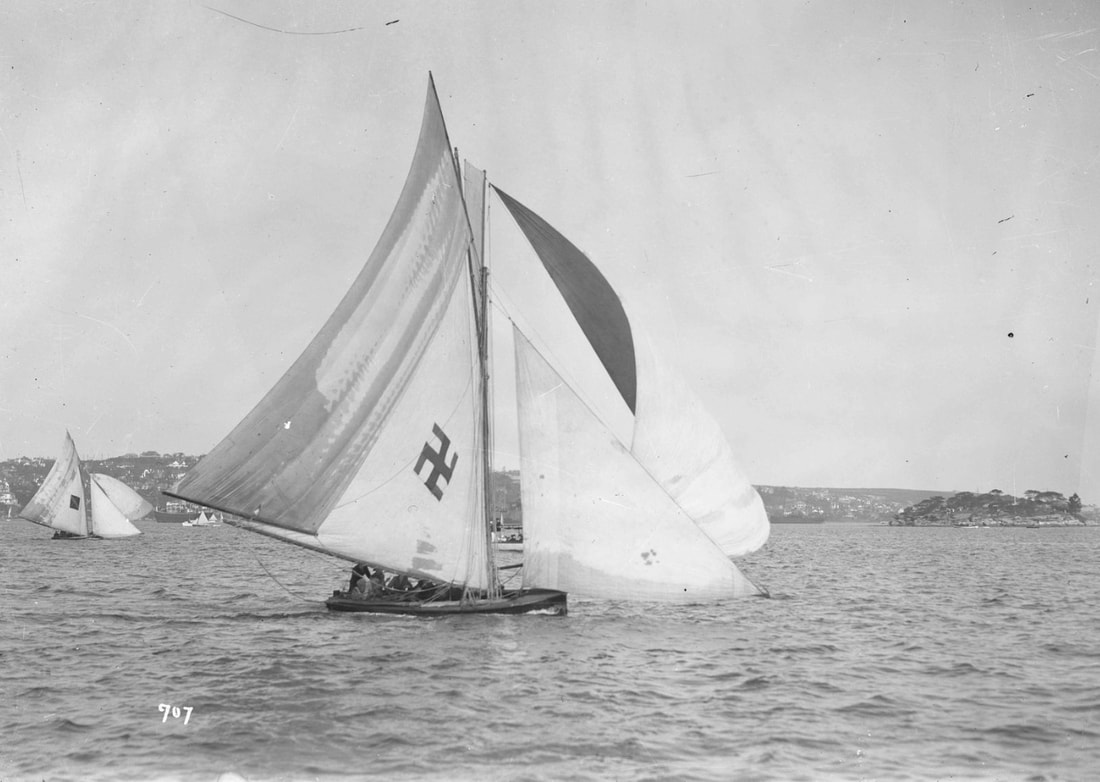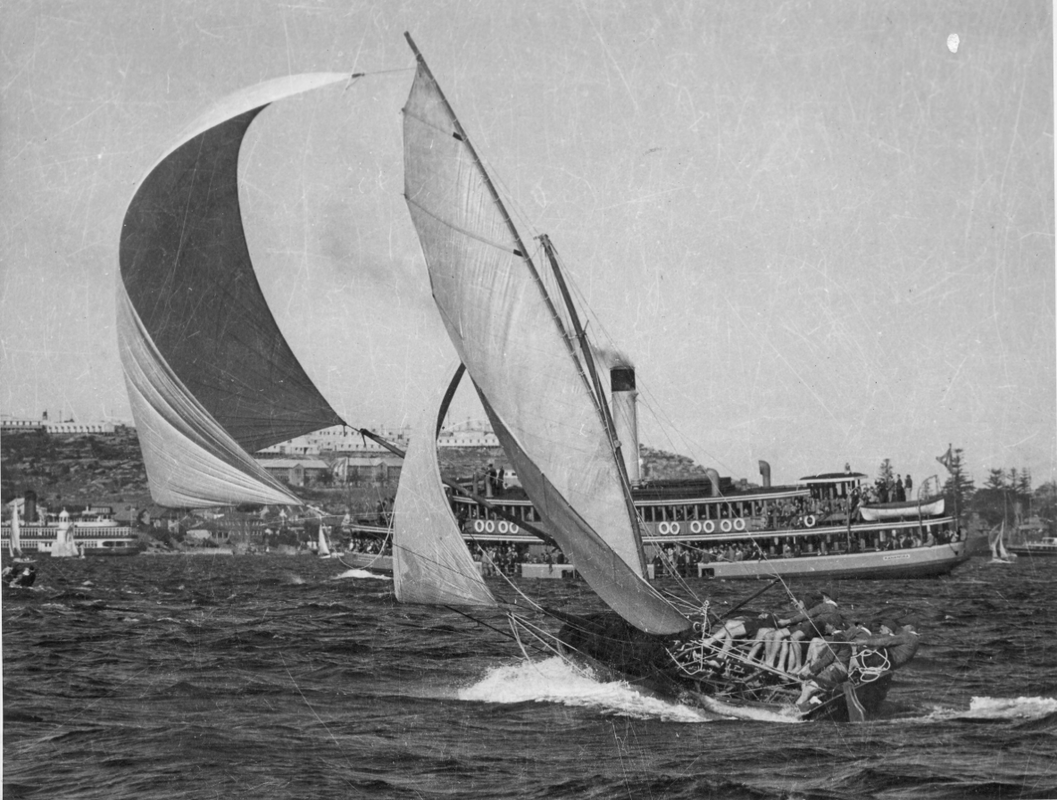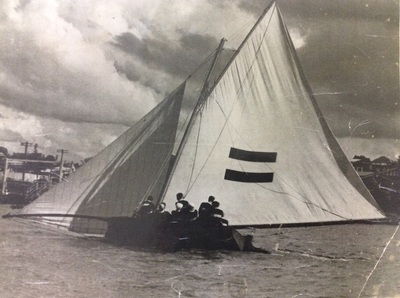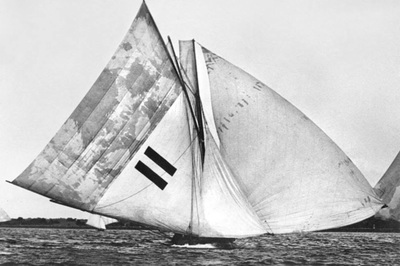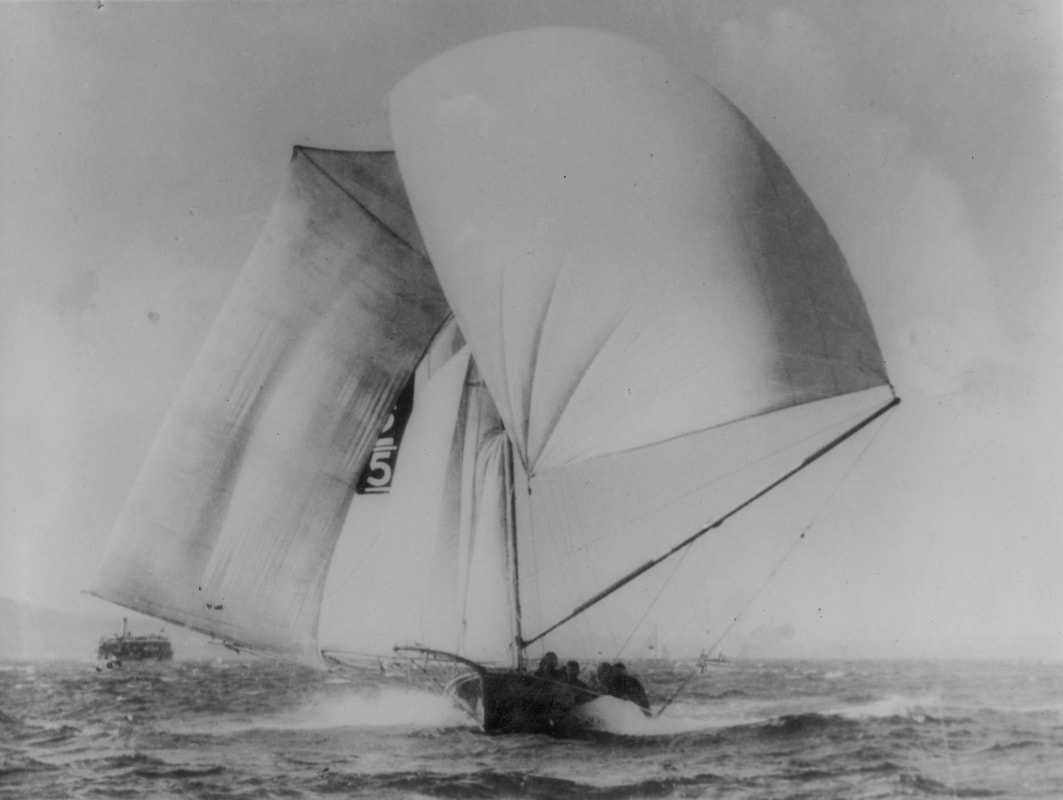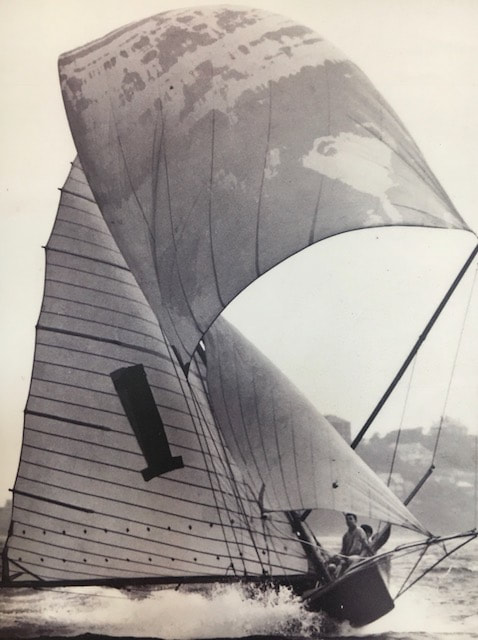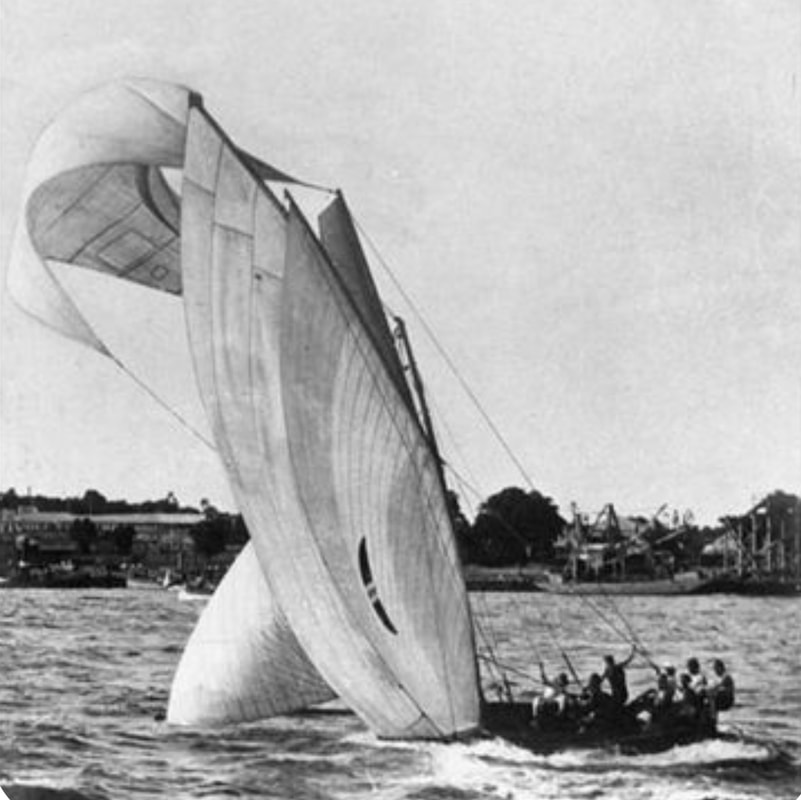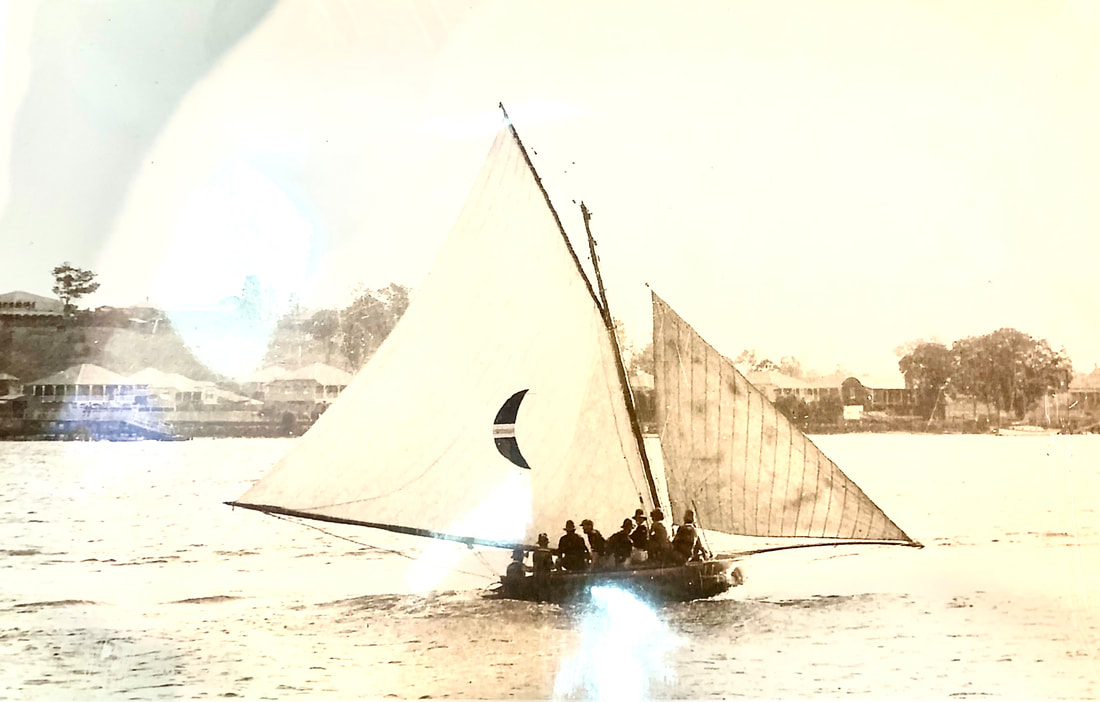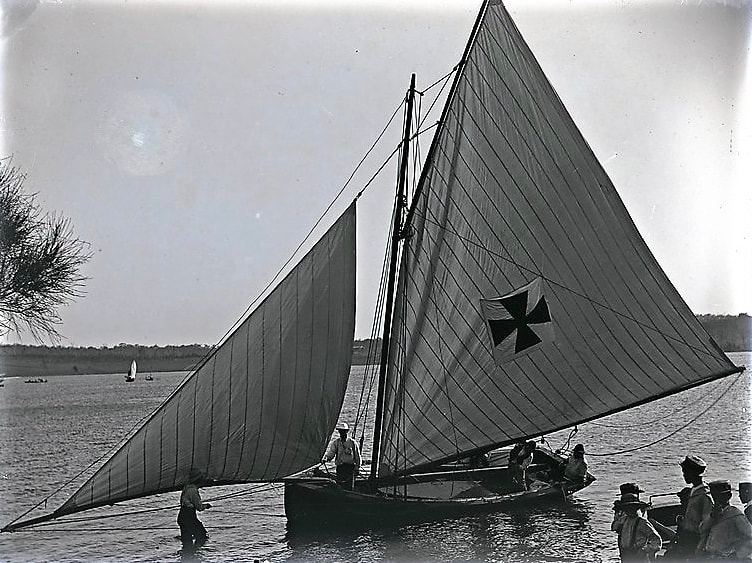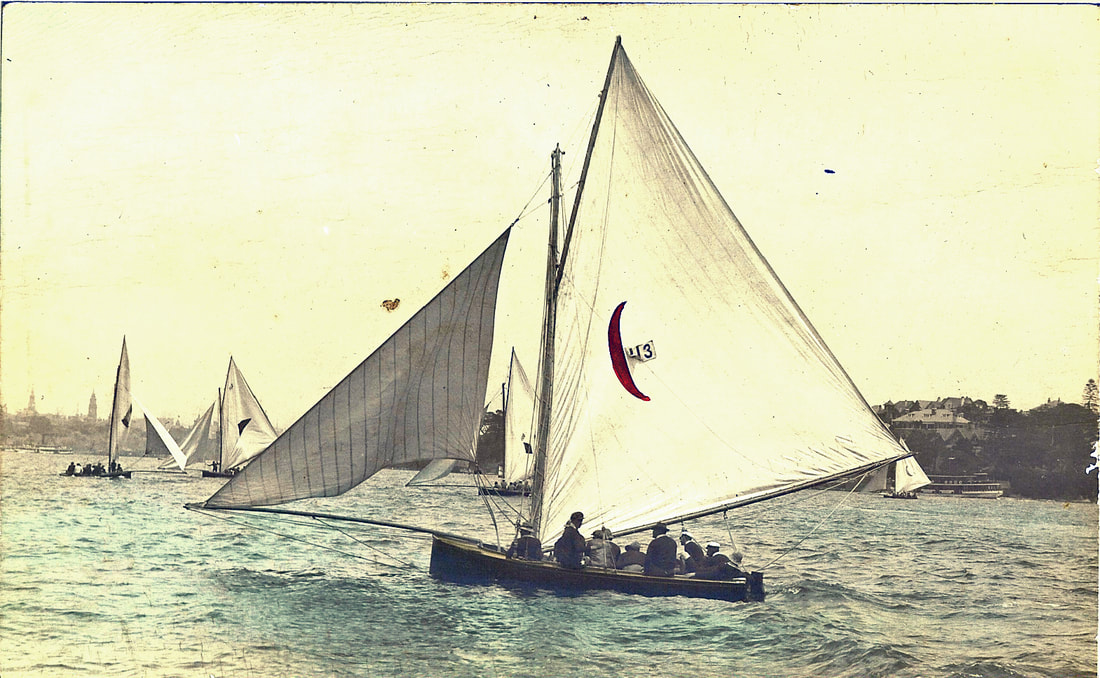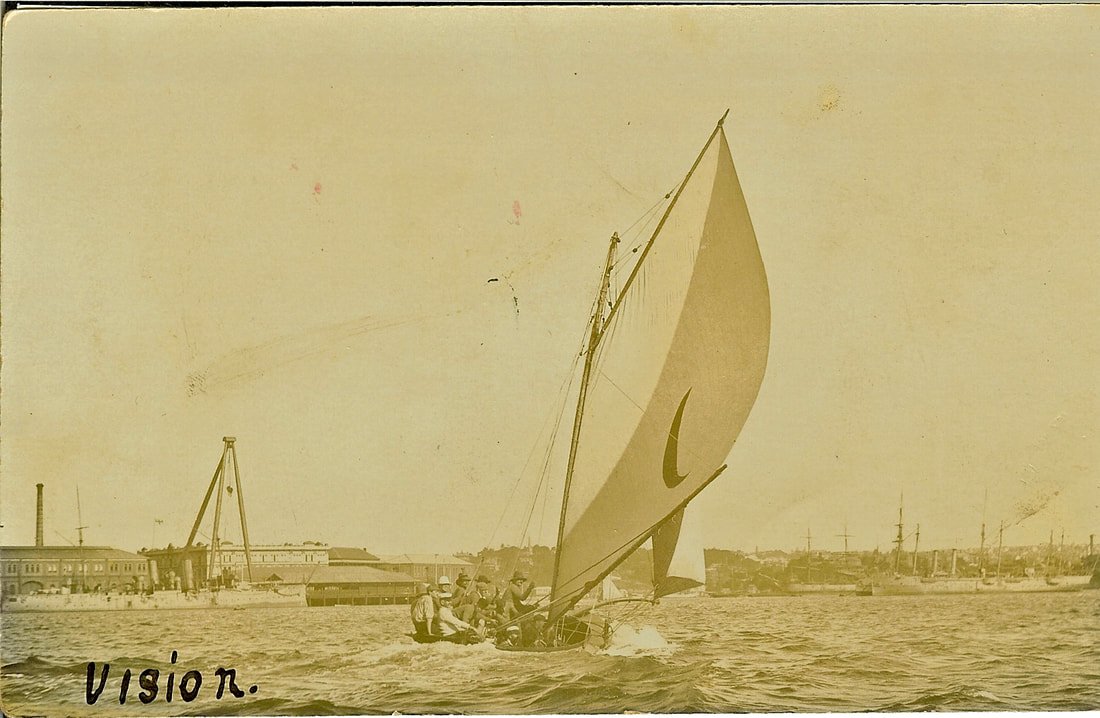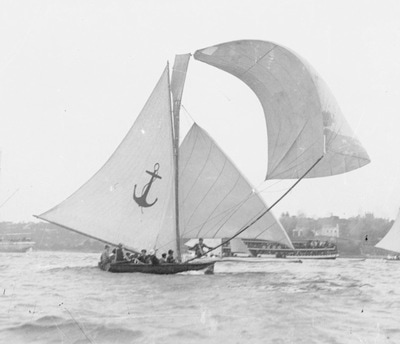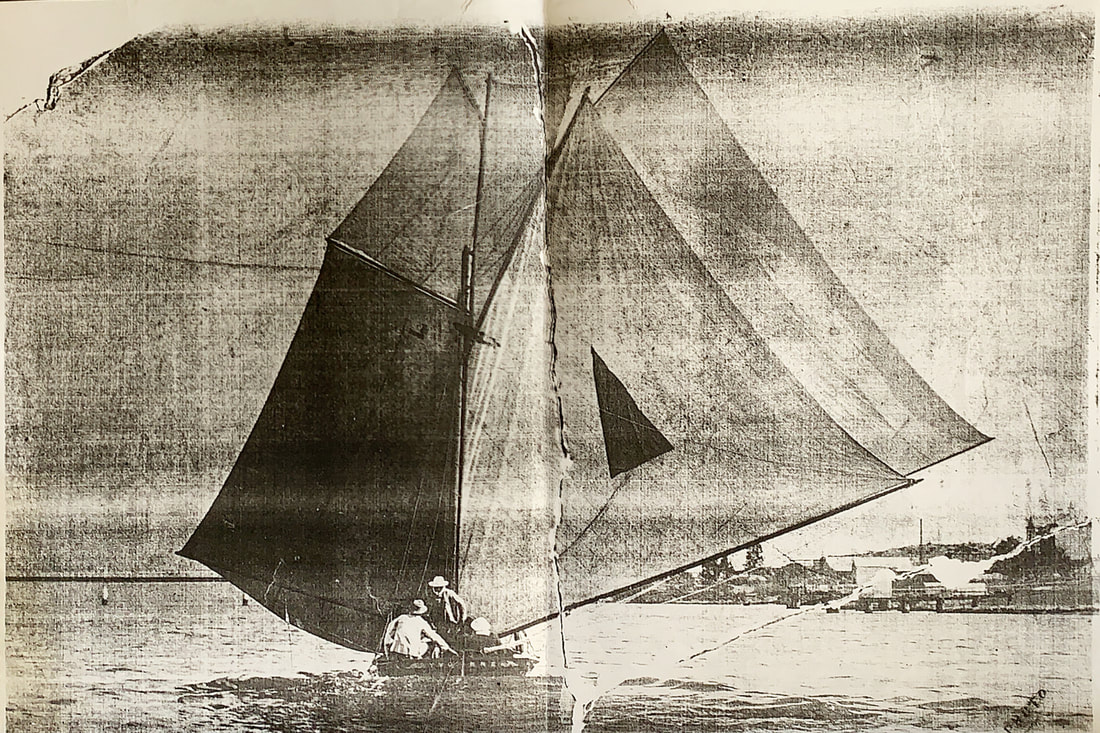The eighteen footers emerged as a class in the early 1890's, as smaller versions of the then-dominant 24 and 22 footers. They mostly competed in mixed fleets through the 1890's, with some races just for eighteen footers in the second half of the 90's. But the writing was on the wall, more of them were being built than any other class, the gun skippers were attracted to them and the crowds began to follow them. By 1902 they were the dominant class. Fleets of either side of 30 boats raced every week until the early 1930's, after which two separate fleets each with about 20 boats raced until after the Second World War. Over 300 batten seam eighteens were built up to 1950, so there is plenty of room to grow the list below. In the early 1950's 18-footers started to evolve rapidly with moulded hulls, trapezes and Bermudan rigs, and continue to race today, but this is outside the scope of this website.
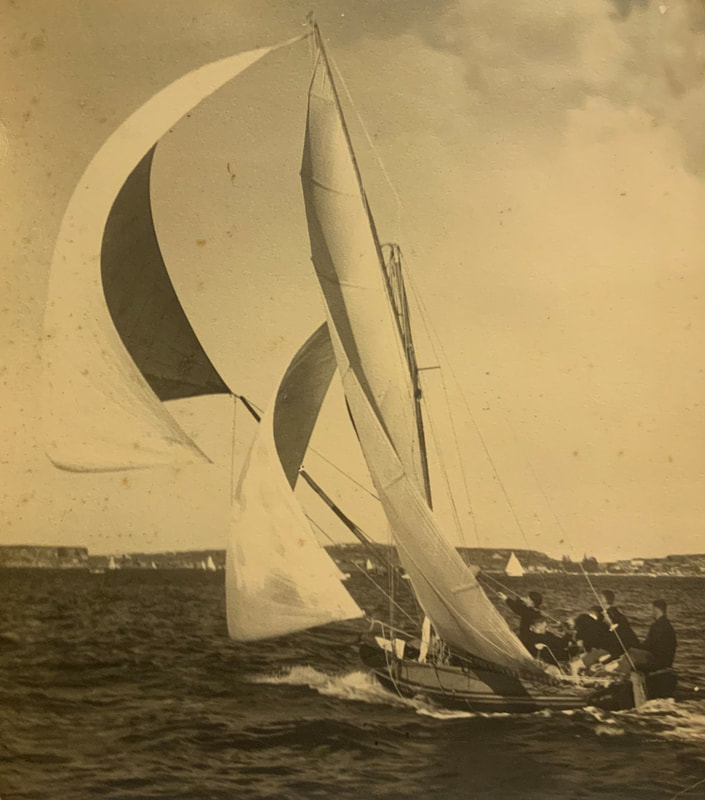
An unidentified 18-footer runs towards the Sow and Pigs Reef in a Southerly or SE breeze, 1930's or '40's. No sail logo is visible, and the name on the tuck is illegible at this resolution, but it's a great shot of an 18-footer's rig. Photo is from a print of indeterminate origin in the collection of the Australian Historical Sailing Skiff Association.
Aberdare 1932
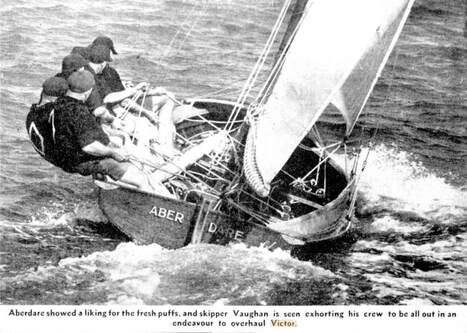
Builder: A.J."Toby" Whereat*, a leading Brisbane boatbuilder and 16' skiff champion, for Fred Hart.
Known dimensions: 18' x 7' beam.
Sail insignia: Black diamond (Aberdare was named after a coal mine).
Aberdare was a very significant boat in the history of 18 footer sailing, being the culmination of several decades of argument and experiment regarding narrower skiff-type hulls and smaller rigs, illustrated beautifully in the photograph of Aberdare alongside Tangalooma* which contrasts the rigs. Aberdare was a winner from its first season, completely dominating the 1932-33 season in Brisbane. She could only manage third in the Australian title in Sydney that season against Arawatta and Tangalooma, both big-beam boats and the big-beam supporters breathed a sigh of relief, but it was a light weather series and Aberdare had nothing bigger than a second suit of sails. She won the title in Brisbane in 1933-34, and in Sydney again in 1934-35, Brisbane again in 1935-36, and Sydney in 1936-37 but was beaten into third in Brisbane in 1937-38 by Malvina, one of many boats built on similar lines. In 1935 the dispute between supporters of the big-beamers versus the skiff-types had led to the formation of the Australian 18 Footers League which split off from the Sydney Flying Squadron, a split that remains to this day. The whole story is thoroughly detailed in Robin Elliott's book Galloping Ghosts, available from Boat Books. Aberdare raced in Brisbane up until the 1939-40 season and was bought by W.J.Anderson for the Sydney SFS season of 1942-43. After Wee Georgie Robinson* retired Britannia* in 1944 he steered Aberdare for two and a bit seasons and was the scratch boat at the SFS. In January 1947 she went to Brisbane but was resoundingly defeated by the new Queensland 6 foot beamers. Vic Robinson sailed her for two last seasons at the SFS in 1950-51 and 1951-52.
In 2000 Robert Tearne, the driving force behind the foundation of the Australian Historical Sailing Skiff Association built a replica of the Aberdare which still sails with the SFS replica fleet.
There are a couple of crew photos in the People page on the menu.
Known dimensions: 18' x 7' beam.
Sail insignia: Black diamond (Aberdare was named after a coal mine).
Aberdare was a very significant boat in the history of 18 footer sailing, being the culmination of several decades of argument and experiment regarding narrower skiff-type hulls and smaller rigs, illustrated beautifully in the photograph of Aberdare alongside Tangalooma* which contrasts the rigs. Aberdare was a winner from its first season, completely dominating the 1932-33 season in Brisbane. She could only manage third in the Australian title in Sydney that season against Arawatta and Tangalooma, both big-beam boats and the big-beam supporters breathed a sigh of relief, but it was a light weather series and Aberdare had nothing bigger than a second suit of sails. She won the title in Brisbane in 1933-34, and in Sydney again in 1934-35, Brisbane again in 1935-36, and Sydney in 1936-37 but was beaten into third in Brisbane in 1937-38 by Malvina, one of many boats built on similar lines. In 1935 the dispute between supporters of the big-beamers versus the skiff-types had led to the formation of the Australian 18 Footers League which split off from the Sydney Flying Squadron, a split that remains to this day. The whole story is thoroughly detailed in Robin Elliott's book Galloping Ghosts, available from Boat Books. Aberdare raced in Brisbane up until the 1939-40 season and was bought by W.J.Anderson for the Sydney SFS season of 1942-43. After Wee Georgie Robinson* retired Britannia* in 1944 he steered Aberdare for two and a bit seasons and was the scratch boat at the SFS. In January 1947 she went to Brisbane but was resoundingly defeated by the new Queensland 6 foot beamers. Vic Robinson sailed her for two last seasons at the SFS in 1950-51 and 1951-52.
In 2000 Robert Tearne, the driving force behind the foundation of the Australian Historical Sailing Skiff Association built a replica of the Aberdare which still sails with the SFS replica fleet.
There are a couple of crew photos in the People page on the menu.
Advance 1909
Builder: Sam Williams*, Pyrmont for owner-skipper Harry Thompson.
Sail insignia: Modified Australian Coat of Arms until sold in Feb 1922, after which she displayed blue and gold horizontal bars.
Harry Thompson sailed Advance with reasonable success from the 1909-10 season until February 1922 when he sold her to Arthur Rodrick for 80 pounds. Thompson carried his coat of arms sail emblem over to his new Sam Williams boat N.S.W which he then sailed until the middle second World War years. Advance sailed competitively under several owners and several skippers including George Degan and Frank Deady until the 1935-36 season.
Sail insignia: Modified Australian Coat of Arms until sold in Feb 1922, after which she displayed blue and gold horizontal bars.
Harry Thompson sailed Advance with reasonable success from the 1909-10 season until February 1922 when he sold her to Arthur Rodrick for 80 pounds. Thompson carried his coat of arms sail emblem over to his new Sam Williams boat N.S.W which he then sailed until the middle second World War years. Advance sailed competitively under several owners and several skippers including George Degan and Frank Deady until the 1935-36 season.
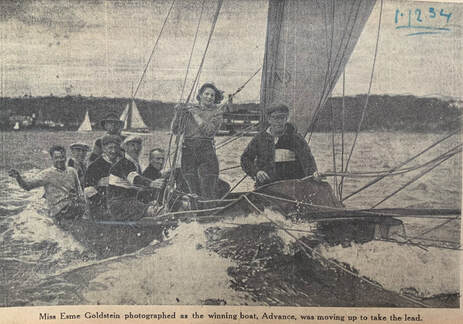
This photo from a scrapbook in the archives of the Australian Historical Sailing Skiff Association shows Miss Esme Goldstein who became "Queen of the Harbour" on i December 1934, towards the end of Advance's career. In this annual event, act 18-footer had to carry a woman who had raised money for charity, and the woman in the winning boat in this handicap race was declared "Queen of the Harbour". It was about the only chance a woman had of getting on an 18-footer in the first half of the 20th Century, women in the crew were extremely rare. A position on a boat was a sought-after role, large sums of money were raised, and the "Queen" received a valuable prize, which for several years was a Ford motor car! The Sydney Flying Squadron still keeps this antiquated tradition going with the replica fleet, but the difference is that most of the fleet today have several women as permanent crew.
Alert 1903
Builder: Harry Langford
Known Dimensions: Beam 8’2” inside planking, &’ at mast thwart, depth 2’5”. Spring 4” frd, 3” aft. Deck had rise inboard of 3 1/2” with 1” high coamings, dispensed with lee cloths. Planked in Kauri, described as having a “good rise of floor”.
Insignia: Red Triangle. In the above photo the triangle has been sewn over an older crescent.
Known Dimensions: Beam 8’2” inside planking, &’ at mast thwart, depth 2’5”. Spring 4” frd, 3” aft. Deck had rise inboard of 3 1/2” with 1” high coamings, dispensed with lee cloths. Planked in Kauri, described as having a “good rise of floor”.
Insignia: Red Triangle. In the above photo the triangle has been sewn over an older crescent.
Harry Langford built the boat and sailed it mostly himself. They won a few handicap races, but their best performance was 3rd place in the Sydney Sailing Club Championship in January 1903 when a brand-new boat. In 1907 ALERT was sold to Eddie Brown who renamed her BEN-MY-CHREE with the insignia of the Three Legs of Man. The boat sailed with limited success, and reverted to the name ALERT in 1910. She sailed for a few seasons after with limited success, and was sold to the islands in 1925.
Above: Two photos of ALERT when she was renamed BEN-MY-CHREE. Both from postcards in the Graeme Ferguson Collection, AHSSA.
Arakoon 1929
Builder: Bob Barber (sometimes written up as Barbour) for himself.
Insignia: Black pennant, gold cross.
Bob Barber was a serial builder of 18-footers which he sailed himself, over a long period. He built 7 boats between 1913 and 1941 (see The Boatbuilders page). Neither Bob nor the boats were champions, but he was a frequent prizewinner of handicap races. Arakoon was named after the town on the Macleay River (N.Coast NSW) and was reported to have been built up there. Arakoon had an inauspicious start in her first race on 5 October 1929 colliding with HC Press II* off Steel Point in the process of which she broke her bumpkin and the mast came down, and several of HC Press's crew were injured (but stayed on board and completed the race). Bob repaired the bumpkin and the boat came second in the following week's race. Bob sailed her for three seasons and sold her in July 1932, and appeared the next season with his new boat Waratah. The photo must have been taken on the annual Queen of the Harbour day as women were rarely seen on 18-footers at any other time during this period.
Insignia: Black pennant, gold cross.
Bob Barber was a serial builder of 18-footers which he sailed himself, over a long period. He built 7 boats between 1913 and 1941 (see The Boatbuilders page). Neither Bob nor the boats were champions, but he was a frequent prizewinner of handicap races. Arakoon was named after the town on the Macleay River (N.Coast NSW) and was reported to have been built up there. Arakoon had an inauspicious start in her first race on 5 October 1929 colliding with HC Press II* off Steel Point in the process of which she broke her bumpkin and the mast came down, and several of HC Press's crew were injured (but stayed on board and completed the race). Bob repaired the bumpkin and the boat came second in the following week's race. Bob sailed her for three seasons and sold her in July 1932, and appeared the next season with his new boat Waratah. The photo must have been taken on the annual Queen of the Harbour day as women were rarely seen on 18-footers at any other time during this period.
Arawatta 1927
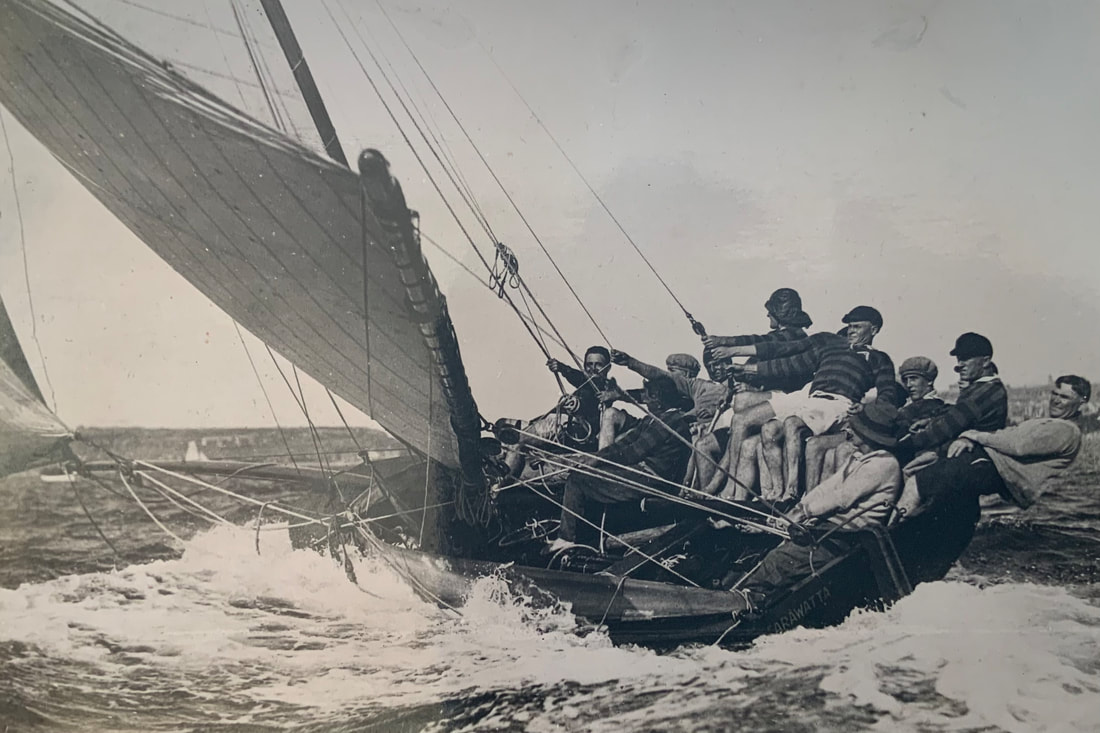
Builder: Charlie Hayes* for J.J.Watt.
Known measurements:Length 17'11 3/4", beam 7'7", depth 2'5". Another of Hayes' snub designs (flat stem),she was described as "more powerful than Yendys", and was kept in a shed next to Kurrawa Wharf (Neutral Bay).
Sail insignia: When launched and for the first few seasons she carried a blue circle, but changed before 1934 to a red and blue pennant.
Arawatta's first race was on 24 September 1927 where she was unplaced, steered by Ossie Hahn*. The builder Charlie Hayes was given the tiller after that and had his first win on 17 December that year. He remained the regular helmsman for the rest of her career. She won the Port Jackson Championship in 1929 and was mostly near scratch in handicap races in the early years.
In January 1930 she was given a hollow 40' (also recorded as 46'6" and 48'!) Bermudan mast and main with the sails made in Tasmania. She was sent to Brisbane for the Australian Championship but capsized in the race, as well as capsizing several other times in the next season.
Owner James Watt alternated with Charlie Hayes on the tiller for much of that 1930-31 season, but Hayes was steering when she won the Australian Championship in January 1931. Legendary footballer and sailer Chook Fraser became frd hand about this time. He is in the first photo with the beanie, looking up. The last photo is obviously taken on queen of the Harbour day, about the only time women were generally on board.
In the next season's Australian Championship in Brisbane Arawatta broke her mast, which was variously described as 48' and 52'6" tall- but I would suggest that the previously noted 40-46'6"was more likely.
Arawatta won the 1932-33 Australian Championship in Sydney still with the Bermudan rig, but regular capsizes and mast problems led them to go back to the gaff rig in February 1933. In the 1934-35 season James Watt, Charlie Hayes and Arawatta became foundation members of the League when the split from SFS happened. Watt decided she was not going to be competitive against the newer narrow skiffs and had Hayes built him a skiff-type he called Minawatta. Watt sold Arawatta to G.Sands in 1937 and she raced with the SFS under the name of Cutty Sark II.
Below: ARAWATTA under her towering Bermudan rig, around 1931-32, shortly after the insignia changed from the previous blue circle. Hall Collection, ANMM.
Known measurements:Length 17'11 3/4", beam 7'7", depth 2'5". Another of Hayes' snub designs (flat stem),she was described as "more powerful than Yendys", and was kept in a shed next to Kurrawa Wharf (Neutral Bay).
Sail insignia: When launched and for the first few seasons she carried a blue circle, but changed before 1934 to a red and blue pennant.
Arawatta's first race was on 24 September 1927 where she was unplaced, steered by Ossie Hahn*. The builder Charlie Hayes was given the tiller after that and had his first win on 17 December that year. He remained the regular helmsman for the rest of her career. She won the Port Jackson Championship in 1929 and was mostly near scratch in handicap races in the early years.
In January 1930 she was given a hollow 40' (also recorded as 46'6" and 48'!) Bermudan mast and main with the sails made in Tasmania. She was sent to Brisbane for the Australian Championship but capsized in the race, as well as capsizing several other times in the next season.
Owner James Watt alternated with Charlie Hayes on the tiller for much of that 1930-31 season, but Hayes was steering when she won the Australian Championship in January 1931. Legendary footballer and sailer Chook Fraser became frd hand about this time. He is in the first photo with the beanie, looking up. The last photo is obviously taken on queen of the Harbour day, about the only time women were generally on board.
In the next season's Australian Championship in Brisbane Arawatta broke her mast, which was variously described as 48' and 52'6" tall- but I would suggest that the previously noted 40-46'6"was more likely.
Arawatta won the 1932-33 Australian Championship in Sydney still with the Bermudan rig, but regular capsizes and mast problems led them to go back to the gaff rig in February 1933. In the 1934-35 season James Watt, Charlie Hayes and Arawatta became foundation members of the League when the split from SFS happened. Watt decided she was not going to be competitive against the newer narrow skiffs and had Hayes built him a skiff-type he called Minawatta. Watt sold Arawatta to G.Sands in 1937 and she raced with the SFS under the name of Cutty Sark II.
Below: ARAWATTA under her towering Bermudan rig, around 1931-32, shortly after the insignia changed from the previous blue circle. Hall Collection, ANMM.
Argo 1932
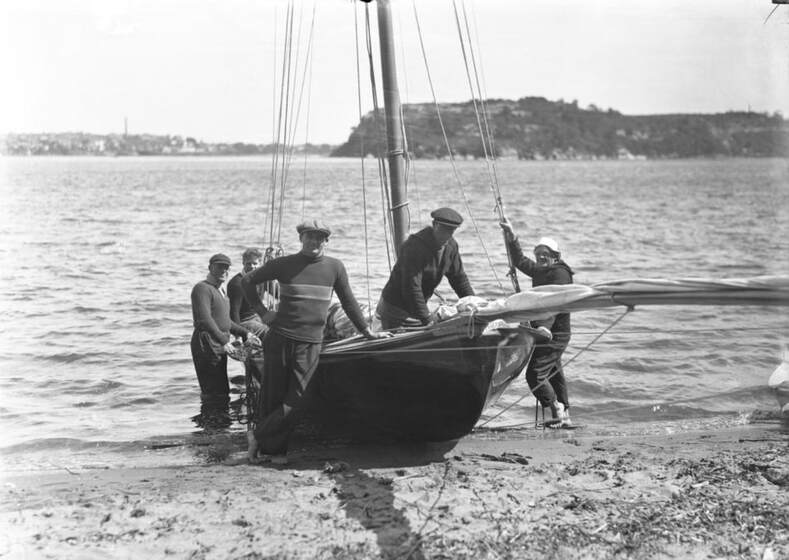
Built in 1925 as HC Press III* by George Press* to replace the champion boat HC Press II, the boat didn't live up to expectations and skipper Chris Webb* went back to sailing the older boat. It languished in the shed for years, until a North Sydney syndicate purchased it it July 1932, renamed it Argo, re-rigged it and selected a young Sid Barnett Jnr to be the skipper, with his uncle Prince Barnett as frd hand.
Known dimensions: 7' beam, 2'6" depth. The boat was a snub, with a small transom at the bow like Yendys* built the same year by Charlie Hayes*.
Sail Insignia: Blue shield with white cross.
Mast 28', Main 28' on boom, 20' hoist, 18' on the gaff. Bumpkin 20', poles 40', ringtail 17'. Sails by Harry West.
Sid Barnett was a graduate from the 12-footers, having recently won the Australian Title in Ajax, and he was supported by a top crew. Most new boats at the time started on scratch for their first race, but Argo was not allowed to start in the first race of the 1932-33 season because they had no sail insignia. They fixed this for the following week, and finished mid-field in a light Easterly. They began to land a few places over the next few months but drifted out to a handicap of 1 1/2 minutes. But then on 14 January 1933 they won the State Championship, a scratch race, beating Chris Webb in HC Press II. They backed it up with a win in the Bradleys Head Championship a month later, and and finished the season with those two Championship wins and 11 other places, winning a total of 75 pounds, topping the list of prize money winners.
Sid and crew sailed again the next season 1933-34, but could not recapture the glory of the first season. The various Championships that season were won by the new HC Press IV,* Tangalooma* and Yendys*. Argo drifted out to 2 1/2 minutes in handicap, and had no wins but gained enough minor places to gather 32 Pounds, about mid-field.
In June 1934 Argo was purchased by Paddy Griffith who renamed her Shamrock.
Sid steered Cutty Sark for part of the 1934-35 season with his father as frd hand. In January 1935 the new 18-footer Sailing League split from the Sydney Flying Squadron. Sid joined the League and steered the old Scot for as number of races that season. Sid was tipped to steer a new boat Lois in the 1935-36 season but died of pneumonia before the season started, leaving a young family. His son Don Barnett and grandson Phil followed in Sid's footsteps and had stellar careers in 18-footers.
Known dimensions: 7' beam, 2'6" depth. The boat was a snub, with a small transom at the bow like Yendys* built the same year by Charlie Hayes*.
Sail Insignia: Blue shield with white cross.
Mast 28', Main 28' on boom, 20' hoist, 18' on the gaff. Bumpkin 20', poles 40', ringtail 17'. Sails by Harry West.
Sid Barnett was a graduate from the 12-footers, having recently won the Australian Title in Ajax, and he was supported by a top crew. Most new boats at the time started on scratch for their first race, but Argo was not allowed to start in the first race of the 1932-33 season because they had no sail insignia. They fixed this for the following week, and finished mid-field in a light Easterly. They began to land a few places over the next few months but drifted out to a handicap of 1 1/2 minutes. But then on 14 January 1933 they won the State Championship, a scratch race, beating Chris Webb in HC Press II. They backed it up with a win in the Bradleys Head Championship a month later, and and finished the season with those two Championship wins and 11 other places, winning a total of 75 pounds, topping the list of prize money winners.
Sid and crew sailed again the next season 1933-34, but could not recapture the glory of the first season. The various Championships that season were won by the new HC Press IV,* Tangalooma* and Yendys*. Argo drifted out to 2 1/2 minutes in handicap, and had no wins but gained enough minor places to gather 32 Pounds, about mid-field.
In June 1934 Argo was purchased by Paddy Griffith who renamed her Shamrock.
Sid steered Cutty Sark for part of the 1934-35 season with his father as frd hand. In January 1935 the new 18-footer Sailing League split from the Sydney Flying Squadron. Sid joined the League and steered the old Scot for as number of races that season. Sid was tipped to steer a new boat Lois in the 1935-36 season but died of pneumonia before the season started, leaving a young family. His son Don Barnett and grandson Phil followed in Sid's footsteps and had stellar careers in 18-footers.
The two shots above show Argo on the beach in Berry's Bay next to the SCEGS rowing shed. In the bow-on shot you can just make out the narrow bow tuck. Has to have been taken between late 1932 and early 1934, ANMM Hall Collection.
Arline (I) 1903
No picture yet found of Arline I, but she became Australian (II) in 1905 and there are plenty of pictures of that incarnation.
Builder: Billy Golding*, for George Solomon, Millers Point publican.
Known dimensions: 17'11 3/4", beam 8'2", depth 2'3", tuck 6'6" x 1'10" deep, deck 12" including 4" moulding, spring 5" frd, 6" aft, sheer 6", case 5' long, 7'dagger fin, 1' in case.
Cedar planking, tuck, deck, thwarts; Kauri stringers, Spotted Gum keel, timbers Elm, knees and stem Tea-tree, sternpost Hickory (Blackwood). "Good rise of floor, clean entrance, long run".
Main by Carter was 26'6" on foot, 15'6" on hoist and head.
Insignia: blue and gold crescent, possibly briefly carried Burns Philp flag.
Arline was the biggest prizewinner in the 1903-04 season, after George Ellis* became the regular skipper early in the season. She was the State Champion in February 1905. Ellis resigned late in the season, indignant at being accused of being in the hands of bookies. In September 1905 Watty Ford* bought her off George Solomon and renamed her Australian (II).
Builder: Billy Golding*, for George Solomon, Millers Point publican.
Known dimensions: 17'11 3/4", beam 8'2", depth 2'3", tuck 6'6" x 1'10" deep, deck 12" including 4" moulding, spring 5" frd, 6" aft, sheer 6", case 5' long, 7'dagger fin, 1' in case.
Cedar planking, tuck, deck, thwarts; Kauri stringers, Spotted Gum keel, timbers Elm, knees and stem Tea-tree, sternpost Hickory (Blackwood). "Good rise of floor, clean entrance, long run".
Main by Carter was 26'6" on foot, 15'6" on hoist and head.
Insignia: blue and gold crescent, possibly briefly carried Burns Philp flag.
Arline was the biggest prizewinner in the 1903-04 season, after George Ellis* became the regular skipper early in the season. She was the State Champion in February 1905. Ellis resigned late in the season, indignant at being accused of being in the hands of bookies. In September 1905 Watty Ford* bought her off George Solomon and renamed her Australian (II).
Arline (II) 1910
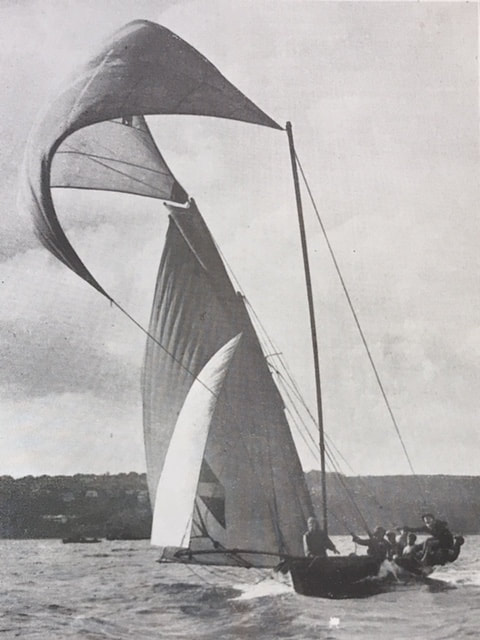
Builder: Billy Golding*. Launched as Eileen* in 1907, George Solomon and his son-in-law Bill Bennett bought her in December 1910 for 70 pounds. She was steered mostly by Bill Edney with moderate success. Bill Fisher* bought her and took over the tiller for the 1917-1921 seasons. Fisher sold her to Wes West*, a former champion 10-footer sailor in February 1921 and Wes steered her for many years afterwards. The boat was still competitive, being on scratch in December 1923 and taking out the SFS Club Championship and the NSW Championship in 1923-24. West was a jeweller with a shop in the Imperial Arcade in the city but it appears that the Depression of the early 1930's ruined his business. It appears that West sold Arline to W. Wark, one of his long-time crew in 1930, but his brother Harry West the sailmaker appears for a few seasons as the skipper after having been Wes's sheet hand for many years. In June 1934 Arline was sold to a Brisbane syndicate led by Colin Clark and sailed there under Roy Pithian, and after September 1936 after a change of ownership under Fred McCartney, until the big-boat group there died out after the 1937-38 season (though she did visit Sydney in the 1935-36 season for an unsuccessful tilt at the Australian Championship, won by Tangalooma). The last reference I can find is that she was advertised for sale in November 1939. More details of Wes West's career and troubles on the PEOPLE page.
No known dimensions at this point.
From 1910 to 1921 Arline's insignia was a blue and gold crescent, after being sold to Wes West the insignia was a red diamond with a blue bar.
No known dimensions at this point.
From 1910 to 1921 Arline's insignia was a blue and gold crescent, after being sold to Wes West the insignia was a red diamond with a blue bar.
A great shot of Arline powering past George's head in a big Southerly. Tom Cuneo collection.
Arline passes the bow of a square-rigger, possibly the Gustav and taken about the same time as the image of Australia in their entry below, in 1926-27. The frd hand can be seen taking a swig from a bottle. Hall Collection ANMM.
Arline gets a tow home after picking up a Championship ribbon from the ferry. One of the crew has just tied it to the masthead. Owners often owned or chartered launches for their supporters for important races. Hall Collection ANMM.
Australia 1921
Builder: Bill Fisher, for himself.
Known dimensions: Beam 8’1”, depth 26”, tuck 6’ x 19”, 8” heel, spring frd 6”, aft 2 1/2”. 6” sheer. Deck 8” wide, 3’6” frd. Keel 6” x 3” Spotted Gum, 1/2” Cedar planking.
Sail insignia: Union Jack.
Bill Fisher was a member of the Fisher boatbuilding dynasty started by his father C.A.M. Fisher, and built Australia for himself (it was actually registered to a syndicate which probably only comprised Bill and his brother Jack). Bill had some success steering Arline for a couple of seasons prior to this. It was one of the last boats built at the shed in Berry’s Bay before they moved the business to La Perouse in 1922. She was launched in September 1921.
Known dimensions: Beam 8’1”, depth 26”, tuck 6’ x 19”, 8” heel, spring frd 6”, aft 2 1/2”. 6” sheer. Deck 8” wide, 3’6” frd. Keel 6” x 3” Spotted Gum, 1/2” Cedar planking.
Sail insignia: Union Jack.
Bill Fisher was a member of the Fisher boatbuilding dynasty started by his father C.A.M. Fisher, and built Australia for himself (it was actually registered to a syndicate which probably only comprised Bill and his brother Jack). Bill had some success steering Arline for a couple of seasons prior to this. It was one of the last boats built at the shed in Berry’s Bay before they moved the business to La Perouse in 1922. She was launched in September 1921.
As all boats did at the time, Australia started her first race on scratch, and though apparently no wins came their way that first season they did well enough in handicap races to stay on scratch for most of the season, just easing out to 1/2 a minute by February, and were 9th on the list of prizewinners for the season. Their best result in a championship race was a 3rd in the SFS Championship in November 1921. Their second season (1922-23) was a different story. Billy Fisher was busy with work and the boat was steered for the first few months by Billy Dunn who gained a number of wins and places in handicap events. Billy Fisher returned to the tiller in December, and continued the success, winning the State Championship in March and topping the list of prizewinners for the season with £69.
According to newspaper reports at the time, several of Australia’s crew were recruited from the local La Perouse indigenous community which suggests Fisher was an inclusive sort of chap, but in today’s terms the language used in those reports shows a level of casual racism from the journalists. They were not the only indigenous 18-footer sailers, quite a few indigenous sailors crewed boats on the North Coast of NSW circuit which was active in the early years of the 20th Century.
Australia won the Sydney Sailing Club Championship the following season but could only get 3rd in the State Championship, but won it back in the 1924-25 season and were 4th on the list of prizewinners. The next four seasons were not as successful, in fact in 1928-29 they got no closer than a 3rd in a handicap, and their handicap drifted out to 5 1/2 minutes, almost a long marker at the time.
According to newspaper reports at the time, several of Australia’s crew were recruited from the local La Perouse indigenous community which suggests Fisher was an inclusive sort of chap, but in today’s terms the language used in those reports shows a level of casual racism from the journalists. They were not the only indigenous 18-footer sailers, quite a few indigenous sailors crewed boats on the North Coast of NSW circuit which was active in the early years of the 20th Century.
Australia won the Sydney Sailing Club Championship the following season but could only get 3rd in the State Championship, but won it back in the 1924-25 season and were 4th on the list of prizewinners. The next four seasons were not as successful, in fact in 1928-29 they got no closer than a 3rd in a handicap, and their handicap drifted out to 5 1/2 minutes, almost a long marker at the time.
The first three images are from John Stanley’s collection.
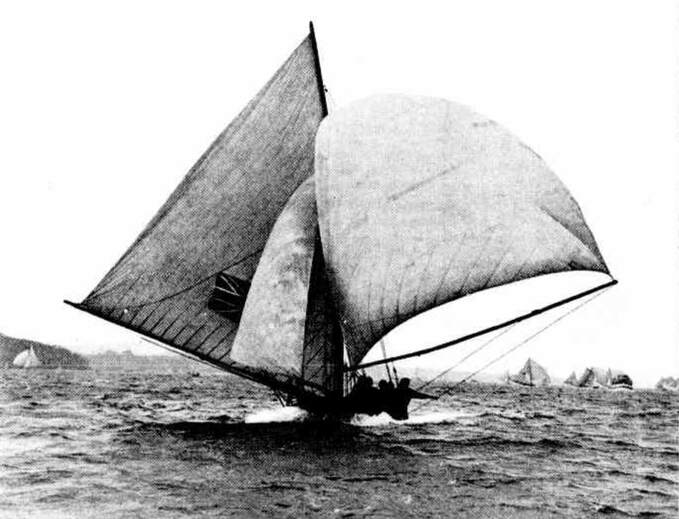
In the 1929-30 season North Sydney footballer Jack Courtney began to steer some of the time. He had been setting the spinnakers for several seasons. They gained 2nd in two Championship races and won and placed in enough handicaps to come back onto scratch and lead the prizewinners’ list. Australia won the opening handicap in the 1930-31 season and another later on, as well as winning both the SFS and the State Championships and gaining 3rd in the Australian Championships. Bill Fisher steered in 3 of those 4 wins (including both Championships), Jack Courtney steered for the other win.
Before the start of the 1931-32 season Fisher sold Australia to Harold Wilkes, but continued to steer in most races, winning the SFS Championship again, and winning it for the third time in a row the following season. They also got 2nd in the Australian title in 1932-33. Fisher was beaten into 2nd in the SFS Championship in 1933-34.
Before the start of the 1931-32 season Fisher sold Australia to Harold Wilkes, but continued to steer in most races, winning the SFS Championship again, and winning it for the third time in a row the following season. They also got 2nd in the Australian title in 1932-33. Fisher was beaten into 2nd in the SFS Championship in 1933-34.
Australia winning the SFS Championship in November 1931, the second time out of three in a row. Sydney Mail 11 Nov 1931 p36, on TROVE NLA.
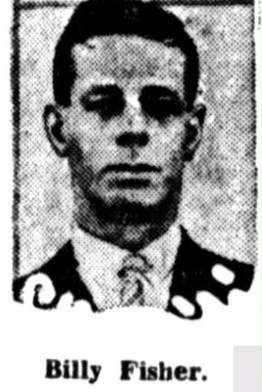
Fisher steered in many races in the first half of the 1934-35 season, but when the Australian 18-Footers Sailing League set up in opposition to the SFS in early 1935, Fisher became one of its founding members. He sailed Australia a few times in the rest of that season and the early part of the following season but in February 1936 the boat was sold to Mr Ella in Brisbane where it had the rest of that season and only a couple more seasons in the short-lived big-beam group up there, and was often the scratch boat. Fisher built a 7-foot beam Australia II in 1936 and began racing it at the League.
Australia sails past the barque Gustav, with the frd hand straining at the ballooner halyard to get the twist in the head out. Gustav only visited Sydney once, so this image must have been taken between 19 December 1926 and 1 February 1927. Hall Collection ANMM.
Australia 1946
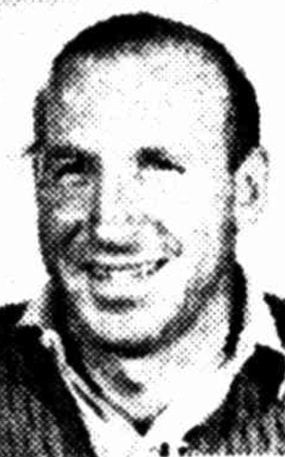
Built: Norm Wright Jnr for Bill Stanley
Insignia: Black Rectangle
Bill Stanley was a champion 12-footer sailor in Brisbane, and engaged Norm Wright to build him an 18-footer for the 1946-47 season. They won 3 of their first 5 starts and were selected as one of four boats to represent Queensland in Sydney for the Australian Championships in January 1947, the first held since the War and the first conducted by the Sydney Flying Squadron since the League took it over in 1935-36. The SFS took it back when the Brisbane club started building boats of 6-foot beam after the War and the League had a minimum beam of 7 feet. With an ageing fleet the SFS allowed the narrower boats and the League was locked out until 1951.
Australia won the first two heats in Sydney, thereby clinching the title, so it was irrelevant that they were 9th in the third heat. All placings were filled by Queensland boats, and the first 4 placings were 6-foot beamers. Bill Stanley also represented Queensland in the 12-foot titles on the same visit and was runner-up. Stanley and Australia continued Their winning streak in Brisbane for the rest of the season, winning the Club Championship and many handicap races. He applied to attend the League-run World Championship scheduled for Auckland in early 1948 but was not allowed because of their beam restriction. Photo: Bill Stanley. Top photo shows Australia on the Brisbane River. AHSSA Collection.
Insignia: Black Rectangle
Bill Stanley was a champion 12-footer sailor in Brisbane, and engaged Norm Wright to build him an 18-footer for the 1946-47 season. They won 3 of their first 5 starts and were selected as one of four boats to represent Queensland in Sydney for the Australian Championships in January 1947, the first held since the War and the first conducted by the Sydney Flying Squadron since the League took it over in 1935-36. The SFS took it back when the Brisbane club started building boats of 6-foot beam after the War and the League had a minimum beam of 7 feet. With an ageing fleet the SFS allowed the narrower boats and the League was locked out until 1951.
Australia won the first two heats in Sydney, thereby clinching the title, so it was irrelevant that they were 9th in the third heat. All placings were filled by Queensland boats, and the first 4 placings were 6-foot beamers. Bill Stanley also represented Queensland in the 12-foot titles on the same visit and was runner-up. Stanley and Australia continued Their winning streak in Brisbane for the rest of the season, winning the Club Championship and many handicap races. He applied to attend the League-run World Championship scheduled for Auckland in early 1948 but was not allowed because of their beam restriction. Photo: Bill Stanley. Top photo shows Australia on the Brisbane River. AHSSA Collection.

The 1947-48 season was less successful than their first, largely due to the arrival of 2 new boats, Jenny III and Culex II. Australia placed in some heats at the 1947-48 Australian Championships in Brisbane but was only 5th overall. The boat was a non-starter early in the 1948-49 season with Stanley preferring to sail his new 16-footer but was re- varnished and re-rigged in time to enter the test races for representing Queensland in Sydney in 1949 and was part of the team, but was unplaced in all races in Sydney.
Again in the following season, 1949-50 Stanley campaigned his 16-footer but applied to join the test races for selection but the Club disallowed this as he had not attended any Club races. Unimpressed, Stanley kept the boat in the shed that season, and sold it to Sydney’s Len Heffernan in mid-1950. Len renamed it Ace and campaigned it for 2 seasons. He won one test race in December 1950, beating Bill Barnett in Myra Too, but it was Myra Too that dominated Sydney racing that season, winning the State, National, and then World’s Championships. Len Heffernan had Barnett build him a new boat Apex for the 1951-52 season, and I can’t find any record of what happened to Australia/Ace.
Left:Australia reaching under ballooner in Sydney. AHSSA Collection.
Below: Australia working upwind on Sydney Harbour. AHSSA Collection.
Again in the following season, 1949-50 Stanley campaigned his 16-footer but applied to join the test races for selection but the Club disallowed this as he had not attended any Club races. Unimpressed, Stanley kept the boat in the shed that season, and sold it to Sydney’s Len Heffernan in mid-1950. Len renamed it Ace and campaigned it for 2 seasons. He won one test race in December 1950, beating Bill Barnett in Myra Too, but it was Myra Too that dominated Sydney racing that season, winning the State, National, and then World’s Championships. Len Heffernan had Barnett build him a new boat Apex for the 1951-52 season, and I can’t find any record of what happened to Australia/Ace.
Left:Australia reaching under ballooner in Sydney. AHSSA Collection.
Below: Australia working upwind on Sydney Harbour. AHSSA Collection.
Australian (I) 1896
Builder:Sam Williams*
Known dimensions: 18' x 8' beam, 2'3" deep, tuck 5'10" wide, spring 9" frd, 6" aft.
Planking, case and deck of Cedar, keel Spotted gum, stem and stern knees of pear tree, timbers Ash.
Boom 27', hoist 16', head 16'.
Sail Insignia: Union Jack
Skipper Chris Webb pictured perched on the tuck was a legend. He steered Australian to many victories, and the boat was the biggest prize winner up until 1903, when Billy Golding's new Arline* began to beat him quite often for a couple of seasons. To fix the problem, owner Watty Ford* who was also Webb's sheet hand by then, bought Arline and renamed it Australian in 1905 and Webb began to win again. The original Australian was sold to Botany Bay down the coast. Note that several of Webb's brothers were in the crew.
Known dimensions: 18' x 8' beam, 2'3" deep, tuck 5'10" wide, spring 9" frd, 6" aft.
Planking, case and deck of Cedar, keel Spotted gum, stem and stern knees of pear tree, timbers Ash.
Boom 27', hoist 16', head 16'.
Sail Insignia: Union Jack
Skipper Chris Webb pictured perched on the tuck was a legend. He steered Australian to many victories, and the boat was the biggest prize winner up until 1903, when Billy Golding's new Arline* began to beat him quite often for a couple of seasons. To fix the problem, owner Watty Ford* who was also Webb's sheet hand by then, bought Arline and renamed it Australian in 1905 and Webb began to win again. The original Australian was sold to Botany Bay down the coast. Note that several of Webb's brothers were in the crew.
Australian (II) 1905
Builder: Billy Golding*, launched as Arline* in 1903. Bought by Watty Ford* as it was beating his first Australian. Chris Webb continued to steer and she was one of the most successful prizewinners ever, including 2 successive Perth Flying Squadron Challenge Cups in 1908-9 in Perth and 1909-10 in Sydney. She was replaced by a third Golding Australian in 1912.
Known dimensions: see entry for Arline (I). Sail areas in 1909 were: total 1882 sq ft, main 455 sq ft, jib 170, tops'l 63, ringtail 384, balloon jib 350, spinnaker 630. Boom length 27'6".
Sail insignia: Union Jack.
Known dimensions: see entry for Arline (I). Sail areas in 1909 were: total 1882 sq ft, main 455 sq ft, jib 170, tops'l 63, ringtail 384, balloon jib 350, spinnaker 630. Boom length 27'6".
Sail insignia: Union Jack.
Avalon 1922
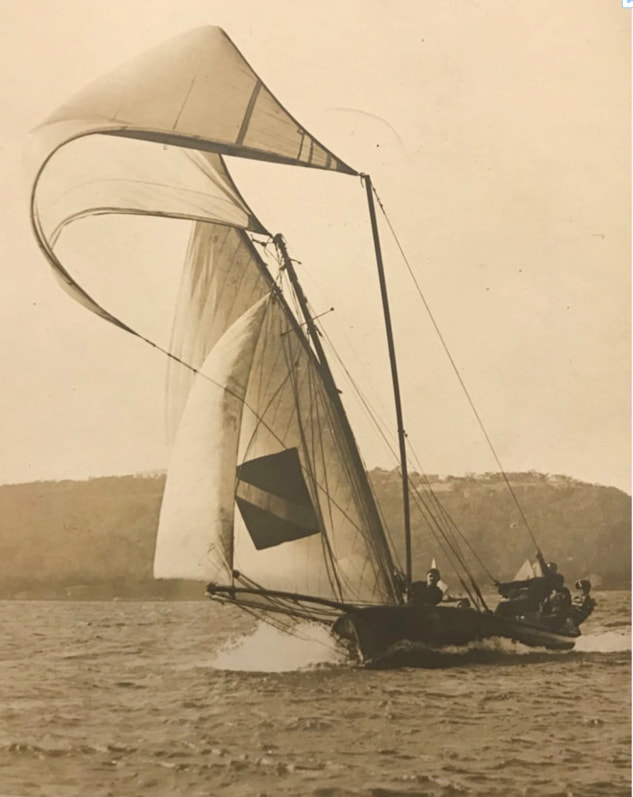
Builder: Charlie Dunn for Gordon and Stan King.
Known Dimensions: Length 17'11 3/4", beam 7'6", depth 2'2". Main 27' on boom, 17' on hoist, 16' on gaff, sails by Bob Boyce.
Sail Insignia: Black Rectangle, gold diagonal stripe, 1922 to approximately 1935, from then to last season in 1942-43 insignia was a gold star in a black square.
Brothers Gordon and Stan King were active sailors who owned Avalon for the whole of her racing career, from 1922 to 1943. Gordon was the skipper, Stan was the frd hand. Stan also sailed the ten-footer Wallaby on Sundays with the Balmain Dingy Club. Avalon was always a long-marker or mid-field boat but was sailed competently and won her fair share of prize money in handicap races. They had wins in both light breezes and hard blows. Their best single performance in a Championship race was in the 1937 SFS Club Championship when Avalon led the fleet from a scratch start for the first half of the race, but lost a man overboard on the first gybe at Shark Is, and in the time it took to recover him Britannia got through and stayed in front for the rest of the race.
They also had their fair share of capsizes, winning the dubious honour of the being the first boat to capsize in each of two seasons, in 1924 and 1928.
In October 1936 Avalon was hit and damaged by a steamer and three crew were slightly injured, but the damage was repaired so quickly they were back sailing the following Saturday and even won the race on the Saturday after that, off 3 3/4". They were famously one of only four boats to start in a gale on Saturday 18 September 1937, along with Kismet*, Yendys* and Britannia*. None finished.
Stan King married reasonably late in life in 1939, to a Miss C.Garstang who was a sailor in her own right and who made history by being the first woman to take the mainsheet in a number of races in the early 1940's.
Known Dimensions: Length 17'11 3/4", beam 7'6", depth 2'2". Main 27' on boom, 17' on hoist, 16' on gaff, sails by Bob Boyce.
Sail Insignia: Black Rectangle, gold diagonal stripe, 1922 to approximately 1935, from then to last season in 1942-43 insignia was a gold star in a black square.
Brothers Gordon and Stan King were active sailors who owned Avalon for the whole of her racing career, from 1922 to 1943. Gordon was the skipper, Stan was the frd hand. Stan also sailed the ten-footer Wallaby on Sundays with the Balmain Dingy Club. Avalon was always a long-marker or mid-field boat but was sailed competently and won her fair share of prize money in handicap races. They had wins in both light breezes and hard blows. Their best single performance in a Championship race was in the 1937 SFS Club Championship when Avalon led the fleet from a scratch start for the first half of the race, but lost a man overboard on the first gybe at Shark Is, and in the time it took to recover him Britannia got through and stayed in front for the rest of the race.
They also had their fair share of capsizes, winning the dubious honour of the being the first boat to capsize in each of two seasons, in 1924 and 1928.
In October 1936 Avalon was hit and damaged by a steamer and three crew were slightly injured, but the damage was repaired so quickly they were back sailing the following Saturday and even won the race on the Saturday after that, off 3 3/4". They were famously one of only four boats to start in a gale on Saturday 18 September 1937, along with Kismet*, Yendys* and Britannia*. None finished.
Stan King married reasonably late in life in 1939, to a Miss C.Garstang who was a sailor in her own right and who made history by being the first woman to take the mainsheet in a number of races in the early 1940's.
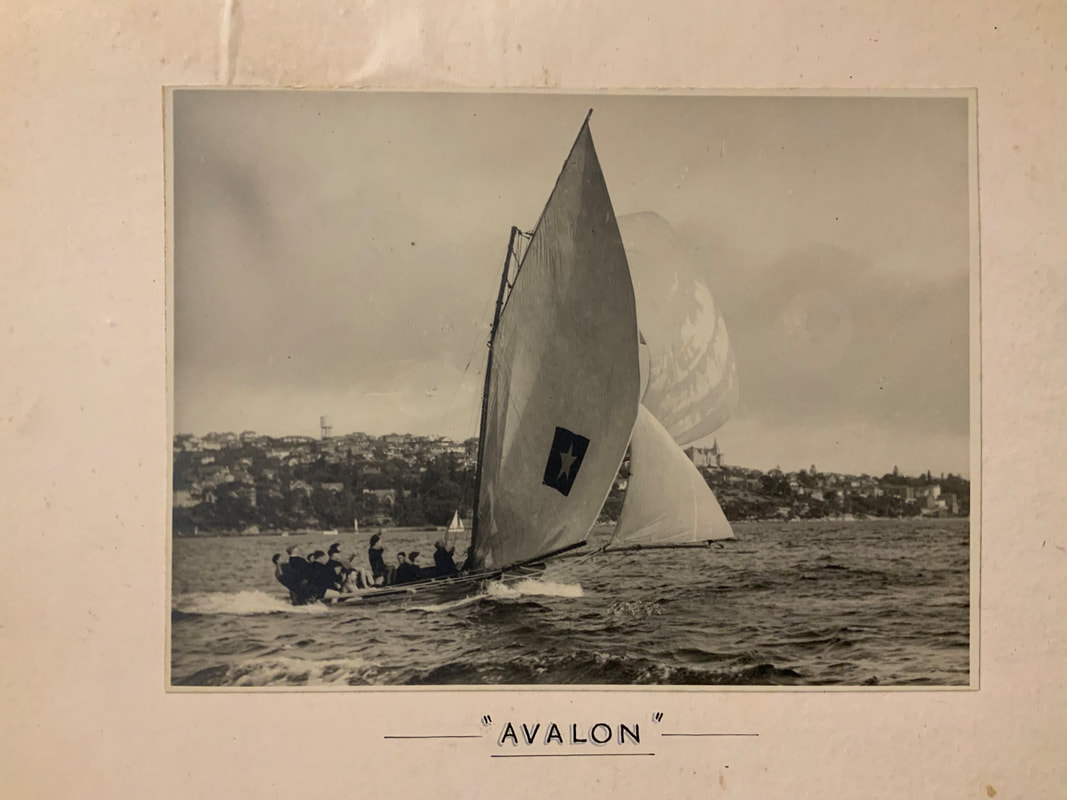
This framed photo of Avalon is from the Frank Burrows family collection. Frank appears to have been regular crew in Avalon and Stan King's 10-footer Wallaby from the late 1930's. You can see the sail logo is different, Avalon changed to this gold star in a black square after about 1935. It was the same insignia carried on Wallaby.
Aztec 1892
Builder: Hubbard, Glebe Point, for Syd Dempster.
Sail insignia: 3 stars on crescent.
Aztec was one of the first 18 footers when they became established as a recognisable class. She was not a beamy boat, one comment was that she was "purely a skiff". She sailed with the Johnstone's Bay Sailing Club but won only handicap races. She appears not to have sailed after March 1895 when Dempster advertised her for sale, but she appears in Townsville in 1907 and is last heard of racing in Cairns in 1915.
The photograph is interesting because it is one of only a few photos that show an eighteen carrying a squares'l and raffee, which they did until the late 1890's.
Sail insignia: 3 stars on crescent.
Aztec was one of the first 18 footers when they became established as a recognisable class. She was not a beamy boat, one comment was that she was "purely a skiff". She sailed with the Johnstone's Bay Sailing Club but won only handicap races. She appears not to have sailed after March 1895 when Dempster advertised her for sale, but she appears in Townsville in 1907 and is last heard of racing in Cairns in 1915.
The photograph is interesting because it is one of only a few photos that show an eighteen carrying a squares'l and raffee, which they did until the late 1890's.
Britannia 1919
Britannia working upwind, between 1919 and 1935, determined by the presence of Mascotte at right. Hall Collection, ANMM.
Builder:George Robinson*
Known Dimensions: 18'x 8' x 2'0" deep
Planking, thwarts, case, decking Australian Cedar, seam battens NZ Kauri, keel, ribs Spotted Gum, stem and stern knees and all other knees Tea-Tree.
Sail Insignia: Red Duster, British Merchant Marine flag.
Britannia was built in 1919 by Wee Georgie Robinson who at the time was the Balmain Tigers (Rugby League) First Grade half-back. Her first race was the Club Championship of the Sydney Sailing Club (which merged with the Sydney Flying Squadron a few years later) in which she came fourth, an impressive debut for a new boat. Her first win was in a handicap race run by the SSC on 14 February 1920. Britannia always sailed off low handicaps and was scratch boat on a number of occasions over her career. Wee Georgie sailed her every season except two (1931-2 and 1932-3) until 1944. On retirement, a newspaper report listed her achievements as competing in about 650 races with 40 wins including 13 Championships, and over 120 placings winning 1500 pounds in prize money. She never won an Australian Championship, but won the NSW and Club Championships several times.
Britannia was very much a family boat. George's brother Les and cousin Charlie sailed with him on launch day and were still in the regular crew as late as 1942. His father Jack Robinson steered the boat on a number of occasions, especially when George was playing or refereeing Rugby League at the beginning and end the the season. His son Ron joined the crew during the Second World War and steered the boat for most of the 1942-43 season. Other family members were semi-regular guest crew.
After retiring her, Wee Georgie turned Britannia into a launch, and a few years later used her to fill in as the starter for the SFS, temporarily. This lasted for 28 years. The boat was restored in 1990 for display at the Australian National Maritime Museum. I launched a replica in 2002 which sails with the fleet of 11 out of the Sydney Flying Squadron. The building record of this replica is used as the basis for the construction section of The Open Boat book.
Burrawang 1936
Builder: Owners Wal and Pat Munce built the boat, possibly with the assistance of W.Verity. The picture shows the boat on completion before launching.
Known Dimensions: 17'10 1/2" x 7'4" x 2'1"
Sail Insignia: Black ball
Burrawang was one of several new boats built for the 1936-37 season, the second full season of the Australian 18-footers League, established in January 1935 as a breakaway from the Sydney Flying Squadron (read the story in The Open Boat book or in more detail in Robin Elliott's Galloping Ghosts). Because the League raced on Sundays, a large number of 12 and 16-footer sailors built or had new-18-footers built, and were still able to race with their other fleets on Saturdays. The Munce brothers were 12-footer sailors.
The image, supplied by Brian Munce, Wally's son, is fascinating because it shows in great detail the typical features of the League style of more skiff-like boats, narrower than the previously built big-beamers of the SFS, with narrower decks, no heel or skeg and no reverse curves in the mid or aft sections, though bows were flared. Lee cloths and turning thumb cleats or blocks remain to be fitted.
Burrawang was not a successful boat. The brothers both steered at times but Wal was the usual skipper. They won no races in the first season. They were almost always on the handicap limit of 5 minutes, though they came in a minute or half a minute a couple of times after placings. For the second season, 1937-38 they had a new intermediate rig made, and won the second race of the season with Pat at the helm. A picture of them rounding the top mark first that day, 26 September 1937 supplied by Lee Tetley, Pat Munce's daughter is in the FLEETS section of this website. They made the papers, who mentioned that immediately after crossing the finish line the crew got so excited that they capsized.
The brothers only sailed the boat for a few more races, and sold it in November to a syndicate of Club officials. This was however against the rules and disallowed, so somebody else bought the boat and it was sailed by Bob Cuneo and then Paddy Griffiths for the rest of that season, still largely unsuccessfully. In the Winter of 1938 Burrawang was sold to George Priest and renamed Norma D II and transferred to the Sydney Flying Squadron for the next three seasons, retiring after the 1940-41 season.
Burrawang was slow but it was not the fault of the Munce brothers as sailors, because immediately after selling the boat they bought the ex-Australian 12-footer Champion Nina and sailed it for a season successfully, winning a heat of the Australian Championship. In 1940 they built a 12-footer they called Nita (pictured on FLEETS Page) and sailed her with a three-man crew when most other boats still had four. They won a State Championship in her and were third in the 1940-41 Australian title in Sydney , then built another named Beryl and won the Australian title in the 1941-42 season in Brisbane. Wal Munce resumed sailing Beryl after the war and continued until at least 1951. Both brothers had active sailing careers for the rest of their lives.
Known Dimensions: 17'10 1/2" x 7'4" x 2'1"
Sail Insignia: Black ball
Burrawang was one of several new boats built for the 1936-37 season, the second full season of the Australian 18-footers League, established in January 1935 as a breakaway from the Sydney Flying Squadron (read the story in The Open Boat book or in more detail in Robin Elliott's Galloping Ghosts). Because the League raced on Sundays, a large number of 12 and 16-footer sailors built or had new-18-footers built, and were still able to race with their other fleets on Saturdays. The Munce brothers were 12-footer sailors.
The image, supplied by Brian Munce, Wally's son, is fascinating because it shows in great detail the typical features of the League style of more skiff-like boats, narrower than the previously built big-beamers of the SFS, with narrower decks, no heel or skeg and no reverse curves in the mid or aft sections, though bows were flared. Lee cloths and turning thumb cleats or blocks remain to be fitted.
Burrawang was not a successful boat. The brothers both steered at times but Wal was the usual skipper. They won no races in the first season. They were almost always on the handicap limit of 5 minutes, though they came in a minute or half a minute a couple of times after placings. For the second season, 1937-38 they had a new intermediate rig made, and won the second race of the season with Pat at the helm. A picture of them rounding the top mark first that day, 26 September 1937 supplied by Lee Tetley, Pat Munce's daughter is in the FLEETS section of this website. They made the papers, who mentioned that immediately after crossing the finish line the crew got so excited that they capsized.
The brothers only sailed the boat for a few more races, and sold it in November to a syndicate of Club officials. This was however against the rules and disallowed, so somebody else bought the boat and it was sailed by Bob Cuneo and then Paddy Griffiths for the rest of that season, still largely unsuccessfully. In the Winter of 1938 Burrawang was sold to George Priest and renamed Norma D II and transferred to the Sydney Flying Squadron for the next three seasons, retiring after the 1940-41 season.
Burrawang was slow but it was not the fault of the Munce brothers as sailors, because immediately after selling the boat they bought the ex-Australian 12-footer Champion Nina and sailed it for a season successfully, winning a heat of the Australian Championship. In 1940 they built a 12-footer they called Nita (pictured on FLEETS Page) and sailed her with a three-man crew when most other boats still had four. They won a State Championship in her and were third in the 1940-41 Australian title in Sydney , then built another named Beryl and won the Australian title in the 1941-42 season in Brisbane. Wal Munce resumed sailing Beryl after the war and continued until at least 1951. Both brothers had active sailing careers for the rest of their lives.
Crows Nest 1947
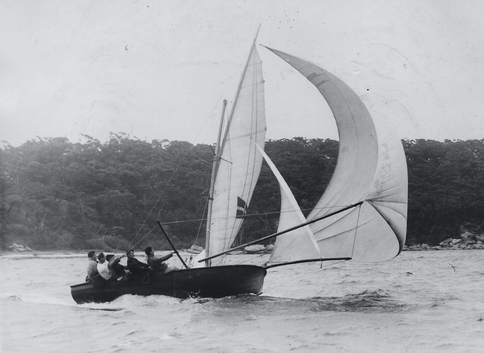
Builder: Norman Wright Jnr*, Brisbane. Launched as Iris in 1946, sold to Sydney in 1947. Seven-foot beam.
Sail Insignia: Blue pennant .
Crows Nest was sailed for the owner by George Pearce in the 1947-48 and 1948-49 seasons with moderate success with the NSW 18-footers League in Double Bay. For the 1949-50 season Cliff Monkhouse became skipper. Cliff was a champion 12-footer sailor in his boat Toogara, and kept sailing both boats most Sundays, racing Toogara with the Double Bay 12-footers in the morning and Crows Nest with the League in the afternoon. He sailed Crows Nest for 3 seasons, then bought one of his main rivals Almae in 1952, renamed it Crows Nest II and sailed it in the 1952-53 season. In the winter of 1953 he had George McGoogan build him the first of several 18-footers he called Toogara (I-IV) in some of which he gained podium finishes in both the Australian and World Championships in the 1950's. Cliff was always known for having a go. The photo above is from the front page of the Sydney Morning Herald on 10 October 1949, taken the day before. In only his third race at the helm of an 18-footer Cliff put up a peak-head spinnaker at the Sow and Pigs in a black Nor'easter and was leading by a minute when this photograph was taken on the run to Shark island. But just after this shot was taken they rolled on a wave and capsized. Cliff also famously came second in a race a few weeks later after breaking off half his rudder while in front halfway through the race.
A photo on the FLEETS Page shows Cliff in Crows Nest II really blasting along in a howling westerly. The accompanying photo here shows what we think is Crows Nest (I) in the same waters off Taylor Bay but this time in a Southerly.
Cliff lived into the early 21st Century and was was very helpful in saving and passing on historical items and images to the AHSSA and SFS and to Robin Elliott, author of Galloping Ghosts.
Top photo from Morrie Lynch's scrapbook, SFS. Second photo from John Stanley collection.
Sail Insignia: Blue pennant .
Crows Nest was sailed for the owner by George Pearce in the 1947-48 and 1948-49 seasons with moderate success with the NSW 18-footers League in Double Bay. For the 1949-50 season Cliff Monkhouse became skipper. Cliff was a champion 12-footer sailor in his boat Toogara, and kept sailing both boats most Sundays, racing Toogara with the Double Bay 12-footers in the morning and Crows Nest with the League in the afternoon. He sailed Crows Nest for 3 seasons, then bought one of his main rivals Almae in 1952, renamed it Crows Nest II and sailed it in the 1952-53 season. In the winter of 1953 he had George McGoogan build him the first of several 18-footers he called Toogara (I-IV) in some of which he gained podium finishes in both the Australian and World Championships in the 1950's. Cliff was always known for having a go. The photo above is from the front page of the Sydney Morning Herald on 10 October 1949, taken the day before. In only his third race at the helm of an 18-footer Cliff put up a peak-head spinnaker at the Sow and Pigs in a black Nor'easter and was leading by a minute when this photograph was taken on the run to Shark island. But just after this shot was taken they rolled on a wave and capsized. Cliff also famously came second in a race a few weeks later after breaking off half his rudder while in front halfway through the race.
A photo on the FLEETS Page shows Cliff in Crows Nest II really blasting along in a howling westerly. The accompanying photo here shows what we think is Crows Nest (I) in the same waters off Taylor Bay but this time in a Southerly.
Cliff lived into the early 21st Century and was was very helpful in saving and passing on historical items and images to the AHSSA and SFS and to Robin Elliott, author of Galloping Ghosts.
Top photo from Morrie Lynch's scrapbook, SFS. Second photo from John Stanley collection.
Cutty Sark 1925
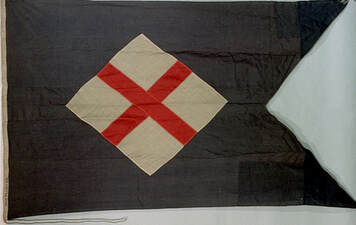
Builder: Bill Fisher (one source says Jack Fisher) at La Perouse for JH Memmis (also spelled Memes), the owner of Mavis at the time. Newspaper comments suggest the boat was similar to Fisher’s champion Australia*.
Insignia: The first two seasons she carried the outline of a scarlet shirt (a cutty sark in Scotland), after changing hands she carried a blue flag with red diagonal cross on white diamond. Vexillologist John Vaughan has contributed the information (and the image) that this logo is the House Flag of John Wills & Son, London and was worn by their Tea Clipper Cutty Sark in 1869.
Cutty Sark raced for 12 seasons mostly as a mid-field boat in handicap and earnings with the exception of one season, 1934-35 when Sid Barnett Jnr steered (his father Sid Snr had been setting the extras on the boat for several seasons) and got the boat into scratch.
Cutty Sark was launched on 12 September, the same day as Yendys* but didn’t race until the second race of the season on 26 September under J Napier, a 10-footer skipper, but was third last. They had to wait until January to score their first and only win of the season under Bill Edney, who also got the boat into 5th in the State Championship a month later. Gwynne Sands took over as skipper in the middle of their second season and got a win in a final and another in the Scotchman’s Hill Cup in a soldier’s wind (all reaching). The elderly legend Tom Colebrook (Jnr?) guest appeared on the tiller just once but finished near the tail end.
Insignia: The first two seasons she carried the outline of a scarlet shirt (a cutty sark in Scotland), after changing hands she carried a blue flag with red diagonal cross on white diamond. Vexillologist John Vaughan has contributed the information (and the image) that this logo is the House Flag of John Wills & Son, London and was worn by their Tea Clipper Cutty Sark in 1869.
Cutty Sark raced for 12 seasons mostly as a mid-field boat in handicap and earnings with the exception of one season, 1934-35 when Sid Barnett Jnr steered (his father Sid Snr had been setting the extras on the boat for several seasons) and got the boat into scratch.
Cutty Sark was launched on 12 September, the same day as Yendys* but didn’t race until the second race of the season on 26 September under J Napier, a 10-footer skipper, but was third last. They had to wait until January to score their first and only win of the season under Bill Edney, who also got the boat into 5th in the State Championship a month later. Gwynne Sands took over as skipper in the middle of their second season and got a win in a final and another in the Scotchman’s Hill Cup in a soldier’s wind (all reaching). The elderly legend Tom Colebrook (Jnr?) guest appeared on the tiller just once but finished near the tail end.
A rare shot of Cutty Sark with the red shirt (a cutty sark in Scotland) insignia, carried only for their first 2 seasons, 1925-26 and 1926-27. Hall Collection ANMM.
A shot of Cutty Sark with HC Press in the background from a scrapbook courtesy of Steve Kavanagh.
The appearance of Gwynne Sands in January 1926 may have meant that the boat had changed hands at this point, as it was reported as being owned by a syndicate headed by Sands in the following season, 1927-28. The original owner Memmis re-commissioned Mavis and campaigned her for several seasons. Cutty Sark’s insignia was changed from the scarlet shirt to the blue, white and red insignia (the house flag of the owners of the clipper Cutty Sark) in the accompanying photos.
Sands steered most of the time from then on, with occasional guest appearances from builder Billy Fisher (after he sold Australia) and George Drysdale. The boat’s handicap varied from 3 minutes to 8 minutes and was generally mid-field in earnings. Sands got no closer than 6th in any championship race (scratch start). Newspaper comments suggest the boat was considered a light weather performer, but there were comments suggesting she was also a good hard weather boat. The 1933-34 season was their best to date with one win and enough placings in handicap races to get 2nd on the earnings table with £44 for the season. It was always commented on that the boat was always well-presented and “finely rigged”.
In the 1934-35 season Sands engaged rising young star Sid Barnett Jnr to steer, and within a few races they were in to scratch. In March however Sid left to sail Scot with the new 18-ft Sailing League which had been set up in opposition to the SFS, and Sands resumed the tiller. They earned £59 that season, 3rd on the list.
With less competition in the next few seasons due to many of the leading skippers going over to the League and several boats retiring Cutty Sark managed a 3rd in the Port Jackson Championship and moved into scratch or close to it most of the time and even gained fastest time at least once. The boat was overhauled by Bill Fisher for the 1936-37 season but it proved to be her last. Sands bought the ex-champion Arawatta at the end of that season and campaigned her from the following season as Cutty Sark II.
Sands steered most of the time from then on, with occasional guest appearances from builder Billy Fisher (after he sold Australia) and George Drysdale. The boat’s handicap varied from 3 minutes to 8 minutes and was generally mid-field in earnings. Sands got no closer than 6th in any championship race (scratch start). Newspaper comments suggest the boat was considered a light weather performer, but there were comments suggesting she was also a good hard weather boat. The 1933-34 season was their best to date with one win and enough placings in handicap races to get 2nd on the earnings table with £44 for the season. It was always commented on that the boat was always well-presented and “finely rigged”.
In the 1934-35 season Sands engaged rising young star Sid Barnett Jnr to steer, and within a few races they were in to scratch. In March however Sid left to sail Scot with the new 18-ft Sailing League which had been set up in opposition to the SFS, and Sands resumed the tiller. They earned £59 that season, 3rd on the list.
With less competition in the next few seasons due to many of the leading skippers going over to the League and several boats retiring Cutty Sark managed a 3rd in the Port Jackson Championship and moved into scratch or close to it most of the time and even gained fastest time at least once. The boat was overhauled by Bill Fisher for the 1936-37 season but it proved to be her last. Sands bought the ex-champion Arawatta at the end of that season and campaigned her from the following season as Cutty Sark II.
Dee Why 1935
Builder: Willis Douglass
Insignia: Red DY . Dee Why is a suburb of Sydney in the area Douglass came from.
Dee Why was built by Willis Douglass, an established builder of 16-footers for the second season (1935-36) of the new 18-footers League which had split from the Sydney Flying Squadron in January 1935. It was the first 18-footer of many that he built. Douglass is listed early on in a newspaper as the owner and apparently sailed a bit in the crew, but bookmaker Stan Sheldon is recorded elsewhere as the owner. Sheldon engaged Chris Webb to come out of retirement (again) to steer, and the boat was launched on Saturday 21 September 1935. As one of five new boats in the League fleet of just ten, Dee Why was 3rd to HC Press(V) and The Mistake in the first race on Sunday 29 September in a scratch start race. They had to wait until 3 November for their first win in the first heat of the state title, partly because Bert Swinbourne a graduate from 16-footers had been given the tiller on Gwenyth which was the renamed HC Press IV and had won two races in a row. Webb had a day off a fortnight later and Jack Lyons another 16-footer man took over the tiller and won in his first race in 18’s. Webb won a couple more races that season, and Dee Why won another skippered by Eric Parsons. Webb placed in the two other heats of the State title but was second overall to HC Press V (George Press). Dee Why won £65 in prize money that season, second to Gwenyth with £66.
For the 1936-37 season Webb moved over top the new Douglass-built Collaroy (another Northern Beaches suburb) for Stan Sheldon who sold Dee Why to Wally Homes and Jim Alderton. Holmes skippered early in the season, without a great deal of success, but Jim Alderton who was a former State and National 12’ Champion took over in December and began to feature on the podium. He won three races including the last two races of the season and was leading in another when disqualified.
Alderton kept up his success in the 1937-38 season, winning four races in addition to the Anniversary Regatta race and gaining second overall in the State Championship (to the new boat Malvina steered by 16-footer champion Billo Hayward) in spite of breaking their bumpkin in the final heat. They were one of four NSW reps to go to Brisbane in January but did not feature. They won £250 in prize money for the season, a considerable sum when a new boat cost £300-400! Alderton by all accounts was a popular chap who gathered a good crew around him including the late Brian Gale as for’d hand. Brian was considered one of the best at the time and was sought after. He sailed for’d for Bert Swinbourne in Taree in New Zealand in 1939 in the famous race where the Kiwis disqualified them. Brian was a straight-up kinda guy, and when yachting journalist Lou d’Alpuget accused Brian of throwing a race for money at a League meeting Brian threw him down the stairs. The d’Alpuget and Gale families have not been friendly since then.
Insignia: Red DY . Dee Why is a suburb of Sydney in the area Douglass came from.
Dee Why was built by Willis Douglass, an established builder of 16-footers for the second season (1935-36) of the new 18-footers League which had split from the Sydney Flying Squadron in January 1935. It was the first 18-footer of many that he built. Douglass is listed early on in a newspaper as the owner and apparently sailed a bit in the crew, but bookmaker Stan Sheldon is recorded elsewhere as the owner. Sheldon engaged Chris Webb to come out of retirement (again) to steer, and the boat was launched on Saturday 21 September 1935. As one of five new boats in the League fleet of just ten, Dee Why was 3rd to HC Press(V) and The Mistake in the first race on Sunday 29 September in a scratch start race. They had to wait until 3 November for their first win in the first heat of the state title, partly because Bert Swinbourne a graduate from 16-footers had been given the tiller on Gwenyth which was the renamed HC Press IV and had won two races in a row. Webb had a day off a fortnight later and Jack Lyons another 16-footer man took over the tiller and won in his first race in 18’s. Webb won a couple more races that season, and Dee Why won another skippered by Eric Parsons. Webb placed in the two other heats of the State title but was second overall to HC Press V (George Press). Dee Why won £65 in prize money that season, second to Gwenyth with £66.
For the 1936-37 season Webb moved over top the new Douglass-built Collaroy (another Northern Beaches suburb) for Stan Sheldon who sold Dee Why to Wally Homes and Jim Alderton. Holmes skippered early in the season, without a great deal of success, but Jim Alderton who was a former State and National 12’ Champion took over in December and began to feature on the podium. He won three races including the last two races of the season and was leading in another when disqualified.
Alderton kept up his success in the 1937-38 season, winning four races in addition to the Anniversary Regatta race and gaining second overall in the State Championship (to the new boat Malvina steered by 16-footer champion Billo Hayward) in spite of breaking their bumpkin in the final heat. They were one of four NSW reps to go to Brisbane in January but did not feature. They won £250 in prize money for the season, a considerable sum when a new boat cost £300-400! Alderton by all accounts was a popular chap who gathered a good crew around him including the late Brian Gale as for’d hand. Brian was considered one of the best at the time and was sought after. He sailed for’d for Bert Swinbourne in Taree in New Zealand in 1939 in the famous race where the Kiwis disqualified them. Brian was a straight-up kinda guy, and when yachting journalist Lou d’Alpuget accused Brian of throwing a race for money at a League meeting Brian threw him down the stairs. The d’Alpuget and Gale families have not been friendly since then.
Illuminated presentation to skipper Alderton from his crew, 1937-38 season. Ian Smith collection.
Alderton and Dee Why’s luck ran out in the 1938-39 season. Several DNF’s including a capsize early in the season were followed by a disqualification in the first heat of the State Championship on 30 October 1938. Alderton continued in the race after disqualification which led to a further disqualification for one week. Alderton dropped the lip and threatened to sell the boat. Brian Gale steered for two or three races in November, and Alderton made one or two more appearances but the boat was a non-starter in many races, and during the off-season Alderton sold the boat to A Cole and JW Noyes.
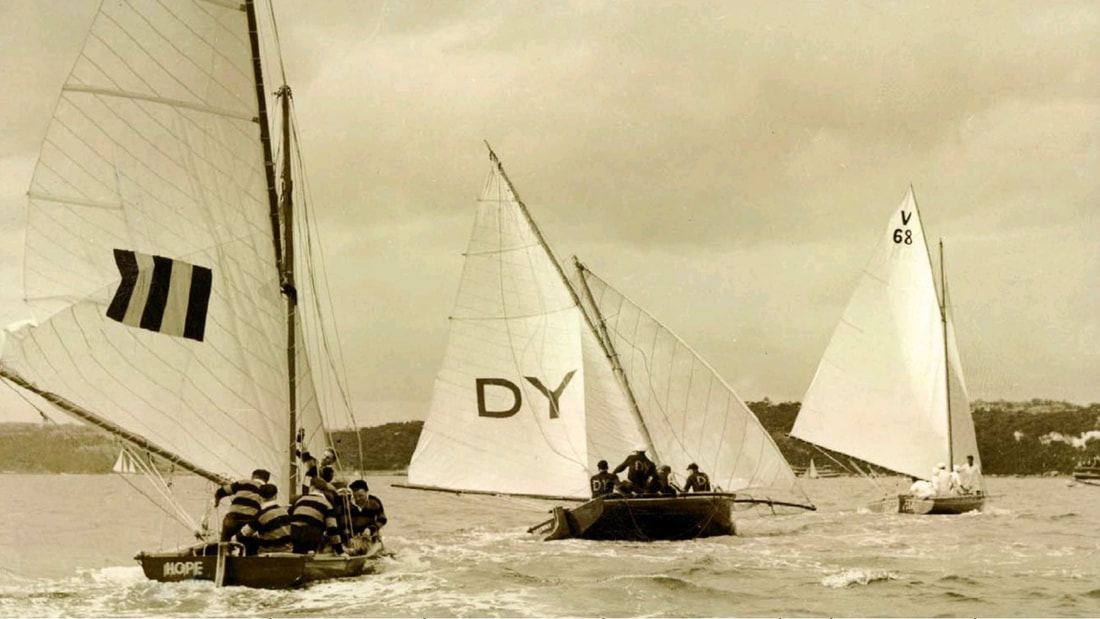
Dee Why took part in the World Championship in 1938 but didn't feature. The series was won by Bert Swinbourne in Taree. John Stanley Collection.
The new owners installed young Alec Imber from the canvas 12-footers as skipper for the 1939-40, but they didn’t really give him a chance as after just three races without a win they sacked him and installed Billo Hayward (out of retirement again) to steer. Billo withdrew from his first race having rigged too big sails but won the next two in a row including the first heat of the State title. After a couple more places Dee Why under Billo won the third heat of the State title and thereby clinched the Championship. They won a total of four races that season.
At the end of the season Cole and Noyes announced they had commissioned Willis Douglass to build a new boat to be called Dee Why II and Billo Hayward steered this boat for a while in the 1940-41 season but the boat was not a success and it sailed for only two seasons.
The original Dee Why was sold to Bendall and Billington in 1941 and raced in the 1941-42 season under the name Survey with R Bendall steering, without much success. Bendall had been Dee Why’s sheet hand in the 1935-36 season for Chris Webb. They sold the boat to Tom Golden in 1942 and it raced for a couple of seasons as Mascotte II, again without a great deal of success. Many newer boats had come along during Dee Why’s career in a time of considerable innovation but she is an illustration of the fact that a good skipper and a good crew can make a helluva difference to a boat, and Chris Webb, Jim Alderton and Billo Hayward were three of the best and gathered good crews around them.
At the end of the season Cole and Noyes announced they had commissioned Willis Douglass to build a new boat to be called Dee Why II and Billo Hayward steered this boat for a while in the 1940-41 season but the boat was not a success and it sailed for only two seasons.
The original Dee Why was sold to Bendall and Billington in 1941 and raced in the 1941-42 season under the name Survey with R Bendall steering, without much success. Bendall had been Dee Why’s sheet hand in the 1935-36 season for Chris Webb. They sold the boat to Tom Golden in 1942 and it raced for a couple of seasons as Mascotte II, again without a great deal of success. Many newer boats had come along during Dee Why’s career in a time of considerable innovation but she is an illustration of the fact that a good skipper and a good crew can make a helluva difference to a boat, and Chris Webb, Jim Alderton and Billo Hayward were three of the best and gathered good crews around them.
Defiance 1925
Builder: J.H "Jack" Whereat, Bulimba, Brisbane for J. Hibberd or Hibbard, once of Port Macquarie, living in Sydney in 1925. Design was said to be influenced by Billy Dunn's ideas. Billy was the skipper for its first two seasons.
Known Dimensions: 7' beam, 2' depth.
Sail insignia: Black Crescent.
After an inauspicious start on 17 October 1925 when she capsized in a howling Westerly, Billy Dunn managed to win a bit of prize money and kept her handicap fairly low. She won the Port Jackson Championship that season. She was judged to be a good hard weather boat. Billy Dunn stayed off the water for her third season 1927-28. Owner Hibberd steered several times himself and tried other skippers such as D.Young. Harry Moncton and D.Murray bought the boat sometime during that season, and Murray steered her himself several times, but generally they put known skippers in charge for the next few seasons, including Ossie Hahn, Joe Budnick, Tony Russell and others. She was briefly scratch boat in March 1929. Chook Fraser took over the helm for the 1932-33 and 1933-34 seasons, and the boat disappears from race reports after early 1934. She is reported as not being on the register of the Sydney Flying Squadron in November 1935. The upper photo is from the Sydney Flying Squadron collection and a new print of the same photo was recently donated to the SFS by Harry Monckton's descendants, along with a number of trophies Moncton had won with Defiance and another boat he owned, Kiwi. The lower photos come from Christine George whose father Joe Wilkinson is third from the right on the far side of the boat with his head in line with the bow of the ship beyond. The white uniforms first appeared in September 1929 and were disparagingly referred to as "beach pyjamas".
Known Dimensions: 7' beam, 2' depth.
Sail insignia: Black Crescent.
After an inauspicious start on 17 October 1925 when she capsized in a howling Westerly, Billy Dunn managed to win a bit of prize money and kept her handicap fairly low. She won the Port Jackson Championship that season. She was judged to be a good hard weather boat. Billy Dunn stayed off the water for her third season 1927-28. Owner Hibberd steered several times himself and tried other skippers such as D.Young. Harry Moncton and D.Murray bought the boat sometime during that season, and Murray steered her himself several times, but generally they put known skippers in charge for the next few seasons, including Ossie Hahn, Joe Budnick, Tony Russell and others. She was briefly scratch boat in March 1929. Chook Fraser took over the helm for the 1932-33 and 1933-34 seasons, and the boat disappears from race reports after early 1934. She is reported as not being on the register of the Sydney Flying Squadron in November 1935. The upper photo is from the Sydney Flying Squadron collection and a new print of the same photo was recently donated to the SFS by Harry Monckton's descendants, along with a number of trophies Moncton had won with Defiance and another boat he owned, Kiwi. The lower photos come from Christine George whose father Joe Wilkinson is third from the right on the far side of the boat with his head in line with the bow of the ship beyond. The white uniforms first appeared in September 1929 and were disparagingly referred to as "beach pyjamas".
Desdemona 1912
Builder: Charlie Dunn*
Known Dimensions: 17'11 3/4" x 7'2" beam by 2' deep. Spring 8" frd, 5"aft. Described as having hollow garboards and a hard bilge carried right forward. Cedar planking on Spotted Gum ribs, tea-tree stem and stern.
Skiff-type sail: Desdemona was unusual as it was one of very few 18-footers in 1912 to carry a skiff-type sail, that is, horizontally-cut panels of cloth with battens, and a bit higher-peaked than most at this stage. The jib in the photo above is mitre-cut which was also rare on 18-footers.
Sail Insignia: Red, white and blue crescent.
Desdemona was built for A.C.Roberts who was a solicitor and became the NSW Solicitor-General. He had previously owned other open boats including the 22-footer Vuna in the 1890's. He steered the boat himself and she was always a middle of the fleet or long-marker boat but had her share of wins on handicap. For most of her life Desdemona was kept in the shed in Mosman Bay that became the Sydney Amateur Sailing Club clubhouse, and it was know as "Desie's shed". Roberts sailed her up until he died in 1938, then his mainsheet hand Tommy Doyle took over as skipper and shared ownership with three others of the crew. Desdemona raced for 31 seasons (the second-longest run of all boats after Scot* with 43) up until January 1941 when Tommy Doyle bought the Willis Douglass-built Collaroy of 1938 and renamed her Desdemona II. He was not happy with her and with Laurie Blake built Desdemona III in 1943. The Wright-built Sea-Witch of 1946 became Desdemona IV in 1947, and Tommy Doyle built Desdemona V in 1949 but sold her three years later.
The sailing photo below shows Desdemona II, II or IV, with the crew driving the boat hard on a shy run, and the crew and boat photo is at the launch of Desdemona III on the beach at Double Bay in 1943. All these photos are from the Sydney Flying Squadron collection.
Known Dimensions: 17'11 3/4" x 7'2" beam by 2' deep. Spring 8" frd, 5"aft. Described as having hollow garboards and a hard bilge carried right forward. Cedar planking on Spotted Gum ribs, tea-tree stem and stern.
Skiff-type sail: Desdemona was unusual as it was one of very few 18-footers in 1912 to carry a skiff-type sail, that is, horizontally-cut panels of cloth with battens, and a bit higher-peaked than most at this stage. The jib in the photo above is mitre-cut which was also rare on 18-footers.
Sail Insignia: Red, white and blue crescent.
Desdemona was built for A.C.Roberts who was a solicitor and became the NSW Solicitor-General. He had previously owned other open boats including the 22-footer Vuna in the 1890's. He steered the boat himself and she was always a middle of the fleet or long-marker boat but had her share of wins on handicap. For most of her life Desdemona was kept in the shed in Mosman Bay that became the Sydney Amateur Sailing Club clubhouse, and it was know as "Desie's shed". Roberts sailed her up until he died in 1938, then his mainsheet hand Tommy Doyle took over as skipper and shared ownership with three others of the crew. Desdemona raced for 31 seasons (the second-longest run of all boats after Scot* with 43) up until January 1941 when Tommy Doyle bought the Willis Douglass-built Collaroy of 1938 and renamed her Desdemona II. He was not happy with her and with Laurie Blake built Desdemona III in 1943. The Wright-built Sea-Witch of 1946 became Desdemona IV in 1947, and Tommy Doyle built Desdemona V in 1949 but sold her three years later.
The sailing photo below shows Desdemona II, II or IV, with the crew driving the boat hard on a shy run, and the crew and boat photo is at the launch of Desdemona III on the beach at Double Bay in 1943. All these photos are from the Sydney Flying Squadron collection.
Donnelly 1898
Builder: Joe Donnelly* for George Holmes* (Fletcher). See listing under PEOPLE
Known measurements: 18' x 8'4" x 2'6". She was described at the time as like Plover* (Donnelly's recent 22-footer) but leaner forward. Fitted with the mast and gear of Victor, Holmes' 20-footer. She was criticised as having "too fine" a finish. Ribs were Elm, keel Spotted Gum.
Sail Insignia: Blue diamond in red diamond.
George Holmes was already a legend when he ordered Donnelly built. She first appeared at the Balmain Regatta in a General Limited Handicap race in 1898 but was unplaced, and raced for the next few seasons with the Johnstones Bay Sailing Club (which was about to disband) and the Sydney Flying Squadron. The Sydney Sailing Club succeeded the JBSC and raced on alternate Saturdays with the SFS. She was a competitive boat, generally being close to scratch in handicap races but not winning any Championships. Holmes was consistent and was generally one of the leading prize money winners and was popular with the gamblers for always giving a good show. In 1910 Holmes had a smaller, more skiff-like boat built by Donnelly and named her Donnelly II. She capsized on her first outing, and though Holmes persevered with he for a season and a half he eventually retired her and went back to sailing Donnelly (I).
George Holmes retired from sailing in December 1913 and left the boat in charge of his sons in Balmain. Sons S. and P.Holmes sailed her until the 1919-20 season, with George making occasional guest appearances at the tiller, but they appeared to lose interest towards the end, and several other skippers' names appeared including G.Conway, G.Newman and W.Young. George Holmes died in October 1918. Donnelly was advertised for sale in October 1920 and appears to have not raced again.
Known measurements: 18' x 8'4" x 2'6". She was described at the time as like Plover* (Donnelly's recent 22-footer) but leaner forward. Fitted with the mast and gear of Victor, Holmes' 20-footer. She was criticised as having "too fine" a finish. Ribs were Elm, keel Spotted Gum.
Sail Insignia: Blue diamond in red diamond.
George Holmes was already a legend when he ordered Donnelly built. She first appeared at the Balmain Regatta in a General Limited Handicap race in 1898 but was unplaced, and raced for the next few seasons with the Johnstones Bay Sailing Club (which was about to disband) and the Sydney Flying Squadron. The Sydney Sailing Club succeeded the JBSC and raced on alternate Saturdays with the SFS. She was a competitive boat, generally being close to scratch in handicap races but not winning any Championships. Holmes was consistent and was generally one of the leading prize money winners and was popular with the gamblers for always giving a good show. In 1910 Holmes had a smaller, more skiff-like boat built by Donnelly and named her Donnelly II. She capsized on her first outing, and though Holmes persevered with he for a season and a half he eventually retired her and went back to sailing Donnelly (I).
George Holmes retired from sailing in December 1913 and left the boat in charge of his sons in Balmain. Sons S. and P.Holmes sailed her until the 1919-20 season, with George making occasional guest appearances at the tiller, but they appeared to lose interest towards the end, and several other skippers' names appeared including G.Conway, G.Newman and W.Young. George Holmes died in October 1918. Donnelly was advertised for sale in October 1920 and appears to have not raced again.
Interesting comparison shots of Donnelly (above) and Donnelly II (below). Donnelly II’s tuck is narrower. Donnelly was 8’4” beam, Donnelly II only 7’2”. George Holmes had Joe Donnelly build him the second boat in 1910 to replace Donnelly built in 1898, but he was unhappy with the boat and went back to sailing Donnelly. He occasionally sailed Donnelly II over the next two years but it was mostly sailed by son Victor, as shown in the sequence from March 1911 on the Fleets Page. Holmes sold Donnelly II in 1912 to JM Firth who had disposed of Zena, and he renamed it Enid and carried Zena’s 3-colour triangle. It was one of the boats purchased in 1914 by Watty Ford and sent to the Islands. Both images Hall Collection, ANMM.
Eileen 1907
Builder: Billy Golding* for Billy Read*.
Insignia: Black Crescent with red bar
Billy Read (sometimes Reid) was a leading skipper and with Eileen won the Sydney Flying Squadron Championship in 1908-09 season, and with George Ellis* at the helm Eileen was Australian Champion in 1910. In December 1910 she was bought by W Bennett and his father-in-law George Solomon, a well-known publican who changed the name to Arline. This of course was Arline II*, under which name she continued sailing up until the late 1930’s, including winning several more championships including 2 State Championships in 1925 and 1927, and often being the scratch boat. Arline II's story is told under her alphabetical listing above.
The above photo is from an annotated print in the collection of the Sydney Flying Squadron and shows Eileen reaching along in the Balmain Regatta of 1909, steered by M McPherson. the boat was built in Golding's shed at Balmain a few hundred yards directly behind the camera.
Insignia: Black Crescent with red bar
Billy Read (sometimes Reid) was a leading skipper and with Eileen won the Sydney Flying Squadron Championship in 1908-09 season, and with George Ellis* at the helm Eileen was Australian Champion in 1910. In December 1910 she was bought by W Bennett and his father-in-law George Solomon, a well-known publican who changed the name to Arline. This of course was Arline II*, under which name she continued sailing up until the late 1930’s, including winning several more championships including 2 State Championships in 1925 and 1927, and often being the scratch boat. Arline II's story is told under her alphabetical listing above.
The above photo is from an annotated print in the collection of the Sydney Flying Squadron and shows Eileen reaching along in the Balmain Regatta of 1909, steered by M McPherson. the boat was built in Golding's shed at Balmain a few hundred yards directly behind the camera.
Endeavour 1921
Endeavour was never a champion boat but still had a go at hanging out all the washing with the gun boats. From a postcard collected by Graeme Ferguson.

Built by Charlie Dunn for Charlie Henry in 1921.
Insignia: Blue Peter
Known Dimensions: Beam 7’3”, 24 1/2” deep, tuck 5’4” by 12”, heel 11”, spring 6” each end. Hollow garboards, 1/2” cedar planking, Timbers Spotted Gum 1 1/4” wide, 6” spacing.
Endeavour had a long career under two names, but unusually for the same owner. She sailed as Endeavour from her first race in September 1921 until the 1925/26 season, then was renamed Gloria and sailed with the Sydney Flying Squadron under a different insignia (a blue pennant with white centre, essentially the SFS burgee!) until the end of the 1940/41 season. As Endeavour the boat was usually the limit boat in handicap races or close to it in the first few seasons, mostly steered by owner Charlie Henry but often by W Young, but by the 1924/25 season they were close to midfield in both handicap and earnings. The boat never featured in scratch races.
It was as Gloria that the boat had the most success. In early 1927 part of the way through their first season Charlie Henry engaged Bill Edney to steer which he did for the next 10 seasons, and owner Charlie Henry set the extras. They reduced their handicap to being just off scratch in the second season. Charlie Henry resumed steering in the 1936/37 season and the handicap slowly crept out again.
Insignia: Blue Peter
Known Dimensions: Beam 7’3”, 24 1/2” deep, tuck 5’4” by 12”, heel 11”, spring 6” each end. Hollow garboards, 1/2” cedar planking, Timbers Spotted Gum 1 1/4” wide, 6” spacing.
Endeavour had a long career under two names, but unusually for the same owner. She sailed as Endeavour from her first race in September 1921 until the 1925/26 season, then was renamed Gloria and sailed with the Sydney Flying Squadron under a different insignia (a blue pennant with white centre, essentially the SFS burgee!) until the end of the 1940/41 season. As Endeavour the boat was usually the limit boat in handicap races or close to it in the first few seasons, mostly steered by owner Charlie Henry but often by W Young, but by the 1924/25 season they were close to midfield in both handicap and earnings. The boat never featured in scratch races.
It was as Gloria that the boat had the most success. In early 1927 part of the way through their first season Charlie Henry engaged Bill Edney to steer which he did for the next 10 seasons, and owner Charlie Henry set the extras. They reduced their handicap to being just off scratch in the second season. Charlie Henry resumed steering in the 1936/37 season and the handicap slowly crept out again.
Endeavour at far left has set their ringtail back-to-front. Hall Collection ANMM.
The boat had a longer career under the name of Gloria (right with pennant insignia), unusually for the same owner Charlie Henry. Hall Collection ANMM.
In 1939 Henry sold the boat to FJ Denham who engaged the 22 year old Bish Bolton to steer which he did with moderate success in the 1940/41 season as well. The boat was retired at the end of that season after a 20-season career.
An interesting footnote is that in the Winter of 1936 Charlie Henry withdrew from the Sydney Flying Squadron and tried to register the boat at the League, but was denied because they felt she would not be competitive amongst the newer 7-ft beam boats. Somehow Henry managed to convince the Squadron to take him back. And more mysteriously a Willis Douglas boat named Gloria started racing with the League the following season. I’ll try to unpick this story at some stage.
An interesting footnote is that in the Winter of 1936 Charlie Henry withdrew from the Sydney Flying Squadron and tried to register the boat at the League, but was denied because they felt she would not be competitive amongst the newer 7-ft beam boats. Somehow Henry managed to convince the Squadron to take him back. And more mysteriously a Willis Douglas boat named Gloria started racing with the League the following season. I’ll try to unpick this story at some stage.
Gloria ploughs a furrow on a run nearTaylor Bay. John Stanley collection.
Evelyn 1906
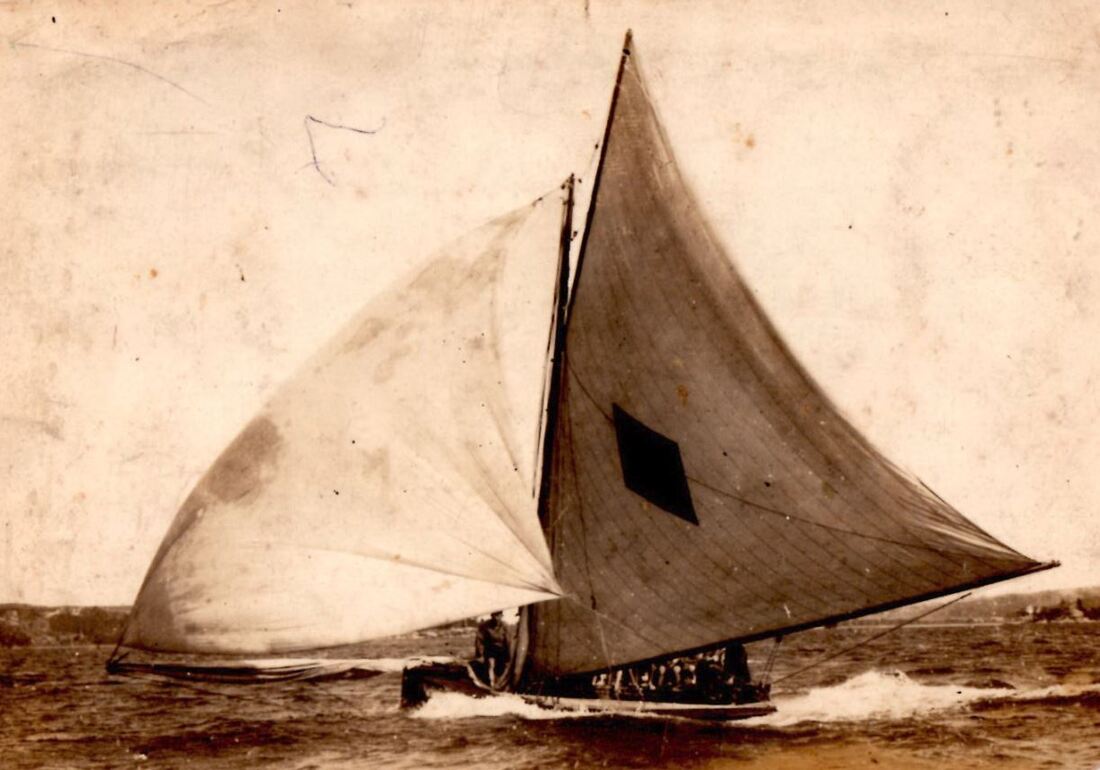
The 18 Foot Skiff EVELYN, seasons 1906 – 1909, 1914 – 1915.
Information and images supplied by Bob Chapman, 12 August 2021. Bob's great-Grandmother was the sister of the Richard (Dick) Green mentioned.
Builder / Owner / Skipper: Richard W. Green (1859 – 1933), shipwright from Greenwich, skiff named after his youngest daughter.
Sail Insignia: Black Diamond, same insignia carried on his previous skiff, the 22ft GUINEVERE that he raced from 1897 to 1904.
Richard W. Green was a 3rd generation Sydney shipwright, his grandfather George Green came to Sydney at age 12 in 1822, sponsored by his aunt & uncle, former convicts Thomas & Charlotte Hyndes who arranged his apprenticeship with boat builder Thomas Day at Cockle Bay. After a 7 year apprenticeship and at age 20 George married, started a family and his boat building business initially based at Cockle Bay, then from Greenwich (ie “Balls Head Bay”, east side of Greenwich) 1836-40, then from Milson’s Point (east side, adjacent to northern Pilon of the Harbour Bridge these days). The family became firmly entrenched on the North side of the harbour over several generations, specifically around Greenwich, Lane Cove, Willoughby and North Sydney.
Richard Green raced the EVELYN from 1906-07, 1907-08 and 1908-09 with the Sydney Sailing Club and Sydney Flying Squadron. The skiff was not entered for the 1909-10 season. In December 1914 the skiff re-appeared in order to compete in the “Patriotic race for 18-footers controlled by the interstate committee” where proceeds would be diverted to various war funds, but with one of Richard’s sons at the helm, Harry Green, better known for his achievements as an accomplished rower. Ie “no fewer than 24 boats answered the call, the latest addition to the fleet being Evelyn, which Dick Green, after a rest of some seasons, had dug out from his shed at Greenwich. The reappearance of the black diamond was welcomed, but Harry Green, who had forsaken the oar for the tiller for the afternoon, found that it is easier to stroke an eight to victory than to manoeuvre an 18-footer into a winning position”.
Harry Green (1889 – 1971) skippered the EVELYN in most (not all) races that were staged in late 1914 -1915 and then for the opening race on 18 September 1915, “Green sailed his best race in Evelyn since that boat’s reappearance“, with the race won by Golding (R. Beashel) 1; then Australian (C. Webb) 2; Kismet (W. Dunn) 3; Evelyn (H. Green) 4; Harry enlisted in the AIF in November 1915, arrived in England in July 1916, then to France, received severe shrapnel wounds in Sept 1917, returned to Sydney January 1918.
Information and images supplied by Bob Chapman, 12 August 2021. Bob's great-Grandmother was the sister of the Richard (Dick) Green mentioned.
Builder / Owner / Skipper: Richard W. Green (1859 – 1933), shipwright from Greenwich, skiff named after his youngest daughter.
Sail Insignia: Black Diamond, same insignia carried on his previous skiff, the 22ft GUINEVERE that he raced from 1897 to 1904.
Richard W. Green was a 3rd generation Sydney shipwright, his grandfather George Green came to Sydney at age 12 in 1822, sponsored by his aunt & uncle, former convicts Thomas & Charlotte Hyndes who arranged his apprenticeship with boat builder Thomas Day at Cockle Bay. After a 7 year apprenticeship and at age 20 George married, started a family and his boat building business initially based at Cockle Bay, then from Greenwich (ie “Balls Head Bay”, east side of Greenwich) 1836-40, then from Milson’s Point (east side, adjacent to northern Pilon of the Harbour Bridge these days). The family became firmly entrenched on the North side of the harbour over several generations, specifically around Greenwich, Lane Cove, Willoughby and North Sydney.
Richard Green raced the EVELYN from 1906-07, 1907-08 and 1908-09 with the Sydney Sailing Club and Sydney Flying Squadron. The skiff was not entered for the 1909-10 season. In December 1914 the skiff re-appeared in order to compete in the “Patriotic race for 18-footers controlled by the interstate committee” where proceeds would be diverted to various war funds, but with one of Richard’s sons at the helm, Harry Green, better known for his achievements as an accomplished rower. Ie “no fewer than 24 boats answered the call, the latest addition to the fleet being Evelyn, which Dick Green, after a rest of some seasons, had dug out from his shed at Greenwich. The reappearance of the black diamond was welcomed, but Harry Green, who had forsaken the oar for the tiller for the afternoon, found that it is easier to stroke an eight to victory than to manoeuvre an 18-footer into a winning position”.
Harry Green (1889 – 1971) skippered the EVELYN in most (not all) races that were staged in late 1914 -1915 and then for the opening race on 18 September 1915, “Green sailed his best race in Evelyn since that boat’s reappearance“, with the race won by Golding (R. Beashel) 1; then Australian (C. Webb) 2; Kismet (W. Dunn) 3; Evelyn (H. Green) 4; Harry enlisted in the AIF in November 1915, arrived in England in July 1916, then to France, received severe shrapnel wounds in Sept 1917, returned to Sydney January 1918.
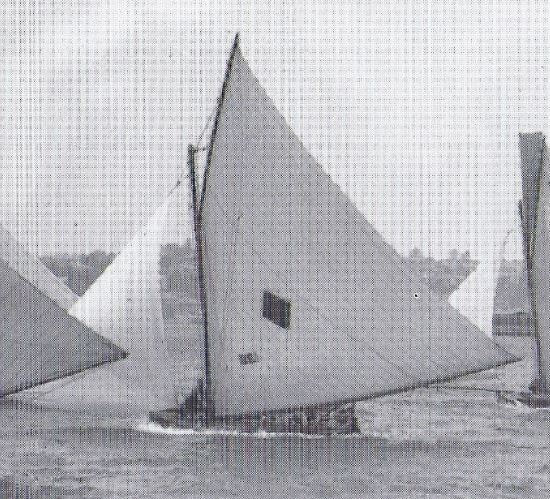
Evelyn about 1907, a Hall photo reproduced in Stannard’s Bluewater Bushmen.
Federal 1898
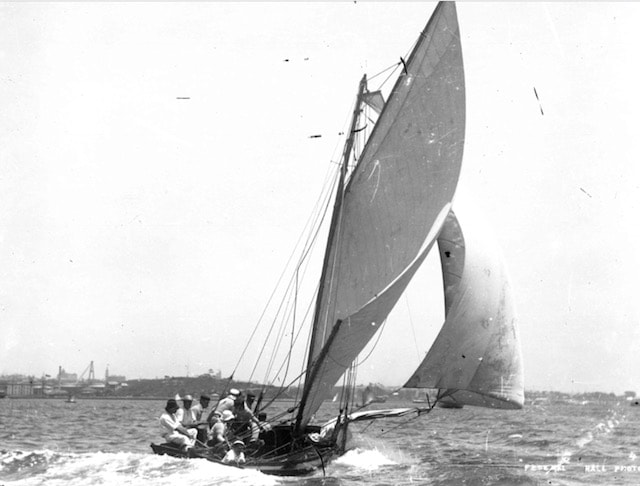
Builder: William Golding* for J.F Herbert of Newcastle.
Known Dimensions: 8'4 1/2" beam over planking, 8'10 1/2" over mouldings, tuck 6'6", depth 2'4". Six inch spring fore and aft. Described as "bigger, more flat-bottomed than Yvonne" (Golding's own boat) and more than a foot beamier.
Keel Spotted Gum, stern knee and sternpost Tea-Tree, planking Cedar, mouldings Ash.
Insignia: Australian Federal Flag (may have been red rather than the later blue).
J.F.Herbert was a Novocastrian who raced Federal with the Port Hunter and Stockton Sailing Club on the Hunter River 100 miles North of Sydney. She started racing there in October 1898 where her chief rival was the Donnelly*-built Ariel. Federal was shipped down to Sydney about twice per season for the first few seasons to compete in the Championships and other races. In her first season she travelled down in early January for the SFS 18'Championship in which she came second with Billy Read* at the helm, and stayed for the Intercolonial racing against Queensland boats in which she came second in the JBSC Challenge race and third in the SFS Championship Challenge in February. She also won the Anniversary Day Regatta race on 26 January. She then returned to Newcastle where her overall results for the season were 2 wins, 2 seconds and 2 thirds. Herbert mostly steered himself when in Newcastle. He also steered when Federal won the Sydney Sailing Club Championship in November 1899 but was unplaced in the JBSC Championship in early December. She always returned to Newcastle for the Newcastle Regatta which was held on New Years Day. Similar activity occurred for the 1900-01 and 1901-02 seasons. During the latter season Herbert sold Federal to W. Arnott who was the owner of Ariel. Arnott steered Federal into second in the SFS 18' Championship in January 1902. He still took her back to Newcastle after each period in Sydney, until on October 1903 he brought her down to Sydney to be housed in George Ellis*'s shed in Duke St Balmain, and George Ellis was often found at the tiller. In the 1905-06 season Federal was bought by Lan Taylor* who had Ellis alter the fin and re-rig her including a full set of new sails by Carter. Taylor who also concurrently owned the 22-footer Keriki sailed both boats with the SFS and SSC and shared the tiller with several other skippers. Federal's winnings for the next few seasons were at the bottom end of the list of registered boats. Her appearances became less regular in the seasons 1907 to 1912, the year that Taylor had Sam Williams build Quibree* for him. He raced Quibree until he sold her in 1919, and then re-conditioned Federal to sail, and won mid-range prize money in the 1919-20 season. In March 1920 Taylor bought Thelma III and re-named her Keriki* and sold Federal to Darwin in August 1921 and after that we lose trace of her.
Taylor ran the Federal boat sheds in Lavender Bay, and seeing I'm ignorant of the dates he started perhaps the boat name was extended to the business. The long periods of inactivity as regards racing may have resulted in Federal being hired out during those periods, as hiring boats was the basis of Taylor's business.
The accompanying photo is from the ANMM's Hall Collection. It is interesting to see that Federal is carrying a masthead spinnaker from the bumpkin as a balloon jib or in modern parlance an asymmetric spinnaker. Note the short spar at the head of the spinnaker which most of the early spinnakers had. It seems it took several years before open boat sailors realised that a spinnaker could set perfectly well with a triangular head.
Known Dimensions: 8'4 1/2" beam over planking, 8'10 1/2" over mouldings, tuck 6'6", depth 2'4". Six inch spring fore and aft. Described as "bigger, more flat-bottomed than Yvonne" (Golding's own boat) and more than a foot beamier.
Keel Spotted Gum, stern knee and sternpost Tea-Tree, planking Cedar, mouldings Ash.
Insignia: Australian Federal Flag (may have been red rather than the later blue).
J.F.Herbert was a Novocastrian who raced Federal with the Port Hunter and Stockton Sailing Club on the Hunter River 100 miles North of Sydney. She started racing there in October 1898 where her chief rival was the Donnelly*-built Ariel. Federal was shipped down to Sydney about twice per season for the first few seasons to compete in the Championships and other races. In her first season she travelled down in early January for the SFS 18'Championship in which she came second with Billy Read* at the helm, and stayed for the Intercolonial racing against Queensland boats in which she came second in the JBSC Challenge race and third in the SFS Championship Challenge in February. She also won the Anniversary Day Regatta race on 26 January. She then returned to Newcastle where her overall results for the season were 2 wins, 2 seconds and 2 thirds. Herbert mostly steered himself when in Newcastle. He also steered when Federal won the Sydney Sailing Club Championship in November 1899 but was unplaced in the JBSC Championship in early December. She always returned to Newcastle for the Newcastle Regatta which was held on New Years Day. Similar activity occurred for the 1900-01 and 1901-02 seasons. During the latter season Herbert sold Federal to W. Arnott who was the owner of Ariel. Arnott steered Federal into second in the SFS 18' Championship in January 1902. He still took her back to Newcastle after each period in Sydney, until on October 1903 he brought her down to Sydney to be housed in George Ellis*'s shed in Duke St Balmain, and George Ellis was often found at the tiller. In the 1905-06 season Federal was bought by Lan Taylor* who had Ellis alter the fin and re-rig her including a full set of new sails by Carter. Taylor who also concurrently owned the 22-footer Keriki sailed both boats with the SFS and SSC and shared the tiller with several other skippers. Federal's winnings for the next few seasons were at the bottom end of the list of registered boats. Her appearances became less regular in the seasons 1907 to 1912, the year that Taylor had Sam Williams build Quibree* for him. He raced Quibree until he sold her in 1919, and then re-conditioned Federal to sail, and won mid-range prize money in the 1919-20 season. In March 1920 Taylor bought Thelma III and re-named her Keriki* and sold Federal to Darwin in August 1921 and after that we lose trace of her.
Taylor ran the Federal boat sheds in Lavender Bay, and seeing I'm ignorant of the dates he started perhaps the boat name was extended to the business. The long periods of inactivity as regards racing may have resulted in Federal being hired out during those periods, as hiring boats was the basis of Taylor's business.
The accompanying photo is from the ANMM's Hall Collection. It is interesting to see that Federal is carrying a masthead spinnaker from the bumpkin as a balloon jib or in modern parlance an asymmetric spinnaker. Note the short spar at the head of the spinnaker which most of the early spinnakers had. It seems it took several years before open boat sailors realised that a spinnaker could set perfectly well with a triangular head.
Florrie II 1922
Builder: Harold "Roley" Collins for Albert Burless.
Insignia: Black Triangle with central gold triangle as Florrie II, black shield with diagonal gold stripe as Florrie A.
Known Dimensions: 17'11" long, 7'10 1/2" beam and 2'7" depth.
The above photo is in the collection of the Sydney Flying Squadron and is of her later incarnation as Florrie A.
The story of Florrie actually starts a bit earlier. In 1918 Mr Albert Burless bought Acme, built by Charlie Dunn in 1906, renamed her Florrie and adopted the sail insignia of a black triangle with a central gold triangle. Burless engaged Les Pont to skipper who steered for two seasons with little success. They won one race towards the end of the first season, and in the second season had no wins and just enough low places to win £14 for the season which was the third least amount in the fleet.
A Boyd and Harold ‘Roley’ Collins had occasional appearances at the tiller in those two seasons, and for the third season (1920-21) Burless engaged Collins to replace Les Pont. They won one heat and Florrie was the only boat to finish in the Anniversary Regatta morning race in January 1921, but remained a long marker in the fleet for two seasons.
Harry Collins was a boatbuilder as well as a skipper. He had built many of the 6-footer fleet and had successfully steered 6 and 10-footers before moving into 18’s where he briefly steered Sunny South before taking over Florrie. In August 1922 it was announced that Burless had commissioned Collins to build a new boat for the season to be known as Florrie II, which he did in quick time, being ready for the first race on 24 September....well almost, they arrived at the start line too late to compete! And then they arrived late the next week too, but were able to start but finished second last. They managed a few places in the rest of the season and took home £29/10/- for the season which was at the lower end of mid-field.
They had a better season in 1922-23, even gaining fastest time in one race showing that the boat had some promise. Their third season was described as a failure, and even though they won a double (heat and final) in the next season (1925-26) as well as one long course race they generally remained a long marker. In 1926-27 they won the first running of the Queen of the Harbour race with Miss Gourlie as crew, and the following season gained at least one win and several places which brought them mid-field in handicap for a period, and they won the sixth most prize money that season. Florrie’s fortunes fluctuated in a similar manner for the next few seasons, their best result being a 4th in the State Championship in January 1933, a rare event for a long marker.
Insignia: Black Triangle with central gold triangle as Florrie II, black shield with diagonal gold stripe as Florrie A.
Known Dimensions: 17'11" long, 7'10 1/2" beam and 2'7" depth.
The above photo is in the collection of the Sydney Flying Squadron and is of her later incarnation as Florrie A.
The story of Florrie actually starts a bit earlier. In 1918 Mr Albert Burless bought Acme, built by Charlie Dunn in 1906, renamed her Florrie and adopted the sail insignia of a black triangle with a central gold triangle. Burless engaged Les Pont to skipper who steered for two seasons with little success. They won one race towards the end of the first season, and in the second season had no wins and just enough low places to win £14 for the season which was the third least amount in the fleet.
A Boyd and Harold ‘Roley’ Collins had occasional appearances at the tiller in those two seasons, and for the third season (1920-21) Burless engaged Collins to replace Les Pont. They won one heat and Florrie was the only boat to finish in the Anniversary Regatta morning race in January 1921, but remained a long marker in the fleet for two seasons.
Harry Collins was a boatbuilder as well as a skipper. He had built many of the 6-footer fleet and had successfully steered 6 and 10-footers before moving into 18’s where he briefly steered Sunny South before taking over Florrie. In August 1922 it was announced that Burless had commissioned Collins to build a new boat for the season to be known as Florrie II, which he did in quick time, being ready for the first race on 24 September....well almost, they arrived at the start line too late to compete! And then they arrived late the next week too, but were able to start but finished second last. They managed a few places in the rest of the season and took home £29/10/- for the season which was at the lower end of mid-field.
They had a better season in 1922-23, even gaining fastest time in one race showing that the boat had some promise. Their third season was described as a failure, and even though they won a double (heat and final) in the next season (1925-26) as well as one long course race they generally remained a long marker. In 1926-27 they won the first running of the Queen of the Harbour race with Miss Gourlie as crew, and the following season gained at least one win and several places which brought them mid-field in handicap for a period, and they won the sixth most prize money that season. Florrie’s fortunes fluctuated in a similar manner for the next few seasons, their best result being a 4th in the State Championship in January 1933, a rare event for a long marker.
Florrie II collided with the yacht Wanderer at the Anniversary Day Regatta 26 January 1930. From Jeff Toghill's book Sydney Harbour of Yesteryear. There seems to be some bailing going on. The boat was repaired and resumed racing on 8 February.
For the 1933-34 season Roley Collins was replaced at the tiller by Paddy Pyne who had made his name in the Birchgrove 14-footers. Pyne managed a win and a few places in each of the next two seasons and the handicap fluctuated between 2 1/2 minutes (mid-field) and 5 minutes (long marker). He won two races in the third season (1935-36) but owner Burless decided to retire the boat after that season.
The boat may have taken a while to sell. There was a rumour in September 1937 that Florrie II was to be recommissioned but nothing came of it until in November 1938 she was purchased by Bill Anderson an official of the Sydney Flying Squadron and publisher of the weekly programme and recommissioned as Florrie A. Anderson changed the sail insignia to a black shield with a diagonal gold stripe, and engaged Harry Finch to steer. In their first three races they gained a 3rd, a 4th and a win. Anderson appears to have tried to find mentors for young Harry Finch, enticing Chris Webb out of retirement to steer in the race on 25 March 1939 on the understanding he would talk through every decision he made with Finch and the crew. At the beginning of the next season he engaged the successful female 12-footer skipper Kath Farr to advise Finch on tactics (Kath Farr became an early member of the AHSSA in the 1990’s and followed the Association’s activities until her death about 15 years ago). But Anderson became unhappy with Finch after a disqualification for hitting the Clark Island mark in early October 1939, and a collision with a moored boat after which he did not stop two weeks later, and sacked him. The very next day he announced he had engaged WC ‘Trappy’ Duncan to steer. Duncan was at the tail end of a long successful career in which he had won 20 Championships, his most recent successes being in Tangalooma in which he had 7 wins in one season.
For the 1933-34 season Roley Collins was replaced at the tiller by Paddy Pyne who had made his name in the Birchgrove 14-footers. Pyne managed a win and a few places in each of the next two seasons and the handicap fluctuated between 2 1/2 minutes (mid-field) and 5 minutes (long marker). He won two races in the third season (1935-36) but owner Burless decided to retire the boat after that season.
The boat may have taken a while to sell. There was a rumour in September 1937 that Florrie II was to be recommissioned but nothing came of it until in November 1938 she was purchased by Bill Anderson an official of the Sydney Flying Squadron and publisher of the weekly programme and recommissioned as Florrie A. Anderson changed the sail insignia to a black shield with a diagonal gold stripe, and engaged Harry Finch to steer. In their first three races they gained a 3rd, a 4th and a win. Anderson appears to have tried to find mentors for young Harry Finch, enticing Chris Webb out of retirement to steer in the race on 25 March 1939 on the understanding he would talk through every decision he made with Finch and the crew. At the beginning of the next season he engaged the successful female 12-footer skipper Kath Farr to advise Finch on tactics (Kath Farr became an early member of the AHSSA in the 1990’s and followed the Association’s activities until her death about 15 years ago). But Anderson became unhappy with Finch after a disqualification for hitting the Clark Island mark in early October 1939, and a collision with a moored boat after which he did not stop two weeks later, and sacked him. The very next day he announced he had engaged WC ‘Trappy’ Duncan to steer. Duncan was at the tail end of a long successful career in which he had won 20 Championships, his most recent successes being in Tangalooma in which he had 7 wins in one season.
Trappy Duncan and the crew of Florrie A. Trappy is 7th from left in front, owner Bill Anderson is far right in the top row. Sydney Flying Squadron Collection.
Duncan opened his account with a 5th off 2 1/2 minutes on 28 November 1939 and followed it up by winning the SFS Club Championship the following week in a hard weather race. He proved it was no fluke by winning the State Championship in light weather in January 1940. Two more wins in handicap races brought Florrie A in to scratch before the end of the season. Success continued in the 1940-41 season with Duncan defending his title by winning the State Championship again.
Duncan opened his account with a 5th off 2 1/2 minutes on 28 November 1939 and followed it up by winning the SFS Club Championship the following week in a hard weather race. He proved it was no fluke by winning the State Championship in light weather in January 1940. Two more wins in handicap races brought Florrie A in to scratch before the end of the season. Success continued in the 1940-41 season with Duncan defending his title by winning the State Championship again.
Florrie A was the first 18-footer to use a multi-coloured spinnaker. This picture from the opening race 21 September 1940 is in the collection of the Sydney Flying Squadron.
Duncan injured his leg (at work it was reported, though he was over 65) and was unable to steer for the first half of the 1941-42 season. Other skippers appeared, Sam Monkhouse, sailmaker Harry West and even Harry Collins again, but there was little success.
Florrie A had only a few races at the start of the 1942-43 season without success. In November owner Bill Anderson retired the boat, mainly because of manpower problems he said, due to the War. He purchased the 10-year old Aberdare and shipped her down from Brisbane and engaged 1938 World Champion Bert Swinbourne to steer. Anderson already owned two other 18-footers, Reliance and Ardath and went on to own several more for a total of 10 boats through to the early 1960’s. He was a great mentor to skippers as well as serving on the executive committee of the Sydney Flying Squadron for 30 years. A heat of the replica 18’s Australian Historical 18-Footers Championship is named after him (information on Bill Anderson and the accompanying photos were rounded up by John Steamer Stanley).
Duncan injured his leg (at work it was reported, though he was over 65) and was unable to steer for the first half of the 1941-42 season. Other skippers appeared, Sam Monkhouse, sailmaker Harry West and even Harry Collins again, but there was little success.
Florrie A had only a few races at the start of the 1942-43 season without success. In November owner Bill Anderson retired the boat, mainly because of manpower problems he said, due to the War. He purchased the 10-year old Aberdare and shipped her down from Brisbane and engaged 1938 World Champion Bert Swinbourne to steer. Anderson already owned two other 18-footers, Reliance and Ardath and went on to own several more for a total of 10 boats through to the early 1960’s. He was a great mentor to skippers as well as serving on the executive committee of the Sydney Flying Squadron for 30 years. A heat of the replica 18’s Australian Historical 18-Footers Championship is named after him (information on Bill Anderson and the accompanying photos were rounded up by John Steamer Stanley).
Flying Fish I and II, 1938 and 1949
Founder of the Sydney Flying Squadron Mark Foy was always a generous supporter of 18-footer racing but after his failure to get Southerly Buster to mount a challenge to the British (see The Anglo-Australian Shield on the YARNS Page) he didn’t campaign a boat with the SFS for many years. In fact he never owned an 18-footer until he bought a boat built by Norm Wright in Brisbane in 1937 as Joyce, and renamed it Flying Fish after his 1890’s catamaran (see Mark Foy's Catamaran 1894 also on the YARNS Page). He began to campaign it with the Squadron under Ben Roff who had four 12-foot skiff Australian titles with his boat Schemer (see 12-Footers Page). Flying Fish was 17’11 1/2” by 7’0 1/2” with no heel and conformed to the lighter boat model that had split the clubs in 1935. The SFS had begrudgingly allowed the lighter boats in from 1937. Foy used the red Maltese Cross insignia that he had used on the catamaran.
Ben Roff got off to a good start, winning the SFS Championship race in late November 1938 clearly beating the 2 favorites Britannia and Yendys. They had only one other win that season, and only one in the following season. Ben Roff joined the AIF in May 1940, and Mark Foy engaged a young Ben Barnett (son of Sid and brother of the late Sid Jnr) to steer in the 1940-41 season. They won several races in the next few seasons, and came 2nd in the SFS Championship in 1941.
In the 1942-43 season Ben Barnett was apparently not available early in the season, and the boat was steered without noticeable success by several skippers including a couple of races with Norm Blackman who had just retired Yendys, and at least one with veteran George Drysdale. In early 1943 Ben Barnett returned to the tiller, with his father Sid as frd hand. The boat had gone out to the limit mark of 6 minutes under the guest skippers, but Ben won a couple of races towards the end of the season, but this fifth season was to be his last.
George Pearce appeared at the tiller for the next two seasons (1943-44 and 1944-45) and won and placed in enough races to keep the boat in the middle of the field around 3 minutes. Performances included a win in a race in February 1944 when Aberdare (Bert Swinbourne) was blamed by Desdemona for capsizing them, and the crew of Desdemona boarded Aberdare and were only repelled with considerable force! Their best results were in late 1944 when they won a handicap race and also gained fastest time, and gained 2nd in the SFS Championship. George Pearce was a busy boy in those days, skippering Flying Fish with the SFS on Saturdays and Malvina with the League on Sundays.
In the 1942-43 season Ben Barnett was apparently not available early in the season, and the boat was steered without noticeable success by several skippers including a couple of races with Norm Blackman who had just retired Yendys, and at least one with veteran George Drysdale. In early 1943 Ben Barnett returned to the tiller, with his father Sid as frd hand. The boat had gone out to the limit mark of 6 minutes under the guest skippers, but Ben won a couple of races towards the end of the season, but this fifth season was to be his last.
George Pearce appeared at the tiller for the next two seasons (1943-44 and 1944-45) and won and placed in enough races to keep the boat in the middle of the field around 3 minutes. Performances included a win in a race in February 1944 when Aberdare (Bert Swinbourne) was blamed by Desdemona for capsizing them, and the crew of Desdemona boarded Aberdare and were only repelled with considerable force! Their best results were in late 1944 when they won a handicap race and also gained fastest time, and gained 2nd in the SFS Championship. George Pearce was a busy boy in those days, skippering Flying Fish with the SFS on Saturdays and Malvina with the League on Sundays.
Both images are of Flying Fish II on a dull day on the Harbour between the 1949-50 season and the 1951-52 season. I haven’t yet found a good image of Flying Fish I. John Stanley Collection.
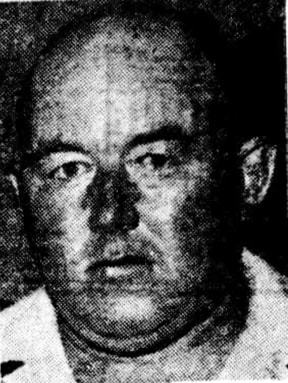
In the 1946-47 season Bob Carroll began to steer. Bob had been a successful 16-footer skipper on Botany Bay and at Drummoyne. He gained 3rd and 4th places in Championships that season and featured enough to be selected to be one of 5 NSW boats to go to Brisbane for the 1947 Australian Championship, which was won by Lance Watts in Culex II and completely dominated by Queensland boats, all of which were new 6’-beamers.
Mark Foy saw the writing on the wall, and ordered a 6’-beam boat from Lance Watts, which he named Flying Fish II and had Bob Carroll campaign it at the SFS from January 1949. They won several races in the rest of the season and the start of the next (with Bob Lundie as frd hand) and were again chosen as one of five boats to represent NSW in Brisbane in January 1950. Flying Fish II was 6th overall (there were 3 heats), but the Queenslanders still dominated with Lance Watts winning again, with Culex III. A few weeks after returning from Brisbane Flying Fish II won the NSW Championship with Bill Barnett in Myra 2nd.
Mark Foy died in November 1950 but Bob Carroll kept the boat racing with moderate success. They were again selected as one of six NSW boats in January 1951 for the Championships in Sydney, famously won by Bill Barnett in Myra Too, but didn’t feature. Nor did they feature in the World’s Championship in February, also won by Myra Too. And in spite of a couple of wins and placings in the 1951-52 season and selection for Brisbane in 1952 they didn’t feature there either.
Flying Fish II appears not to have raced in late 1952, but in January 1953 Bob began racing the boat at the League. I’m not sure how Mark Foy would have felt about that, but then he was dead. Bob sailed at the League for the rest of that season and the 1953-54 season, but the boat no longer appears after that, and Bob appears as the skipper of Minawatta at the League.
Bob Carroll, a big bloke at 18 stone (114 kg)
Mark Foy saw the writing on the wall, and ordered a 6’-beam boat from Lance Watts, which he named Flying Fish II and had Bob Carroll campaign it at the SFS from January 1949. They won several races in the rest of the season and the start of the next (with Bob Lundie as frd hand) and were again chosen as one of five boats to represent NSW in Brisbane in January 1950. Flying Fish II was 6th overall (there were 3 heats), but the Queenslanders still dominated with Lance Watts winning again, with Culex III. A few weeks after returning from Brisbane Flying Fish II won the NSW Championship with Bill Barnett in Myra 2nd.
Mark Foy died in November 1950 but Bob Carroll kept the boat racing with moderate success. They were again selected as one of six NSW boats in January 1951 for the Championships in Sydney, famously won by Bill Barnett in Myra Too, but didn’t feature. Nor did they feature in the World’s Championship in February, also won by Myra Too. And in spite of a couple of wins and placings in the 1951-52 season and selection for Brisbane in 1952 they didn’t feature there either.
Flying Fish II appears not to have raced in late 1952, but in January 1953 Bob began racing the boat at the League. I’m not sure how Mark Foy would have felt about that, but then he was dead. Bob sailed at the League for the rest of that season and the 1953-54 season, but the boat no longer appears after that, and Bob appears as the skipper of Minawatta at the League.
Bob Carroll, a big bloke at 18 stone (114 kg)
Furious 1924
Builder: Tom Phillips of Balmain for Robert Gourlay.
Known Dimensions: 17’11” x 7’3” beam, 2’4” depth. The boat had no heel or skeg. It was once referred to as a snub, meaning a small bow transom but there are no other references supporting that and some contrary references so I assume it had a stem. The fin (centre board) was described as 7’ x 3’ cut square, meaning I guess it was not tapered at all.
Insignia: Red triangle with white ball.
Known Dimensions: 17’11” x 7’3” beam, 2’4” depth. The boat had no heel or skeg. It was once referred to as a snub, meaning a small bow transom but there are no other references supporting that and some contrary references so I assume it had a stem. The fin (centre board) was described as 7’ x 3’ cut square, meaning I guess it was not tapered at all.
Insignia: Red triangle with white ball.
Furious was one of the regulars in the fleet for about 15 seasons, never winning a championship or even coming close except in the Port Jackson Championship in 1937 when they gained 3rd under guest skipper Tony Russell. They were always one of the long markers but they won a fair share of handicap races and were generally either side of mid-field in earnings each season.
Owner Bob Gourlay had been a 16’ skiff sailor until he commissioned Tom Phillips to build Furious. Gourlay mostly steered the boat himself, but occasionally gave the helm to W Young who may have been in the regular crew, and occasionally to Horrie Baulkwell who had come out of the Balmain 10-footers.
Owner Bob Gourlay had been a 16’ skiff sailor until he commissioned Tom Phillips to build Furious. Gourlay mostly steered the boat himself, but occasionally gave the helm to W Young who may have been in the regular crew, and occasionally to Horrie Baulkwell who had come out of the Balmain 10-footers.
Their best season was 1934-35 when they won £57, 4th on the list of winners. They had the occasional bad luck story, with several capsizes including one when leading, a broken tabernacle and a broken mast in their career.
At the end of their fourth season in March 1928, Bob Gourlay listed the boat for sale but there were no takers and he sailed her for a further 7 seasons. The boat did not sail in the 1935-36 season, and she may have changed hands as Gourlay does not appear to have steered it beyond 1934-35. Joe Jackson, H Griffiths and the legendary Tony Russell shared the tiller for 3 seasons.
At the end of their fourth season in March 1928, Bob Gourlay listed the boat for sale but there were no takers and he sailed her for a further 7 seasons. The boat did not sail in the 1935-36 season, and she may have changed hands as Gourlay does not appear to have steered it beyond 1934-35. Joe Jackson, H Griffiths and the legendary Tony Russell shared the tiller for 3 seasons.
In the 1939-40 season the name was changed to Reliance she began to be steered by Eastern Suburbs footballer Joe Pearce, who won a race in November and was leading by 5 minutes in another on 27 January 1940 when they hit the Shark mark and were disqualified. The very next week, 3 February Kiwi collided with Reliance and holed her badly. She was deemed not worth repairing and the boat was withdrawn from racing.
All photos collected by John Stanley.
All photos collected by John Stanley.
Gloria 1926
Built by Charlie Dunn for Charlie Henry in 1921.
Insignia: Blue pennant with white centre.
Known Dimensions: Beam 7’3”, 24 1/2” deep, tuck 5’4” by 12”, heel 11”, spring 6” each end. Hollow garboards, 1/2” cedar planking, Timbers Spotted Gum 1 1/4” wide, 6” spacing.
Gloria was launched as Endeavour in and raced under that name for several seasons (see entry under Endeavour). In 1926 Charlie Henry changed the name to Gloria and the insignia to a blue pennant with white centre (essentially the SFS burgee). In early 1927 part of the way through their first season Charlie Henry engaged Bill Edney to steer which he did for the next 10 seasons, and owner Charlie Henry set the extras. They reduced their handicap to being just off scratch in the second season. Charlie Henry resumed steering in the 1936/37 season and the handicap slowly crept out again.
In 1939 Henry sold the boat to FJ Denham who engaged the 22 year old Bish Bolton to steer which he did with moderate success in the 1940/41 season as well. The boat was retired at the end of that season after a 20-season career.
The above photo from the Hall Collection shows Gloria carrying an ill-fitting ringtail, either designed for a smaller rig or borrowed from another boat. The image is probably from the late 1920s as she is carrying a tops'l, a sail that was rarely seen on 18-footers after the early 1930s.
Insignia: Blue pennant with white centre.
Known Dimensions: Beam 7’3”, 24 1/2” deep, tuck 5’4” by 12”, heel 11”, spring 6” each end. Hollow garboards, 1/2” cedar planking, Timbers Spotted Gum 1 1/4” wide, 6” spacing.
Gloria was launched as Endeavour in and raced under that name for several seasons (see entry under Endeavour). In 1926 Charlie Henry changed the name to Gloria and the insignia to a blue pennant with white centre (essentially the SFS burgee). In early 1927 part of the way through their first season Charlie Henry engaged Bill Edney to steer which he did for the next 10 seasons, and owner Charlie Henry set the extras. They reduced their handicap to being just off scratch in the second season. Charlie Henry resumed steering in the 1936/37 season and the handicap slowly crept out again.
In 1939 Henry sold the boat to FJ Denham who engaged the 22 year old Bish Bolton to steer which he did with moderate success in the 1940/41 season as well. The boat was retired at the end of that season after a 20-season career.
The above photo from the Hall Collection shows Gloria carrying an ill-fitting ringtail, either designed for a smaller rig or borrowed from another boat. The image is probably from the late 1920s as she is carrying a tops'l, a sail that was rarely seen on 18-footers after the early 1930s.
Golding 1910
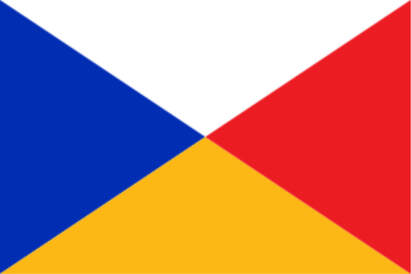
The above photo is one of 8 images in two frames donated by Sydney Flying Squadron founder Mark Foy to Perth Flying Squadron in 1911 which have been returned to the SFS. Note the waterfall, a relatively rare feature on Sydney 18's.
Builder: Billy Golding
Insignia: P&O flag
Known dimensions: 8’10 3/4” beam, one of the beamiest, 2’3” deep.
Named after the builder, a feature also found on Donnelly (1898), the owner T Sherley steered the boat himself for the first season after launching in late November 1910. He managed a couple of placings in heats and a final and won £9 from the 18 races entered. Golding was sent to Brisbane with Advance and Arthur in early 1911 to represent NSW but the opinion at the time was that they were not the best three boats in Sydney. The Championship was won by Queensland boat Pastime (see the story of Pastime listed alphabetically on this Page), but Golding brought back £17/1/- from a win and place in other races during the carnival.
Sherley began steering when the 1911-12 season commenced, but WJ (Billy) Duncan became available in October after Vision the boat he had been steering was damaged on capsizing. However he was disqualified in his only appearance at the tiller. Chris Webb then became available as Australian owner Watts Ford was disappointed with her recent form and decided to retire her. While awaiting the building of the third Australian Ford came to an arrangement with Sherley to take over Golding for the rest of the season with Webb steering. Webb was immediately put on scratch (Golding had been on 1 1/2 minutes) and managed a couple of placings in consecutive races in November, then was 3rd in the SFS Championship race on 2 December. A heat win and several places plus a 2nd in the SSC Championship and a win in the State Championship (there are two images of the start of this race on the FLEETS Page on the website) resulted in the boat winning £59 for the season.
Builder: Billy Golding
Insignia: P&O flag
Known dimensions: 8’10 3/4” beam, one of the beamiest, 2’3” deep.
Named after the builder, a feature also found on Donnelly (1898), the owner T Sherley steered the boat himself for the first season after launching in late November 1910. He managed a couple of placings in heats and a final and won £9 from the 18 races entered. Golding was sent to Brisbane with Advance and Arthur in early 1911 to represent NSW but the opinion at the time was that they were not the best three boats in Sydney. The Championship was won by Queensland boat Pastime (see the story of Pastime listed alphabetically on this Page), but Golding brought back £17/1/- from a win and place in other races during the carnival.
Sherley began steering when the 1911-12 season commenced, but WJ (Billy) Duncan became available in October after Vision the boat he had been steering was damaged on capsizing. However he was disqualified in his only appearance at the tiller. Chris Webb then became available as Australian owner Watts Ford was disappointed with her recent form and decided to retire her. While awaiting the building of the third Australian Ford came to an arrangement with Sherley to take over Golding for the rest of the season with Webb steering. Webb was immediately put on scratch (Golding had been on 1 1/2 minutes) and managed a couple of placings in consecutive races in November, then was 3rd in the SFS Championship race on 2 December. A heat win and several places plus a 2nd in the SSC Championship and a win in the State Championship (there are two images of the start of this race on the FLEETS Page on the website) resulted in the boat winning £59 for the season.
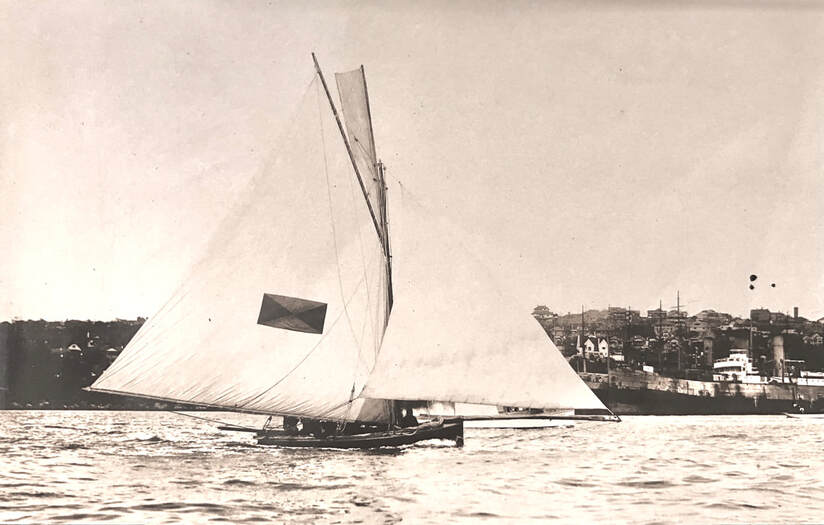
Golding working upwind. Harry Thompson collection, SFS
Sherley resumed steering for the 1912-13 season but head-hunted Jack Smith to steer at least once. Then in January 1913 he secured the services of Billy (WJ) Duncan again and he managed a couple of wins and several placings in the rest of the season. The racing however was dominated by two new boats, Kismet and Australian (III).
Golding was sold in the winter of 1913 to Dick (Rocko) Beashel of the famous family of at least 5 generations of champion sailors up to the present. They won only one heat, but had enough placings to finish the season mid-field in earnings, off a relatively low handicap. The best result was a 3rd in the State Championship.
A new set of sails for the 1914-15 season led to little improvement, but they won a double, heat and final in Feb 1915 and again finished mid-field in earnings. They won the opening race of the 1915-16 season and gained enough placings to finish 6th on the table of earnings for the season. The form slumped a bit in the 1916-17 season but they won a heat and a final in March.
Their best results were in the 1917-18 season when they were 4th in the SSC Championship and won the State Championship! The next three seasons saw them slipping down the list of prizewinners but they were placed enough times to stop their handicap from creeping out too far (they were always closer to scratch than to the limit). Their last three seasons were a little better, with a few heat and finals wins and enough placings to finish around 10th on the list of prizewinners, but placings in Championship races eluded them. Rocko Beashel sold Golding to club official JJ Watt in 1923. Watt renamed the boat Lifesaver and under this name continued her career with similar moderate success until 1927 when Watt had Charley Hayes build Arawatta and the blue circle logo he had used on Lifesaver changed over to Arawatta.
Golding was sold in the winter of 1913 to Dick (Rocko) Beashel of the famous family of at least 5 generations of champion sailors up to the present. They won only one heat, but had enough placings to finish the season mid-field in earnings, off a relatively low handicap. The best result was a 3rd in the State Championship.
A new set of sails for the 1914-15 season led to little improvement, but they won a double, heat and final in Feb 1915 and again finished mid-field in earnings. They won the opening race of the 1915-16 season and gained enough placings to finish 6th on the table of earnings for the season. The form slumped a bit in the 1916-17 season but they won a heat and a final in March.
Their best results were in the 1917-18 season when they were 4th in the SSC Championship and won the State Championship! The next three seasons saw them slipping down the list of prizewinners but they were placed enough times to stop their handicap from creeping out too far (they were always closer to scratch than to the limit). Their last three seasons were a little better, with a few heat and finals wins and enough placings to finish around 10th on the list of prizewinners, but placings in Championship races eluded them. Rocko Beashel sold Golding to club official JJ Watt in 1923. Watt renamed the boat Lifesaver and under this name continued her career with similar moderate success until 1927 when Watt had Charley Hayes build Arawatta and the blue circle logo he had used on Lifesaver changed over to Arawatta.
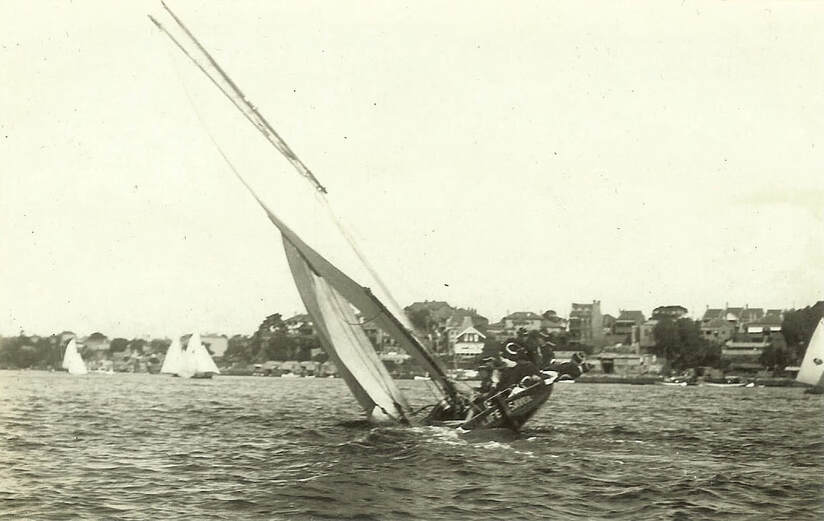
This image of the Golding after her name change to Lifesaver shows how beamy she was. John Stanley collection.
H.C.Press II 1921
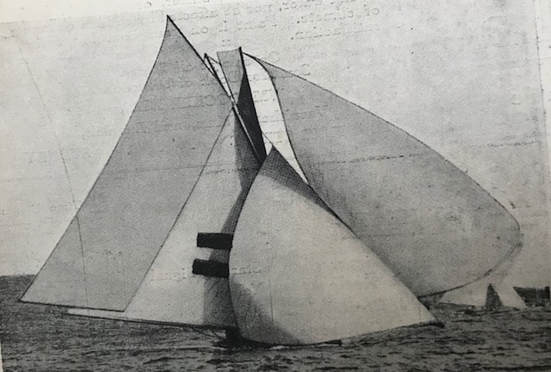
H.C.Press II was the second in a long line of boats, ten of that name built by George Press* (see BOATBUILDERS Page) between 1913 and 1953.
Builder: George Press at the family business boatshed at Audley in the Royal National Park.
Known dimensions: Beam 7'6", depth amidships 25 1/2", bow 31", aft 29", keel 7", tuck 5'5" x 21". Fair rise of floors, more flare on boat than HCP I. Forward deck 5" longer than on HCP I.
Planking 7/16" Cedar, Cedar deck, timbers Spotted Gum 1 1/8" x 1/2".
Sail Insignia: Two red bars.
H.C.Press II was one of the highest prizewinners of all 18-footers and won more Championships (Club, State and National) than any other boat. It helped that Chris Webb steered it for 8 seasons, but George Press steered it himself for four seasons and still won several Championships.
H.C.Press II made its first appearance on 24 September 1921 on scratch and managed third under George Press. He won the SFS Championship race in November and was selected to travel to Perth for the Australian Championship in January 1922 where he gained a third behind Mele Bilo and Kismet*.
Chris Webb took over the tiller in November 1922 for the SFS Championship (after 8 years absence from sailing) and got third. George Press moved to the mainsheet. Webb stayed as regular skipper and kept the boat on scratch. The combination were Australian Champions (in Brisbane) in 1923-24, SFS and Australian Champions in 1924-25 and won record prize money of 201 pounds that season.
In 1925 George press built a new boat, H.C.Press III, a snub design which Webb and the crew moved over to for the first few races in the 1925-26 season, but it proved to be not to their liking and by October they changed back to H.C.Press II. They won the State Championship in February 1926.
In January 1926 they won the Australian Championship again, this time in Sydney. They were again the biggest prizewinner in the fleet with 144 pounds.
In February 1928 George Press complained that the handicapping penalised his boat too much and hinted he might sell the boat. He didn't, and the boat still collected the biggest pile of prize money that year so his argument seemed to be a bit weak. The boat still won several championship races that year and the next, but was beaten in the State Championship in February 1929 by Defiance (see above listing). The handicapping still upset George however, and even though he still topped the prize winners that season he withdrew the boat from the last three races of the season in protest and managed to get the handicapper replaced.
They started in the 1929-30 season, but in the first Championship of the season, the SFS Championship in November 1929 H.C.Press II was beaten into third by Wee Georgie Robinson* in Britannia*. In the next week's handicap race Britannia was put on scratch and Webb was pushed out to 1/2 a minute, but he held back and started at the same time as Britannia which upset many punters. It became quite a talking point, with Webb reputed to have said that he would give the game up if anyone had to give him a start, but everyone eventually settled down and Webb was often not on scratch from then on. Britannia beat H.C.Press II again in the February 1930 State Championship (in fact they were unplaced!).
Webb decided not to sail the boat in the 1930-31 season and moved over to Lan Taylor's* Keriki. George press steered and still managed to win a Championship race that season and get the boat back on scratch. George steered again in 1931-32 with Webb steering Keriki occasionally (mostly in Championships).
Webb made a few appearances steering H.C.Press II in the 1932-33 season but Press mostly steered. In the January 1933 NSW Championship Sid Barnett steered Argo to victory and Webb was fifth in H.C.Press II! This was a surprise as Argo was the re-named snub-built H.C.Press III! Another snub Charlie Hayes'* Arawatta won the Australian Championship in February 1933, and George Press retired H.C.Press II at the end of that season and built a narrower, lighter boat for the 1933-34 season, H.C.Press IV, which has its own role in the history of 18-footer racing.
Builder: George Press at the family business boatshed at Audley in the Royal National Park.
Known dimensions: Beam 7'6", depth amidships 25 1/2", bow 31", aft 29", keel 7", tuck 5'5" x 21". Fair rise of floors, more flare on boat than HCP I. Forward deck 5" longer than on HCP I.
Planking 7/16" Cedar, Cedar deck, timbers Spotted Gum 1 1/8" x 1/2".
Sail Insignia: Two red bars.
H.C.Press II was one of the highest prizewinners of all 18-footers and won more Championships (Club, State and National) than any other boat. It helped that Chris Webb steered it for 8 seasons, but George Press steered it himself for four seasons and still won several Championships.
H.C.Press II made its first appearance on 24 September 1921 on scratch and managed third under George Press. He won the SFS Championship race in November and was selected to travel to Perth for the Australian Championship in January 1922 where he gained a third behind Mele Bilo and Kismet*.
Chris Webb took over the tiller in November 1922 for the SFS Championship (after 8 years absence from sailing) and got third. George Press moved to the mainsheet. Webb stayed as regular skipper and kept the boat on scratch. The combination were Australian Champions (in Brisbane) in 1923-24, SFS and Australian Champions in 1924-25 and won record prize money of 201 pounds that season.
In 1925 George press built a new boat, H.C.Press III, a snub design which Webb and the crew moved over to for the first few races in the 1925-26 season, but it proved to be not to their liking and by October they changed back to H.C.Press II. They won the State Championship in February 1926.
In January 1926 they won the Australian Championship again, this time in Sydney. They were again the biggest prizewinner in the fleet with 144 pounds.
In February 1928 George Press complained that the handicapping penalised his boat too much and hinted he might sell the boat. He didn't, and the boat still collected the biggest pile of prize money that year so his argument seemed to be a bit weak. The boat still won several championship races that year and the next, but was beaten in the State Championship in February 1929 by Defiance (see above listing). The handicapping still upset George however, and even though he still topped the prize winners that season he withdrew the boat from the last three races of the season in protest and managed to get the handicapper replaced.
They started in the 1929-30 season, but in the first Championship of the season, the SFS Championship in November 1929 H.C.Press II was beaten into third by Wee Georgie Robinson* in Britannia*. In the next week's handicap race Britannia was put on scratch and Webb was pushed out to 1/2 a minute, but he held back and started at the same time as Britannia which upset many punters. It became quite a talking point, with Webb reputed to have said that he would give the game up if anyone had to give him a start, but everyone eventually settled down and Webb was often not on scratch from then on. Britannia beat H.C.Press II again in the February 1930 State Championship (in fact they were unplaced!).
Webb decided not to sail the boat in the 1930-31 season and moved over to Lan Taylor's* Keriki. George press steered and still managed to win a Championship race that season and get the boat back on scratch. George steered again in 1931-32 with Webb steering Keriki occasionally (mostly in Championships).
Webb made a few appearances steering H.C.Press II in the 1932-33 season but Press mostly steered. In the January 1933 NSW Championship Sid Barnett steered Argo to victory and Webb was fifth in H.C.Press II! This was a surprise as Argo was the re-named snub-built H.C.Press III! Another snub Charlie Hayes'* Arawatta won the Australian Championship in February 1933, and George Press retired H.C.Press II at the end of that season and built a narrower, lighter boat for the 1933-34 season, H.C.Press IV, which has its own role in the history of 18-footer racing.
A nice closeup shot of HC PRESS II from the Hall Collection at the ANMM.
H.C.Press III 1925
H.C.Press III was a snub design built by George Press in 1925, with a beam of 7' and a depth of 2'6". Built at the family boatshed at Audley in the National Park, she was intended as a replacement for HCP III which had been a champion boat since 1921, mostly under Chris Webb. The team started the 1925-26 season racing HCP III but without much success and after the first few races they re-rigged HCP II and sailed her again until 1933.
H.C.Press III sat in the shed for years, but was sold in 1932 and re-named Argo. She surprised many by beating H.C.Press II in the January 1933 NSW Championship with Sid Barnett at the tiller. Webb in HCP II was fifth. She also won another Championship, the Bradleys Head Championship in February 1933.
The boat and crew raced a second season in 1933-34 but never regained that height, and was sold in June 1934 and re-named Shamrock.
H.C.Press III sat in the shed for years, but was sold in 1932 and re-named Argo. She surprised many by beating H.C.Press II in the January 1933 NSW Championship with Sid Barnett at the tiller. Webb in HCP II was fifth. She also won another Championship, the Bradleys Head Championship in February 1933.
The boat and crew raced a second season in 1933-34 but never regained that height, and was sold in June 1934 and re-named Shamrock.
H.C.Press IV 1933
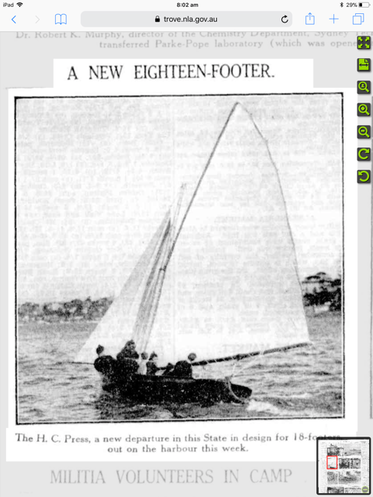
Builder: George Press
Known dimensions: 17'11 3/4" x 7'0 1/4" x 2'0 1/4". Spring 6 1/2" for'd, 8" aft. Tuck 5'.
Planking 1/4" Cedar, ribs yellowood, stringers Spruce, keel Maple.
Mast 22', Boom 17', Gaff 18'.
Sail insignia: Two red bars (the photo shown is a newspaper report of her launching obviously before the insignia was attached).
This was one of the Sydney boats influenced by the appearance of Aberdare (see listing above) and followed skiff principles of being narrower, lighter and with no heel. She also carried a skiff-type rig with high-peaked gaff and full battens above the throat. She was a fast boat from the first. She won the SFS Championship in November 1933 and was on scratch for most of the season. Next season when the rival 18-Footers League was formed in January 1935, George press entered the boat in a League race and was therefore banned from the SFS. He raced her with the League for a couple of seasons and was an unsuccessful NSW representative against Aberdare, but the newer boats being built began to outclass her and George built H.C.Press V to replace her in 1935. HC Press IV was renamed Gwynneth and got to be the scratch boat at the League briefly in the 1935-36 season, resumed the original name HC Press IV later in 1936, and was again re-sold in 1941 and renamed Xpress and sailed for a few seasons at the SFS.
Known dimensions: 17'11 3/4" x 7'0 1/4" x 2'0 1/4". Spring 6 1/2" for'd, 8" aft. Tuck 5'.
Planking 1/4" Cedar, ribs yellowood, stringers Spruce, keel Maple.
Mast 22', Boom 17', Gaff 18'.
Sail insignia: Two red bars (the photo shown is a newspaper report of her launching obviously before the insignia was attached).
This was one of the Sydney boats influenced by the appearance of Aberdare (see listing above) and followed skiff principles of being narrower, lighter and with no heel. She also carried a skiff-type rig with high-peaked gaff and full battens above the throat. She was a fast boat from the first. She won the SFS Championship in November 1933 and was on scratch for most of the season. Next season when the rival 18-Footers League was formed in January 1935, George press entered the boat in a League race and was therefore banned from the SFS. He raced her with the League for a couple of seasons and was an unsuccessful NSW representative against Aberdare, but the newer boats being built began to outclass her and George built H.C.Press V to replace her in 1935. HC Press IV was renamed Gwynneth and got to be the scratch boat at the League briefly in the 1935-36 season, resumed the original name HC Press IV later in 1936, and was again re-sold in 1941 and renamed Xpress and sailed for a few seasons at the SFS.
Hastings 1922
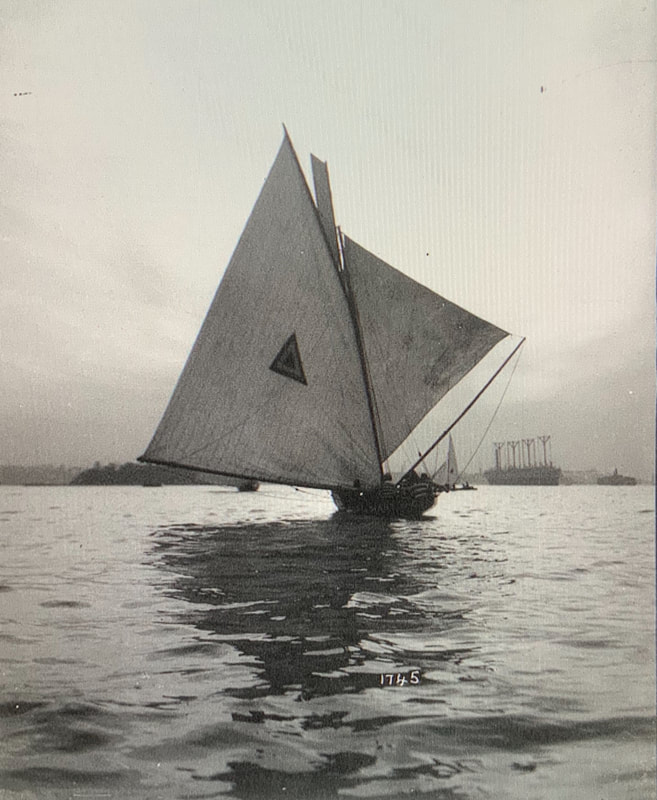
HASTINGS was built in Port Macquarie on the North Coast of NSW in 1922 (builder unknown) and spent most of her career racing local boats on the Hastings and other Northern rivers, and was the North Coast Champion on numerous occasions. In February 1923 She was shipped to Sydney and raced in 3 races, a short course in 2 heats and a final on 10 February in which she was 2nd in her heat and 5th in the final under owner H Petersen, the NSW Championship on 17 February in which she retired before the first mark, and a long course race on 24 February from which we have a long sequence of images on the Fleets Page. Unfortunately Hastings split their jib and retired at the Taylor Bay mark. The images here are from her second visit to Sydney when she was chartered for the whole of the 1927-28 season by Tom Young and Wal Keddie. Both images are likely to have been taken on the same day given the conditions, and given the presence of the Navy coal lighter MOMBAH in the distance that day has to be from the 1927-1928 season (MOMBAH was launched in Feb 1923 and was in Sydney until 1930). Hall Collection,ANMM.
Jean 1936
Builders P Cowie, Snr and Jnr
Sail insignia: Red and yellow diagonal stripes in rectangle.
Planking 3/8” Cedar, keel and ribs of Silver Ash, stem and sternpost Tea-Tree, gun’ls and stringers Huon Pine. Spring aft 10 1/2” aft, 4” forward, no heel. Rudder laminated from 23 pieces of Cedar.
Peter Cowie Snr was a stalwart of the sailing community, starting out in the 8-footer Rob Roy, then moving to 10-footers with his self-built Tam o’ Shanter in the 1890’s before moving on to 14-footers with Cutty Sark which he sailed successfully into the early 1900’s. In 1906 he had Joe Donnelly* build him an 18-footer Scot (can you see a pattern in the names?) which he sailed successfully for several seasons. He then became involved with the Birchgrove 14-foot skiff club which sailed limited sail undecked 14-foot skiffs. In 1934 his son, also Peter sailed in the 12-footers with a boat they built called Jean in the 1932-33 and 1933-34 seasons, and with a new 12' Jean II (built along similar lines to the new 18- footer The Mistake) became Australian Champion in the 1934-35 season after only 11 starts. In 1936 they decided to try their luck in the 18-footers, and together built an 18-foot Jean. They incorporated a number of ideas that had worked in the 12-footer, including all lightweight timbers. They also used stainless steel for chainplates and most of the other fittings (then so new it was referred to as rustless steel). The keel was laid down in January 1936 and the build attracted enough attention to have a novel christening in the Ships Chandlery department of the hardware store Nock and Kirbys in their main building in George Street Sydney on 19 August. Jean had to be wrestled upstairs, reportedly scraping some varnish off on the way up, and getting temporarily jammed on the way down. The vessel was christened by the NSW Minister for Labour and Industry Mr Dunningham with a few drops of champagne, and remained on display for about a week. She was launched at Greenwich Flying Squadron on 29 August 1936, and had her first race, a drifter on opening day Sunday 20 September at the League at Double Bay, coming 8th out of 9, with Peter Jnr as skipper. She was the 15th new boat to be registered at the League since it’s formation almost two years earlier.
Sail insignia: Red and yellow diagonal stripes in rectangle.
Planking 3/8” Cedar, keel and ribs of Silver Ash, stem and sternpost Tea-Tree, gun’ls and stringers Huon Pine. Spring aft 10 1/2” aft, 4” forward, no heel. Rudder laminated from 23 pieces of Cedar.
Peter Cowie Snr was a stalwart of the sailing community, starting out in the 8-footer Rob Roy, then moving to 10-footers with his self-built Tam o’ Shanter in the 1890’s before moving on to 14-footers with Cutty Sark which he sailed successfully into the early 1900’s. In 1906 he had Joe Donnelly* build him an 18-footer Scot (can you see a pattern in the names?) which he sailed successfully for several seasons. He then became involved with the Birchgrove 14-foot skiff club which sailed limited sail undecked 14-foot skiffs. In 1934 his son, also Peter sailed in the 12-footers with a boat they built called Jean in the 1932-33 and 1933-34 seasons, and with a new 12' Jean II (built along similar lines to the new 18- footer The Mistake) became Australian Champion in the 1934-35 season after only 11 starts. In 1936 they decided to try their luck in the 18-footers, and together built an 18-foot Jean. They incorporated a number of ideas that had worked in the 12-footer, including all lightweight timbers. They also used stainless steel for chainplates and most of the other fittings (then so new it was referred to as rustless steel). The keel was laid down in January 1936 and the build attracted enough attention to have a novel christening in the Ships Chandlery department of the hardware store Nock and Kirbys in their main building in George Street Sydney on 19 August. Jean had to be wrestled upstairs, reportedly scraping some varnish off on the way up, and getting temporarily jammed on the way down. The vessel was christened by the NSW Minister for Labour and Industry Mr Dunningham with a few drops of champagne, and remained on display for about a week. She was launched at Greenwich Flying Squadron on 29 August 1936, and had her first race, a drifter on opening day Sunday 20 September at the League at Double Bay, coming 8th out of 9, with Peter Jnr as skipper. She was the 15th new boat to be registered at the League since it’s formation almost two years earlier.
Jean was christened at Nock and Kirby's George Street store attracting a great deal of publicity (photo from Cowie family scrapbook). The photo with spinnaker shows Jean on her first sailing trial a week before the season opened. From the Cowie family archives , this photo was featured in the Daily Telegraph of Monday 14 September 1936.
In her second race a week later she gained second place off 1/2 a minute handicap. The handicap didn’t change for the third race on 4 October, which Jean won by eight minutes! It seemed like she was finally living up to her promise, but it was to be the only win of the season. Jean had very few placings for the next few months and went from scratch after the win to 3, then 4, then the limit of 5 minutes by April. They gained enough minor placings though to finish mid-field for winnings for the season and the point score.
Early in the second season, 1937-38 Jean gained a few minor placings and one win, but competition had increased with 6 new boats joining the fleet. In December the State Championship was run over three heats, and Jean gained a 5th, a 2nd and a 3rd to be 3rd overall to the new boats Dee Why and Malvina. These three plus Minawatta were selected to represent NSW at the Australian Championship in early January 1938 in Brisbane. In five heats Jean was 6th overall. Malvina (Billo Hayward NSW) won. The title holder Aberdare was 3rd, after capsizing in the first heat. The photo at the head of the article is from this series, from the Cowie family archive.
The League’s inaugural World Championship (with only New Zealand sending boats that happened to be 18’ long but of very different styles) was held in late January in Sydney, but Jean’s best result was a 4th in one heat. The Championship was won by newcomer Bert Swinbourne in the new boat Taree.
In the rest of the season Jean gained a few more placings but no more wins. The winning list was being filled by newer boats and skippers, especially Billo Hayward who seemed to be able to win in whatever boat he was on.
In June 1938 it was announced that Peter Cowie was to build a new boat. Jean II was an even lighter boat and started racing in October 1938 but had a very slow start to the season, but after 17 unplaced outings they finally won a race off 2 3/4 minutes in February. But Jean II had not proved to be a better boat than Jean I. Peter Cowie did not race 18-footers after the end of the 1938-39 season. There is a family story that he became disgusted with bookmakers trying to bribe him to lose and was convinced that the racing was no longer fair and that the bookies were getting at his crew. Peter Cowie III believes his father turned Jean II into a motor launch with an Austin 7 engine.
Jean I was sold to Jack Chalmers in 1939 and began to be raced with the League in the 1939-40 season under A Boyce. Peter Cowie allowed him to keep the same sail logo. Owner Chalmers sailed in the crew. Boyce had the same kind of mixed results that Cowie had, gaining a few placings but no wins that season. But at the start of the 1940-41 season Jean I won the opening race off 4 1/2 minutes, leading all the way. The season generally was a bit unlucky for them after that, there were a few placings but several capsizes and withdrawals and a broken mast. In April they threw away one of the last races by engaging in a luffing duel with Australia which slowed them both down and allowed Malvina (Ray Rawlings) to slip through to beat Jean by seven seconds.
Early in the second season, 1937-38 Jean gained a few minor placings and one win, but competition had increased with 6 new boats joining the fleet. In December the State Championship was run over three heats, and Jean gained a 5th, a 2nd and a 3rd to be 3rd overall to the new boats Dee Why and Malvina. These three plus Minawatta were selected to represent NSW at the Australian Championship in early January 1938 in Brisbane. In five heats Jean was 6th overall. Malvina (Billo Hayward NSW) won. The title holder Aberdare was 3rd, after capsizing in the first heat. The photo at the head of the article is from this series, from the Cowie family archive.
The League’s inaugural World Championship (with only New Zealand sending boats that happened to be 18’ long but of very different styles) was held in late January in Sydney, but Jean’s best result was a 4th in one heat. The Championship was won by newcomer Bert Swinbourne in the new boat Taree.
In the rest of the season Jean gained a few more placings but no more wins. The winning list was being filled by newer boats and skippers, especially Billo Hayward who seemed to be able to win in whatever boat he was on.
In June 1938 it was announced that Peter Cowie was to build a new boat. Jean II was an even lighter boat and started racing in October 1938 but had a very slow start to the season, but after 17 unplaced outings they finally won a race off 2 3/4 minutes in February. But Jean II had not proved to be a better boat than Jean I. Peter Cowie did not race 18-footers after the end of the 1938-39 season. There is a family story that he became disgusted with bookmakers trying to bribe him to lose and was convinced that the racing was no longer fair and that the bookies were getting at his crew. Peter Cowie III believes his father turned Jean II into a motor launch with an Austin 7 engine.
Jean I was sold to Jack Chalmers in 1939 and began to be raced with the League in the 1939-40 season under A Boyce. Peter Cowie allowed him to keep the same sail logo. Owner Chalmers sailed in the crew. Boyce had the same kind of mixed results that Cowie had, gaining a few placings but no wins that season. But at the start of the 1940-41 season Jean I won the opening race off 4 1/2 minutes, leading all the way. The season generally was a bit unlucky for them after that, there were a few placings but several capsizes and withdrawals and a broken mast. In April they threw away one of the last races by engaging in a luffing duel with Australia which slowed them both down and allowed Malvina (Ray Rawlings) to slip through to beat Jean by seven seconds.
A classic shot of Jean from the Daily Telegraph Monday 10 March 1941, A Boyce at the helm. They were 4th that day off 4 3/4 minutes.
In the 1941-42 season, their third, they were leading in a drifter and looked certain to win but a puff from a different direction sent them off the course and they collided with the spectator ferry Koompartoo, jammed their bumpkin under the ferry’s sponson and weren’t able to free it until after the whole fleet had crossed the line. They had three capsizes in November, December and January ( by which time they were racing up the Parramatta River) and two disqualifications, and at some stage early in 1942 Boyce decided that 18-footer racing was not for him (or Chalmers decided for him) and Boyce was replaced by Paddy Griffiths who sailed her for the rest of that season and the next, 1942-43. They had no wins but enough placings to gain 4th in the season point score.
The legendary Chook Fraser took over at the helm for the 1943-44 season and won the opening race and one other that season. Still owned by Jack Chalmers, Jean was steered by Chook for two seasons, with his son Jimmy Fraser, another legend of the sport in the crew. In the middle of their second season in December 1944 the Daily Telegraph announced that the boat was to be properly christened with a full bottle of champagne as it was alleged that the few drops used on her original christening had made her an unlucky boat. It didn’t seem to help, and Jean disappears from the records after the end of the 1944-45 season. Jack Chalmers replaced her with a new boat Dauntless from builder Willis Douglas and Chook Fraser was retained to steer.
Two more generations of Peter Cowies, that’s four in a row, have been associated with salt water, P Cowie III sailing a twelve-footer successfully despite losing an arm as a teenager, and P Cowie IV being involved with the revival of steam launches.
The legendary Chook Fraser took over at the helm for the 1943-44 season and won the opening race and one other that season. Still owned by Jack Chalmers, Jean was steered by Chook for two seasons, with his son Jimmy Fraser, another legend of the sport in the crew. In the middle of their second season in December 1944 the Daily Telegraph announced that the boat was to be properly christened with a full bottle of champagne as it was alleged that the few drops used on her original christening had made her an unlucky boat. It didn’t seem to help, and Jean disappears from the records after the end of the 1944-45 season. Jack Chalmers replaced her with a new boat Dauntless from builder Willis Douglas and Chook Fraser was retained to steer.
Two more generations of Peter Cowies, that’s four in a row, have been associated with salt water, P Cowie III sailing a twelve-footer successfully despite losing an arm as a teenager, and P Cowie IV being involved with the revival of steam launches.
Kangaroo 1949
Builder: Ken Morrow for himself.
Insignia: Kangaroo silhouette.
Ken Morrow (1910-2000) came from a boatbuilding family in Balmain, he was one of the sons at FW Morrow and Sons at the bottom of Campbell St Balmain (the slipway was replaced by townhouses about 15 years ago). He built and raced Eileen* (see 10-Footers Page) in 1930 and won the State Championship in the 1931-32 season.
He raced Kangaroo with the Sydney Flying Squadron fleet for three seasons from part-way through the 1949-50 season to 1951-52, then moved over to the League for a further two seasons. At both clubs Kangaroo was a middle marker or better on handicap and won their fair share of handicap races as well as being placed in several Championship races. Ken then built a 16-footer he also called Kangaroo and sailed at the Drummoyne Sailing Club where he won the Club Championship in 1957-58, before retiring from sailing in 1964. Photo and information supplied to the AHSSA by Ken's step-daughter Kay King.
Insignia: Kangaroo silhouette.
Ken Morrow (1910-2000) came from a boatbuilding family in Balmain, he was one of the sons at FW Morrow and Sons at the bottom of Campbell St Balmain (the slipway was replaced by townhouses about 15 years ago). He built and raced Eileen* (see 10-Footers Page) in 1930 and won the State Championship in the 1931-32 season.
He raced Kangaroo with the Sydney Flying Squadron fleet for three seasons from part-way through the 1949-50 season to 1951-52, then moved over to the League for a further two seasons. At both clubs Kangaroo was a middle marker or better on handicap and won their fair share of handicap races as well as being placed in several Championship races. Ken then built a 16-footer he also called Kangaroo and sailed at the Drummoyne Sailing Club where he won the Club Championship in 1957-58, before retiring from sailing in 1964. Photo and information supplied to the AHSSA by Ken's step-daughter Kay King.
Keriki 1920
Builder: Norman Wright Snr.*
Known measurements: Length 17'11 1/4", Beam 8'2", depth 2'
Rig: (1932) Mast 28", Main 28' on boom, 20' hoist, 18' on gaff. Bumpkin 20', poles 40'. 68' across + half of 17' ringtail spar. One of the biggest ever sail carriers amongst the eighteens.
Sail Insignia: Red and blue crescent.
Keriki was built by Norm Wright in 1919 as Thelma III for the proposed interstate challenge which did not go ahead. Lan Taylor* of Sydney bought her in 1920 to replace his Quibree* which he had retired a couple of seasons before. Her first race was on 13 March 1920 where she was unplaced with small gear. Lan Taylor was old friends with champion helmsman Chris Webb who had often steered Lan's 22-Footer of the same name before the turn of the 20th Century, and Lan proposed in the 1920-21 season a 300-pounds prize challenge against any boat, particularly Queenslanders who would rise to the challenge, with Chris Webb steering, but nobody did. Taylor mostly steered the boat himself in SSC and SFS events, and in the first few seasons was always just several places from the top in prize-money earnings with a fairly low handicap.
The photograph above by Hall was taken in the 1923-24 season and was used in a huge mural at the British Empire Exhibition in London in 1924.
In November 1925 Chris Webb in HC Press II* was dismasted in a collision manoeuvring before the start, and Lan Taylor took him on board Keriki and handed over the tiller for the race. Webb often steered Keriki on annual visits to Port Macquarie on the North Coast of NSW at Easter for the local Regatta there, and won the Cup 3 times, in 1927, 1928 (Taylor steered) and 1931. In the 1930-31 season Webb decided not to continue as regular skipper of HC Press II and made guest appearances steering Keriki until the boat's last season (1938-39), but Lan Taylor did the bulk of the steering himself. Always a competitive boat, Keriki never won a Championship race but often featured in handicap races, generally off a low handicap, even being on scratch occasionally in the late 1930's. She was always a popular boat with punters as Lan (who was in his mid-70's by 1939) was always expected to put on a good show with big sails and a large crew. Keriki sailed right up to the end of the 1938-39 season, but remained on the books of the SFS for several more seasons without taking part in any race.
Known measurements: Length 17'11 1/4", Beam 8'2", depth 2'
Rig: (1932) Mast 28", Main 28' on boom, 20' hoist, 18' on gaff. Bumpkin 20', poles 40'. 68' across + half of 17' ringtail spar. One of the biggest ever sail carriers amongst the eighteens.
Sail Insignia: Red and blue crescent.
Keriki was built by Norm Wright in 1919 as Thelma III for the proposed interstate challenge which did not go ahead. Lan Taylor* of Sydney bought her in 1920 to replace his Quibree* which he had retired a couple of seasons before. Her first race was on 13 March 1920 where she was unplaced with small gear. Lan Taylor was old friends with champion helmsman Chris Webb who had often steered Lan's 22-Footer of the same name before the turn of the 20th Century, and Lan proposed in the 1920-21 season a 300-pounds prize challenge against any boat, particularly Queenslanders who would rise to the challenge, with Chris Webb steering, but nobody did. Taylor mostly steered the boat himself in SSC and SFS events, and in the first few seasons was always just several places from the top in prize-money earnings with a fairly low handicap.
The photograph above by Hall was taken in the 1923-24 season and was used in a huge mural at the British Empire Exhibition in London in 1924.
In November 1925 Chris Webb in HC Press II* was dismasted in a collision manoeuvring before the start, and Lan Taylor took him on board Keriki and handed over the tiller for the race. Webb often steered Keriki on annual visits to Port Macquarie on the North Coast of NSW at Easter for the local Regatta there, and won the Cup 3 times, in 1927, 1928 (Taylor steered) and 1931. In the 1930-31 season Webb decided not to continue as regular skipper of HC Press II and made guest appearances steering Keriki until the boat's last season (1938-39), but Lan Taylor did the bulk of the steering himself. Always a competitive boat, Keriki never won a Championship race but often featured in handicap races, generally off a low handicap, even being on scratch occasionally in the late 1930's. She was always a popular boat with punters as Lan (who was in his mid-70's by 1939) was always expected to put on a good show with big sails and a large crew. Keriki sailed right up to the end of the 1938-39 season, but remained on the books of the SFS for several more seasons without taking part in any race.

Keriki and the Ben Hansen Trophy 1926-27
Kerry Martin approached the Sydney Flying Squadron recently enquiring about a gold medallion which had been passed down the family to her from her grandfather Arthur Harold Martin. The family knew nothing about the medallion. The inscription reads “Presented by Ben Hansen 18 Footer Trophy 1926-27 Won by Keriki A.H.Martin”
Digging around a bit I found that Ben Hansen was the SFS Secretary for some years in the 1920’s and presented an annual trophy, but we don’t know what for……trophies were often presented for individual races but others had unusual requirements such as the best overall result in a combination of say 3 races. Whatever the requirement, in the 1926-27 season it was won by Lan Taylor’s Keriki. Ben Hansen must have organised a personal medallion for each of the crew.
I’ll keep looking, but I haven’t yet found any other reference to the Ben Hansen Trophy at the SFS. We do have a record of all of the trophies presented from the 1938-39 season to the 1941-42 season, and it does not appear then. However Ben Hansen apparently also had a connection with the St George Sailing Club, and presented a trophy to the 16’ skiffs there until the early 1940’s.
Kerry Martin approached the Sydney Flying Squadron recently enquiring about a gold medallion which had been passed down the family to her from her grandfather Arthur Harold Martin. The family knew nothing about the medallion. The inscription reads “Presented by Ben Hansen 18 Footer Trophy 1926-27 Won by Keriki A.H.Martin”
Digging around a bit I found that Ben Hansen was the SFS Secretary for some years in the 1920’s and presented an annual trophy, but we don’t know what for……trophies were often presented for individual races but others had unusual requirements such as the best overall result in a combination of say 3 races. Whatever the requirement, in the 1926-27 season it was won by Lan Taylor’s Keriki. Ben Hansen must have organised a personal medallion for each of the crew.
I’ll keep looking, but I haven’t yet found any other reference to the Ben Hansen Trophy at the SFS. We do have a record of all of the trophies presented from the 1938-39 season to the 1941-42 season, and it does not appear then. However Ben Hansen apparently also had a connection with the St George Sailing Club, and presented a trophy to the 16’ skiffs there until the early 1940’s.
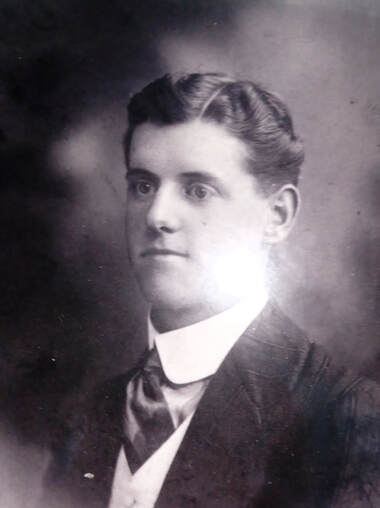
Arthur Harold Martin, whom we now know was in the crew of Keriki in the 1926-27 season. Photo supplied by his granddaughter Kerry Martin.
Below: Keriki on a reach to the Sow and Pigs in a Sou’Easter. AHMartin might be one of those blokes. ANMM Hall Collection.
Above: Keriki powering across Double Bay in a Sou'Easterly. Avalon is beyond, dating this shot to 1922-1930. Hall Collection, ANMM.
Two shots of KERIKI, probably taken on the same day. ONDA* is beyond at right. Hall Collection ANMM
Kismet 1912
KISMET is seen here with SWASTIKA at left and DESDEMONA at right, dating this image from the Hall Collection ANMM to between 1913 and 1925.
Below left: KISMET's frd hand is out on the bumpkin fixing something. Below right: KISMET in Fremantle in 1922.
Below left: KISMET's frd hand is out on the bumpkin fixing something. Below right: KISMET in Fremantle in 1922.
Builder: Charlie Dunn* Berry's Bay for D.C.Ravell and his 3 brothers.
Known dimensions: 17'11 1/4" by 7'7 1/2" beam, 2' 4 1/2" deep.
Sail Insignia: Blue Commonwealth flag.
Kismet won several races in her first season, 1912-13, steered by Billy Dunn (who also had a hand in her construction) and by March 1914 she was on scratch. She was the leading prizewinner in 1914-15, and the SFS Champion in 1915-16. Dave Ravell and his brothers went off to war and the boat did not start in the 1917-18 season, but returned to racing in December 1918, and was the State Champion in 1919-20, still under Billy Dunn. W.J."Billy"Duncan* took over the tiller from the 1920-21 season until 1924-25 and was still a competitive boat, including winning selection to go to Perth in January 1922 (where she was beaten by local boat Mele Bilo, also designed by Charlie Dunn). She appears not to have sailed in the 1925-26 season but reappears for the 1926-27 season, when after a few races, owner Dave Ravell began to steer himself. The boat remained competitive and was sailed every season until Dave Ravell was killed in an industrial accident (he was a builder) in December 1937 aged 47. His young nephew W.Ravell then sailed Kismet for several seasons, the last being 1940-41. This long run of 28 years (25 seasons) is 3rd behind Scot with 43 seasons and Desdemona with 31. The YARNS Page has the yarn KISMET Trophies return to Sydney Flying Squadron.
Known dimensions: 17'11 1/4" by 7'7 1/2" beam, 2' 4 1/2" deep.
Sail Insignia: Blue Commonwealth flag.
Kismet won several races in her first season, 1912-13, steered by Billy Dunn (who also had a hand in her construction) and by March 1914 she was on scratch. She was the leading prizewinner in 1914-15, and the SFS Champion in 1915-16. Dave Ravell and his brothers went off to war and the boat did not start in the 1917-18 season, but returned to racing in December 1918, and was the State Champion in 1919-20, still under Billy Dunn. W.J."Billy"Duncan* took over the tiller from the 1920-21 season until 1924-25 and was still a competitive boat, including winning selection to go to Perth in January 1922 (where she was beaten by local boat Mele Bilo, also designed by Charlie Dunn). She appears not to have sailed in the 1925-26 season but reappears for the 1926-27 season, when after a few races, owner Dave Ravell began to steer himself. The boat remained competitive and was sailed every season until Dave Ravell was killed in an industrial accident (he was a builder) in December 1937 aged 47. His young nephew W.Ravell then sailed Kismet for several seasons, the last being 1940-41. This long run of 28 years (25 seasons) is 3rd behind Scot with 43 seasons and Desdemona with 31. The YARNS Page has the yarn KISMET Trophies return to Sydney Flying Squadron.
It's not that common to see shots of closeups of boat and crew especially from this angle. Kismet is seen leaving her shed in North Sydney. Image from the Stanton Library Collection, North Sydney Council.
This shot from the Hall Collection shows BRITANNIA (left) and KISMET. The boats have often been confused in the past because of similarities in their insignia in black and white photographs. BRITANNIA carried the Red Duster, the British Red Ensign with no stars. KISMET carried the blue Australian Commonwealth flag, with stars. As you can see in the other images, KISMET’s flag background often appears darker than it does in this image.
Livonia 1908
Builder: Jack Robinson, for himself.
Insignia: Red six-pointed star.
Jack Robinson was Wee Georgie Robinson's* father, and had been a top-level professional skipper for some years, with notable victories in 22-footers Mantura and Volunteer among others as well as 14 footers and 16-foot skiffs. He built Livonia for himself, as his previous boat Young Jack (1906) was built like a skiff and was banned from sailing with the SSC due to being under 7' beam and he only persevered with the SFS, with mixed success for two seasons. Livonia was never a champion boat but won mid-level shares of prize-money, and slightly above average in the 1909-10 and 1910-11 seasons of about 30 pounds, and 37 pounds in the 1912-13 season. Jack raced with both the Sydney Sailing Club and the Sydney Flying Squadron (alternate Saturdays) with mid-range handicaps. He sold the boat to Watty Ford* who sent her to the Islands in April 1914. Jack helped Wee Georgie build Britannia and steered her a number of times, generally when George was tied up with Rugby League commitments early and late in the season. Britannia raced with Livonia's sails and gear for at least part of her first season 1919-20. Livonia's red six-pointed star appeared again on his grandson Ron Robinson's Scamp in 1947 and later on Ron's cousin Vic Robinson's The Fox. A lot more on this multi-generational family can be found in the book The 18-Footer Britannia- 100 Years of a Sydney Icon, available on the Books Page.
Insignia: Red six-pointed star.
Jack Robinson was Wee Georgie Robinson's* father, and had been a top-level professional skipper for some years, with notable victories in 22-footers Mantura and Volunteer among others as well as 14 footers and 16-foot skiffs. He built Livonia for himself, as his previous boat Young Jack (1906) was built like a skiff and was banned from sailing with the SSC due to being under 7' beam and he only persevered with the SFS, with mixed success for two seasons. Livonia was never a champion boat but won mid-level shares of prize-money, and slightly above average in the 1909-10 and 1910-11 seasons of about 30 pounds, and 37 pounds in the 1912-13 season. Jack raced with both the Sydney Sailing Club and the Sydney Flying Squadron (alternate Saturdays) with mid-range handicaps. He sold the boat to Watty Ford* who sent her to the Islands in April 1914. Jack helped Wee Georgie build Britannia and steered her a number of times, generally when George was tied up with Rugby League commitments early and late in the season. Britannia raced with Livonia's sails and gear for at least part of her first season 1919-20. Livonia's red six-pointed star appeared again on his grandson Ron Robinson's Scamp in 1947 and later on Ron's cousin Vic Robinson's The Fox. A lot more on this multi-generational family can be found in the book The 18-Footer Britannia- 100 Years of a Sydney Icon, available on the Books Page.
Mascotte 1918

Built by Billy Golding as Nimrod, 1909 (see separate entry below).
Insignia: Australian Union Steam Navigation Co (AUSN) flag, white diagonal cross on blue and red quarters.
Nimrod was sold to Tom Golden in 1918 who renamed it Mascotte. He installed WJ "Billy" Duncan as skipper and they were immediately successful, winning the SSC Championship that season and a few other races that season and the next. Mascotte and Kismet were selected to represent NSW in Queensland in January 1920 but due to a shipping strike the event was cancelled.
Biily Duncan's cousin WC"Trappy" Duncan took over the helm at the start of the 1920-21 season and won both the SSC and the SFS Championships as well as being runner-up in the Australian Championship. They couldn't back it up in the 1921-22 season, even capsizing in the SFS Championship, but won a few handicap races and were always on or close to scratch. They won the State Championship that year as well as the North Coast Championship at Port Macquarie at Easter 1922. In 1922-23 Trappy and Mascotte won both club Championships again and a few handicap races but missed out on selection to go to Brisbane, Kismet and Mavis were selected.
In the Winter of 1923 the boat was sold to a syndicate headed by Reg Holmes, son of W.Holmes, who renamed the boat Awaya and installed Billy Dunn* as helmsman. The boat was less successful for the next two seasons. Trappy and most of his crew moved over to Lifesaver (ex-Golding) for those two seasons, but the boat was sold to Jim Hall in 1925 who changed the name back to Mascotte and got Trappy and his crew back to sail her. They won a handicap race early in the season and then won the SFS Championship in November and the Port Jackson Championship in December 1926. They were second in both the Australian Championship (to HC Press II) and the State Championship (to Arline) in early 1927. They won no Championships the following two seasons but were third in the SFS Championship in November 1928 and second in the Port Jackson Championship in December. In the 1929-30 season they again won no Championships but were mid-field in the amount of prize money won with 59 pounds.
In 1930 Jim Hall built himself a new boat and named it Mascotte II. Trappy Duncan stayed with him to steer. They had an inauspicious start by capsizing in the first race and had a very poor season, only winning a heat in one race. Mascotte II did not appear the following season.
Hall sold Mascotte (I) to a syndicate headed by Reg Bartley who had owned and sailed Scot* for several years. Bartley was reported as considering changing the name back to Nimrod, but that didn't eventuate and the boat appeared at the beginning of the 1931-32 season as Mascotte with Reg Bartley at the helm. Reg campaigned the boat for 5 seasons, but the boat was getting quite old by then and apart from winning a few handicap races from mid-field to long marker handicaps of 5-6 minutes the boat was no longer considered a champion. Reg handed the tiller over to several other skippers including Trappy Duncan over this period, particularly in the final season but none could improve the performance. Mascotte was retired after the 1934-35 season, aged 24.
Insignia: Australian Union Steam Navigation Co (AUSN) flag, white diagonal cross on blue and red quarters.
Nimrod was sold to Tom Golden in 1918 who renamed it Mascotte. He installed WJ "Billy" Duncan as skipper and they were immediately successful, winning the SSC Championship that season and a few other races that season and the next. Mascotte and Kismet were selected to represent NSW in Queensland in January 1920 but due to a shipping strike the event was cancelled.
Biily Duncan's cousin WC"Trappy" Duncan took over the helm at the start of the 1920-21 season and won both the SSC and the SFS Championships as well as being runner-up in the Australian Championship. They couldn't back it up in the 1921-22 season, even capsizing in the SFS Championship, but won a few handicap races and were always on or close to scratch. They won the State Championship that year as well as the North Coast Championship at Port Macquarie at Easter 1922. In 1922-23 Trappy and Mascotte won both club Championships again and a few handicap races but missed out on selection to go to Brisbane, Kismet and Mavis were selected.
In the Winter of 1923 the boat was sold to a syndicate headed by Reg Holmes, son of W.Holmes, who renamed the boat Awaya and installed Billy Dunn* as helmsman. The boat was less successful for the next two seasons. Trappy and most of his crew moved over to Lifesaver (ex-Golding) for those two seasons, but the boat was sold to Jim Hall in 1925 who changed the name back to Mascotte and got Trappy and his crew back to sail her. They won a handicap race early in the season and then won the SFS Championship in November and the Port Jackson Championship in December 1926. They were second in both the Australian Championship (to HC Press II) and the State Championship (to Arline) in early 1927. They won no Championships the following two seasons but were third in the SFS Championship in November 1928 and second in the Port Jackson Championship in December. In the 1929-30 season they again won no Championships but were mid-field in the amount of prize money won with 59 pounds.
In 1930 Jim Hall built himself a new boat and named it Mascotte II. Trappy Duncan stayed with him to steer. They had an inauspicious start by capsizing in the first race and had a very poor season, only winning a heat in one race. Mascotte II did not appear the following season.
Hall sold Mascotte (I) to a syndicate headed by Reg Bartley who had owned and sailed Scot* for several years. Bartley was reported as considering changing the name back to Nimrod, but that didn't eventuate and the boat appeared at the beginning of the 1931-32 season as Mascotte with Reg Bartley at the helm. Reg campaigned the boat for 5 seasons, but the boat was getting quite old by then and apart from winning a few handicap races from mid-field to long marker handicaps of 5-6 minutes the boat was no longer considered a champion. Reg handed the tiller over to several other skippers including Trappy Duncan over this period, particularly in the final season but none could improve the performance. Mascotte was retired after the 1934-35 season, aged 24.
Mavis 1904 later Eclipse II (1929), Springbok (1935)
Builder: Sam Williams*
Known dimensions: Beam 7'7", depth 20", tuck beam 6'.
Sail Insignia: Blue triangle, sometimes with gold ball in centre.
The 18-footer Mavis was built in 1904 by Sam Williams for publican George Solomon and had the second longest career of any 18-footer, racing for 40 seasons over 41 years(Scot raced for 43 seasons). Just like Scot she did it under multiple name changes, and at least two major rebuilds. But it’s a fascinating story because the period she sailed spans the whole of the golden age of the 18-footers, and her performances under several owners and a lot of different skippers ranged from being a long marker to Australian Champion and back again to an also-ran.
When he built Mavis Sam Williams was a well-respected builder, having built the first Australian 18-footer (1896) which Chris Webb steered to numerous victories and the 22-footer Keriki (1898). He built it in the backyard of his home in Glebe which goes to show that boatbuilders having trouble with finding decent sheds to build in is not a new thing. This necessitated the demolition of his fence, after which the boat was “shouldered out of the yard and a triumphant procession, headed by George Ellis wended its way through lanes, streets and timber yards to Blackwattle Bay”. Ellis was a leading boatbuilder himself but also a leading skipper, and it was he who skippered Mavis on her first trial outings and her first race. Mavis was to be kept at Ellis’s shed in Mort Bay Balmain along with Arline (also owned by George Solomon).
Mavis was described as a “small” boat even though she had a beam of 7’7” and a tuck 6’ wide and was very full forward, but she was only 20” deep (most 18’s were 24-30” deep amidships). She was referred to as the “flat iron”. Her first race on 8 October 1904 was considered a disappointment. Ellis moved over to stablemate Arline and several other skippers including Tom Cuneo and Paddy Griffiths had a go. Her only win that season was in the morning race at the Balmain Regatta under Ellis.
In August 1905 George Solomon announced he was quitting the sport (there had been some runctions with Ellis) and sold Mavis and Arline to Watty Ford. Ford renamed the latter boat Australian and tried to sell Mavis on. Mavis didn’t race much that season and eventually found an owner in OJ Jones of the Watson’s Bay club who entered her in the restricted events of that club. In 1907 she was sold to FW Moppett who entered her in similar events in second level clubs and suburban regattas, mostly racing with the Mosman Amateurs where they were second on the prize list for the 1910-11 season. But also that season Moppett raced several times with the main 18-footers fleet with the SSC and the SFS and for the next several seasons he was mid-field in the prize money list at both clubs. Performances began to improve and in the 1913-14 season he won at least one double, heat and final in a handicap race, and finished 4th in the SSC club Championship after leading most of the way.
Known dimensions: Beam 7'7", depth 20", tuck beam 6'.
Sail Insignia: Blue triangle, sometimes with gold ball in centre.
The 18-footer Mavis was built in 1904 by Sam Williams for publican George Solomon and had the second longest career of any 18-footer, racing for 40 seasons over 41 years(Scot raced for 43 seasons). Just like Scot she did it under multiple name changes, and at least two major rebuilds. But it’s a fascinating story because the period she sailed spans the whole of the golden age of the 18-footers, and her performances under several owners and a lot of different skippers ranged from being a long marker to Australian Champion and back again to an also-ran.
When he built Mavis Sam Williams was a well-respected builder, having built the first Australian 18-footer (1896) which Chris Webb steered to numerous victories and the 22-footer Keriki (1898). He built it in the backyard of his home in Glebe which goes to show that boatbuilders having trouble with finding decent sheds to build in is not a new thing. This necessitated the demolition of his fence, after which the boat was “shouldered out of the yard and a triumphant procession, headed by George Ellis wended its way through lanes, streets and timber yards to Blackwattle Bay”. Ellis was a leading boatbuilder himself but also a leading skipper, and it was he who skippered Mavis on her first trial outings and her first race. Mavis was to be kept at Ellis’s shed in Mort Bay Balmain along with Arline (also owned by George Solomon).
Mavis was described as a “small” boat even though she had a beam of 7’7” and a tuck 6’ wide and was very full forward, but she was only 20” deep (most 18’s were 24-30” deep amidships). She was referred to as the “flat iron”. Her first race on 8 October 1904 was considered a disappointment. Ellis moved over to stablemate Arline and several other skippers including Tom Cuneo and Paddy Griffiths had a go. Her only win that season was in the morning race at the Balmain Regatta under Ellis.
In August 1905 George Solomon announced he was quitting the sport (there had been some runctions with Ellis) and sold Mavis and Arline to Watty Ford. Ford renamed the latter boat Australian and tried to sell Mavis on. Mavis didn’t race much that season and eventually found an owner in OJ Jones of the Watson’s Bay club who entered her in the restricted events of that club. In 1907 she was sold to FW Moppett who entered her in similar events in second level clubs and suburban regattas, mostly racing with the Mosman Amateurs where they were second on the prize list for the 1910-11 season. But also that season Moppett raced several times with the main 18-footers fleet with the SSC and the SFS and for the next several seasons he was mid-field in the prize money list at both clubs. Performances began to improve and in the 1913-14 season he won at least one double, heat and final in a handicap race, and finished 4th in the SSC club Championship after leading most of the way.
Mavis leads Desdemona about 1912-14. Postcard in Graeme Ferguson Collection, AHSSA.
But Moppett and Mavis really hit their stride in the 1914-15 season in which they won the SFS Championship, were 2nd in the SSC Championship and 5th in the State Championship and finished up with £57 in prizes, the third highest that season. Newspapers commented that the boat had been altered, but we know no details of that. She developed a reputation as a hard weather performer.
Success continued throughout the First World War years, especially in 1916-17 when Moppett and Mavis won the SSC Championship and the NSW Championship and topped the prize money list, a feat repeated in 1918-19 but the crowning glory was winning the Australian Championship in January 1919!
In September 1919 it was announced that Mavis would miss the start of the season due to still undergoing extensive alterations. The boat didn’t feature much once it did start, but this was partly due to not racing much at all mostly due to the illness of F Moppett’s brother Jack who was frd hand. In August 1920 just before the start of the next season Moppett sold Mavis to a syndicate headed by H Rodrick who had sailed Boronia and Sunny South in recent years after a long career in 16’s and 18’s. In the next two seasons Rodrick had limited success with Mavis and sold the boat halfway through the 1921-22 season to JH Memmis as he was having a new boat built (Caledonia).
But Moppett and Mavis really hit their stride in the 1914-15 season in which they won the SFS Championship, were 2nd in the SSC Championship and 5th in the State Championship and finished up with £57 in prizes, the third highest that season. Newspapers commented that the boat had been altered, but we know no details of that. She developed a reputation as a hard weather performer.
Success continued throughout the First World War years, especially in 1916-17 when Moppett and Mavis won the SSC Championship and the NSW Championship and topped the prize money list, a feat repeated in 1918-19 but the crowning glory was winning the Australian Championship in January 1919!
In September 1919 it was announced that Mavis would miss the start of the season due to still undergoing extensive alterations. The boat didn’t feature much once it did start, but this was partly due to not racing much at all mostly due to the illness of F Moppett’s brother Jack who was frd hand. In August 1920 just before the start of the next season Moppett sold Mavis to a syndicate headed by H Rodrick who had sailed Boronia and Sunny South in recent years after a long career in 16’s and 18’s. In the next two seasons Rodrick had limited success with Mavis and sold the boat halfway through the 1921-22 season to JH Memmis as he was having a new boat built (Caledonia).
Mavis at the start of the SFS Championship in 1923. The boat beyond with tricolour and central cross is Eclipse (I) built and steered by Tom Tait who a few years later bought Mavis and rebuilt her as Eclipse II. Postcard in Graeme Ferguson Collection AHSSA.
Memmis engaged AS Roberts to steer and in the next season it paid off as they won theSSC Championship in November 1922, and were second in the test race for selection to represent NSW in Queensland. But for some reason H Rodrick steered for most of the rest of the season including in Brisbane where they were 5th in the Australian Championship. The veteran Jack Smith steered for a few races late in that season and Tom Barnett steered for the 1923-24 season but the limited success saw Mavis’s handicap slide out to the limit which allowed them to win the final race of the season.
Memmis had a series of skippers try the boat in the next two seasons including AS Roberts and Paddy Griffiths again, but neither could really get the boat going and she remained on or close to the limit. Memmis attempted to sell Mavis in September 1925 and may have done so at some stage as she did not race at all in the 1925-26 season and was reported as having been reconditioned by Pritchards of Careening Cove before the 1926-27 season. Various skippers like Chook Fraser and G Findlay steered, neither with much success. J Hawkes steered in the 1927-28 season during which the hull was canvassed over to reduce leakage, partly because Mavis had been holed a couple of times recently, as well as other damage such as a broken mast and boom (different incidents). Tom Leach steered in 1928-29 which was Mavis’s last season under that name.
Memmis had a series of skippers try the boat in the next two seasons including AS Roberts and Paddy Griffiths again, but neither could really get the boat going and she remained on or close to the limit. Memmis attempted to sell Mavis in September 1925 and may have done so at some stage as she did not race at all in the 1925-26 season and was reported as having been reconditioned by Pritchards of Careening Cove before the 1926-27 season. Various skippers like Chook Fraser and G Findlay steered, neither with much success. J Hawkes steered in the 1927-28 season during which the hull was canvassed over to reduce leakage, partly because Mavis had been holed a couple of times recently, as well as other damage such as a broken mast and boom (different incidents). Tom Leach steered in 1928-29 which was Mavis’s last season under that name.
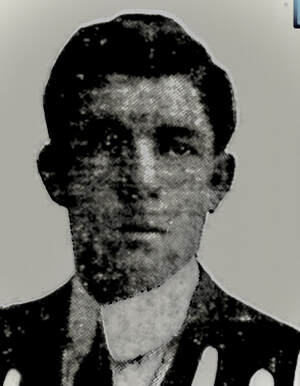
Tom Tait, owner, skipper, boatbuilder, club official and student of the science of sailing. Trove NLA
Tom Tait who had built and sailed his 18’s Rocket (launched in 1915 as Tom Tait!) and Eclipse (I) (1922) and was an official of the newly united Sydney Flying Squadron bought Mavis and completely rebuilt her. It was reported that only the keel and ribs remained of the original boat. The original was reported to be double-planked, two thin layers of planking rather than a single layer over seam battens as was the rule for the vast majority of 18’s and other open boats classes. I can’t find any reports on how Tom Tait replanked the boat, which he renamed Eclipse II.
Eclipse II’s first start was on 28 September 1929 at the beginning of the season but it was not an auspicious start with the peak carrying away. They also didn’t finish their second race the following week after nearly running the starter’s boat down, but they gained a 3rd in their third start off 5 3/4 minutes, and won the second heat on their fourth start off 4 minutes, but DNF in the final. A couple more wins later in the season helped them to mid-field in the prize money list with £57 for the season which the newspapers said “more than covered the outlay” for the rebuild.
Tom Tait who had built and sailed his 18’s Rocket (launched in 1915 as Tom Tait!) and Eclipse (I) (1922) and was an official of the newly united Sydney Flying Squadron bought Mavis and completely rebuilt her. It was reported that only the keel and ribs remained of the original boat. The original was reported to be double-planked, two thin layers of planking rather than a single layer over seam battens as was the rule for the vast majority of 18’s and other open boats classes. I can’t find any reports on how Tom Tait replanked the boat, which he renamed Eclipse II.
Eclipse II’s first start was on 28 September 1929 at the beginning of the season but it was not an auspicious start with the peak carrying away. They also didn’t finish their second race the following week after nearly running the starter’s boat down, but they gained a 3rd in their third start off 5 3/4 minutes, and won the second heat on their fourth start off 4 minutes, but DNF in the final. A couple more wins later in the season helped them to mid-field in the prize money list with £57 for the season which the newspapers said “more than covered the outlay” for the rebuild.
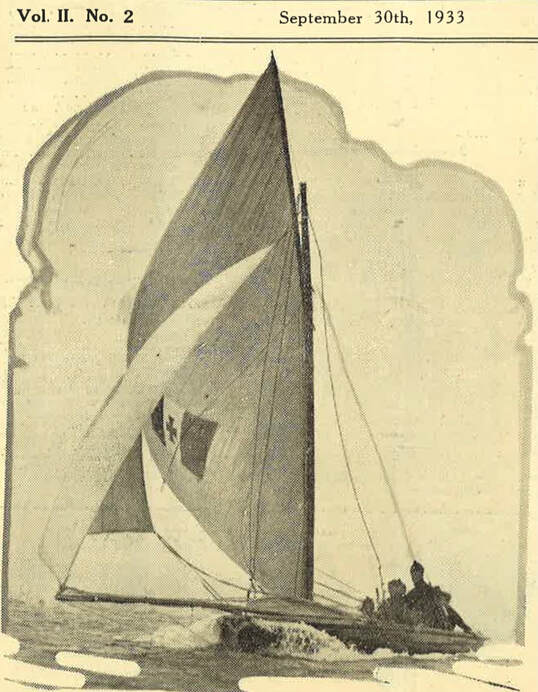
Eclipse II featured in the Sydney Flying Squadron programme 1933.
Eclipse II raced for 6 seasons in much the same manner, winning a handicap race or two each season and finishing mid-field on the prize money list, but generally retained a generous handicap. In spite of being a light boat often carrying only 7 crew when most of the fleet were carrying 10-15 hands she maintained Mavis’s reputation as a heavy weather boat. Tait tried a Marconi rig for most of the 1931-32 season as had Caledonia and Arawatta earlier, but like those boats returned to gaff rig (see the YARN on WHY DID 18-FOOTERS STAY GAFF-RIGGED FOR SO LONG?). On 23 February Mrs Jessie Orford who was married to Tait’s well hand became the first woman to steer an 18-footer in competition and “did well until the breeze failed”.
In February 1935 Eclipse II collided with Kiwi and Tom Tait suffered a cut over the eye that required stitching. I don’t think there’s any connection, but at the end of that season Tait announced he was withdrawing Eclipse II which would be replaced by a new boat.
This is not quite what happened: Tait simply overhauled the boat and renamed her Springbok. We have official measurements for Springbok: at 7’8” beam she was an inch wider than Mavis, but more importantly was 24” deep amidships, a whole 4” deeper than Mavis. We can’t tell which re-building of the boat resulted in these changes.
Eclipse II raced for 6 seasons in much the same manner, winning a handicap race or two each season and finishing mid-field on the prize money list, but generally retained a generous handicap. In spite of being a light boat often carrying only 7 crew when most of the fleet were carrying 10-15 hands she maintained Mavis’s reputation as a heavy weather boat. Tait tried a Marconi rig for most of the 1931-32 season as had Caledonia and Arawatta earlier, but like those boats returned to gaff rig (see the YARN on WHY DID 18-FOOTERS STAY GAFF-RIGGED FOR SO LONG?). On 23 February Mrs Jessie Orford who was married to Tait’s well hand became the first woman to steer an 18-footer in competition and “did well until the breeze failed”.
In February 1935 Eclipse II collided with Kiwi and Tom Tait suffered a cut over the eye that required stitching. I don’t think there’s any connection, but at the end of that season Tait announced he was withdrawing Eclipse II which would be replaced by a new boat.
This is not quite what happened: Tait simply overhauled the boat and renamed her Springbok. We have official measurements for Springbok: at 7’8” beam she was an inch wider than Mavis, but more importantly was 24” deep amidships, a whole 4” deeper than Mavis. We can’t tell which re-building of the boat resulted in these changes.
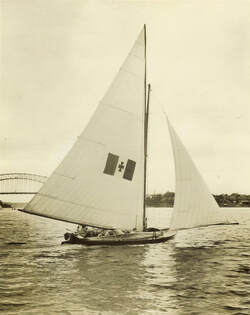
Springbok on the Harbour. She was fitted with a high-peaked rig with a particularly long gaff, similar to the skiff-type rigs adopted by the boats of the breakaway club the NSW 18-Footers League, but unlike those boats retained vertical panels in the main.
Tait was known as a student of sailing science and occasionally held lectures on aspects of sailing at the club, and equipped Springbok with chainplates and blocks made from Duralium, an aluminium alloy used in the aircraft industry. In their third season he fitted her with a rudder of Duralium and later a Duralium fin, and later fitted wooden cheeks to both to streamline them, in effect making an early foil. He fitted systems of his own design such as ratchet blocks, reefing gear and an “intricate double-purchase system of jib sheets” and Springbok became known as the “gadget boat”.
Tait was apparently a bit of a character. The Labor Daily of 22 February 1938 reported:
"Tom Tait, owner-skipper of the 18-footer Springbok, widely known for his humour, which is not always intentional, capped all previous efforts at last night’s meeting of the Sydney Flying Squadron. When informed by secretary N. Stanley that a pair of trousers were waiting for collection by him, Tom flared up and told the meeting in no uncertain terms that he objected to sarcastic remarks from such a high official. It was some time before the members could impress on Tait that the trousers had been donated as a prize for the winning skipper. Then came Tait’s explanation for his outburst: 'I thought you were casting aspersions on the dressing of my crew. On Saturday, one of my men had his pants torn off, and right in front of the ferry, too!' ”
Springbok had a couple of seasons of moderate success but in their third season (1937-38) they had four wins and finished 3rd on the prize money list. This success continued into the next season where Springbok gained a 3rd in the SFS Championship. Springbok continued Mavis and Eclipse II’s reputation as a heavy weather boat. But Tait’s luck appeared to desert him after that. His last win was in November 1941, just before the fleet moved up the Parramatta River to sail after the entry of Japan into World War II. They had not a single win in five years of racing up River, and a lot of gear damage, capsizes and disqualifications. He even fell overboard once. One of the crew dived in to support him, and both were picked up by the boat and finished the race.
Tait was known as a student of sailing science and occasionally held lectures on aspects of sailing at the club, and equipped Springbok with chainplates and blocks made from Duralium, an aluminium alloy used in the aircraft industry. In their third season he fitted her with a rudder of Duralium and later a Duralium fin, and later fitted wooden cheeks to both to streamline them, in effect making an early foil. He fitted systems of his own design such as ratchet blocks, reefing gear and an “intricate double-purchase system of jib sheets” and Springbok became known as the “gadget boat”.
Tait was apparently a bit of a character. The Labor Daily of 22 February 1938 reported:
"Tom Tait, owner-skipper of the 18-footer Springbok, widely known for his humour, which is not always intentional, capped all previous efforts at last night’s meeting of the Sydney Flying Squadron. When informed by secretary N. Stanley that a pair of trousers were waiting for collection by him, Tom flared up and told the meeting in no uncertain terms that he objected to sarcastic remarks from such a high official. It was some time before the members could impress on Tait that the trousers had been donated as a prize for the winning skipper. Then came Tait’s explanation for his outburst: 'I thought you were casting aspersions on the dressing of my crew. On Saturday, one of my men had his pants torn off, and right in front of the ferry, too!' ”
Springbok had a couple of seasons of moderate success but in their third season (1937-38) they had four wins and finished 3rd on the prize money list. This success continued into the next season where Springbok gained a 3rd in the SFS Championship. Springbok continued Mavis and Eclipse II’s reputation as a heavy weather boat. But Tait’s luck appeared to desert him after that. His last win was in November 1941, just before the fleet moved up the Parramatta River to sail after the entry of Japan into World War II. They had not a single win in five years of racing up River, and a lot of gear damage, capsizes and disqualifications. He even fell overboard once. One of the crew dived in to support him, and both were picked up by the boat and finished the race.
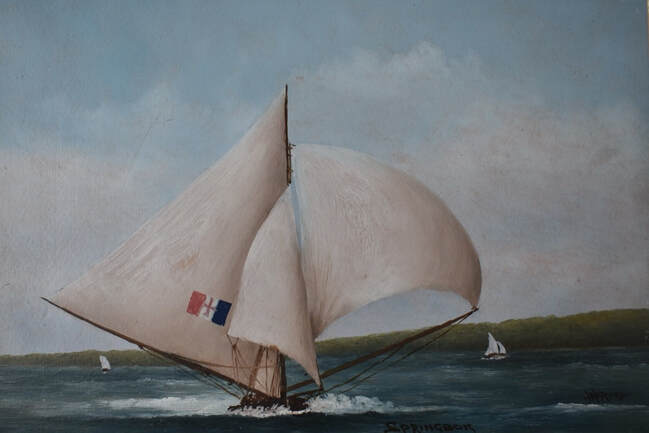
A painting of Springbok by J Harvey who painted a number of boats at the time. In the collection of John Fardy whose father sailed on the boat in the 1930's.
Racing back on the Harbour in the latter part of the 1945-46 season Springbok gained a few places but had no wins. In September 1946 Springbok was sold and a motor was installed. We lose track of her after that.
18-footer racing was beginning to rapidly evolve. Six-foot beamers were introduced and it was only a few more seasons until Bermudan rigs and trapezes were adopted. Mavis/Eclipse II/Springbok belonged to another age, having been built just as the 18-footers were becoming the dominant class. Her 40 seasons is only bettered by Scot with 43. Both boats’ careers spanned the whole of the golden age of 18-footer sailing.
18-footer racing was beginning to rapidly evolve. Six-foot beamers were introduced and it was only a few more seasons until Bermudan rigs and trapezes were adopted. Mavis/Eclipse II/Springbok belonged to another age, having been built just as the 18-footers were becoming the dominant class. Her 40 seasons is only bettered by Scot with 43. Both boats’ careers spanned the whole of the golden age of 18-footer sailing.
Mississippi 1914
Builder: Fred Newton, launched as Admiral II for himself.
Insignia: Blue Maltese Cross, golden ball in centre.
Known dimensions: Beam 8’1”, depth 2’2”.
Mississippi had a racing career of 20 seasons in the golden age of 18-footer sailing and won a fair share of prize money without ever being a champion. She was built by Fred Newton in 1913 who at the time was the Fisheries inspector at Port Macquarie and as Admiral II took part in a few races at Port Macquarie and other North Coast sailing events in late 1913. In January 1914 he visited Sydney (he was originally from Vaucluse) and brought the boat with him, and entered SFS and SSC races through January. He left the boat in Sydney and sold her to Bob Budnick, who renamed her Mississippi, to some public derision (“..absurdity”).
Budnick remained the owner through her entire racing career of 19 more seasons, and mostly steered himself, but other skippers occasionally appeared, especially Fred Manning the usual mainsheet hand, and A Ewington. Phil Harry steered for the later part of the first season and had three heat wins in a row, one final win and one SSC long course win to finish with £52 for the season, 4th on the list. Budnick steered the whole of the second season but had only one win. It was noted that “practically this craft’s whole crew have enlisted”, including Budnick’s brother who was wounded at Gallipoli and again in France.
Budnick advertised Mississippi for sale in September 1916, but with no takers sailed her again himself, again fairly high up (6th) on the prize money table, and always with mid-field handicaps. He complained about a newspaper report accusing him of deliberately throwing a race by grannying instead of gybing and claimed it was for lack of good crew.
Insignia: Blue Maltese Cross, golden ball in centre.
Known dimensions: Beam 8’1”, depth 2’2”.
Mississippi had a racing career of 20 seasons in the golden age of 18-footer sailing and won a fair share of prize money without ever being a champion. She was built by Fred Newton in 1913 who at the time was the Fisheries inspector at Port Macquarie and as Admiral II took part in a few races at Port Macquarie and other North Coast sailing events in late 1913. In January 1914 he visited Sydney (he was originally from Vaucluse) and brought the boat with him, and entered SFS and SSC races through January. He left the boat in Sydney and sold her to Bob Budnick, who renamed her Mississippi, to some public derision (“..absurdity”).
Budnick remained the owner through her entire racing career of 19 more seasons, and mostly steered himself, but other skippers occasionally appeared, especially Fred Manning the usual mainsheet hand, and A Ewington. Phil Harry steered for the later part of the first season and had three heat wins in a row, one final win and one SSC long course win to finish with £52 for the season, 4th on the list. Budnick steered the whole of the second season but had only one win. It was noted that “practically this craft’s whole crew have enlisted”, including Budnick’s brother who was wounded at Gallipoli and again in France.
Budnick advertised Mississippi for sale in September 1916, but with no takers sailed her again himself, again fairly high up (6th) on the prize money table, and always with mid-field handicaps. He complained about a newspaper report accusing him of deliberately throwing a race by grannying instead of gybing and claimed it was for lack of good crew.
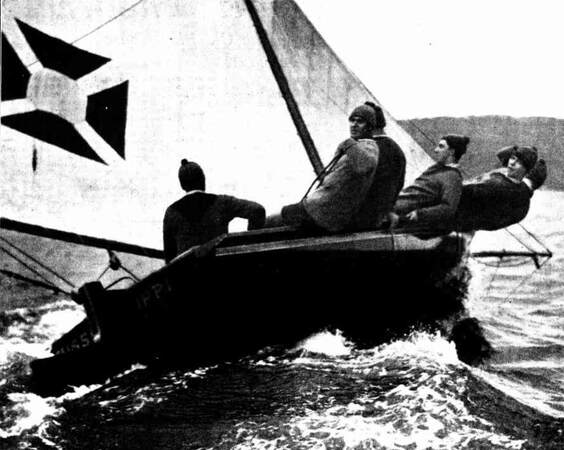
Mississippi travelled to Brisbane representing NSW for the Patriotic Carnival in January 1918 and newspapers commented “possibly one of the champions may also make the journey”, but they surprised everyone by gaining a 3rd, 4th and 5th at the Carnival. The following season 1918-19 they won the opening race but had no more wins and finished 11th/28 in the prize money list. The boat was developing a reputation for being best in hard weather.
Fred Manning steered a bit in the 1919-20 season but without any more success than Budnick, winning only the Anniversary Day Regatta race. Budnick won a few races in the 1920-21 season and the handicap began to get shorter, in fact in the 1921-22 season they were one of 7 boats on scratch in October, and remained on or about scratch until January. They still managed to finish mid-field in earnings.
Fred Manning steered a bit in the 1919-20 season but without any more success than Budnick, winning only the Anniversary Day Regatta race. Budnick won a few races in the 1920-21 season and the handicap began to get shorter, in fact in the 1921-22 season they were one of 7 boats on scratch in October, and remained on or about scratch until January. They still managed to finish mid-field in earnings.

The next few seasons saw less success, and they didn’t have a good season until 1927-28 when they won the double (heat and final) twice but the following season they had no wins and several races with damage, including a broken mast and rudder damage. The rudder lost the rear half of the blade on the last leg when leading but they survived to run 2nd.
A Ewington steered for a win in the 1929-30 season, and Budnick had another win in fresh conditions, and got 5th in the State Championship, but they still only ended up mid-field in both handicap and prize money. Fred Manning steered for the last part of that season and all of the 1930-31 season, and won at least one heat, but his best performance was a 6th in the SFS Championship in November 1930. Budnick steered for the final season, 1931-32, but it was not a successful one, winning the third-least prize money. Mississippi retired and stayed in the shed at Lavender Bay (“near the baths”) for at least the next seven years.
A Ewington steered for a win in the 1929-30 season, and Budnick had another win in fresh conditions, and got 5th in the State Championship, but they still only ended up mid-field in both handicap and prize money. Fred Manning steered for the last part of that season and all of the 1930-31 season, and won at least one heat, but his best performance was a 6th in the SFS Championship in November 1930. Budnick steered for the final season, 1931-32, but it was not a successful one, winning the third-least prize money. Mississippi retired and stayed in the shed at Lavender Bay (“near the baths”) for at least the next seven years.
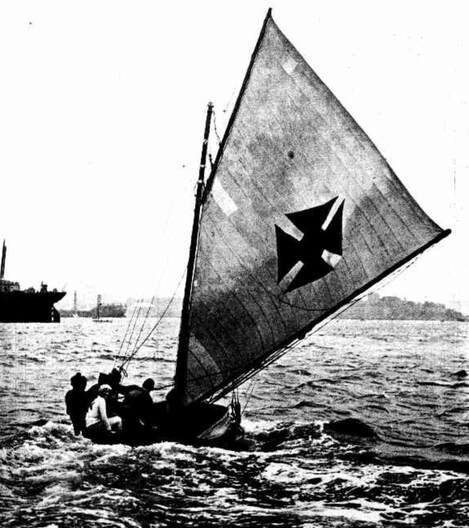
In 1937 and 1939 newspapers told of rumors that the boat would sail again, including a mention that Bob Budnick’s son V Budnick who was a prominent skipper of 12’ skiffs would sail her. This never eventuated, and at some stage Mississippi was turned into a launch. She survived until the 1980’s, when she was cut up, unfortunately without being measured and documented first. Her chainplates have survived in the collection at the Sydney Flying Squadron.
The above photo of Mississippi has to be from between 1914 and 1934, so I put it up on Facebook and asked if anyone could identify her. Thanks to international Facebook user Matthias Wunsch and Sydney Heritage Fleet’s Mori Flapan the ship has been identified as the GARTHPOOL, which arrived in Sydney from Callao Peru on 7 January 1926 and anchored in Rose Bay (where it is pictured here) for several weeks before moving to Goat Island to remove ballast (that ballast was used to build works on Goat Island), then to Pyrmont to load wheat. She left Sydney on 1 March for Falmouth. GARTHPOOL was the last British-owned sailing ship in trade (Canadian actually) when she went ashore on the Cape Verde Islands in 1929.Great work from the ship experts! The photo must have been taken in January or early February 1926.
Myra Too 1950
Builder: Bill Barnett for himself.
Known Dimensions: 18’ x 6’ beam.
Insignia: ‘M’ in blue oval
Known Dimensions: 18’ x 6’ beam.
Insignia: ‘M’ in blue oval
Bill Barnett built Myra Too in 1950 to replace his original Myra in which he had won the Australian Championship in 1948-49. He fronted up to defend his title the next season but was not able to gain a podium finish, being beaten easily by Queensland’s Lance Watts in Culex III.
Myra Too debuted in the opening race on 30 September 1950 and was unplaced off scratch. On 4 November they won the Sydney Flying Squadron Championship race. At that time officials of the SFS and the NSW 18-Footers League were talking to each other and had decided to allow both fleets to compete for selection in the NSW team for the January 1951 Australian title in Sydney. On Sunday 29 October Barnett had sailed as an unofficial entry with the League’s weekly race and was the first boat home, and a week later repeated the effort in an official test race.
In the second test race on 3 December Myra Too was pushed into 2nd place by Len Heffernan in Ace (the former Australia), and both were selected as part of the NSW team, along with two League boats Miss Jantzen (R Turner) and Unique (Horrie Balkwell). As a warm-up for the. Australian Championship Myra Too won the NSW Championship on 13 January. The Australian title was held in three heats. Worryingly for Barnett he was beaten into 4th place by Culex III and two other Queensland boats in the first heat on 20 January but won the second and third heat to clinch the title. A few days later the JJ Giltinan (the World’s Championship) commenced in three heats, and Myra Too won all three heats, against a competitive fleet that included the much fancied Tarua (Jack Logan, New Zealand), so they had won Club, State, National and World Championships in the one season! An International Handicap race was held between the second and third heats, and Myra Too was unplaced...the race was won by a very young Jack Hamilton in JMH, followed by Tarua and Jenny IV ( Norm Wright, Qld). With a few more wins in handicap events in the rest of the season, Myra Too ended up with a total of 15 wins in the season, breaking the record held by Billo Hayward in Swansea a few seasons before.
Myra Too debuted in the opening race on 30 September 1950 and was unplaced off scratch. On 4 November they won the Sydney Flying Squadron Championship race. At that time officials of the SFS and the NSW 18-Footers League were talking to each other and had decided to allow both fleets to compete for selection in the NSW team for the January 1951 Australian title in Sydney. On Sunday 29 October Barnett had sailed as an unofficial entry with the League’s weekly race and was the first boat home, and a week later repeated the effort in an official test race.
In the second test race on 3 December Myra Too was pushed into 2nd place by Len Heffernan in Ace (the former Australia), and both were selected as part of the NSW team, along with two League boats Miss Jantzen (R Turner) and Unique (Horrie Balkwell). As a warm-up for the. Australian Championship Myra Too won the NSW Championship on 13 January. The Australian title was held in three heats. Worryingly for Barnett he was beaten into 4th place by Culex III and two other Queensland boats in the first heat on 20 January but won the second and third heat to clinch the title. A few days later the JJ Giltinan (the World’s Championship) commenced in three heats, and Myra Too won all three heats, against a competitive fleet that included the much fancied Tarua (Jack Logan, New Zealand), so they had won Club, State, National and World Championships in the one season! An International Handicap race was held between the second and third heats, and Myra Too was unplaced...the race was won by a very young Jack Hamilton in JMH, followed by Tarua and Jenny IV ( Norm Wright, Qld). With a few more wins in handicap events in the rest of the season, Myra Too ended up with a total of 15 wins in the season, breaking the record held by Billo Hayward in Swansea a few seasons before.
Myra Too’s second rig main was gaff-rigged, the number one rig (previous photo) was Bermudan.
Myra Too’s performance and that of the other 6’-beamers convinced the League to allow boats of any beam to compete in their club races, which they had resisted for several years. Five new boats were built for the next season.
Myra Too only raced under that name for the one season. Bill Barnett sold the boat to Jack Boyd who renamed her Merle and raced with moderate success for several seasons, the highlight of which was coming second to Barnett in his new Myra III in the SFS Championship in November 1951. Boyd then sold the boat to James Watt who renamed her Minnawatta II and campaigned for several more seasons.
Myra Too only raced under that name for the one season. Bill Barnett sold the boat to Jack Boyd who renamed her Merle and raced with moderate success for several seasons, the highlight of which was coming second to Barnett in his new Myra III in the SFS Championship in November 1951. Boyd then sold the boat to James Watt who renamed her Minnawatta II and campaigned for several more seasons.
Bill Barnett comes alongside the ferry to receive the winner’s pennant in the JJ Giltinan in February 1951. All photos from Hall Collection, ANMM.
N.S.W. 1922
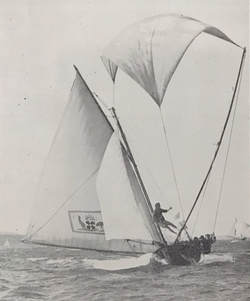
Builder: Sam Williams for H.E.Thompson.
Known Dimensions: 17'11 3/4" x 7'8 1/2" beam, 2'3 1/2" depth.
Insignia: Modified Australian coat-of-arms, carried over from his earlier boat Advance. In fact he transferred the whole rig over to N.S.W. when he sold the hull of Advance.
Owner/skipper "Happy" Harry Thompson had sailed his Williams-built 18-footer Advance from 1909 to 1922 when he sold her and went back to Williams for a new boat. Advance had never been a Championship boat mostly with mid-range to long-marker handicaps, and Harry had high hopes of the new boat being a Champion.
N.S.W. was launched at Balmain (even though builder Sam Williams worked on Kogarah Bay at the time) on 9 September 1922 and gained 5th in her first race on 30 September in a fresh Nor'Easter which was a promising result. Her first win was in December, with another in February in handicap races but it was not enough to stop her handicap creeping out. N.S.W. was never a champion boat, in fact it would be pretty right to say she was not significantly any improvement on Advance. In fact Harry had many close battles with Advance mainly steered by George Deegan in the 1920's and 30's. Harry, also sometimes referred to in the press as "Wallaby" Thompson sailed N.S.W. right up to the 1941-42 season with the SFS, always a mid- to long-marker but consistently winning one or two handicap races a season, and for some reason it was often the first race or the last race of the season. The photo is from Australian Motor Boating and Yachting Monthly April 1926, with the caption remarking that N.S.W. was "a notable sail carrier in a breeze". This feature and Harry's consistency and good humour meant that he was always popular with the punters.
Descendants of Happy Harry Thompson donated a collection of memorabilia to the SFS in 2016 including photo albums and a model boat.
Known Dimensions: 17'11 3/4" x 7'8 1/2" beam, 2'3 1/2" depth.
Insignia: Modified Australian coat-of-arms, carried over from his earlier boat Advance. In fact he transferred the whole rig over to N.S.W. when he sold the hull of Advance.
Owner/skipper "Happy" Harry Thompson had sailed his Williams-built 18-footer Advance from 1909 to 1922 when he sold her and went back to Williams for a new boat. Advance had never been a Championship boat mostly with mid-range to long-marker handicaps, and Harry had high hopes of the new boat being a Champion.
N.S.W. was launched at Balmain (even though builder Sam Williams worked on Kogarah Bay at the time) on 9 September 1922 and gained 5th in her first race on 30 September in a fresh Nor'Easter which was a promising result. Her first win was in December, with another in February in handicap races but it was not enough to stop her handicap creeping out. N.S.W. was never a champion boat, in fact it would be pretty right to say she was not significantly any improvement on Advance. In fact Harry had many close battles with Advance mainly steered by George Deegan in the 1920's and 30's. Harry, also sometimes referred to in the press as "Wallaby" Thompson sailed N.S.W. right up to the 1941-42 season with the SFS, always a mid- to long-marker but consistently winning one or two handicap races a season, and for some reason it was often the first race or the last race of the season. The photo is from Australian Motor Boating and Yachting Monthly April 1926, with the caption remarking that N.S.W. was "a notable sail carrier in a breeze". This feature and Harry's consistency and good humour meant that he was always popular with the punters.
Descendants of Happy Harry Thompson donated a collection of memorabilia to the SFS in 2016 including photo albums and a model boat.
Nerang II 1947
Builder: Roy Phillips for Jack North Snr, a 7-ft beamer.
Insignia: Black rectangle, white diamond.
Jack North Snr commissioned Roy Phillips to build Nerang II to replace Nerang which he and his sons Jack Jnr and Jim (an early member of the AHSSA and stalwart of the Sydney Flying Squadron until his death a few years ago) had campaigned for several seasons after purchasing it from the estate of Wally Holmes. Alf Beashel was engaged as skipper in December 1944 after 4 other skippers were tried and had the boat’s first win in February 1945. Jack North Snr resumed steering in the 1945-46 season and they had three wins in 1946-47. The first Nerang had been built by Tom Phillips in 1937 as Hope.
Insignia: Black rectangle, white diamond.
Jack North Snr commissioned Roy Phillips to build Nerang II to replace Nerang which he and his sons Jack Jnr and Jim (an early member of the AHSSA and stalwart of the Sydney Flying Squadron until his death a few years ago) had campaigned for several seasons after purchasing it from the estate of Wally Holmes. Alf Beashel was engaged as skipper in December 1944 after 4 other skippers were tried and had the boat’s first win in February 1945. Jack North Snr resumed steering in the 1945-46 season and they had three wins in 1946-47. The first Nerang had been built by Tom Phillips in 1937 as Hope.
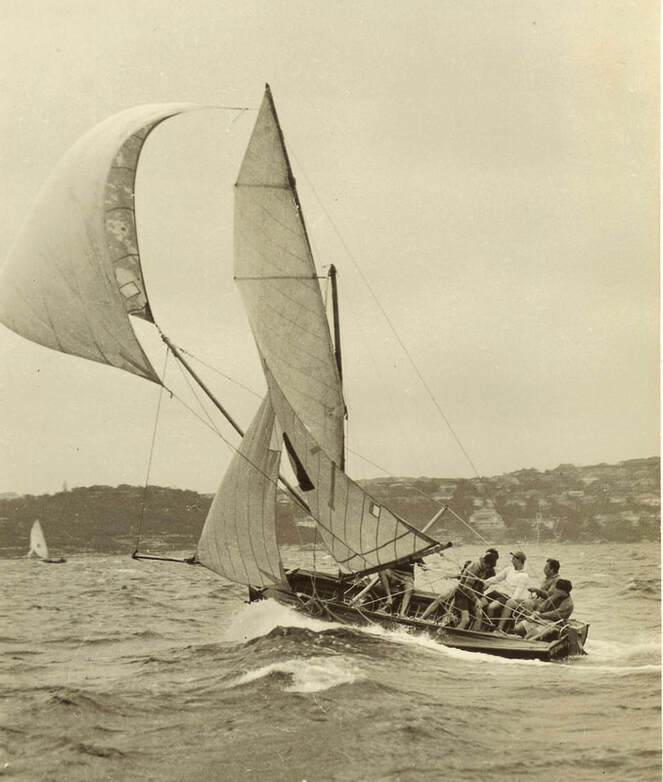
Nerang II debuted in a SFS handicap race on 15 November 1947 but withdrew with too big a rig up. Jack North Snr steered some of the time but mostly handed the tiller to Jack Jnr but the boat did not feature in the prize money until a young Len Heffernan was engaged to steer for the second half of the 1947-48 season and gained several places.
Jack North Jnr again steered for the 1948-49 season with very little success, quite a few capsizes and several withdrawals which suggest they may have often been optimistic in rig selection! Capsizes and withdrawals continued into the 1949-50 season but the new skipper H ‘Toc’ Winning led them to 2 wins that season and another in the 1950–51 season, plus a few places in the 1951-52 season which was their last. The boat was replaced by Nerang III early in the 1952-53 season.
Jack North Jnr again steered for the 1948-49 season with very little success, quite a few capsizes and several withdrawals which suggest they may have often been optimistic in rig selection! Capsizes and withdrawals continued into the 1949-50 season but the new skipper H ‘Toc’ Winning led them to 2 wins that season and another in the 1950–51 season, plus a few places in the 1951-52 season which was their last. The boat was replaced by Nerang III early in the 1952-53 season.
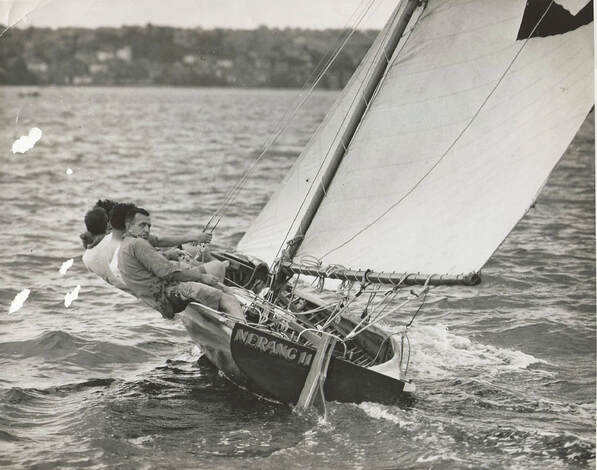
Above: A similar photo to the first. This one has Jack North Jnr on the helm with Jack Snr on sheet. The first photo appears to have Jack Snr on helm, Jack Jnr on sheet and I can recognise Jim North frd.
Left: Jack North Snr at the helm on this upwind shot
Left: Jack North Snr at the helm on this upwind shot
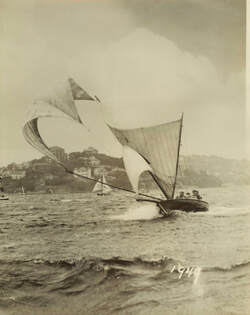
This is a classic shot of Nerang II blasting away from Point Piper. Apparently they survived this. All 4 photos are from John Stanley’s collection.
Nimrod 1909
Builder: Billy Golding*, for Tom Sherley.
Sail insignia: Maroon pennant, gold cross.
Nimrod debuted well, winning the third-most prize money (46 pounds) in 1909-10 under skipper Charley Hayes* (a boatbuilder in his own right). She remained successful, becoming the SSC Champion in 1911. She was the sole NSW representative in the Mark Foy Challenge Cup in Perth in January 1912 but was beaten by local boats. W. Keddie took over the tiller in 1912-13, but W.J."Billy" Duncan* took over in 1913-14 and sailed for three seasons. The boat did not start in the 1916-17 season and was sold to Tom Golden in February 1917. Duncan was appointed skipper again and made her the scratch boat in 1917-18. In the first half of the 1918-19 season she sailed as Nimrod, but in the second half Golden re-registered her as Mascotte. Billy Duncan continued to steer, making her the SSC Champion in 1919, but was replaced by his cousin W.C."Trappy" Duncan from the 1920-21 season. In March 1923 she was sold to a syndicate headed by R.Holmes and renamed Awaya, mostly skippered by Billy Dunn for a few seasons. Sold again in 1925 to J.Hall, the name reverted to Mascotte and was the SFS Champion under Trappy Duncan again in 1925. More details under listing for Mascotte.
Sail insignia: Maroon pennant, gold cross.
Nimrod debuted well, winning the third-most prize money (46 pounds) in 1909-10 under skipper Charley Hayes* (a boatbuilder in his own right). She remained successful, becoming the SSC Champion in 1911. She was the sole NSW representative in the Mark Foy Challenge Cup in Perth in January 1912 but was beaten by local boats. W. Keddie took over the tiller in 1912-13, but W.J."Billy" Duncan* took over in 1913-14 and sailed for three seasons. The boat did not start in the 1916-17 season and was sold to Tom Golden in February 1917. Duncan was appointed skipper again and made her the scratch boat in 1917-18. In the first half of the 1918-19 season she sailed as Nimrod, but in the second half Golden re-registered her as Mascotte. Billy Duncan continued to steer, making her the SSC Champion in 1919, but was replaced by his cousin W.C."Trappy" Duncan from the 1920-21 season. In March 1923 she was sold to a syndicate headed by R.Holmes and renamed Awaya, mostly skippered by Billy Dunn for a few seasons. Sold again in 1925 to J.Hall, the name reverted to Mascotte and was the SFS Champion under Trappy Duncan again in 1925. More details under listing for Mascotte.
No Mistake 1947
Builder: Lester Woodforth for W Barrett
Sail Insignia: 2+2+4
The original The Mistake* (see below under 'T') raced from 1934 to 1943 and was probably the best boat never to win a Championship. No Mistake was a copy and was probably even more unlucky than the original, though they did win two Championships. A story related to me by the late Ken Minter was that Lester Woodforth measured The Mistake to build the replica but when it didn't seem to be as successful as the original the measurements were checked again and both sides were found to be different. The story was that Lester had measured the slow side! However I believe this story to be apocryphal, as the builder of The Mistake Jack Whereat was a legend and very experienced builder and I can't believe he would have built a significantly asymmetrical boat.
No Mistake was unlucky because the boat was capable of good performances, especially in light breezes but was forced to retire many times each season due to gear failure including two dismastings. In six seasons of racing from 1947-48 to 1952-53 No Mistake won two Championships, the single-race "Cock o' the Harbour" Championship in February 1948 in their first season, and the State Championship in January 1949 which was run over three heats, one of which they won and were close enough in the other heats to win overall. They also got fastest time in a handicap race they won in March 1952. They occasionally got into placings in heats of other Championships but most of their wins were in handicap races in light conditions. The owner W Barrett steered the boat at least once but Bill Dodd was the regular skipper for the whole 6 seasons. They were only without at least one win in one season and had three wins in two of their seasons. But in a couple of seasons they were late scratchings or retired in about a third of the roughly 30 races. As a noted big rig and light weather boat they apparently didn't start often in fresh conditions, or withdrew with broken gear or retired for fear of breaking gear. But when they did win in light weather they often won by large margins. The photos above however are both in fresh conditions and are both from Tom Cuneo's collection. The shot with the large ferry and Bradley's Head in the background was taken on the new course introduced by the League which incorporated a mark off Cremorne Point.
Sail Insignia: 2+2+4
The original The Mistake* (see below under 'T') raced from 1934 to 1943 and was probably the best boat never to win a Championship. No Mistake was a copy and was probably even more unlucky than the original, though they did win two Championships. A story related to me by the late Ken Minter was that Lester Woodforth measured The Mistake to build the replica but when it didn't seem to be as successful as the original the measurements were checked again and both sides were found to be different. The story was that Lester had measured the slow side! However I believe this story to be apocryphal, as the builder of The Mistake Jack Whereat was a legend and very experienced builder and I can't believe he would have built a significantly asymmetrical boat.
No Mistake was unlucky because the boat was capable of good performances, especially in light breezes but was forced to retire many times each season due to gear failure including two dismastings. In six seasons of racing from 1947-48 to 1952-53 No Mistake won two Championships, the single-race "Cock o' the Harbour" Championship in February 1948 in their first season, and the State Championship in January 1949 which was run over three heats, one of which they won and were close enough in the other heats to win overall. They also got fastest time in a handicap race they won in March 1952. They occasionally got into placings in heats of other Championships but most of their wins were in handicap races in light conditions. The owner W Barrett steered the boat at least once but Bill Dodd was the regular skipper for the whole 6 seasons. They were only without at least one win in one season and had three wins in two of their seasons. But in a couple of seasons they were late scratchings or retired in about a third of the roughly 30 races. As a noted big rig and light weather boat they apparently didn't start often in fresh conditions, or withdrew with broken gear or retired for fear of breaking gear. But when they did win in light weather they often won by large margins. The photos above however are both in fresh conditions and are both from Tom Cuneo's collection. The shot with the large ferry and Bradley's Head in the background was taken on the new course introduced by the League which incorporated a mark off Cremorne Point.
Onda 1916
Builder: Charlie Dunn* Berry's Bay for Jim Firth.
Sail Insignia: Triangle with corners Blue, Yellow and Red pre-1923-24 season (Jim Firth's colours), Diamond with red and blue quarters after that under Wal Keddie and Tom Young's ownership.
Jim Firth was a long-time active open boat sailor, owning and racing 9 boats. He started in the old-style 16-footers in the 1880's, and had a 20-footer and several 14-footers, then had his first 18-footer Zena built by Joe Donnelly* in 1905. He usually had other skippers sail her. He replaced her with Enid, the re-named Donnelly II and then had Onda built in 1916. He sailed her himself until his retirement after a forty-year career in 1921. He sold her in 1923 to "Trooper" Wal Keddie and Tom Young. Firth was a long-term Commodore of the Sydney Sailing Club as well as holding some positions with the Sydney Flying Squadron.
Keddie and Tom Young had owned another 18 Moyana and moved her colours over to Onda. The boat was generally a long-marker but won a fair share of prize money under the handicap system, including 47 pounds in 1924-25 season, a fair amount when an 18 could be had for 300 pounds. In his ownership Jim Firth mostly steered himself, and under Wal Keddie and Tom Young, Wal mostly steered for the first few years and Tom Young mostly steered after 1930. The boat had been out of commission for the 27-28 and 28-29 season but resumed in February 1930. It is possible that Wal Keddie may have sold out his share at this point, but he still occasionally steered her. Other helmsmen also regularly appeared in the 1930's including Jack Milham, M.Steadman and Dick Buckingham but mostly Tom Young. Tom Young became ill in 1937 and the boat was withdrawn from racing, after a career spanning 21 years.
The framed picture was donated to the Sydney Flying Squadron by elderly ex-10-footer sailor Alan Lonnon, a wonderful old bloke whom I used to visit for chats about the Tens. Alan was nicknamed "Amazing Memory" and he could recall events and races and people from the 1930's with ease. He had no connection to Onda but was given the picture by a descendant of Allan Cumming (who may have been in the crew) whom he visited in his job of travelling salesman when he showed an interest in the picture on the wall of the chap's office.
Sail Insignia: Triangle with corners Blue, Yellow and Red pre-1923-24 season (Jim Firth's colours), Diamond with red and blue quarters after that under Wal Keddie and Tom Young's ownership.
Jim Firth was a long-time active open boat sailor, owning and racing 9 boats. He started in the old-style 16-footers in the 1880's, and had a 20-footer and several 14-footers, then had his first 18-footer Zena built by Joe Donnelly* in 1905. He usually had other skippers sail her. He replaced her with Enid, the re-named Donnelly II and then had Onda built in 1916. He sailed her himself until his retirement after a forty-year career in 1921. He sold her in 1923 to "Trooper" Wal Keddie and Tom Young. Firth was a long-term Commodore of the Sydney Sailing Club as well as holding some positions with the Sydney Flying Squadron.
Keddie and Tom Young had owned another 18 Moyana and moved her colours over to Onda. The boat was generally a long-marker but won a fair share of prize money under the handicap system, including 47 pounds in 1924-25 season, a fair amount when an 18 could be had for 300 pounds. In his ownership Jim Firth mostly steered himself, and under Wal Keddie and Tom Young, Wal mostly steered for the first few years and Tom Young mostly steered after 1930. The boat had been out of commission for the 27-28 and 28-29 season but resumed in February 1930. It is possible that Wal Keddie may have sold out his share at this point, but he still occasionally steered her. Other helmsmen also regularly appeared in the 1930's including Jack Milham, M.Steadman and Dick Buckingham but mostly Tom Young. Tom Young became ill in 1937 and the boat was withdrawn from racing, after a career spanning 21 years.
The framed picture was donated to the Sydney Flying Squadron by elderly ex-10-footer sailor Alan Lonnon, a wonderful old bloke whom I used to visit for chats about the Tens. Alan was nicknamed "Amazing Memory" and he could recall events and races and people from the 1930's with ease. He had no connection to Onda but was given the picture by a descendant of Allan Cumming (who may have been in the crew) whom he visited in his job of travelling salesman when he showed an interest in the picture on the wall of the chap's office.
Oweenee 1906
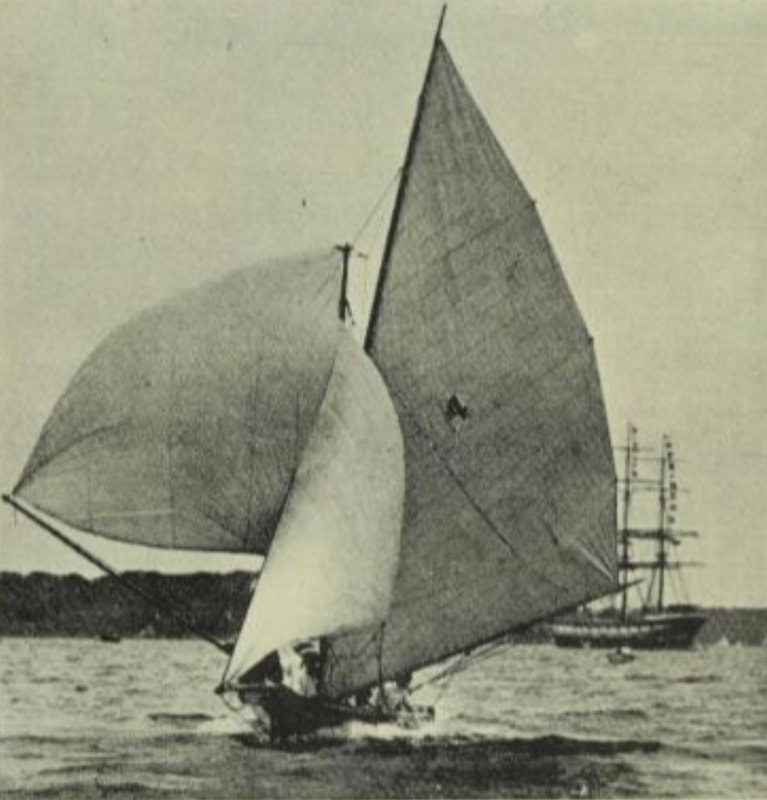
Builder: Joe Donnelly for Tom Banks.
Known dimensions: 5'6" beam.
Tom Banks was a 16-foot skiff sailor whose 16-foot Oweenee was a very successful boat, and along with several other sailing;ors at the time, Banks felt that an 18-footer on 16-footer lines with a skiff-type rig might be competitive with the dominant big-beam class of 18-footers. So he had Joe Donnelly build him the 18-foot Oweenee at 5'6" beam. The whole story of how the boat went and the reaction of the clubs is told in Chapter 4 of The Open Boat book, so I won't repeat it here, suffice it to say that the boat had mixed success which was not enough to convince many others to follow in his footsteps, until Toby Whereat came along in 1932 with Aberdare*.
Known dimensions: 5'6" beam.
Tom Banks was a 16-foot skiff sailor whose 16-foot Oweenee was a very successful boat, and along with several other sailing;ors at the time, Banks felt that an 18-footer on 16-footer lines with a skiff-type rig might be competitive with the dominant big-beam class of 18-footers. So he had Joe Donnelly build him the 18-foot Oweenee at 5'6" beam. The whole story of how the boat went and the reaction of the clubs is told in Chapter 4 of The Open Boat book, so I won't repeat it here, suffice it to say that the boat had mixed success which was not enough to convince many others to follow in his footsteps, until Toby Whereat came along in 1932 with Aberdare*.
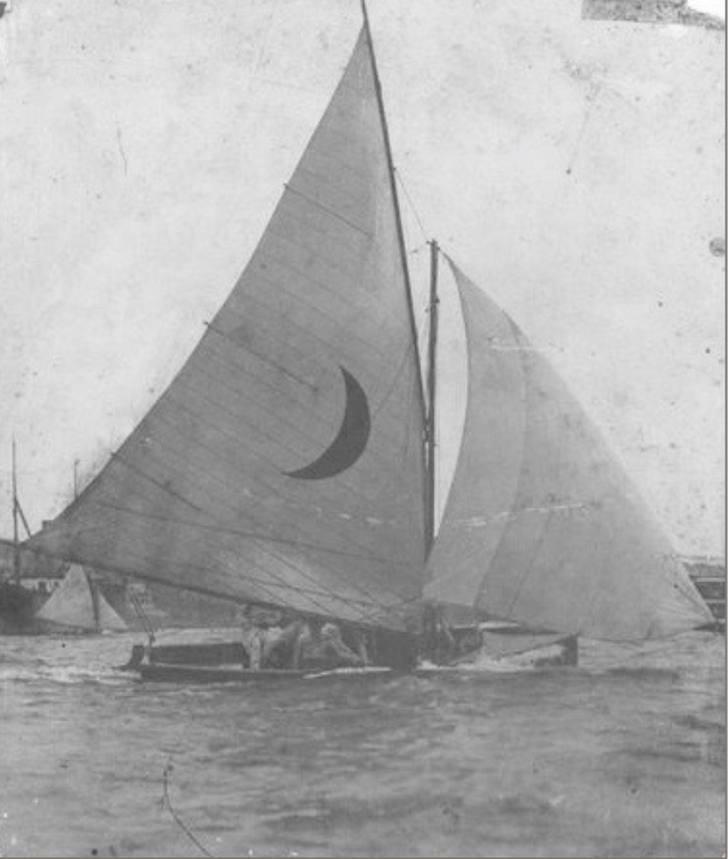
Oweenee shows her distinctive skiff-type rig. Both images from the John Stanley collection.
Pastime 1910
Builder: Frank W Coleman for himself.
Sail Insignia: Red Horseshoe
Pastime was reported to be a very large beamy 18-footer and planked in Queensland Maple rather than the almost universal Australian Red Cedar. Coleman launched Pastime in Brisbane on 22 October 1910 and had their first race that day, in which they came second. There were just a few more races before the Interstate Challenge race in Brisbane on 27 December and Pastime won. It was noted at the time that the two NSW entrants Advance and Arthur were not leading boats in Sydney’s fleet. Coleman felt justified in bringing Pastime down to Sydney at his own expense the next season (1911-12) to defend his title, and received a boost when he won the first race, a handicap race at the Anniversary Day Regatta. But in the Championship race a week later Pastime could do no better than fourth.
Coleman left Pastime in Sydney for sale, and she was purchased in August 1912 by W Cook. Cook steered in a few races in October 1912 but had little luck, including one capsize. For the Sydney Flying Squadron Championship in November he engaged a leading skipper Jack Smith who managed to get third place.
Sail Insignia: Red Horseshoe
Pastime was reported to be a very large beamy 18-footer and planked in Queensland Maple rather than the almost universal Australian Red Cedar. Coleman launched Pastime in Brisbane on 22 October 1910 and had their first race that day, in which they came second. There were just a few more races before the Interstate Challenge race in Brisbane on 27 December and Pastime won. It was noted at the time that the two NSW entrants Advance and Arthur were not leading boats in Sydney’s fleet. Coleman felt justified in bringing Pastime down to Sydney at his own expense the next season (1911-12) to defend his title, and received a boost when he won the first race, a handicap race at the Anniversary Day Regatta. But in the Championship race a week later Pastime could do no better than fourth.
Coleman left Pastime in Sydney for sale, and she was purchased in August 1912 by W Cook. Cook steered in a few races in October 1912 but had little luck, including one capsize. For the Sydney Flying Squadron Championship in November he engaged a leading skipper Jack Smith who managed to get third place.
Cook steered himself in the Mark Foy Challenge Cup on 18 January 1913, recognized as the Australian Championship as there were two boats from Western Australia and two boats from Queensland including Frank Coleman’s new boat Colonial. They faced four Sydney boats Pastime being one of them in spite of controversy over her representing NSW when she had represented Queensland the year before. Pastime’s jib burst and she was out of it. Cook steered again the following week in a handicap race which became known as the Westana Gale because only WA’s Westana finished the race. The whole story of THE 1913 INTERSTATES AND THE WESTANA GALE is on the YARNS Page.
Cook engaged other skippers in the latter part of that season, including Jack Smith, Dally Messenger and Syd Richardson. The boat finished up mid-field in prize money. Syd Richardson continued to steer for most of the next seven seasons, winning moderate amounts of prize money, the highlight being a win in the SFS Championship in the 1918-19 season. The lowlights included “an unenviable record of capsizes and disqualifications” (1918) as well as breakages.
In the 1920-21 season a new skipper George Drysdale appeared, and this may have been because the boat changed hands sometime that season, being bought by Duncan McPhee. Pastime had three wins, two 2nds and three 3rds that season and was 3rd highest prize money winner.
Cook engaged other skippers in the latter part of that season, including Jack Smith, Dally Messenger and Syd Richardson. The boat finished up mid-field in prize money. Syd Richardson continued to steer for most of the next seven seasons, winning moderate amounts of prize money, the highlight being a win in the SFS Championship in the 1918-19 season. The lowlights included “an unenviable record of capsizes and disqualifications” (1918) as well as breakages.
In the 1920-21 season a new skipper George Drysdale appeared, and this may have been because the boat changed hands sometime that season, being bought by Duncan McPhee. Pastime had three wins, two 2nds and three 3rds that season and was 3rd highest prize money winner.
In the 1921-22 season Drysdale moved on and McPhee engaged Charlie Burton and then Paddy Lloyd to steer but the next season he engaged Sid Holmes who featured prominently in handicap events, coming 4th on the prize money table. Sid Holmes remained skipper for the boat’s last five seasons, finishing up in the 1926-27 season managing mid-field in prize money. Pastime was sold to the South Coast of NSW at the end of that season and may have been turned into a launch. In August 1927 it was announced that Charlie Dunn was finishing off a new Pastime II for Duncan McPhee, and this boat raced until 1935 when it was replaced with Pastime III which raced up until the 1936-37 season, so the Red Horseshoe was seen for 27 seasons on Sydney Harbour.
All images from ANMM Hall Collection
All images from ANMM Hall Collection
Quibree 1912
Builder: Sam Williams* for Orlando (Lan) Taylor*. The boat "Looks like a small edition of the 22' Keriki (Taylor's previous boat), high bow, plenty of sheer, but a bit more like 18' Mavis aft". (Sam Williams had built all three boats).
Insignia: Red and blue crescent.
Taylor ran the Federal Boatsheds in Lavender Bay and named her Quibree after an old property at the head of the Bay that had been subdivided. Quibree had her first race on 12 October 1912 and was unplaced. That season she was low on the prize-winning list for both the SSC and the SFS. Lan Taylor was criticised for trying to carry too much sail and too large a crew when it was said that builder Sam Williams had advised him to carry a small rig and crew. The boat was always a middle-marker in the handicaps, hovering around 3 minutes handicap at the SFS when the long markers were on about 4 or 5 minutes for the short triangular races. She appears not to have won a race in her first three seasons. In her third season, 1914-15 Lan Taylor tried out several up and coming young skippers including P.Harry, Wal Keddie and T.Ravell, but Taylor took over again late that season. Her first win was in the final on 16 October 1915. In the next season, 1916-17 she won a heat on 23 September 1916 and then a heat and the final a week later. That season she was in the middle of the range of prize money winners. Lan Taylor sailed Quibree until the 1918-19 season, and sold her to Port Stephens in February 1919. In 1920 Taylor bought the 18-footer Thelma III built by Norman Wright Sen* in Brisbane in 1919 and renamed her Keriki, after his old 22-footer, and carried the same red and blue crescent logo.
Insignia: Red and blue crescent.
Taylor ran the Federal Boatsheds in Lavender Bay and named her Quibree after an old property at the head of the Bay that had been subdivided. Quibree had her first race on 12 October 1912 and was unplaced. That season she was low on the prize-winning list for both the SSC and the SFS. Lan Taylor was criticised for trying to carry too much sail and too large a crew when it was said that builder Sam Williams had advised him to carry a small rig and crew. The boat was always a middle-marker in the handicaps, hovering around 3 minutes handicap at the SFS when the long markers were on about 4 or 5 minutes for the short triangular races. She appears not to have won a race in her first three seasons. In her third season, 1914-15 Lan Taylor tried out several up and coming young skippers including P.Harry, Wal Keddie and T.Ravell, but Taylor took over again late that season. Her first win was in the final on 16 October 1915. In the next season, 1916-17 she won a heat on 23 September 1916 and then a heat and the final a week later. That season she was in the middle of the range of prize money winners. Lan Taylor sailed Quibree until the 1918-19 season, and sold her to Port Stephens in February 1919. In 1920 Taylor bought the 18-footer Thelma III built by Norman Wright Sen* in Brisbane in 1919 and renamed her Keriki, after his old 22-footer, and carried the same red and blue crescent logo.
Rosetta 1915
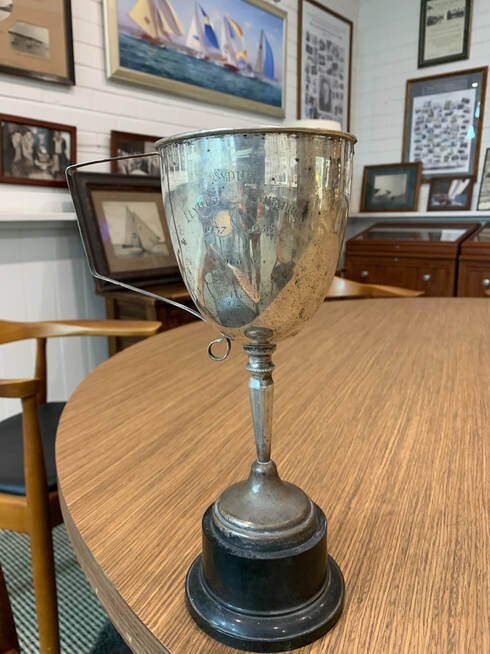
Builder: Fred Newton for himself and brother Charlie Newton.
Sail Insignia: In later years a red and blue ball. Robin Elliott believes in the early years it carried a red Commonwealth flag as insignia.
Fred "Podge" Newton was a champion 16-footer sailor and amateur boatbuilder. As well as several 16-footers he built an 18-footer Admiral II in 1913 but sold it in 1914 when it was renamed Mississippi and had a long career. He did not sail Rosetta often as he was the Fisheries inspector at Port Macquarie on the North Coast of NSW until 1919 when he was transferred to Newcastle. He sailed his self-built 16-footer Vaucluse on the Hunter River in Newcastle winning multiple Club Championships as well as an Interstate Championship against Queensland. Brother Charlie steered Rosetta in most races in the early years. Their first race was the season opening race on 18 November 1915 but in a light wind race Rosetta was so far astern of the leaders in the first heat that they gave up. By November they had only achieved a third place in a heat and a fifth in a final, but on 28 November they won the double, a heat and the final with Fred at the helm. They ended the season with more places, and won a total of thirty-five pounds for the season, about mid-field.
Charlie proved he could do it too by winning a heat and the final at the opening race of their second season in September 1916. There were a few limited successes in the rest of the season and in 1916-17, 1917-18 and 1918-19 seasons. Charlie also moved to Newcastle in February 1919 and the boat missed the last few races of the season.
Rosetta remained in the shed in Watsons Bay where the family came from for the next few years. There were regular rumours in the newspapers about her imminent return to racing but nothing ever came of it. Then in June 1925 Fred collapsed and died aged 62 (and was buried in South Head cemetery). By the start of the next season Rosetta had been sold to Jim Kendall who had been a 16-footer champion (and may have been born in Nova Scotia) who steered her himself and was soon winning and gaining fastest times.
Rosetta was reported to have undergone alterations in the off-season which were blamed for the boat not performing as well in the 1926-27 season, but nevertheless they managed to secure 44 pounds in prize money for the season, above average for the fleet.
While still owned by Jim Kendall, sailing legend Billy Dunn was engaged on the tiller for the next few seasons, and he took the boat to more handicap wins, coming fourth in the prizewinning table in the 1928-29 season.
In March 1930 Kendall sold the boat to Charlie Burton's syndicate, and Charlie steered for quite a few seasons, winning a few races, but he occasionally engaged Joe Pearce and Trappy Duncan as skippers. This paid off when Trappy Duncan steered Rosetta into 2nd place in the State Championship in January 1933, and to victory in the Sydney Flying Squadron Championship on 10 November 1934 (Britannia was 2nd and there was a dead heat for 3rd between Kismet and HC Press II).
Frank Deady may have purchased Rosetta from Charlie Burton at the beginning of the 1935-36 season, or perhaps Burton simply engaged Deady (who had also come from 16's) as regular skipper because Burton does not appear at the helm again. Deady skippered with moderate success for several seasons, starting off his score by winning the postponed Anniversary Regatta handicap in April 1936 (postponed because of the death of the King in late January). Trappy Duncan however did make at least one further appearance at the tiller, gaining a 2nd to Yendys in the Port Jackson Championship in February 1937.
In October 1937 Deady steered the boat to victory by 8 seconds in a very close race where the first 5 boats finished within 55 seconds. He won 10 pounds and a cup which has recently turned up again (pictured).
Rosetta was withdrawn from racing at the end of the 1937-38 season. Frank Deady moved over to steer Kiwi and continued to have a long career in 18-footers.
Sail Insignia: In later years a red and blue ball. Robin Elliott believes in the early years it carried a red Commonwealth flag as insignia.
Fred "Podge" Newton was a champion 16-footer sailor and amateur boatbuilder. As well as several 16-footers he built an 18-footer Admiral II in 1913 but sold it in 1914 when it was renamed Mississippi and had a long career. He did not sail Rosetta often as he was the Fisheries inspector at Port Macquarie on the North Coast of NSW until 1919 when he was transferred to Newcastle. He sailed his self-built 16-footer Vaucluse on the Hunter River in Newcastle winning multiple Club Championships as well as an Interstate Championship against Queensland. Brother Charlie steered Rosetta in most races in the early years. Their first race was the season opening race on 18 November 1915 but in a light wind race Rosetta was so far astern of the leaders in the first heat that they gave up. By November they had only achieved a third place in a heat and a fifth in a final, but on 28 November they won the double, a heat and the final with Fred at the helm. They ended the season with more places, and won a total of thirty-five pounds for the season, about mid-field.
Charlie proved he could do it too by winning a heat and the final at the opening race of their second season in September 1916. There were a few limited successes in the rest of the season and in 1916-17, 1917-18 and 1918-19 seasons. Charlie also moved to Newcastle in February 1919 and the boat missed the last few races of the season.
Rosetta remained in the shed in Watsons Bay where the family came from for the next few years. There were regular rumours in the newspapers about her imminent return to racing but nothing ever came of it. Then in June 1925 Fred collapsed and died aged 62 (and was buried in South Head cemetery). By the start of the next season Rosetta had been sold to Jim Kendall who had been a 16-footer champion (and may have been born in Nova Scotia) who steered her himself and was soon winning and gaining fastest times.
Rosetta was reported to have undergone alterations in the off-season which were blamed for the boat not performing as well in the 1926-27 season, but nevertheless they managed to secure 44 pounds in prize money for the season, above average for the fleet.
While still owned by Jim Kendall, sailing legend Billy Dunn was engaged on the tiller for the next few seasons, and he took the boat to more handicap wins, coming fourth in the prizewinning table in the 1928-29 season.
In March 1930 Kendall sold the boat to Charlie Burton's syndicate, and Charlie steered for quite a few seasons, winning a few races, but he occasionally engaged Joe Pearce and Trappy Duncan as skippers. This paid off when Trappy Duncan steered Rosetta into 2nd place in the State Championship in January 1933, and to victory in the Sydney Flying Squadron Championship on 10 November 1934 (Britannia was 2nd and there was a dead heat for 3rd between Kismet and HC Press II).
Frank Deady may have purchased Rosetta from Charlie Burton at the beginning of the 1935-36 season, or perhaps Burton simply engaged Deady (who had also come from 16's) as regular skipper because Burton does not appear at the helm again. Deady skippered with moderate success for several seasons, starting off his score by winning the postponed Anniversary Regatta handicap in April 1936 (postponed because of the death of the King in late January). Trappy Duncan however did make at least one further appearance at the tiller, gaining a 2nd to Yendys in the Port Jackson Championship in February 1937.
In October 1937 Deady steered the boat to victory by 8 seconds in a very close race where the first 5 boats finished within 55 seconds. He won 10 pounds and a cup which has recently turned up again (pictured).
Rosetta was withdrawn from racing at the end of the 1937-38 season. Frank Deady moved over to steer Kiwi and continued to have a long career in 18-footers.
Scot 1906
Builder: Joe Donnelly*, Glebe for Peter Cowie.
Known dimensions: length 17'11 1/2", beam 7'0 1/4", depth 2'5"
Scot has the record for the longest sailing career of an eighteen footer. Starting with the 1906-07 season, only a few seasons after the 18's had emerged as the dominant class, she raced up until the 1947-48 season, and after a seasons's break was reconditioned to sail as Leonie in the 1949-50 season, a total of 43 seasons! The Cowie brothers only kept her for the first three seasons and sold her to a syndicate in November 1910. By 1913 she was owned and skippered by legend Jack Smith who sold her to a Port Macquarie syndicate in 1920, but she was sold back to a Sydney syndicate headed by R.T.Bartley in 1922. Scot sailed in Sydney under several owners throughout the 1920's and '30's and was one of the foundation boats of the League in 1935. Throughout these early years the boat was competitive, mostly with low handicaps. She sailed for two seasons 1938-37 and 1937-38 as Norma D, then changed hands again and was renamed Native. Mostly skippered by footballer Tony Russell these years were the boat's most successful, being the scratch boat at the SFS in 1941-42, and having the best season in 1943-44. Tony Russell had a disagreement with the owner Jack Sleeman who then skippered the boat after February 1945, but he was not the skipper that Russell was and the boat was the limit boat of the fleet by December 1947, and this was her last season as Native. As mentioned there was one more season as Leonie.
Reg Barrington built the AHSSA's second eighteen footer replica in 1996 based on a model of the Scot of doubtful provenance, but the boat still races with the replica fleet, unfortunately with a more modern higher-peaked rig than the one in the photos.
Known dimensions: length 17'11 1/2", beam 7'0 1/4", depth 2'5"
Scot has the record for the longest sailing career of an eighteen footer. Starting with the 1906-07 season, only a few seasons after the 18's had emerged as the dominant class, she raced up until the 1947-48 season, and after a seasons's break was reconditioned to sail as Leonie in the 1949-50 season, a total of 43 seasons! The Cowie brothers only kept her for the first three seasons and sold her to a syndicate in November 1910. By 1913 she was owned and skippered by legend Jack Smith who sold her to a Port Macquarie syndicate in 1920, but she was sold back to a Sydney syndicate headed by R.T.Bartley in 1922. Scot sailed in Sydney under several owners throughout the 1920's and '30's and was one of the foundation boats of the League in 1935. Throughout these early years the boat was competitive, mostly with low handicaps. She sailed for two seasons 1938-37 and 1937-38 as Norma D, then changed hands again and was renamed Native. Mostly skippered by footballer Tony Russell these years were the boat's most successful, being the scratch boat at the SFS in 1941-42, and having the best season in 1943-44. Tony Russell had a disagreement with the owner Jack Sleeman who then skippered the boat after February 1945, but he was not the skipper that Russell was and the boat was the limit boat of the fleet by December 1947, and this was her last season as Native. As mentioned there was one more season as Leonie.
Reg Barrington built the AHSSA's second eighteen footer replica in 1996 based on a model of the Scot of doubtful provenance, but the boat still races with the replica fleet, unfortunately with a more modern higher-peaked rig than the one in the photos.
Swastika 1913
Yes, there was a boat called Swastika but it was long before it became associated with Nazis. The symbol was used by Buddhists, American First Nations and the Celts.
Builder: Charlie Dunn* for E.A.Palmer.
Insignia: Blue swastika.
Swastika was launched in early September 1913 after being built on the moulds of Kismet*, but modified. It was 1" deeper, had more spring and sheer both frd and aft and was expected to be faster. This unfortunately was not the case. Kismet was a champion, but the modifications in Swastika were not an improvement at all. The owner Mr E.A.Palmer previously owned a 16-footer of the same name. The sails were by Dingwall who did most of the 16-footer sails, was housed in Mosman Bay and was skippered for several seasons by C.Stewart. In its first season it finished near the bottom of the prize money earners. Stewart had to wait until its second season to have a win in January 1915, but won again in March. P.Harry mostly steered in the 1916-17 season, but C.Stewart appeared again in the 1917-18 season.
Bill Edney took over as skipper in the 1918-19 season (Bill had been a successful 10-footer skipper). He won a double (heat and final) in March 1919 off 3 1/4 minutes (when the limit was about 4 1/2) with a new mains'l. He continued to steer it for 6 more seasons, and managed to reduce its handicap but it was never a championship boat. The last season it sailed was 1924-25, and it was advertised for sale in March 1926 but it seems it never raced again.
Builder: Charlie Dunn* for E.A.Palmer.
Insignia: Blue swastika.
Swastika was launched in early September 1913 after being built on the moulds of Kismet*, but modified. It was 1" deeper, had more spring and sheer both frd and aft and was expected to be faster. This unfortunately was not the case. Kismet was a champion, but the modifications in Swastika were not an improvement at all. The owner Mr E.A.Palmer previously owned a 16-footer of the same name. The sails were by Dingwall who did most of the 16-footer sails, was housed in Mosman Bay and was skippered for several seasons by C.Stewart. In its first season it finished near the bottom of the prize money earners. Stewart had to wait until its second season to have a win in January 1915, but won again in March. P.Harry mostly steered in the 1916-17 season, but C.Stewart appeared again in the 1917-18 season.
Bill Edney took over as skipper in the 1918-19 season (Bill had been a successful 10-footer skipper). He won a double (heat and final) in March 1919 off 3 1/4 minutes (when the limit was about 4 1/2) with a new mains'l. He continued to steer it for 6 more seasons, and managed to reduce its handicap but it was never a championship boat. The last season it sailed was 1924-25, and it was advertised for sale in March 1926 but it seems it never raced again.
Sylvia Chase 1946
Builder :Roy Phillips
Insignia : Blue Shield, white stripe
Known dimensions: 7-foot beam.
SYLVIA CHASE was built by Roy Phillips and paid for by the Royal Art Society to donate to the East Sydney Police Boys Club to be sailed by club members over 17 years of age. The skipper in the first few seasons was Charlie Miller. The boat was named after a prominent and much-loved volunteer at the Club.
Their first race was the SFS 56th year Championship (won by Wee Georgie Robinson in ABERDARE) and gained a creditable 4th place. The young crew’s inexperience showed however when they capsized in the next two races. In January 1947 they sailed in the series for the SFS Australian Championship which was won in a clean sweep by Brisbane boats (the new 6’-beamers), but SYLVIA CHASE was one of the better-performing NSW boats. They performed well enough in handicap races to be considered the favourite for the Port Jackson Championship in March 1947 when champion helmsman Tony Russell was engaged, but they ended up 7th. They capsized in the last race of that season when sharing the lead.
Their first win was on 1 November 1947 off 7 minutes, after 6 minor placing earlier in the season. They won once more that season in January 1948, still under Charlie Miller.
Jack Boyd (an early member of the AHSSA) took over as skipper for the 1948-49 season, and won his first race on 5 February 1949 with a badly-ripped mains’l after colliding with a disabled yacht. SYLVIA CHASE was mostly on or close to the limit of 8 minutes in that and the following season, also under Jack Boyd.
The boat appears to have sailed for some or all of the 1950-51 season as well, but Jack Boyd bought MYRA TOO off Bill Barnett in Feb 1951 and sailed it from the start of the following season, after which there is no mention of SYLVIA CHASE racing.
The photograph is from John Stanley’s collection.
Insignia : Blue Shield, white stripe
Known dimensions: 7-foot beam.
SYLVIA CHASE was built by Roy Phillips and paid for by the Royal Art Society to donate to the East Sydney Police Boys Club to be sailed by club members over 17 years of age. The skipper in the first few seasons was Charlie Miller. The boat was named after a prominent and much-loved volunteer at the Club.
Their first race was the SFS 56th year Championship (won by Wee Georgie Robinson in ABERDARE) and gained a creditable 4th place. The young crew’s inexperience showed however when they capsized in the next two races. In January 1947 they sailed in the series for the SFS Australian Championship which was won in a clean sweep by Brisbane boats (the new 6’-beamers), but SYLVIA CHASE was one of the better-performing NSW boats. They performed well enough in handicap races to be considered the favourite for the Port Jackson Championship in March 1947 when champion helmsman Tony Russell was engaged, but they ended up 7th. They capsized in the last race of that season when sharing the lead.
Their first win was on 1 November 1947 off 7 minutes, after 6 minor placing earlier in the season. They won once more that season in January 1948, still under Charlie Miller.
Jack Boyd (an early member of the AHSSA) took over as skipper for the 1948-49 season, and won his first race on 5 February 1949 with a badly-ripped mains’l after colliding with a disabled yacht. SYLVIA CHASE was mostly on or close to the limit of 8 minutes in that and the following season, also under Jack Boyd.
The boat appears to have sailed for some or all of the 1950-51 season as well, but Jack Boyd bought MYRA TOO off Bill Barnett in Feb 1951 and sailed it from the start of the following season, after which there is no mention of SYLVIA CHASE racing.
The photograph is from John Stanley’s collection.
Tangalooma 1930
Builder: Ben Cribb to a Colin Clark design, for Colin Clark.
Insignia: Two Black bars
Tangalooma debuted in Brisbane at the beginning of the 1930-31 season and won her first race in the second week, skippered by Jimmy Mindham. She didn't make the team to travel to Sydney to represent Queensland that year but travelled to race in Townsville in North Queensland instead and was second in the local 18 footers Championship. The next season under the same skipper she won the Brisbane Championship, winning all four races and won the one-race Australian Championship on the Brisbane River under Lance Watts. In the 1932-33 season, the revolutionary boat Aberdare* began to outclass her, in fact Tangalooma only beat Aberdare that season in one light race. The Australian title that season was in Sydney, and the Sydney boat Arawatta beat Tangalooma with Aberdare third in a light series and the absence of a big rig for Aberdare. She was then sold in Sydney, or rather Colin Clarke brought several Sydneysiders into a syndicate with him, and the boat remained in Sydney. Billy Dunn skippered Tangalooma with success for the next two seasons, and it was in the middle of the second season, 1934-35 that the Australian 18 Footers League split out of the Sydney Flying Squadron in order to race the newer, narrower, lighter, more skiff-like boats like Aberdare (for full details see Robin Elliott's book Galloping Ghosts, available from Boat Books). In the 1935-36 season Tangalooma won the SFS State Championship, and the Australian Championship skippered by W.C."Trappy" Duncan, against other big-beam boats. She was then shipped back to Brisbane in April 1936 to bolster the big boat group in Queensland where the clubs had also split. She won the 1936-37 big boat Australian Championship under Roy Pythian winning 3/3 heats. Tangalooma did not race in the 1937-38 season, and the big boat group in Brisbane disbanded in May 1938. The boat survived in storage until the 1990's, long enough for a lines plan to be taken off her, and a replica was built by Reg Barrington in 1995, but was unfortunately rigged with a more modern, higher-peaked gaff rig than the one in these photographs.
Insignia: Two Black bars
Tangalooma debuted in Brisbane at the beginning of the 1930-31 season and won her first race in the second week, skippered by Jimmy Mindham. She didn't make the team to travel to Sydney to represent Queensland that year but travelled to race in Townsville in North Queensland instead and was second in the local 18 footers Championship. The next season under the same skipper she won the Brisbane Championship, winning all four races and won the one-race Australian Championship on the Brisbane River under Lance Watts. In the 1932-33 season, the revolutionary boat Aberdare* began to outclass her, in fact Tangalooma only beat Aberdare that season in one light race. The Australian title that season was in Sydney, and the Sydney boat Arawatta beat Tangalooma with Aberdare third in a light series and the absence of a big rig for Aberdare. She was then sold in Sydney, or rather Colin Clarke brought several Sydneysiders into a syndicate with him, and the boat remained in Sydney. Billy Dunn skippered Tangalooma with success for the next two seasons, and it was in the middle of the second season, 1934-35 that the Australian 18 Footers League split out of the Sydney Flying Squadron in order to race the newer, narrower, lighter, more skiff-like boats like Aberdare (for full details see Robin Elliott's book Galloping Ghosts, available from Boat Books). In the 1935-36 season Tangalooma won the SFS State Championship, and the Australian Championship skippered by W.C."Trappy" Duncan, against other big-beam boats. She was then shipped back to Brisbane in April 1936 to bolster the big boat group in Queensland where the clubs had also split. She won the 1936-37 big boat Australian Championship under Roy Pythian winning 3/3 heats. Tangalooma did not race in the 1937-38 season, and the big boat group in Brisbane disbanded in May 1938. The boat survived in storage until the 1990's, long enough for a lines plan to be taken off her, and a replica was built by Reg Barrington in 1995, but was unfortunately rigged with a more modern, higher-peaked gaff rig than the one in these photographs.
The Mistake 1933
Builder: Jack Whereat, Brisbane, for Bob Cuneo.
Insignia:2+2=5
Jack Whereat built The Mistake as a copy of Aberdare*, almost certainly off the same moulds his son Toby had used to build Aberdare. Toby however died soon after Aberdare was launched in 1932. Bob Cuneo from Sydney, a successful 12-footer sailor commissioned the boat but kept everything quiet as Aberdare was beating everything and the big-beam mob were nervous about the the new skiff-type 18's. He registered the boat with the Sydney Flying Squadron in November 1933, but it was allowed only because they couldn't find anything in the rules that could stop it. George Press's skiff-type HC Press IV* was registered at the same meeting, but the Squadron panicked and closed off the books to any subsequent registrations.
Aberdare had been described by one of its detractors as a "narrow-gutted mistake", and Cuneo cheekily named his boat The Mistake and selected 2+2=5 as his sail insignia.
Both The Mistake and HC PressIV began racing with the Squadron in December 1933 without much early success, but HC Press IV won the SFS Championship in January 1934. The Mistake won no races that season but was second in the Bradleys Head Championship in February, and won enough minor prizes to win a total of 42 pounds, 3rd overall despite having only sailed a bit over half a season.
This set the pattern for the story of The Mistake's career. Always a competitive boat, she was often the scratch boat and always close to scratch but the closest they came to winning a Championship was when they won the first heat of the League's Australian Championship in January 1937 and set a timed speed record during that race.
Bob Cuneo sailed The Mistake with moderate success in the first half of the 1934-35 season, but over the Christmas break the rebels who wanted to allow more skiff-types into 18-footer racing formed the Australian 18-Footer Sailing League with former SFS President James Giltinan as President and The Mistake was one of the first boats to throw in its lot with the new club. The League opened its season with three heats of their Australian Championship in February, which was won by Aberdare from Marjorie Too, both from Queensland with The Mistake third.
The 1935-36 saw a number of new boats join the League. The Mistake was second to one of these, the new HC Press V in the December State Championship and had a few handicap wins, but the scratch boat for most of the season was Gwynneth which was the re-named HC Press IV steered by Bert Swinbourne. Another new boat Dee Why also often displaced The Mistake, who was always up there, but only Gwynneth and Dee Why were selected to represent NSW in the Australian Championship in Brisbane, where they were beaten by Aberdare.
Other new boats in the 1936-37 season also continued to edge out The Mistake, including Collaroy which was steered for most of the season by Chris Webb. As reported earlier The Mistake won the first heat of the Australian Championship in Sydney in January 1937 and was fourth and third in the other two heats but Aberdare prevailed again but was actually on even points with another new Sydney boat Lightning, steered by Bert Swinbourne, but as the holder retained the title. The Mistake was third overall.
In August 1937 it was reported that Bob Cuneo had sold The Mistake to EJ Kendall who had a new big rig made with a 26' mast and a main that was 23' on the foot, 14'6"hoist and 19'6" on the gaff. He sailed it once or twice himself, but engaged Sam Monkhouse from the 16-footers to steer as regular skipper. The Mistake remained a very competitive boat but more new boats were joining the fleet all the time, and other skippers were stepping up from the 16-footers, including Billo Hayward steering Malvina which often edged The Mistake out that season, and won the Australian title in Brisbane for which The Mistake was not selected.
The big event of the 1937-38 season was the World Championship for 18-footers, though in fact only the New Zealanders sent a team. They sent several boats from three different classes, none of which resembled the Australian boats beyond being 18' long. A new boat Taree steered by Bert Swinbourne won 2 out of 3 heats and the Championship. The Kiwi boats didn't get a look in, Victor from Queensland winning the third heat. The Mistake was 8th overall on points. They had been runner-up 3 times during the season but had no wins until the final race on 17 April.
They also won one of the earliest races of the 1938-39 season, but another new boat St George gained fastest time that race under Billo Hayward. The Mistake won 4 races that season, but was not selected to go to Auckland for the 1939 World Championship (won by the Kiwis in a controversial circumstances`, but that's another story).
Early in the 1939-40 season The Mistake was on scratch on several occasions and was always close up. In December former owner Bob Cuneo publicly challenged Bert Swinbourne in Taree to a match race with Cuneo steering The Mistake which he proclaimed was the better boat. The match was a great object of discussion and opinion but it never eventuated, partly because Taree and Swinbourne were banned from racing for not returning the World Championship trophy which they won in Sydney in 1938 and claimed to have retained in Auckland in 1939, but the Kiwis disagreed. You can read the whole story in Robin Elliott's Galloping Ghosts.
In November 1940 The Mistake won a heat of the State Championship, but another new boat Eileen II steered by Ernie Ellis took out the title. Owner Kendall must have sold the boat at some stage (but Sam Monkhouse still skippered) because the current owner donated the boat to the League to be raffled in February 1941 and it was reported as being won by a J.Davis but J. White is listed as the owner later that season. Sam Monkhouse continued to steer.
The 1941-42 season started well for The Mistake with 3 wins in the first 5 races, but they still couldn't take any Championships. Their final season was 1942-43 and it was the same old story, they were always close but the new Swansea under Billo Hayward completely dominated the season's racing, with 12 wins out of 21 starts. But Sam and The Mistake won the Queen of the Waves, one of the last races of the season and of the boat's career.
The Mistake would have to be rated as the best boat to never win a Championship.
The first photo is from Tom Cuneo's collection, the second is from Cliff Monkhouse's scrapbook and shows his father Sam and crew in action.
Insignia:2+2=5
Jack Whereat built The Mistake as a copy of Aberdare*, almost certainly off the same moulds his son Toby had used to build Aberdare. Toby however died soon after Aberdare was launched in 1932. Bob Cuneo from Sydney, a successful 12-footer sailor commissioned the boat but kept everything quiet as Aberdare was beating everything and the big-beam mob were nervous about the the new skiff-type 18's. He registered the boat with the Sydney Flying Squadron in November 1933, but it was allowed only because they couldn't find anything in the rules that could stop it. George Press's skiff-type HC Press IV* was registered at the same meeting, but the Squadron panicked and closed off the books to any subsequent registrations.
Aberdare had been described by one of its detractors as a "narrow-gutted mistake", and Cuneo cheekily named his boat The Mistake and selected 2+2=5 as his sail insignia.
Both The Mistake and HC PressIV began racing with the Squadron in December 1933 without much early success, but HC Press IV won the SFS Championship in January 1934. The Mistake won no races that season but was second in the Bradleys Head Championship in February, and won enough minor prizes to win a total of 42 pounds, 3rd overall despite having only sailed a bit over half a season.
This set the pattern for the story of The Mistake's career. Always a competitive boat, she was often the scratch boat and always close to scratch but the closest they came to winning a Championship was when they won the first heat of the League's Australian Championship in January 1937 and set a timed speed record during that race.
Bob Cuneo sailed The Mistake with moderate success in the first half of the 1934-35 season, but over the Christmas break the rebels who wanted to allow more skiff-types into 18-footer racing formed the Australian 18-Footer Sailing League with former SFS President James Giltinan as President and The Mistake was one of the first boats to throw in its lot with the new club. The League opened its season with three heats of their Australian Championship in February, which was won by Aberdare from Marjorie Too, both from Queensland with The Mistake third.
The 1935-36 saw a number of new boats join the League. The Mistake was second to one of these, the new HC Press V in the December State Championship and had a few handicap wins, but the scratch boat for most of the season was Gwynneth which was the re-named HC Press IV steered by Bert Swinbourne. Another new boat Dee Why also often displaced The Mistake, who was always up there, but only Gwynneth and Dee Why were selected to represent NSW in the Australian Championship in Brisbane, where they were beaten by Aberdare.
Other new boats in the 1936-37 season also continued to edge out The Mistake, including Collaroy which was steered for most of the season by Chris Webb. As reported earlier The Mistake won the first heat of the Australian Championship in Sydney in January 1937 and was fourth and third in the other two heats but Aberdare prevailed again but was actually on even points with another new Sydney boat Lightning, steered by Bert Swinbourne, but as the holder retained the title. The Mistake was third overall.
In August 1937 it was reported that Bob Cuneo had sold The Mistake to EJ Kendall who had a new big rig made with a 26' mast and a main that was 23' on the foot, 14'6"hoist and 19'6" on the gaff. He sailed it once or twice himself, but engaged Sam Monkhouse from the 16-footers to steer as regular skipper. The Mistake remained a very competitive boat but more new boats were joining the fleet all the time, and other skippers were stepping up from the 16-footers, including Billo Hayward steering Malvina which often edged The Mistake out that season, and won the Australian title in Brisbane for which The Mistake was not selected.
The big event of the 1937-38 season was the World Championship for 18-footers, though in fact only the New Zealanders sent a team. They sent several boats from three different classes, none of which resembled the Australian boats beyond being 18' long. A new boat Taree steered by Bert Swinbourne won 2 out of 3 heats and the Championship. The Kiwi boats didn't get a look in, Victor from Queensland winning the third heat. The Mistake was 8th overall on points. They had been runner-up 3 times during the season but had no wins until the final race on 17 April.
They also won one of the earliest races of the 1938-39 season, but another new boat St George gained fastest time that race under Billo Hayward. The Mistake won 4 races that season, but was not selected to go to Auckland for the 1939 World Championship (won by the Kiwis in a controversial circumstances`, but that's another story).
Early in the 1939-40 season The Mistake was on scratch on several occasions and was always close up. In December former owner Bob Cuneo publicly challenged Bert Swinbourne in Taree to a match race with Cuneo steering The Mistake which he proclaimed was the better boat. The match was a great object of discussion and opinion but it never eventuated, partly because Taree and Swinbourne were banned from racing for not returning the World Championship trophy which they won in Sydney in 1938 and claimed to have retained in Auckland in 1939, but the Kiwis disagreed. You can read the whole story in Robin Elliott's Galloping Ghosts.
In November 1940 The Mistake won a heat of the State Championship, but another new boat Eileen II steered by Ernie Ellis took out the title. Owner Kendall must have sold the boat at some stage (but Sam Monkhouse still skippered) because the current owner donated the boat to the League to be raffled in February 1941 and it was reported as being won by a J.Davis but J. White is listed as the owner later that season. Sam Monkhouse continued to steer.
The 1941-42 season started well for The Mistake with 3 wins in the first 5 races, but they still couldn't take any Championships. Their final season was 1942-43 and it was the same old story, they were always close but the new Swansea under Billo Hayward completely dominated the season's racing, with 12 wins out of 21 starts. But Sam and The Mistake won the Queen of the Waves, one of the last races of the season and of the boat's career.
The Mistake would have to be rated as the best boat to never win a Championship.
The first photo is from Tom Cuneo's collection, the second is from Cliff Monkhouse's scrapbook and shows his father Sam and crew in action.
Top Weight (II) 1947
Builder: Norman Wright Snr* for Fred Empson
Insignia: Black numeral 1
Fred Empson was one of the racetrack bookmakers that moved into 18-footer racing when the League was set up in 1935 for racing on Sundays. The first Top Weight was built for him by Willets Douglass* in 1941 and raced successfully with the League during the War years, generally with Ray Rawlings as skipper and was often scratch boat, and Fred himself often joined the crew. After the War new boats began to join the fleet and many of the successful ones were built by Norman Wright, so Fred ordered a new boat from him. They missed their first scheduled race in early October 1947 because the boat was late arriving from Brisbane. They retired Top Weight (I) but carried over its rig, sails and gear to the new boat, and Ray Rawlings was still the skipper. They got 6th in their first race but a second in the State Championship in mid-November and were consistently near the money. They were one of the four League boats selected to go to New Zealand for the World Championship in January 1948 (won by Crows Nest). In regular Sunday racing Top Weight hovered on or near scratch and was one of the fastest in the fleet but generally beaten boat-for-boat by Top Dog.
Rawlings and the crew sailed the boat hard. In one notable incident they were the only boat to set a spinnaker in a SW squall in November 1948 but broke their rudder and crashed spectacularly.
In January 1949 the tiller was taken over by an up-and-coming young skipper out of 12-footers, Bish Bolton. Bish kept the boat performing well, winning one of the heats of the World Championship in February 1949 (in Sydney) and several handicap races in the later part of the season. Bish was electrocuted while helping a mate on holidays in May 1949 (see the YARN : THE BISH BOLTON STORY). Top Weight was steered by C.Miller in the 1949-50 season
Fred Epson sold the boat in mid-1950 and retired from the sport. The boat re-appeared in the 50-51 season with W.Jones at the tiller, and in the 1951-52 season under R.Barnes, but was no longer competitive and didn't race after that. The hull survived until the late 1990's (the stem is still a trophy at the Sydney Flying Squadron). AHSSA founder Robert Tearne built a replica in 2000 from the plans still in the archives of Norman Wright and Sons (the lines plan is reproduced in The Open Boat book). The replica Top Weight still races with the replica fleet at the SFS.
Insignia: Black numeral 1
Fred Empson was one of the racetrack bookmakers that moved into 18-footer racing when the League was set up in 1935 for racing on Sundays. The first Top Weight was built for him by Willets Douglass* in 1941 and raced successfully with the League during the War years, generally with Ray Rawlings as skipper and was often scratch boat, and Fred himself often joined the crew. After the War new boats began to join the fleet and many of the successful ones were built by Norman Wright, so Fred ordered a new boat from him. They missed their first scheduled race in early October 1947 because the boat was late arriving from Brisbane. They retired Top Weight (I) but carried over its rig, sails and gear to the new boat, and Ray Rawlings was still the skipper. They got 6th in their first race but a second in the State Championship in mid-November and were consistently near the money. They were one of the four League boats selected to go to New Zealand for the World Championship in January 1948 (won by Crows Nest). In regular Sunday racing Top Weight hovered on or near scratch and was one of the fastest in the fleet but generally beaten boat-for-boat by Top Dog.
Rawlings and the crew sailed the boat hard. In one notable incident they were the only boat to set a spinnaker in a SW squall in November 1948 but broke their rudder and crashed spectacularly.
In January 1949 the tiller was taken over by an up-and-coming young skipper out of 12-footers, Bish Bolton. Bish kept the boat performing well, winning one of the heats of the World Championship in February 1949 (in Sydney) and several handicap races in the later part of the season. Bish was electrocuted while helping a mate on holidays in May 1949 (see the YARN : THE BISH BOLTON STORY). Top Weight was steered by C.Miller in the 1949-50 season
Fred Epson sold the boat in mid-1950 and retired from the sport. The boat re-appeared in the 50-51 season with W.Jones at the tiller, and in the 1951-52 season under R.Barnes, but was no longer competitive and didn't race after that. The hull survived until the late 1990's (the stem is still a trophy at the Sydney Flying Squadron). AHSSA founder Robert Tearne built a replica in 2000 from the plans still in the archives of Norman Wright and Sons (the lines plan is reproduced in The Open Boat book). The replica Top Weight still races with the replica fleet at the SFS.
Vanity 1912
Builder: Norm Wright Snr
Known measurements: Beam 8’4”, depth 2’5”. Mast 28’, boom 28’3”, spinnaker 34’ on foot, 38’ hoist. Ringtail spars 15’. Mast and spars all solid.
Insignia: Black Crescent with central patch.
Vanity was built in 1912 by Norm Wright for Colin Clark, and the boat’s first appearance was at the Wynnum and Manly Regatta on Boxing Day 26 December with Charlie Negus at the tiller. Unfortunately they capsized near the finish. There were only 3-5 boats racing in the 18’s fleet at the Queensland Flying Squadron, and after only a few races Vanity was selected with Colonial to go to Sydney for the Mark Foy Challenge Cup, recognised at the time as the Australian Championship. The story of that carnival can be found in the YARNS Page article The 1913 INTERSTATES and THE WESTANA GALE. Vanity didn’t feature in the results, breaking their mast at the Shark Island gybe mark in the Championship race, and withdrawing from the famous Westana gale race with too much sail up. Charlie Negus had been retained to steer for the series.
Known measurements: Beam 8’4”, depth 2’5”. Mast 28’, boom 28’3”, spinnaker 34’ on foot, 38’ hoist. Ringtail spars 15’. Mast and spars all solid.
Insignia: Black Crescent with central patch.
Vanity was built in 1912 by Norm Wright for Colin Clark, and the boat’s first appearance was at the Wynnum and Manly Regatta on Boxing Day 26 December with Charlie Negus at the tiller. Unfortunately they capsized near the finish. There were only 3-5 boats racing in the 18’s fleet at the Queensland Flying Squadron, and after only a few races Vanity was selected with Colonial to go to Sydney for the Mark Foy Challenge Cup, recognised at the time as the Australian Championship. The story of that carnival can be found in the YARNS Page article The 1913 INTERSTATES and THE WESTANA GALE. Vanity didn’t feature in the results, breaking their mast at the Shark Island gybe mark in the Championship race, and withdrawing from the famous Westana gale race with too much sail up. Charlie Negus had been retained to steer for the series.
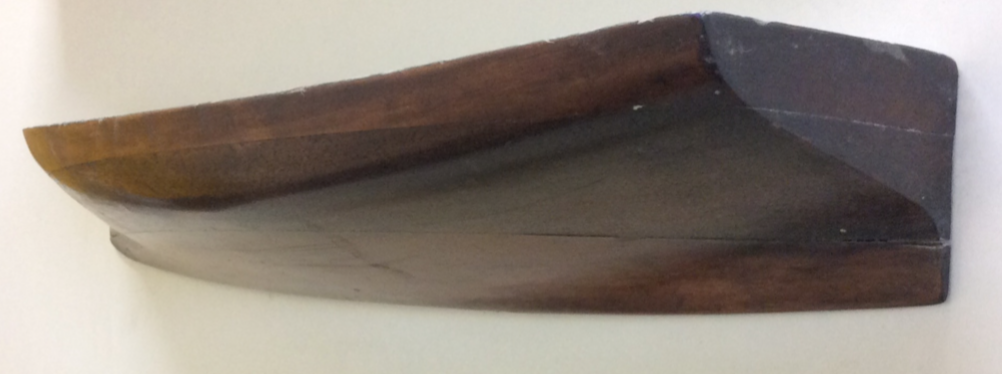
The original half-hull model of Vanity still in the Wright family collection. I drew up a lines plan from this model in 2016 and it appears in The Open Boat book, p46. Norman R. Wright and Sons are still building boats on the Brisbane River, see www.wrightsons.com.au
Owner Colin Clark began steering in Brisbane races for the rest of the season and the first half of the next and won 2 of the 3 test races for selection to represent Queensland in Perth for the next running of the Mark Foy Challenge Cup. Due to business commitments Clark couldn’t go to Perth, but Vanity and crew were sent with Billy Spring steering. They were shipped to Sydney where they joined the same ship as NSW rep Australian (Chris Webb) to travel to Fremantle. She was the first Queensland 18 to race in the West and came 2nd to Australian in the Challenge race. Local champion Westana was 3rd. Vanity also won a handicap race.
Once back in Brisbane Clark resumed local racing with a fleet that now numbered seven and continued into the 1914-15 season with several handicap wins, and a win and enough places in the 3-race test series and Queensland Championship to take out the title on points. In the winter of 1915 Clark sold Vanity to a syndicate who engaged Gerald Klaussen to steer. Klaussen had been a Sydney 10-footer sailor, and was the Australian 10-footer Champion in 1905-06. Clark ordered a new 18-footer to be built by Arthur White, which was launched early in the 1915-16 season as Britannia II, and became quite successful for the next 3 seasons. Norm Wright steered his own new boat Langham and was also successful after 1915.
Klaussen continued a Vanity tradition by capsizing in the first race of the 1915-16 season. He followed this by capsizing 3 more times in that season, was placed only in a couple of races, and was the long marker of 7 and then 8 boats in the fleet. For the 1916-17 season the owners’ syndicate brought in a new skipper, Billy Bergin. Vanity’s performance began to improve. In 21 starts that season they gained four wins, three 2nds, a 3rd, a capsize and were unplaced 12 times. The following season 1917-18 was similar, but in both years none of the wins or placings were in scratch (Championship) events. In Billy Bergin’s third season they returned a bit to form, with placings in several Championship events and were 3rd overall on points in the Queensland Championship. But they couldn’t repeat this form in the 1919-20 season.
The Queensland Flying Squadron had run the 18-footer races since Vanity’s launch, but for the 1920-21 season the new Brisbane 18-Footers Club took over. H Wickham began to steer the boat but wins and places were still elusive for the next two seasons. Jim Crouch a well-respected skipper and boatbuilder bought Vanity from the syndicate in February 1923 and renamed her Quest. Crouch sailed Quest with little more success until he launched the new 18-footer he was building, Queenslander III, and C Crouch and B Crouch appear as the skippers for the rest of the 1923-24 season, which appears to be the boat’s last.
Once back in Brisbane Clark resumed local racing with a fleet that now numbered seven and continued into the 1914-15 season with several handicap wins, and a win and enough places in the 3-race test series and Queensland Championship to take out the title on points. In the winter of 1915 Clark sold Vanity to a syndicate who engaged Gerald Klaussen to steer. Klaussen had been a Sydney 10-footer sailor, and was the Australian 10-footer Champion in 1905-06. Clark ordered a new 18-footer to be built by Arthur White, which was launched early in the 1915-16 season as Britannia II, and became quite successful for the next 3 seasons. Norm Wright steered his own new boat Langham and was also successful after 1915.
Klaussen continued a Vanity tradition by capsizing in the first race of the 1915-16 season. He followed this by capsizing 3 more times in that season, was placed only in a couple of races, and was the long marker of 7 and then 8 boats in the fleet. For the 1916-17 season the owners’ syndicate brought in a new skipper, Billy Bergin. Vanity’s performance began to improve. In 21 starts that season they gained four wins, three 2nds, a 3rd, a capsize and were unplaced 12 times. The following season 1917-18 was similar, but in both years none of the wins or placings were in scratch (Championship) events. In Billy Bergin’s third season they returned a bit to form, with placings in several Championship events and were 3rd overall on points in the Queensland Championship. But they couldn’t repeat this form in the 1919-20 season.
The Queensland Flying Squadron had run the 18-footer races since Vanity’s launch, but for the 1920-21 season the new Brisbane 18-Footers Club took over. H Wickham began to steer the boat but wins and places were still elusive for the next two seasons. Jim Crouch a well-respected skipper and boatbuilder bought Vanity from the syndicate in February 1923 and renamed her Quest. Crouch sailed Quest with little more success until he launched the new 18-footer he was building, Queenslander III, and C Crouch and B Crouch appear as the skippers for the rest of the 1923-24 season, which appears to be the boat’s last.
Vanity on the Brisbane River. Framed photo in the SFS collection. Sorry about the reflection.
Vera 1899?
There was more than one 18-footer named Vera. This image from the University of Newcastle's website is titled "Vera on Lake Macquarie" dated 19 January 1900. An 18-footer Vera is reported as racing at several events on Lake Macquarie (80 miles North of Sydney) about this time. This predates two Sydney boats Vera (1904) and Vera II (1906), but there was a Queensland Vera built by Jack Whereat in 1893 which was a leading race winner in Brisbane in the 1890's and represented Queensland in several Intercolonial contests in both Brisbane in Sydney, including the last one held in Sydney in 1899, after which the boat is advertised for sale in Sydney. At first I thought that it could have been bought by a Lake Macquarie sailor and would therefore be the one is this image. Even though Whereat's sail insignia was a crescent, insignias generally changed with changes of ownership. However further research found that Robin Elliott reports Whereat's boat as being sold to Bowen (Far North Queensland) in 1899, so the boat in the image is probably not the Queensland boat. There were not many 18-footers racing on Lake Macquarie and several that were there were built in Sydney. Any further information on the Lake Macquarie Vera would be appreciated. The image shows a lot of detail. Notice the fin across the thwarts. A glass negative by Ralph Snowball in the Norman Barney collection at the University of Newcastle.
Victor 1936

Victor in Sydney in January 1939 for the Australian Championship. This photo was taken in the second heat which was abandoned after a squall decimated the fleet. Vic Lucas and Victor won the series and was Australian Champion. John Stanley Collection.
Builder: Chick Ware, Brisbane.
Insignia: Blue Oval with Gold V
The 18-footer that gained fame as Victor was actually Victor II. A sailor named Victor Lucas was a leading Queensland 16-footer skipper, a champion in boats named Victor. By the mid-1930’s he was also a champion helmsman in the 21’ Restricted class boats, steering Gwylan. Boatbuilder Chick Ware built a new 18-footer to be named Victor and arranged for Vic Lucas to be the skipper and raffled the boat. It was won by Mr E Sparkes, a member of Gwylan’s crew. The first race on 6 December 1936 didn’t bode well, Victor retired after trailing the field. They gained a few places and even one win over the Summer but were not selected as one of the three Queensland representatives to go to Sydney for the Australian Championship.
In early March 1937 it was announced that Vic Lucas would take over another Chick Ware boat Betty built in 1935 which had gained second place to the legendary Aberdare in the 1936 Australian Championship in Brisbane and re-name her Victor. Chick Ware would take over the first Victor and sail her as Betty.
The new Victor’s first race was at the opening of the next season on 25 September 1937 where she carried away her jib sheets and retired, but in subsequent races Victor began to show promise, gaining fastest time several times and winning several races. Victor was picked to represent Queensland along with Aberdare and Marjorie in Brisbane later that season but a disqualification in the first heat and two seconds meant she was out of a podium finish behind the winner Malvina (NSW), the discarded Betty and Aberdare. Immediately following this series Victor and Aberdare travelled to Sydney for James Giltinan’s first World Championship. With a 3rd, a 7th and a win Victor was 2nd overall, to Taree (NSW).
Back in Brisbane Victor won the Club Championship over 3 heats but could only manage 3rd in the Queensland State title. In the following season she was picked as one of four Queensland boats to travel to Sydney for the Australian Championship in January 1939 where she won two heats and was second in the third, so was the Australian Champion! She continued this season’s success back in Brisbane where she won both Club and State titles.
Builder: Chick Ware, Brisbane.
Insignia: Blue Oval with Gold V
The 18-footer that gained fame as Victor was actually Victor II. A sailor named Victor Lucas was a leading Queensland 16-footer skipper, a champion in boats named Victor. By the mid-1930’s he was also a champion helmsman in the 21’ Restricted class boats, steering Gwylan. Boatbuilder Chick Ware built a new 18-footer to be named Victor and arranged for Vic Lucas to be the skipper and raffled the boat. It was won by Mr E Sparkes, a member of Gwylan’s crew. The first race on 6 December 1936 didn’t bode well, Victor retired after trailing the field. They gained a few places and even one win over the Summer but were not selected as one of the three Queensland representatives to go to Sydney for the Australian Championship.
In early March 1937 it was announced that Vic Lucas would take over another Chick Ware boat Betty built in 1935 which had gained second place to the legendary Aberdare in the 1936 Australian Championship in Brisbane and re-name her Victor. Chick Ware would take over the first Victor and sail her as Betty.
The new Victor’s first race was at the opening of the next season on 25 September 1937 where she carried away her jib sheets and retired, but in subsequent races Victor began to show promise, gaining fastest time several times and winning several races. Victor was picked to represent Queensland along with Aberdare and Marjorie in Brisbane later that season but a disqualification in the first heat and two seconds meant she was out of a podium finish behind the winner Malvina (NSW), the discarded Betty and Aberdare. Immediately following this series Victor and Aberdare travelled to Sydney for James Giltinan’s first World Championship. With a 3rd, a 7th and a win Victor was 2nd overall, to Taree (NSW).
Back in Brisbane Victor won the Club Championship over 3 heats but could only manage 3rd in the Queensland State title. In the following season she was picked as one of four Queensland boats to travel to Sydney for the Australian Championship in January 1939 where she won two heats and was second in the third, so was the Australian Champion! She continued this season’s success back in Brisbane where she won both Club and State titles.
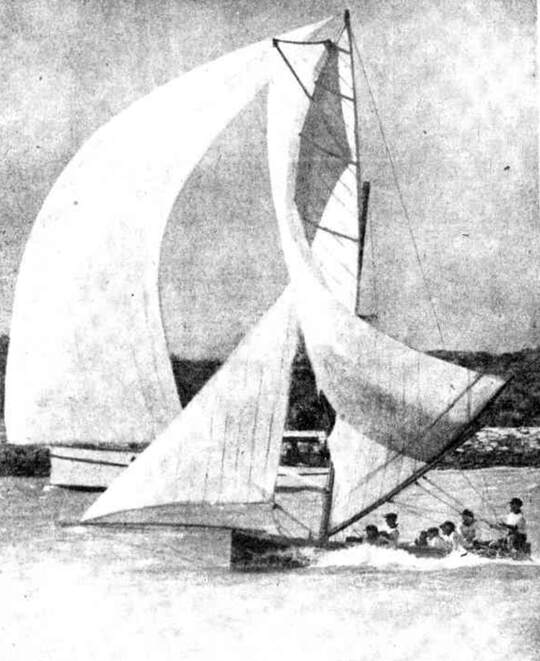
Victor on the Brisbane River, Brisbane Telegraph 22 January 1940.
Victor, Marjorie, Aberdare and Joyce dominated the Brisbane racing for the next few seasons, and it was Marjorie (Lance Watts) that took out the 1939-40 Australian Championship in Brisbane and again in the 1940-41 season in Sydney. Victor began to get the upper hand over Marjorie in the 1941-42 season winning all three test races for the next Australian Championship, which never eventuated. Brisbane 18’s stopped racing in February 1942 a couple of months after Japan’s entry into the War.
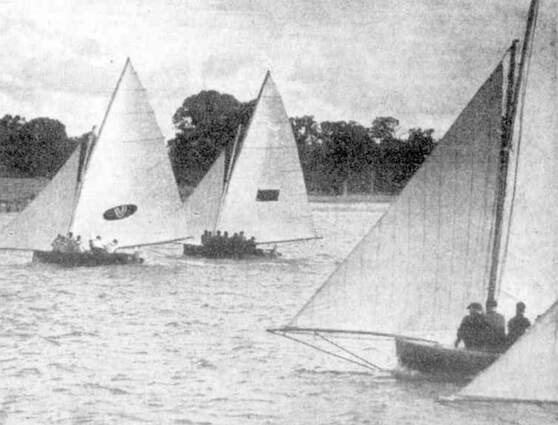
Victor leads the fleet on the way to winning the test race on Sunday 2 February 1941, from the brisbane telegraph 3 Feb 1941
Victor was advertised for sale in October 1942 and was bought by Sydney skipper Horrie Balkwell, and she arrived in Sydney in November. But Horrie’s anticipated success never eventuated because Billo Hayward began sailing Swansea, a new boat built by Lester Woodforth and so dominated the racing (they won more than 12 races that season) that every boat except Victor was pushed out to the limit of five minutes. Horrie got Victor into enough placings to keep her handicap mid-field and even won one race in February. Horrie started the 1943-44 season and won two races but was unwell and retired from racing and sold Victor in November 1943 to Harry Prince, who put Bob Cuneo in charge.
Billo Hayward and Swansea still dominated for the next few seasons and though Bob Cuneo won a few races in Victor each season their handicap varied from 2 1/4 minutes out to the limit of 5.
At the end of the 1945-46 season owner Harry Prince engaged Lester Woodforth to build him a new boat named Planet and the ex-Champion Victor is not heard of again.
Vision (NSW) 1904
This image of Vision was one of the 8 photos on a pair of framed photo groups donated by Mark Foy to Perth Flying Squadron,now back at the Sydney Flying Squadron.
Builder: William Beattie of Balmain for himself.
Insignia: Red crescent
William Beattie was a Balmain resident, likely related to whoever Beattie St was named after, who built several 18-footers for himself but almost always engaged a well-known skipper. Beattie may have sailed in the crew. Vision was launched on Saturday 10 September 1904 just before the start of the season and was described as a “light weather craft, having rather fine lines”. Leading skipper Jack Smith was engaged to steer. Vision was one of several new boats that season as owners and builders responded to the emergence of the 18-footers as the dominant class (see The Open Boat book: The Origin, Evolution and Construction of the Australian 18-Footer on the BOOKS Page).
They entered the opening race of the season on 24 September but were “not prominent”. The following week they dead-heated for 3rd in the final after gaining 2nd in the first heat, off a low handicap. They managed a few more places but no wins and their handicap crept out, until they won a heat on 7 January 1905, and then surprised everybody by winning the SFS Championship race the very next week. They couldn’t repeat this feat in the State Championship a month later, coming 7th, but won an SSC handicap race in March off half a minute, and finished the season 3rd on the prize winnings list.
Jack Smith stayed at the tiller in the early part of the next season and gained a win and a few places, but in January 1906 Smith was enticed away to steer Jim Firth’s new boat Zena, but "The General" George Ellis began to steer Vision regularly and won a handicap race but could not do better than 4th in the State Championship and 7th in the SFS Championship.
Insignia: Red crescent
William Beattie was a Balmain resident, likely related to whoever Beattie St was named after, who built several 18-footers for himself but almost always engaged a well-known skipper. Beattie may have sailed in the crew. Vision was launched on Saturday 10 September 1904 just before the start of the season and was described as a “light weather craft, having rather fine lines”. Leading skipper Jack Smith was engaged to steer. Vision was one of several new boats that season as owners and builders responded to the emergence of the 18-footers as the dominant class (see The Open Boat book: The Origin, Evolution and Construction of the Australian 18-Footer on the BOOKS Page).
They entered the opening race of the season on 24 September but were “not prominent”. The following week they dead-heated for 3rd in the final after gaining 2nd in the first heat, off a low handicap. They managed a few more places but no wins and their handicap crept out, until they won a heat on 7 January 1905, and then surprised everybody by winning the SFS Championship race the very next week. They couldn’t repeat this feat in the State Championship a month later, coming 7th, but won an SSC handicap race in March off half a minute, and finished the season 3rd on the prize winnings list.
Jack Smith stayed at the tiller in the early part of the next season and gained a win and a few places, but in January 1906 Smith was enticed away to steer Jim Firth’s new boat Zena, but "The General" George Ellis began to steer Vision regularly and won a handicap race but could not do better than 4th in the State Championship and 7th in the SFS Championship.
A colourised photo shows Vision's red crescent, and also a regatta number, but not the No 99 'Codger' Abbott carried to victory in the Balmain Regatta of 1906. John Stanley Collection.
Claude “Codger” Abbott took over for the last few races of that season and for most of the next season, 1906-07. He managed 3rd in the SFS Championship in November and a couple of wins, including at the Balmain Regatta. After a subsequent win in early December a commentator mentioned that “ ‘Codger’ flew number 99, which he carried to victory at the Balmain Regatta. Bill Beattie avers that it is a lucky number, and must remain at the peak for ever and aye”. Unfortunately it wasn’t all that lucky, as there were no further wins that season and Abbott died from a stroke in June 1907 though not elderly. The boat though still managed to be 3rd again on the prize money list.
Vision appears not to have raced in the early part of the following season, 1907-08. It is possible that it was too hard to find a skipper, as W Allen from the 24-footer Lottie was supposed to steer Vision in the SSC Championship in early December but this appears not to have happened. The boat was re-registered with the SFS in late December with Thomas Colebrook Jnr as skipper (his own boat Famous to lie idle), and he steered in 3 or 4 races in the rest of the season without success.
Vision appears not to have raced in the early part of the following season, 1907-08. It is possible that it was too hard to find a skipper, as W Allen from the 24-footer Lottie was supposed to steer Vision in the SSC Championship in early December but this appears not to have happened. The boat was re-registered with the SFS in late December with Thomas Colebrook Jnr as skipper (his own boat Famous to lie idle), and he steered in 3 or 4 races in the rest of the season without success.
Vision off Garden Island. John Stanley Collection.
For the 1908-09 season Beattie engaged the relatively-unknown at the time WJ “Billy” Duncan who managed a few placings in handicap races and promisingly 3rd place in both the SSC and State Championships. Duncan steered for the next two seasons as well and began to win races, and kept the handicap small, and they won the SFS Championship in December 1910. A total of 4 wins for the season plus a number of placings meant that they finished 4th on the prize money table.
Though it would seem that Duncan had finally got the boat into gear Beattie was already building a replacement boat which Duncan was engaged to steer for the 1911-12 season. Beattie injured his hand and the new boat was not ready at the start of the season, so Vision took to the water again, but without much success and a bit of bad luck including breaking both mast and bumpkin in a spectacular capsize in October.
The new boat Hero debuted with a 2nd in a heat on 4 November 1911 with Billy Duncan steering, but Hero never became as good a boat as Vision.
Though it would seem that Duncan had finally got the boat into gear Beattie was already building a replacement boat which Duncan was engaged to steer for the 1911-12 season. Beattie injured his hand and the new boat was not ready at the start of the season, so Vision took to the water again, but without much success and a bit of bad luck including breaking both mast and bumpkin in a spectacular capsize in October.
The new boat Hero debuted with a 2nd in a heat on 4 November 1911 with Billy Duncan steering, but Hero never became as good a boat as Vision.
Vision (Queensland) 1919
Photo: Sydney Flying Squadron Collection

Built by Colin Clark and others for Colin Clark as owner/skipper
Insignia: Black Crescent
Known Measurements:
Beam 8’6”
Tuck 6’10”
Depth 2’3”
Spring: frd 13”, aft 4 1/2”
VISION was built to replace Clark’s BRITANNIA II of 1915, in which he’d won the unofficial Australian 18-Footers Championship in Brisbane in 1917. VISION was an immediate success, winning its first event on Boxing Day 1919 in a race off Green Island on Moreton Bay organised by the Manly and Wynnum Yacht Club, then winning the first test race for Interstate selection on 3rd January 1920 run by the Queensland Flying Squadron on the River. The first Interstate Challenge (for the Mark Foy Cup) was due to be held in Brisbane in January 1920 but a ships’ engineers strike prevented the Sydney boats being shipped up. The QFS ran the event as the Queensland Championship on 31 January and VISION won it.
The next season saw the QFS morph into the Brisbane 18-Footers Club, and VISION was the gun boat at the club, always on scratch but sometimes sharing it with LFH built in 1919 by F Coleman and steered by Lance Watts for the owner Win Fowles. Both boats travelled to Sydney in Early 1921 for the Mark Foy Challenge Cup, the recognised Australian Championship for 18-footers. They faced two boats from WA, EURUS and EILEEN and four boats from NSW, MASCOTTE, KISMET, HC PRESS II and BRITANNIA. VISION won by 40 seconds from MASCOTTE and KISMET in fresh conditions. This event was followed by a series of challenge matches between the two Queensland boats and MASCOTTE and KISMET for £100 stake money per boat in which they were beaten by the NSW boats in two straight races in light conditions. LFH who came 4th in both those races was afterwards referred to as Lost Four Hundred.
On returning to Brisbane VISION won the Brisbane 18-Footers Club championship, and was again the scratch boat in her third season (1921-22), but was often beaten by a new boat VIONE. The Mark Foy Challenge Cup was held in Perth that season but no Brisbane boats attended, largely due to bickering about beam restrictions on boats.
VIONE and VISION continued to share the honours in the 1922-23 season. Both boats were fancied in the Mark Foy Challenge Cup that was held in Brisbane that season, and VISION won from VIONE, with KISMET in 3rd. VIONE was actually the more successful boat that season, winning £122/10/- to VISION’s £91. For unknown reasons VISION did not appear in the next season 1923-24. There was a rumour that she would reappear in late 1925 but this never eventuated. Colin Clark made an occasional guest appearance in 1925-26 at the tiller of MARJORIE, most often skippered by Lance Watts, but he owned no 18-footers until he formed a syndicate to have TANGALOOMA built by Ben Cribb in 1930, on the moulds of VISION with a minor adjustment to raise the sheer line forward. These lines are reproduced in The Open Boat book p54.
Insignia: Black Crescent
Known Measurements:
Beam 8’6”
Tuck 6’10”
Depth 2’3”
Spring: frd 13”, aft 4 1/2”
VISION was built to replace Clark’s BRITANNIA II of 1915, in which he’d won the unofficial Australian 18-Footers Championship in Brisbane in 1917. VISION was an immediate success, winning its first event on Boxing Day 1919 in a race off Green Island on Moreton Bay organised by the Manly and Wynnum Yacht Club, then winning the first test race for Interstate selection on 3rd January 1920 run by the Queensland Flying Squadron on the River. The first Interstate Challenge (for the Mark Foy Cup) was due to be held in Brisbane in January 1920 but a ships’ engineers strike prevented the Sydney boats being shipped up. The QFS ran the event as the Queensland Championship on 31 January and VISION won it.
The next season saw the QFS morph into the Brisbane 18-Footers Club, and VISION was the gun boat at the club, always on scratch but sometimes sharing it with LFH built in 1919 by F Coleman and steered by Lance Watts for the owner Win Fowles. Both boats travelled to Sydney in Early 1921 for the Mark Foy Challenge Cup, the recognised Australian Championship for 18-footers. They faced two boats from WA, EURUS and EILEEN and four boats from NSW, MASCOTTE, KISMET, HC PRESS II and BRITANNIA. VISION won by 40 seconds from MASCOTTE and KISMET in fresh conditions. This event was followed by a series of challenge matches between the two Queensland boats and MASCOTTE and KISMET for £100 stake money per boat in which they were beaten by the NSW boats in two straight races in light conditions. LFH who came 4th in both those races was afterwards referred to as Lost Four Hundred.
On returning to Brisbane VISION won the Brisbane 18-Footers Club championship, and was again the scratch boat in her third season (1921-22), but was often beaten by a new boat VIONE. The Mark Foy Challenge Cup was held in Perth that season but no Brisbane boats attended, largely due to bickering about beam restrictions on boats.
VIONE and VISION continued to share the honours in the 1922-23 season. Both boats were fancied in the Mark Foy Challenge Cup that was held in Brisbane that season, and VISION won from VIONE, with KISMET in 3rd. VIONE was actually the more successful boat that season, winning £122/10/- to VISION’s £91. For unknown reasons VISION did not appear in the next season 1923-24. There was a rumour that she would reappear in late 1925 but this never eventuated. Colin Clark made an occasional guest appearance in 1925-26 at the tiller of MARJORIE, most often skippered by Lance Watts, but he owned no 18-footers until he formed a syndicate to have TANGALOOMA built by Ben Cribb in 1930, on the moulds of VISION with a minor adjustment to raise the sheer line forward. These lines are reproduced in The Open Boat book p54.
The image of this commemorative poster of VISION’s crew was sent to me by Robert and Julie Paterson. Robert is the Great-Grandson of William Paterson (bottom right), who was also a champion swimmer.
Yendys 1925
Builder: Charlie Hayes*
Known dimensions: 17'11 3/4" long, 7'2" beam, 2'0" deep.
Insignia: Red Anchor
Yendys was built in 1925 for Norm Blackman who had already established himself as a skipper with two previous boats both called Sydney. All three boats carried the red anchor sail insignia. With a snub nose the boat was considered a rule cheater by some and was only accepted into the SFS after some heated debate. She was always one of the low-handicap boats and often the scratch boat, winning several championships over a long career which finished in 1942 when Norm Blackman became involved in War work at Garden Island Naval Base. Yendys was stored at Norm's home until he sold it to Jack Lloyd for conversion to a launch in the 1950's. She was restored to sailing condition by George McGoogan and apprentices at the Cockatoo island Dockyard and re-launched in 1982, and a few years later donated to the Sydney Heritage Fleet and she is now on permanent display at Wharf Seven Darling Harbour. A laminated replica was built in 2006-7 by the late Ian Perdriau and Col Bailey who was one of the apprentices from Cockatoo who had rebuilt the original boat.
Text condensed from The Open Boat book, photo of George McGoogan with the restored Yendys David Liddle, sailing photo Hall Collection ANMM.
Known dimensions: 17'11 3/4" long, 7'2" beam, 2'0" deep.
Insignia: Red Anchor
Yendys was built in 1925 for Norm Blackman who had already established himself as a skipper with two previous boats both called Sydney. All three boats carried the red anchor sail insignia. With a snub nose the boat was considered a rule cheater by some and was only accepted into the SFS after some heated debate. She was always one of the low-handicap boats and often the scratch boat, winning several championships over a long career which finished in 1942 when Norm Blackman became involved in War work at Garden Island Naval Base. Yendys was stored at Norm's home until he sold it to Jack Lloyd for conversion to a launch in the 1950's. She was restored to sailing condition by George McGoogan and apprentices at the Cockatoo island Dockyard and re-launched in 1982, and a few years later donated to the Sydney Heritage Fleet and she is now on permanent display at Wharf Seven Darling Harbour. A laminated replica was built in 2006-7 by the late Ian Perdriau and Col Bailey who was one of the apprentices from Cockatoo who had rebuilt the original boat.
Text condensed from The Open Boat book, photo of George McGoogan with the restored Yendys David Liddle, sailing photo Hall Collection ANMM.
Yvonne 1895
Builder: Billy Golding*, for himself.
Known measurements: Beam 8' across planking, depth 26". Cedar planking and decking, ribs Native Hickory (Blackwood), keel Spotted Gum, stem "colonial Maple" (probably Queensland Maple), sternpost "colonial Teak"which was Crow's Ash, and mouldings "colonial Ash", most likely Silver Ash. Described as more V-shaped than his previous boats.
Insignia: Green isosceles triangle.
In 1895 Billy Golding was already an established boatbuilder and skipper. He had made his reputation in the 1880's by winning many races with his own 16-footers, and had built many competitive 24's, 22's, 20's and several 18's, starting with Gymea in 1889. He was one of the most respected builders and was central to the development of the 18-footers as a class. The story is told in The Open Boat book.
Yvonne was built as Golding's personal boat, but didn't have an auspicious start, being second last in her first race, an SFS event on 2 November 1895, and was also 2nd last in the Balmain Regatta shortly after. But she must have just needed a bit of working up because she won the JBSC 18' Championship race on 23 November and was second in the SFS 18' Championship a week later, and was selected to travel to Brisbane in December for the Intercolonial Challenge. In three races there Yvonne was second in one and third in both others. She performed well enough in the second half of the season to keep near scratch and win a reasonable amount of prize money.
In the second season, 1896-97 Yvonne featured in a number of handicap wins, and was third across the line in the Intercolonial Championship race in Sydney that season but was disqualified. By March 1897 she had her handicap pushed out to 7 minutes relative to the other 18's in the fleet, largely because of 3 new 18's: Thalia which Golding had built after Yvonne along similar lines and was being steered by Billy Read; Stella II by Edgar Dearing, and Australian* by Sam Williams* which was being steered by Chris Webb*, all of which were very competitive boats and often displaced Yvonne from placings.
In the third season Yvonne had only one win and one third in SFS races and did not much better in JBSC races (the two clubs alternated weekends), though she did come third in the JBSC Championship (to Stella II and Australian).
In July 1898 Golding sold Yvonne to an owner in Botany Bay down the coast. She raced there for several seasons, but visited Sydney Harbour on a number of occasions for special races, mostly steered by Fred Doran. For example in November 1898 she was third in the JBSC Championship. In early 1902 Yvonne travelled to Sydney Harbour overland to join in a number of races in January, and gained a third in both Club Championships under Billy Read as well as winning the Anniversary Day Regatta handicap. But most of the time she raced in Botany Bay.
In September 1903 Yvonne is advertised for sale with two sets of spars and three sets of sails from Humphries shed in Sans Souci and I can find no trace of her after that.
The image is from a photocopy of an old photo of unknown provenance in the records of the Australian Historical Sailing Skiff Association. It shows Yvonne on a light day with squares'l, tops'l, raffee and ringtail drifting downwind. That is likely to be the old Iron Cove Bridge in the distance to the left and the industrial buildings on the right are where Birkenhead Point Marina stands today. This is therefore probably not a race but a test run from Golding's shed which was located on Figtree Point Balmain opposite Birkenhead Point.
Known measurements: Beam 8' across planking, depth 26". Cedar planking and decking, ribs Native Hickory (Blackwood), keel Spotted Gum, stem "colonial Maple" (probably Queensland Maple), sternpost "colonial Teak"which was Crow's Ash, and mouldings "colonial Ash", most likely Silver Ash. Described as more V-shaped than his previous boats.
Insignia: Green isosceles triangle.
In 1895 Billy Golding was already an established boatbuilder and skipper. He had made his reputation in the 1880's by winning many races with his own 16-footers, and had built many competitive 24's, 22's, 20's and several 18's, starting with Gymea in 1889. He was one of the most respected builders and was central to the development of the 18-footers as a class. The story is told in The Open Boat book.
Yvonne was built as Golding's personal boat, but didn't have an auspicious start, being second last in her first race, an SFS event on 2 November 1895, and was also 2nd last in the Balmain Regatta shortly after. But she must have just needed a bit of working up because she won the JBSC 18' Championship race on 23 November and was second in the SFS 18' Championship a week later, and was selected to travel to Brisbane in December for the Intercolonial Challenge. In three races there Yvonne was second in one and third in both others. She performed well enough in the second half of the season to keep near scratch and win a reasonable amount of prize money.
In the second season, 1896-97 Yvonne featured in a number of handicap wins, and was third across the line in the Intercolonial Championship race in Sydney that season but was disqualified. By March 1897 she had her handicap pushed out to 7 minutes relative to the other 18's in the fleet, largely because of 3 new 18's: Thalia which Golding had built after Yvonne along similar lines and was being steered by Billy Read; Stella II by Edgar Dearing, and Australian* by Sam Williams* which was being steered by Chris Webb*, all of which were very competitive boats and often displaced Yvonne from placings.
In the third season Yvonne had only one win and one third in SFS races and did not much better in JBSC races (the two clubs alternated weekends), though she did come third in the JBSC Championship (to Stella II and Australian).
In July 1898 Golding sold Yvonne to an owner in Botany Bay down the coast. She raced there for several seasons, but visited Sydney Harbour on a number of occasions for special races, mostly steered by Fred Doran. For example in November 1898 she was third in the JBSC Championship. In early 1902 Yvonne travelled to Sydney Harbour overland to join in a number of races in January, and gained a third in both Club Championships under Billy Read as well as winning the Anniversary Day Regatta handicap. But most of the time she raced in Botany Bay.
In September 1903 Yvonne is advertised for sale with two sets of spars and three sets of sails from Humphries shed in Sans Souci and I can find no trace of her after that.
The image is from a photocopy of an old photo of unknown provenance in the records of the Australian Historical Sailing Skiff Association. It shows Yvonne on a light day with squares'l, tops'l, raffee and ringtail drifting downwind. That is likely to be the old Iron Cove Bridge in the distance to the left and the industrial buildings on the right are where Birkenhead Point Marina stands today. This is therefore probably not a race but a test run from Golding's shed which was located on Figtree Point Balmain opposite Birkenhead Point.
Zena 1905
Builder: Joe Donnelly for J M Firth.
Known dimensions: "under 7" beam", 2' deep, tuck 5' across, "several inches" of spring in keel. New main by Carter 1911 with 25' boom, 14'6" head and hoist.
Insignia: Yellow, red and blue triangle.
JM Firth was a well-known owner-skipper when Joe Donnelly built ZENA for him. He sailed with moderate success in Sydney Flying Squadron and Sydney Sailing Club races for 6 seasons and then sold it to Brisbane in 1912. In 1914 it collided with a ferry in Brisbane and one crew was killed. It was sold in 1919 and renamed CECILY, but not much is known of CECILY's career.
The photograph above from a postcard in my collection shows ZENA with no lee-cloths fitted, which would have made it one of the last hold-outs, lee-cloths were first seen about 1903 and were in general use within a few seasons.
Known dimensions: "under 7" beam", 2' deep, tuck 5' across, "several inches" of spring in keel. New main by Carter 1911 with 25' boom, 14'6" head and hoist.
Insignia: Yellow, red and blue triangle.
JM Firth was a well-known owner-skipper when Joe Donnelly built ZENA for him. He sailed with moderate success in Sydney Flying Squadron and Sydney Sailing Club races for 6 seasons and then sold it to Brisbane in 1912. In 1914 it collided with a ferry in Brisbane and one crew was killed. It was sold in 1919 and renamed CECILY, but not much is known of CECILY's career.
The photograph above from a postcard in my collection shows ZENA with no lee-cloths fitted, which would have made it one of the last hold-outs, lee-cloths were first seen about 1903 and were in general use within a few seasons.
